Zahir ud din muhammad babur Stock Photos and Images
(126)See zahir ud din muhammad babur stock video clipsQuick filters:
Zahir ud din muhammad babur Stock Photos and Images
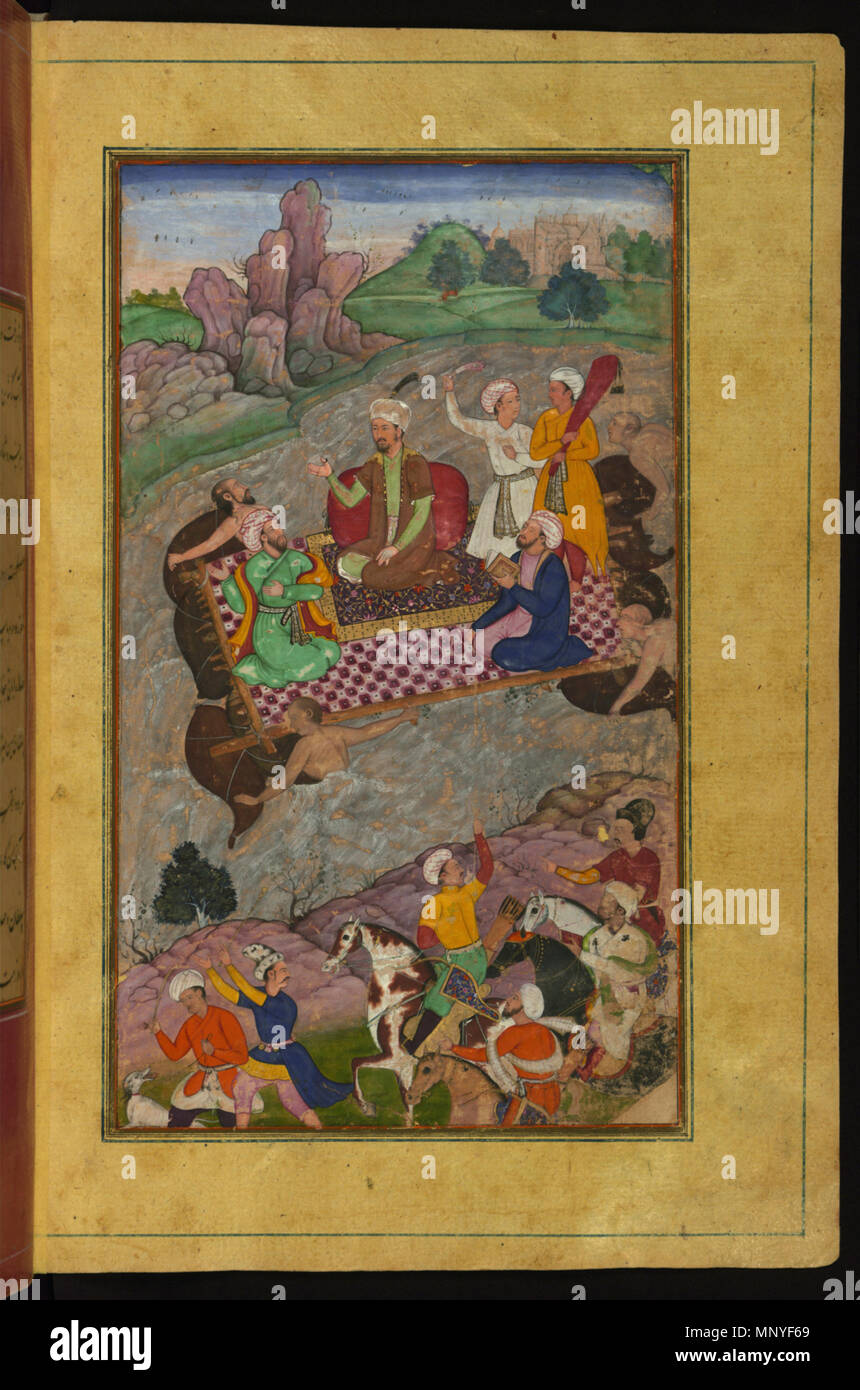 Babur Riding a Raft from Kunar Back to Atar . English: This folio from Walters manuscript W.596 depicts Babur, during his second Hindustan campaign, riding a raft from Kunar back to Atar, where he is camped. . 16th century AD (Mughal; Timurid). Babur (1483–1530) Alternative names Zahir-ud-din Muhammad Babur, Baber, Babar, فارسی: بابر Description Uzbekistani emperor Mughal emperor Date of birth/death 14 February 1483 26 December 1530 Location of birth/death Andijan Agra Authority control : Q797848 VIAF: 97090468 ISNI: 0000 0001 0845 1285 ULAN: 500212753 LCCN: n50053659 GND: 1188 Stock Photohttps://www.alamy.com/image-license-details/?v=1https://www.alamy.com/babur-riding-a-raft-from-kunar-back-to-atar-english-this-folio-from-walters-manuscript-w596-depicts-babur-during-his-second-hindustan-campaign-riding-a-raft-from-kunar-back-to-atar-where-he-is-camped-16th-century-ad-mughal-timurid-babur-14831530-alternative-names-zahir-ud-din-muhammad-babur-baber-babar-description-uzbekistani-emperor-mughal-emperor-date-of-birthdeath-14-february-1483-26-december-1530-location-of-birthdeath-andijan-agra-authority-control-q797848-viaf97090468-isni0000-0001-0845-1285-ulan500212753-lccnn50053659-gnd1188-image185616097.html
Babur Riding a Raft from Kunar Back to Atar . English: This folio from Walters manuscript W.596 depicts Babur, during his second Hindustan campaign, riding a raft from Kunar back to Atar, where he is camped. . 16th century AD (Mughal; Timurid). Babur (1483–1530) Alternative names Zahir-ud-din Muhammad Babur, Baber, Babar, فارسی: بابر Description Uzbekistani emperor Mughal emperor Date of birth/death 14 February 1483 26 December 1530 Location of birth/death Andijan Agra Authority control : Q797848 VIAF: 97090468 ISNI: 0000 0001 0845 1285 ULAN: 500212753 LCCN: n50053659 GND: 1188 Stock Photohttps://www.alamy.com/image-license-details/?v=1https://www.alamy.com/babur-riding-a-raft-from-kunar-back-to-atar-english-this-folio-from-walters-manuscript-w596-depicts-babur-during-his-second-hindustan-campaign-riding-a-raft-from-kunar-back-to-atar-where-he-is-camped-16th-century-ad-mughal-timurid-babur-14831530-alternative-names-zahir-ud-din-muhammad-babur-baber-babar-description-uzbekistani-emperor-mughal-emperor-date-of-birthdeath-14-february-1483-26-december-1530-location-of-birthdeath-andijan-agra-authority-control-q797848-viaf97090468-isni0000-0001-0845-1285-ulan500212753-lccnn50053659-gnd1188-image185616097.htmlRMMNYF69–Babur Riding a Raft from Kunar Back to Atar . English: This folio from Walters manuscript W.596 depicts Babur, during his second Hindustan campaign, riding a raft from Kunar back to Atar, where he is camped. . 16th century AD (Mughal; Timurid). Babur (1483–1530) Alternative names Zahir-ud-din Muhammad Babur, Baber, Babar, فارسی: بابر Description Uzbekistani emperor Mughal emperor Date of birth/death 14 February 1483 26 December 1530 Location of birth/death Andijan Agra Authority control : Q797848 VIAF: 97090468 ISNI: 0000 0001 0845 1285 ULAN: 500212753 LCCN: n50053659 GND: 1188
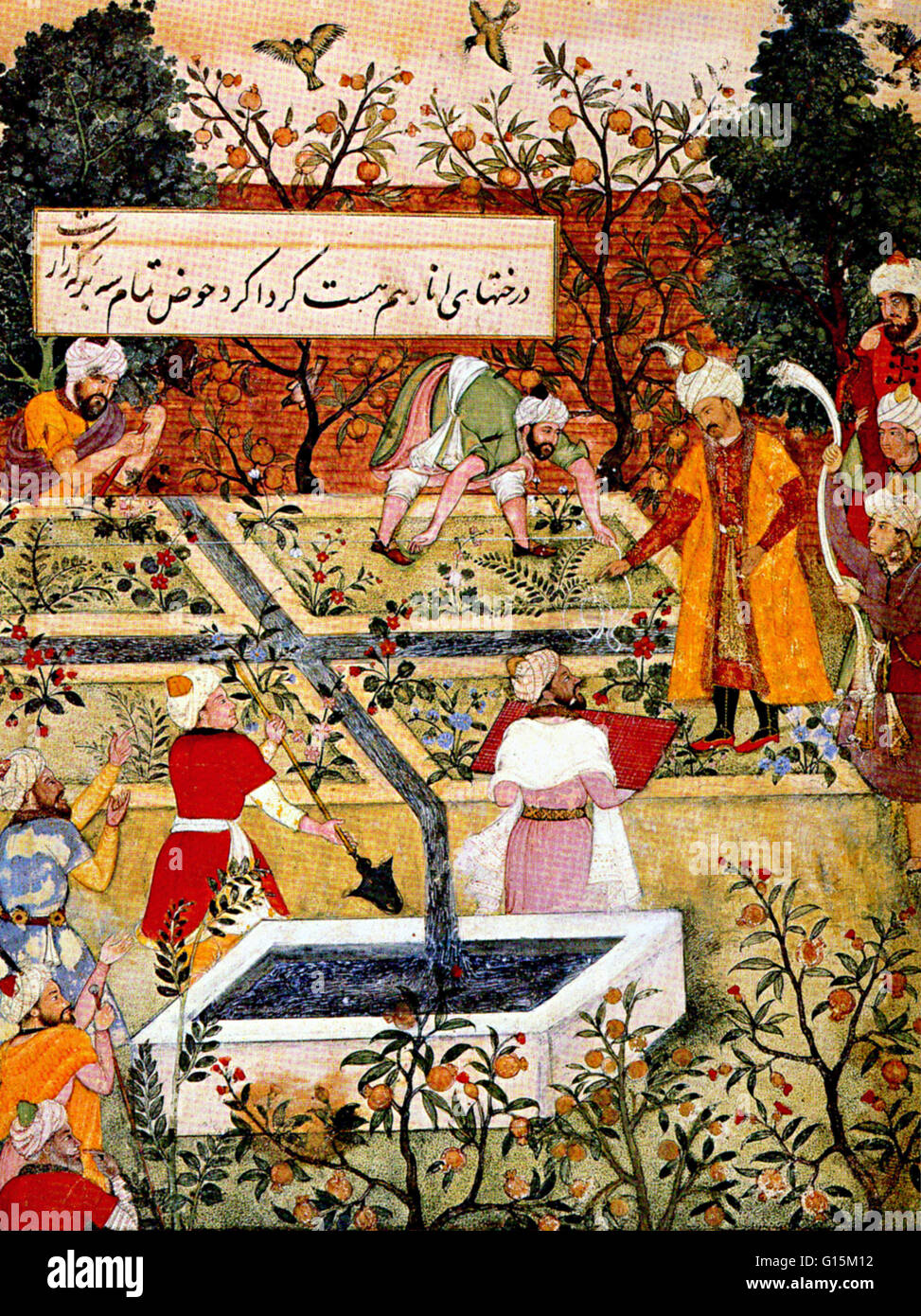 Image taken from the Baburnama. shows Babur Supervising the Laying Out of the Garden of Fidelity. The Bagh-e Vafa (Garden of Fidelity) was Babur's first garden in what is now Afganistan. Zahir-ud-din Muhammad Babur (1483-1530) was a conqueror from Central Stock Photohttps://www.alamy.com/image-license-details/?v=1https://www.alamy.com/stock-photo-image-taken-from-the-baburnama-shows-babur-supervising-the-laying-104002334.html
Image taken from the Baburnama. shows Babur Supervising the Laying Out of the Garden of Fidelity. The Bagh-e Vafa (Garden of Fidelity) was Babur's first garden in what is now Afganistan. Zahir-ud-din Muhammad Babur (1483-1530) was a conqueror from Central Stock Photohttps://www.alamy.com/image-license-details/?v=1https://www.alamy.com/stock-photo-image-taken-from-the-baburnama-shows-babur-supervising-the-laying-104002334.htmlRMG15M12–Image taken from the Baburnama. shows Babur Supervising the Laying Out of the Garden of Fidelity. The Bagh-e Vafa (Garden of Fidelity) was Babur's first garden in what is now Afganistan. Zahir-ud-din Muhammad Babur (1483-1530) was a conqueror from Central
 India: Zahir ud-din Muhammad Babur (1483-1531) the first Mogul Emperor. Miniature painting, c. 18th century. Zahir ud-din Muhammad Babur was a Muslim conqueror from Central Asia who, following a series of setbacks, finally succeeded in laying the basis for the Mughal dynasty of South Asia. He was a direct descendant of Timur through his father, and a descendant also of Genghis Khan through his mother. Babur identified his lineage as Timurid and Chaghatay-Turkic, while his origin, milieu, training and culture were steeped in Persian culture. Stock Photohttps://www.alamy.com/image-license-details/?v=1https://www.alamy.com/india-zahir-ud-din-muhammad-babur-1483-1531-the-first-mogul-emperor-miniature-painting-c-18th-century-zahir-ud-din-muhammad-babur-was-a-muslim-conqueror-from-central-asia-who-following-a-series-of-setbacks-finally-succeeded-in-laying-the-basis-for-the-mughal-dynasty-of-south-asia-he-was-a-direct-descendant-of-timur-through-his-father-and-a-descendant-also-of-genghis-khan-through-his-mother-babur-identified-his-lineage-as-timurid-and-chaghatay-turkic-while-his-origin-milieu-training-and-culture-were-steeped-in-persian-culture-image344240702.html
India: Zahir ud-din Muhammad Babur (1483-1531) the first Mogul Emperor. Miniature painting, c. 18th century. Zahir ud-din Muhammad Babur was a Muslim conqueror from Central Asia who, following a series of setbacks, finally succeeded in laying the basis for the Mughal dynasty of South Asia. He was a direct descendant of Timur through his father, and a descendant also of Genghis Khan through his mother. Babur identified his lineage as Timurid and Chaghatay-Turkic, while his origin, milieu, training and culture were steeped in Persian culture. Stock Photohttps://www.alamy.com/image-license-details/?v=1https://www.alamy.com/india-zahir-ud-din-muhammad-babur-1483-1531-the-first-mogul-emperor-miniature-painting-c-18th-century-zahir-ud-din-muhammad-babur-was-a-muslim-conqueror-from-central-asia-who-following-a-series-of-setbacks-finally-succeeded-in-laying-the-basis-for-the-mughal-dynasty-of-south-asia-he-was-a-direct-descendant-of-timur-through-his-father-and-a-descendant-also-of-genghis-khan-through-his-mother-babur-identified-his-lineage-as-timurid-and-chaghatay-turkic-while-his-origin-milieu-training-and-culture-were-steeped-in-persian-culture-image344240702.htmlRM2B01EEP–India: Zahir ud-din Muhammad Babur (1483-1531) the first Mogul Emperor. Miniature painting, c. 18th century. Zahir ud-din Muhammad Babur was a Muslim conqueror from Central Asia who, following a series of setbacks, finally succeeded in laying the basis for the Mughal dynasty of South Asia. He was a direct descendant of Timur through his father, and a descendant also of Genghis Khan through his mother. Babur identified his lineage as Timurid and Chaghatay-Turkic, while his origin, milieu, training and culture were steeped in Persian culture.
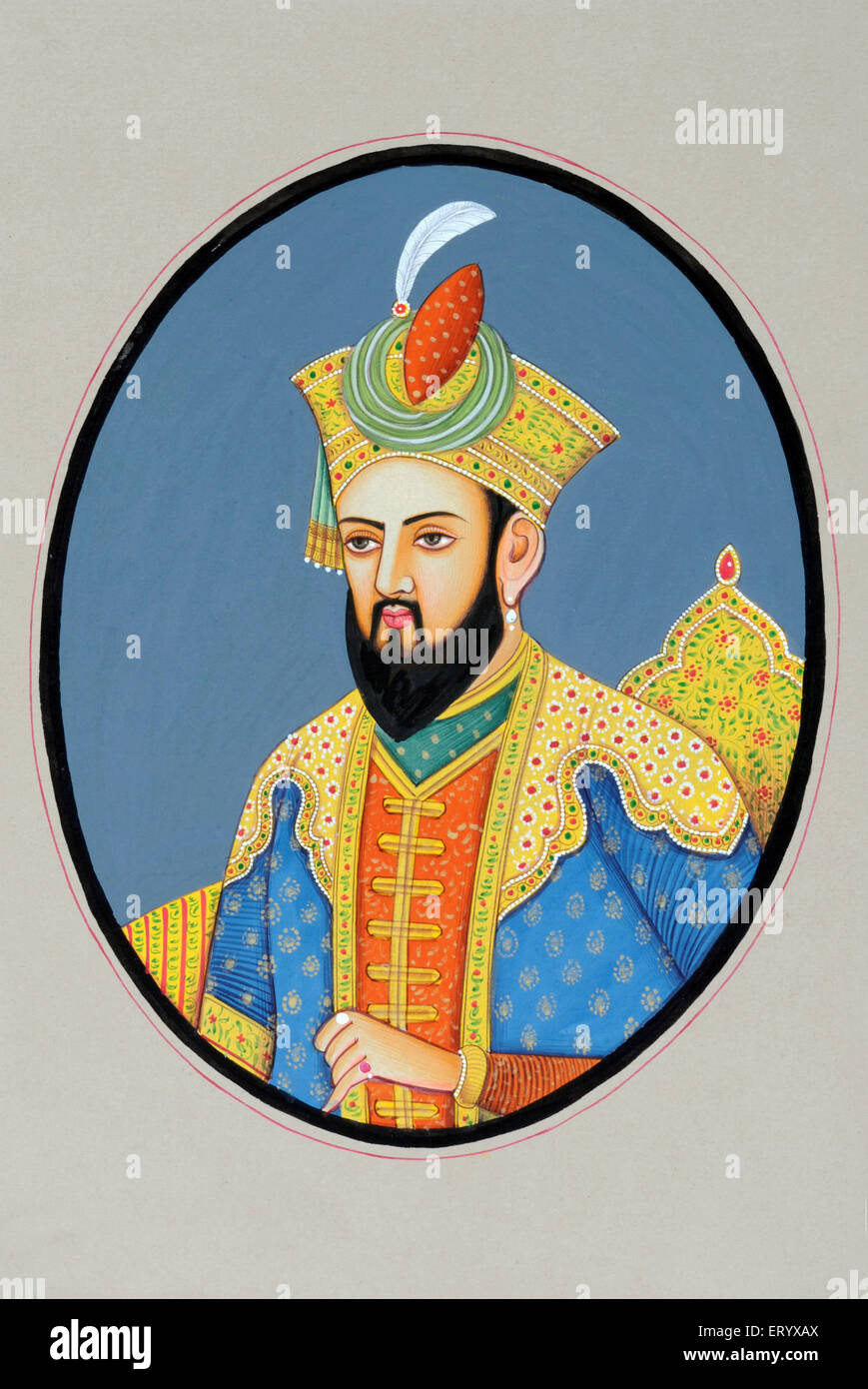 Babur , Mughal Emperor , Miniature painting , Zahir ud Din Muhammad , founder of the Mughal Empire and first Emperor of the Mughal dynasty in India , Stock Photohttps://www.alamy.com/image-license-details/?v=1https://www.alamy.com/stock-photo-babur-mughal-emperor-miniature-painting-zahir-ud-din-muhammad-founder-83591954.html
Babur , Mughal Emperor , Miniature painting , Zahir ud Din Muhammad , founder of the Mughal Empire and first Emperor of the Mughal dynasty in India , Stock Photohttps://www.alamy.com/image-license-details/?v=1https://www.alamy.com/stock-photo-babur-mughal-emperor-miniature-painting-zahir-ud-din-muhammad-founder-83591954.htmlRMERYXAX–Babur , Mughal Emperor , Miniature painting , Zahir ud Din Muhammad , founder of the Mughal Empire and first Emperor of the Mughal dynasty in India ,
 India: Zahir ud-din Muhammad Babur (1483-1531) the first Mogul Emperor. Painting, c. 19th century. Zahir ud-din Muhammad Babur was a Muslim conqueror from Central Asia who, following a series of setbacks, finally succeeded in laying the basis for the Mughal dynasty of South Asia. He was a direct descendant of Timur through his father, and a descendant also of Genghis Khan through his mother. Babur identified his lineage as Timurid and Chaghatay-Turkic, while his origin, milieu, training, and culture were steeped in Persian culture. Stock Photohttps://www.alamy.com/image-license-details/?v=1https://www.alamy.com/india-zahir-ud-din-muhammad-babur-1483-1531-the-first-mogul-emperor-painting-c-19th-century-zahir-ud-din-muhammad-babur-was-a-muslim-conqueror-from-central-asia-who-following-a-series-of-setbacks-finally-succeeded-in-laying-the-basis-for-the-mughal-dynasty-of-south-asia-he-was-a-direct-descendant-of-timur-through-his-father-and-a-descendant-also-of-genghis-khan-through-his-mother-babur-identified-his-lineage-as-timurid-and-chaghatay-turkic-while-his-origin-milieu-training-and-culture-were-steeped-in-persian-culture-image344231925.html
India: Zahir ud-din Muhammad Babur (1483-1531) the first Mogul Emperor. Painting, c. 19th century. Zahir ud-din Muhammad Babur was a Muslim conqueror from Central Asia who, following a series of setbacks, finally succeeded in laying the basis for the Mughal dynasty of South Asia. He was a direct descendant of Timur through his father, and a descendant also of Genghis Khan through his mother. Babur identified his lineage as Timurid and Chaghatay-Turkic, while his origin, milieu, training, and culture were steeped in Persian culture. Stock Photohttps://www.alamy.com/image-license-details/?v=1https://www.alamy.com/india-zahir-ud-din-muhammad-babur-1483-1531-the-first-mogul-emperor-painting-c-19th-century-zahir-ud-din-muhammad-babur-was-a-muslim-conqueror-from-central-asia-who-following-a-series-of-setbacks-finally-succeeded-in-laying-the-basis-for-the-mughal-dynasty-of-south-asia-he-was-a-direct-descendant-of-timur-through-his-father-and-a-descendant-also-of-genghis-khan-through-his-mother-babur-identified-his-lineage-as-timurid-and-chaghatay-turkic-while-his-origin-milieu-training-and-culture-were-steeped-in-persian-culture-image344231925.htmlRM2B01399–India: Zahir ud-din Muhammad Babur (1483-1531) the first Mogul Emperor. Painting, c. 19th century. Zahir ud-din Muhammad Babur was a Muslim conqueror from Central Asia who, following a series of setbacks, finally succeeded in laying the basis for the Mughal dynasty of South Asia. He was a direct descendant of Timur through his father, and a descendant also of Genghis Khan through his mother. Babur identified his lineage as Timurid and Chaghatay-Turkic, while his origin, milieu, training, and culture were steeped in Persian culture.
 An empire builder of the sixteenth century ; a summary account of the political career of Zahir-ud-din Muhammad, surnamed Babur : Rushbrook Williams, L. F., 1890 Stock Photohttps://www.alamy.com/image-license-details/?v=1https://www.alamy.com/an-empire-builder-of-the-sixteenth-century-a-summary-account-of-the-political-career-of-zahir-ud-din-muhammad-surnamed-babur-rushbrook-williams-l-f-1890-image261417200.html
An empire builder of the sixteenth century ; a summary account of the political career of Zahir-ud-din Muhammad, surnamed Babur : Rushbrook Williams, L. F., 1890 Stock Photohttps://www.alamy.com/image-license-details/?v=1https://www.alamy.com/an-empire-builder-of-the-sixteenth-century-a-summary-account-of-the-political-career-of-zahir-ud-din-muhammad-surnamed-babur-rushbrook-williams-l-f-1890-image261417200.htmlRMW58G8G–An empire builder of the sixteenth century ; a summary account of the political career of Zahir-ud-din Muhammad, surnamed Babur : Rushbrook Williams, L. F., 1890
 India: Zahir ud-din Muhammad Babur (1483-1530), the first Mughal Emperor, is offered a fresh horse by Sultan Muḥammad Vays. Miniature painting from the Baburnama, late 16th century. Bāburnāma (literally: 'Book of Babur' or 'Letters of Babur'; alternatively known as Tuzk-e Babri) is the name given to the memoirs of Ẓahīr ud-Dīn Muḥammad Bābur, founder of the Mughal Empire and a great-great-great-grandson of Timur. It is an autobiographical work, originally written in the Chagatai language, known to Babur as 'Turki' (meaning Turkic), the spoken language of the Andijan-Timurids. Stock Photohttps://www.alamy.com/image-license-details/?v=1https://www.alamy.com/india-zahir-ud-din-muhammad-babur-1483-1530-the-first-mughal-emperor-is-offered-a-fresh-horse-by-sultan-muammad-vays-miniature-painting-from-the-baburnama-late-16th-century-bburnma-literally-book-of-babur-or-letters-of-babur-alternatively-known-as-tuzk-e-babri-is-the-name-given-to-the-memoirs-of-ahr-ud-dn-muammad-bbur-founder-of-the-mughal-empire-and-a-great-great-great-grandson-of-timur-it-is-an-autobiographical-work-originally-written-in-the-chagatai-language-known-to-babur-as-turki-meaning-turkic-the-spoken-language-of-the-andijan-timurids-image344240908.html
India: Zahir ud-din Muhammad Babur (1483-1530), the first Mughal Emperor, is offered a fresh horse by Sultan Muḥammad Vays. Miniature painting from the Baburnama, late 16th century. Bāburnāma (literally: 'Book of Babur' or 'Letters of Babur'; alternatively known as Tuzk-e Babri) is the name given to the memoirs of Ẓahīr ud-Dīn Muḥammad Bābur, founder of the Mughal Empire and a great-great-great-grandson of Timur. It is an autobiographical work, originally written in the Chagatai language, known to Babur as 'Turki' (meaning Turkic), the spoken language of the Andijan-Timurids. Stock Photohttps://www.alamy.com/image-license-details/?v=1https://www.alamy.com/india-zahir-ud-din-muhammad-babur-1483-1530-the-first-mughal-emperor-is-offered-a-fresh-horse-by-sultan-muammad-vays-miniature-painting-from-the-baburnama-late-16th-century-bburnma-literally-book-of-babur-or-letters-of-babur-alternatively-known-as-tuzk-e-babri-is-the-name-given-to-the-memoirs-of-ahr-ud-dn-muammad-bbur-founder-of-the-mughal-empire-and-a-great-great-great-grandson-of-timur-it-is-an-autobiographical-work-originally-written-in-the-chagatai-language-known-to-babur-as-turki-meaning-turkic-the-spoken-language-of-the-andijan-timurids-image344240908.htmlRM2B01EP4–India: Zahir ud-din Muhammad Babur (1483-1530), the first Mughal Emperor, is offered a fresh horse by Sultan Muḥammad Vays. Miniature painting from the Baburnama, late 16th century. Bāburnāma (literally: 'Book of Babur' or 'Letters of Babur'; alternatively known as Tuzk-e Babri) is the name given to the memoirs of Ẓahīr ud-Dīn Muḥammad Bābur, founder of the Mughal Empire and a great-great-great-grandson of Timur. It is an autobiographical work, originally written in the Chagatai language, known to Babur as 'Turki' (meaning Turkic), the spoken language of the Andijan-Timurids.
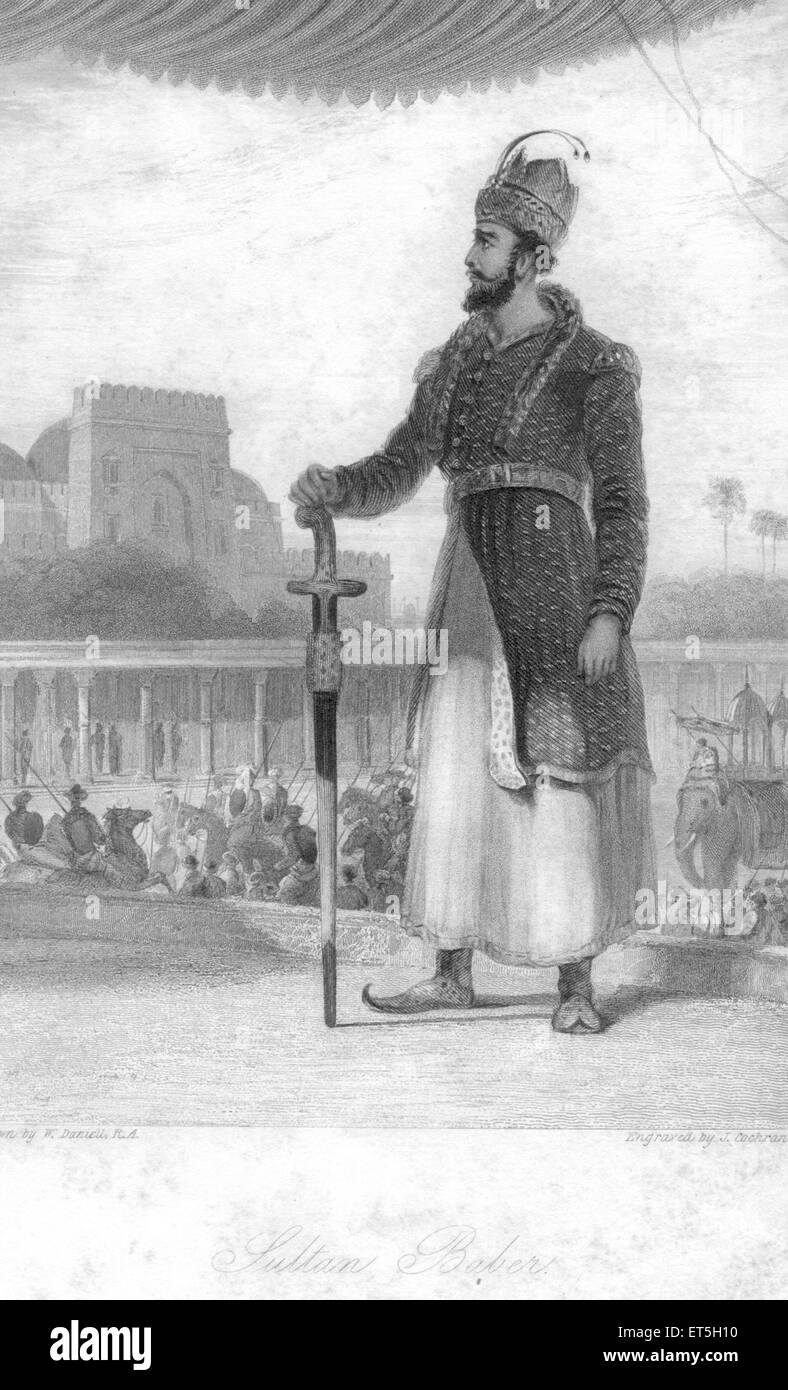 Babur, Mughal Emperor, Sultan Babar, Zahir ud Din Muhammad, India, 1500, 1500s, Asia, Asian, Indian, old vintage 1800s steel engraving Stock Photohttps://www.alamy.com/image-license-details/?v=1https://www.alamy.com/stock-photo-babur-mughal-emperor-sultan-babar-zahir-ud-din-muhammad-india-1500-83716332.html
Babur, Mughal Emperor, Sultan Babar, Zahir ud Din Muhammad, India, 1500, 1500s, Asia, Asian, Indian, old vintage 1800s steel engraving Stock Photohttps://www.alamy.com/image-license-details/?v=1https://www.alamy.com/stock-photo-babur-mughal-emperor-sultan-babar-zahir-ud-din-muhammad-india-1500-83716332.htmlRMET5H10–Babur, Mughal Emperor, Sultan Babar, Zahir ud Din Muhammad, India, 1500, 1500s, Asia, Asian, Indian, old vintage 1800s steel engraving
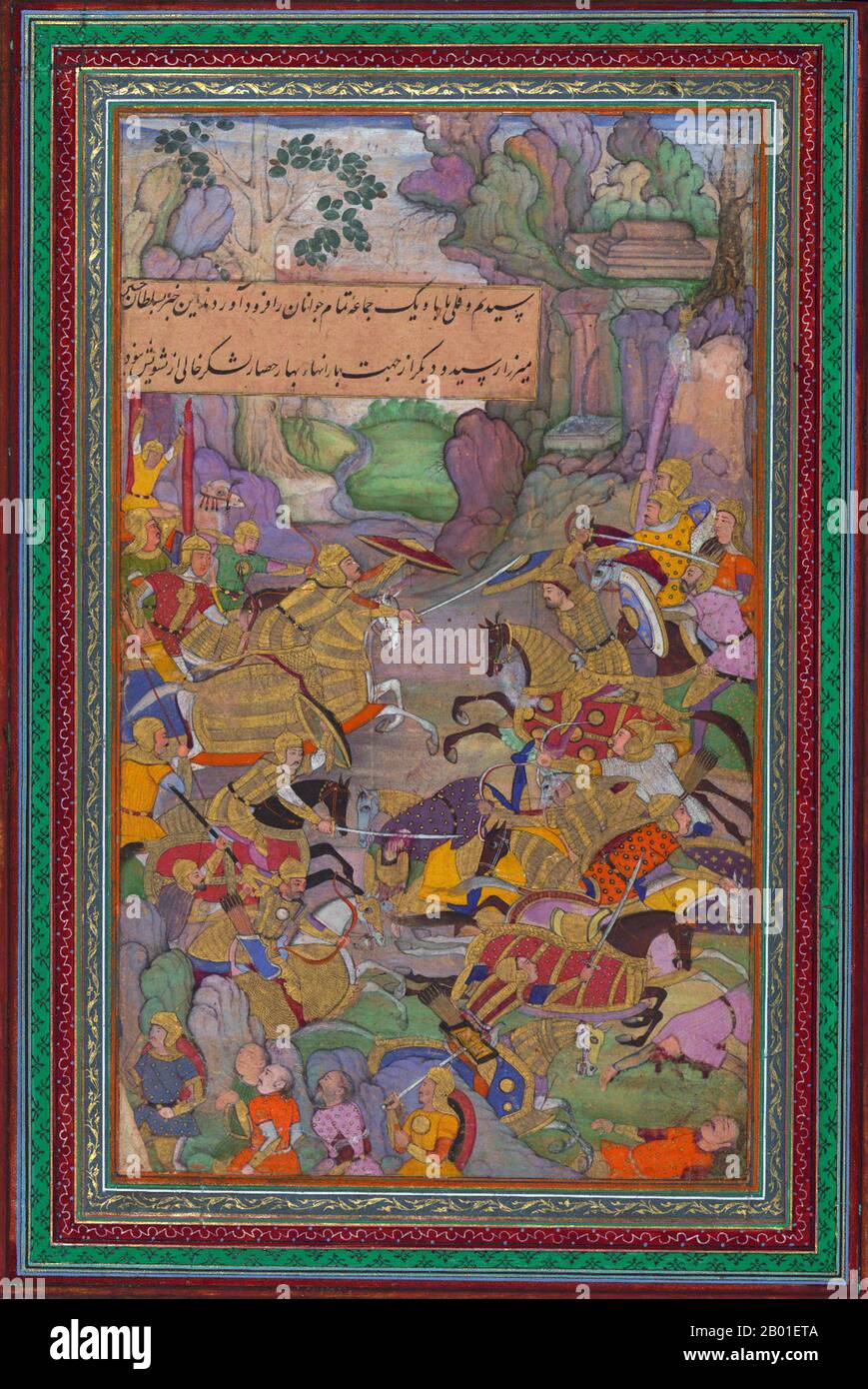 India: Babur defeats his foes. Miniature painting from the Baburnama, late 16th century. Bāburnāma (literally: 'Book of Babur' or 'Letters of Babur'; alternatively known as Tuzk-e Babri) is the name given to the memoirs of Ẓahīr ud-Dīn Muḥammad Bābur (1483-1530), founder of the Mughal Empire and a great-great-great-grandson of Timur. It is an autobiographical work, originally written in the Chagatai language, known to Babur as 'Turki' (meaning Turkic), the spoken language of the Andijan-Timurids. Stock Photohttps://www.alamy.com/image-license-details/?v=1https://www.alamy.com/india-babur-defeats-his-foes-miniature-painting-from-the-baburnama-late-16th-century-bburnma-literally-book-of-babur-or-letters-of-babur-alternatively-known-as-tuzk-e-babri-is-the-name-given-to-the-memoirs-of-ahr-ud-dn-muammad-bbur-1483-1530-founder-of-the-mughal-empire-and-a-great-great-great-grandson-of-timur-it-is-an-autobiographical-work-originally-written-in-the-chagatai-language-known-to-babur-as-turki-meaning-turkic-the-spoken-language-of-the-andijan-timurids-image344240970.html
India: Babur defeats his foes. Miniature painting from the Baburnama, late 16th century. Bāburnāma (literally: 'Book of Babur' or 'Letters of Babur'; alternatively known as Tuzk-e Babri) is the name given to the memoirs of Ẓahīr ud-Dīn Muḥammad Bābur (1483-1530), founder of the Mughal Empire and a great-great-great-grandson of Timur. It is an autobiographical work, originally written in the Chagatai language, known to Babur as 'Turki' (meaning Turkic), the spoken language of the Andijan-Timurids. Stock Photohttps://www.alamy.com/image-license-details/?v=1https://www.alamy.com/india-babur-defeats-his-foes-miniature-painting-from-the-baburnama-late-16th-century-bburnma-literally-book-of-babur-or-letters-of-babur-alternatively-known-as-tuzk-e-babri-is-the-name-given-to-the-memoirs-of-ahr-ud-dn-muammad-bbur-1483-1530-founder-of-the-mughal-empire-and-a-great-great-great-grandson-of-timur-it-is-an-autobiographical-work-originally-written-in-the-chagatai-language-known-to-babur-as-turki-meaning-turkic-the-spoken-language-of-the-andijan-timurids-image344240970.htmlRM2B01ETA–India: Babur defeats his foes. Miniature painting from the Baburnama, late 16th century. Bāburnāma (literally: 'Book of Babur' or 'Letters of Babur'; alternatively known as Tuzk-e Babri) is the name given to the memoirs of Ẓahīr ud-Dīn Muḥammad Bābur (1483-1530), founder of the Mughal Empire and a great-great-great-grandson of Timur. It is an autobiographical work, originally written in the Chagatai language, known to Babur as 'Turki' (meaning Turkic), the spoken language of the Andijan-Timurids.
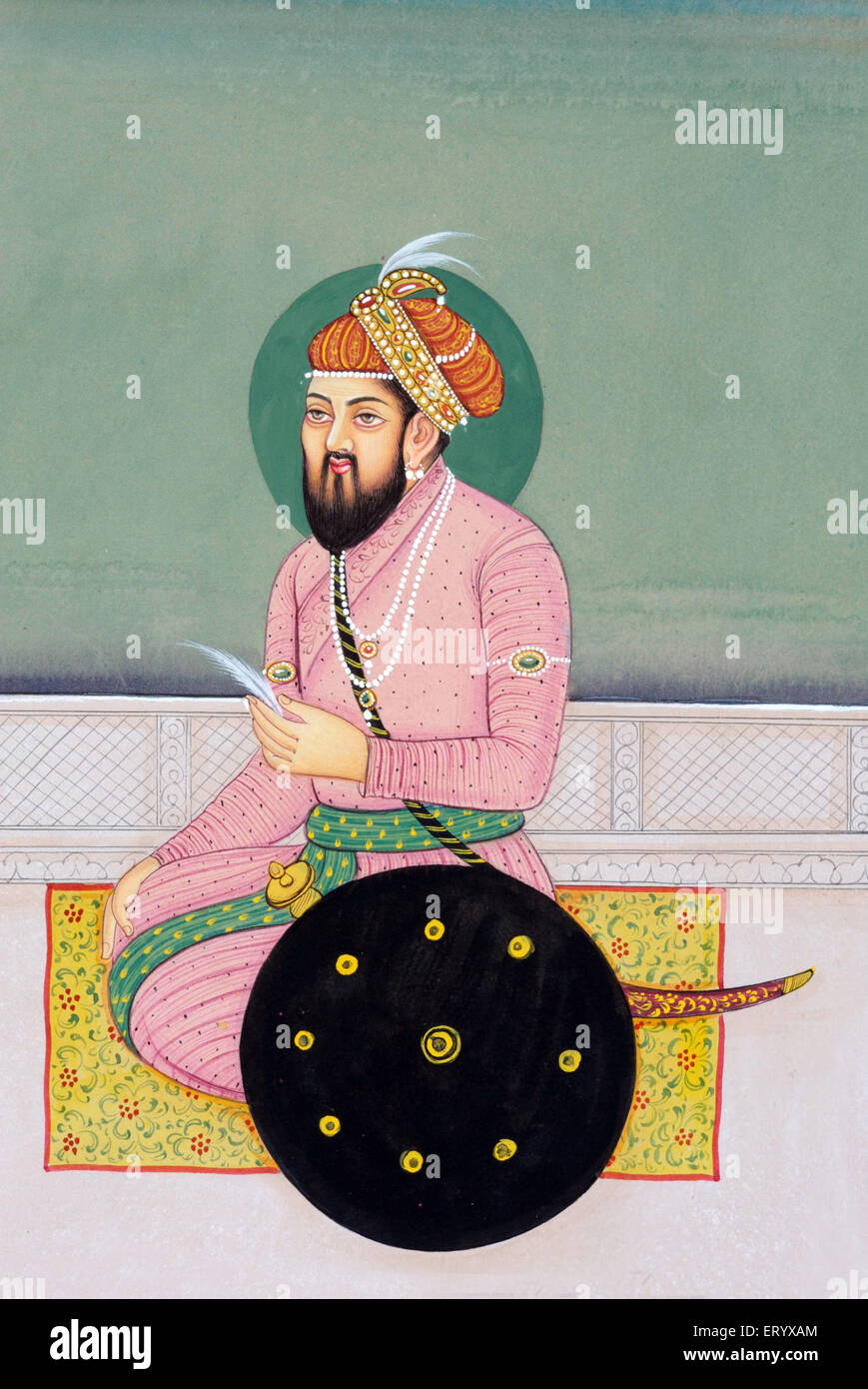 Babur, Zahir ud Din Muhammad, Mughal Empire Founder, Mughal dynasty first Emperor, miniature painting, India, Asia Stock Photohttps://www.alamy.com/image-license-details/?v=1https://www.alamy.com/stock-photo-babur-zahir-ud-din-muhammad-mughal-empire-founder-mughal-dynasty-first-83591948.html
Babur, Zahir ud Din Muhammad, Mughal Empire Founder, Mughal dynasty first Emperor, miniature painting, India, Asia Stock Photohttps://www.alamy.com/image-license-details/?v=1https://www.alamy.com/stock-photo-babur-zahir-ud-din-muhammad-mughal-empire-founder-mughal-dynasty-first-83591948.htmlRMERYXAM–Babur, Zahir ud Din Muhammad, Mughal Empire Founder, Mughal dynasty first Emperor, miniature painting, India, Asia
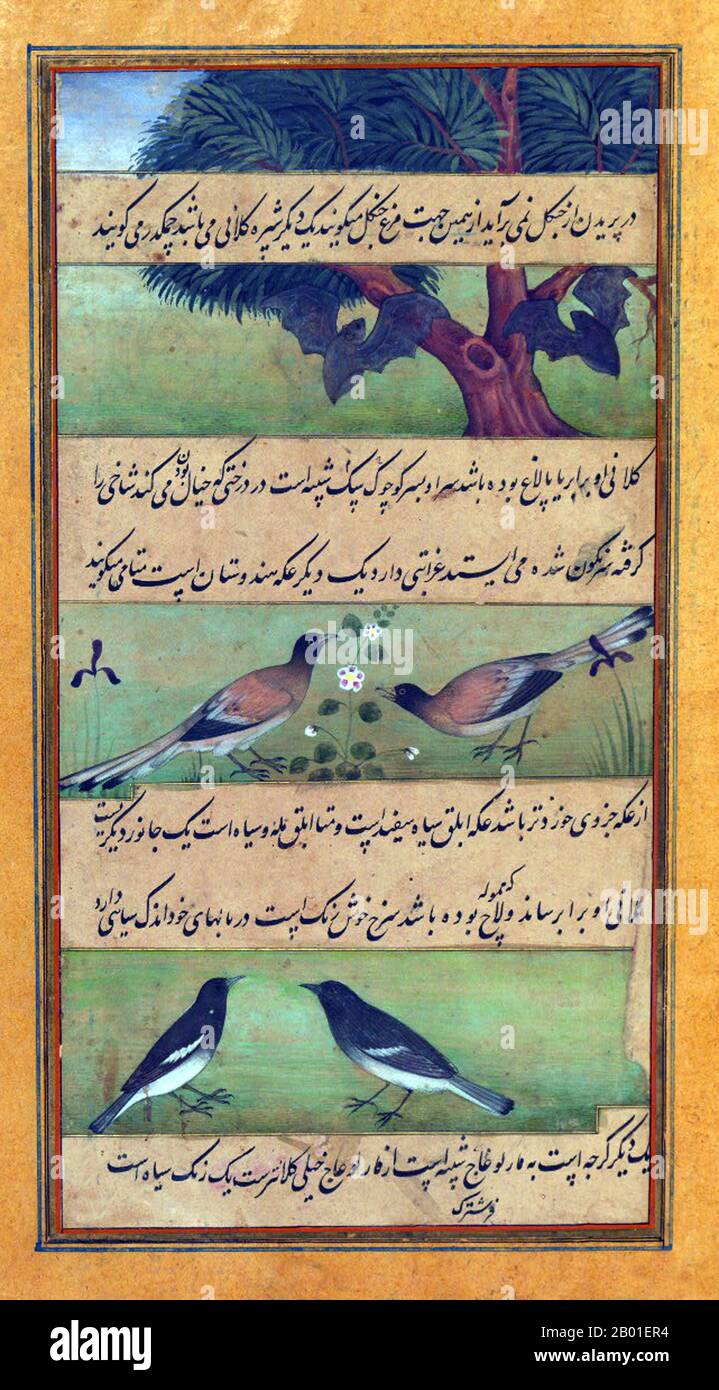 India: Animals of Hindustan - bats and birds. Miniature painting from the Baburnama, late 16th century. Bāburnāma (literally: 'Book of Babur' or 'Letters of Babur'; alternatively known as Tuzk-e Babri) is the name given to the memoirs of Ẓahīr ud-Dīn Muḥammad Bābur (1483-1530), founder of the Mughal Empire and a great-great-great-grandson of Timur. It is an autobiographical work, originally written in the Chagatai language, known to Babur as 'Turki' (meaning Turkic), the spoken language of the Andijan-Timurids. Stock Photohttps://www.alamy.com/image-license-details/?v=1https://www.alamy.com/india-animals-of-hindustan-bats-and-birds-miniature-painting-from-the-baburnama-late-16th-century-bburnma-literally-book-of-babur-or-letters-of-babur-alternatively-known-as-tuzk-e-babri-is-the-name-given-to-the-memoirs-of-ahr-ud-dn-muammad-bbur-1483-1530-founder-of-the-mughal-empire-and-a-great-great-great-grandson-of-timur-it-is-an-autobiographical-work-originally-written-in-the-chagatai-language-known-to-babur-as-turki-meaning-turkic-the-spoken-language-of-the-andijan-timurids-image344240936.html
India: Animals of Hindustan - bats and birds. Miniature painting from the Baburnama, late 16th century. Bāburnāma (literally: 'Book of Babur' or 'Letters of Babur'; alternatively known as Tuzk-e Babri) is the name given to the memoirs of Ẓahīr ud-Dīn Muḥammad Bābur (1483-1530), founder of the Mughal Empire and a great-great-great-grandson of Timur. It is an autobiographical work, originally written in the Chagatai language, known to Babur as 'Turki' (meaning Turkic), the spoken language of the Andijan-Timurids. Stock Photohttps://www.alamy.com/image-license-details/?v=1https://www.alamy.com/india-animals-of-hindustan-bats-and-birds-miniature-painting-from-the-baburnama-late-16th-century-bburnma-literally-book-of-babur-or-letters-of-babur-alternatively-known-as-tuzk-e-babri-is-the-name-given-to-the-memoirs-of-ahr-ud-dn-muammad-bbur-1483-1530-founder-of-the-mughal-empire-and-a-great-great-great-grandson-of-timur-it-is-an-autobiographical-work-originally-written-in-the-chagatai-language-known-to-babur-as-turki-meaning-turkic-the-spoken-language-of-the-andijan-timurids-image344240936.htmlRM2B01ER4–India: Animals of Hindustan - bats and birds. Miniature painting from the Baburnama, late 16th century. Bāburnāma (literally: 'Book of Babur' or 'Letters of Babur'; alternatively known as Tuzk-e Babri) is the name given to the memoirs of Ẓahīr ud-Dīn Muḥammad Bābur (1483-1530), founder of the Mughal Empire and a great-great-great-grandson of Timur. It is an autobiographical work, originally written in the Chagatai language, known to Babur as 'Turki' (meaning Turkic), the spoken language of the Andijan-Timurids.
 The Chihlzina, or Forty Steps, is an enclave carved into a rocky mountainside, accessible by climbing up forty stone steps, hewn from the mountain itself. The enclave is guarded by two stone lions, now chained and defaced. Inside, the enclave contains inscriptions narrating the Old City conquest by Persian forces under Zahir ud-din Muhammad Babur, descendent of Genghis Khan, in the 16th century. Other inscriptions inside tell the story of a second conquest of the city by the Mogul Empire in the 17th century Oct. 4. Scenes From Southern Afghanistan 328130 Stock Photohttps://www.alamy.com/image-license-details/?v=1https://www.alamy.com/stock-photo-the-chihlzina-or-forty-steps-is-an-enclave-carved-into-a-rocky-mountainside-129499937.html
The Chihlzina, or Forty Steps, is an enclave carved into a rocky mountainside, accessible by climbing up forty stone steps, hewn from the mountain itself. The enclave is guarded by two stone lions, now chained and defaced. Inside, the enclave contains inscriptions narrating the Old City conquest by Persian forces under Zahir ud-din Muhammad Babur, descendent of Genghis Khan, in the 16th century. Other inscriptions inside tell the story of a second conquest of the city by the Mogul Empire in the 17th century Oct. 4. Scenes From Southern Afghanistan 328130 Stock Photohttps://www.alamy.com/image-license-details/?v=1https://www.alamy.com/stock-photo-the-chihlzina-or-forty-steps-is-an-enclave-carved-into-a-rocky-mountainside-129499937.htmlRMHEK6DN–The Chihlzina, or Forty Steps, is an enclave carved into a rocky mountainside, accessible by climbing up forty stone steps, hewn from the mountain itself. The enclave is guarded by two stone lions, now chained and defaced. Inside, the enclave contains inscriptions narrating the Old City conquest by Persian forces under Zahir ud-din Muhammad Babur, descendent of Genghis Khan, in the 16th century. Other inscriptions inside tell the story of a second conquest of the city by the Mogul Empire in the 17th century Oct. 4. Scenes From Southern Afghanistan 328130
![Tomb Of Baber or Babur [Babur (Bābur, lit. 'tiger'; 14 February 1483 – 26 December 1530), born Zahīr ud-Dīn Muhammad, was the founder of the Mughal Empire and first Emperor of the Mughal dynasty (r. 1526–1530) in the Indian subcontinent]. From the book ' The Oriental annual, or, Scenes in India ' by the Rev. Hobart Caunter Published by Edward Bull, London 1838 engravings from drawings by William Daniell Stock Photo Tomb Of Baber or Babur [Babur (Bābur, lit. 'tiger'; 14 February 1483 – 26 December 1530), born Zahīr ud-Dīn Muhammad, was the founder of the Mughal Empire and first Emperor of the Mughal dynasty (r. 1526–1530) in the Indian subcontinent]. From the book ' The Oriental annual, or, Scenes in India ' by the Rev. Hobart Caunter Published by Edward Bull, London 1838 engravings from drawings by William Daniell Stock Photo](https://c8.alamy.com/comp/2H5AMR5/tomb-of-baber-or-babur-babur-bbur-littiger-14-february-1483-26-december-1530-born-zahr-ud-dn-muhammad-was-the-founder-of-the-mughal-empire-and-first-emperor-of-the-mughal-dynasty-r-15261530-in-the-indian-subcontinent-from-the-book-the-oriental-annual-or-scenes-in-india-by-the-rev-hobart-caunter-published-by-edward-bull-london-1838-engravings-from-drawings-by-william-daniell-2H5AMR5.jpg) Tomb Of Baber or Babur [Babur (Bābur, lit. 'tiger'; 14 February 1483 – 26 December 1530), born Zahīr ud-Dīn Muhammad, was the founder of the Mughal Empire and first Emperor of the Mughal dynasty (r. 1526–1530) in the Indian subcontinent]. From the book ' The Oriental annual, or, Scenes in India ' by the Rev. Hobart Caunter Published by Edward Bull, London 1838 engravings from drawings by William Daniell Stock Photohttps://www.alamy.com/image-license-details/?v=1https://www.alamy.com/tomb-of-baber-or-babur-babur-bbur-littiger-14-february-1483-26-december-1530-born-zahr-ud-dn-muhammad-was-the-founder-of-the-mughal-empire-and-first-emperor-of-the-mughal-dynasty-r-15261530-in-the-indian-subcontinent-from-the-book-the-oriental-annual-or-scenes-in-india-by-the-rev-hobart-caunter-published-by-edward-bull-london-1838-engravings-from-drawings-by-william-daniell-image450778697.html
Tomb Of Baber or Babur [Babur (Bābur, lit. 'tiger'; 14 February 1483 – 26 December 1530), born Zahīr ud-Dīn Muhammad, was the founder of the Mughal Empire and first Emperor of the Mughal dynasty (r. 1526–1530) in the Indian subcontinent]. From the book ' The Oriental annual, or, Scenes in India ' by the Rev. Hobart Caunter Published by Edward Bull, London 1838 engravings from drawings by William Daniell Stock Photohttps://www.alamy.com/image-license-details/?v=1https://www.alamy.com/tomb-of-baber-or-babur-babur-bbur-littiger-14-february-1483-26-december-1530-born-zahr-ud-dn-muhammad-was-the-founder-of-the-mughal-empire-and-first-emperor-of-the-mughal-dynasty-r-15261530-in-the-indian-subcontinent-from-the-book-the-oriental-annual-or-scenes-in-india-by-the-rev-hobart-caunter-published-by-edward-bull-london-1838-engravings-from-drawings-by-william-daniell-image450778697.htmlRF2H5AMR5–Tomb Of Baber or Babur [Babur (Bābur, lit. 'tiger'; 14 February 1483 – 26 December 1530), born Zahīr ud-Dīn Muhammad, was the founder of the Mughal Empire and first Emperor of the Mughal dynasty (r. 1526–1530) in the Indian subcontinent]. From the book ' The Oriental annual, or, Scenes in India ' by the Rev. Hobart Caunter Published by Edward Bull, London 1838 engravings from drawings by William Daniell
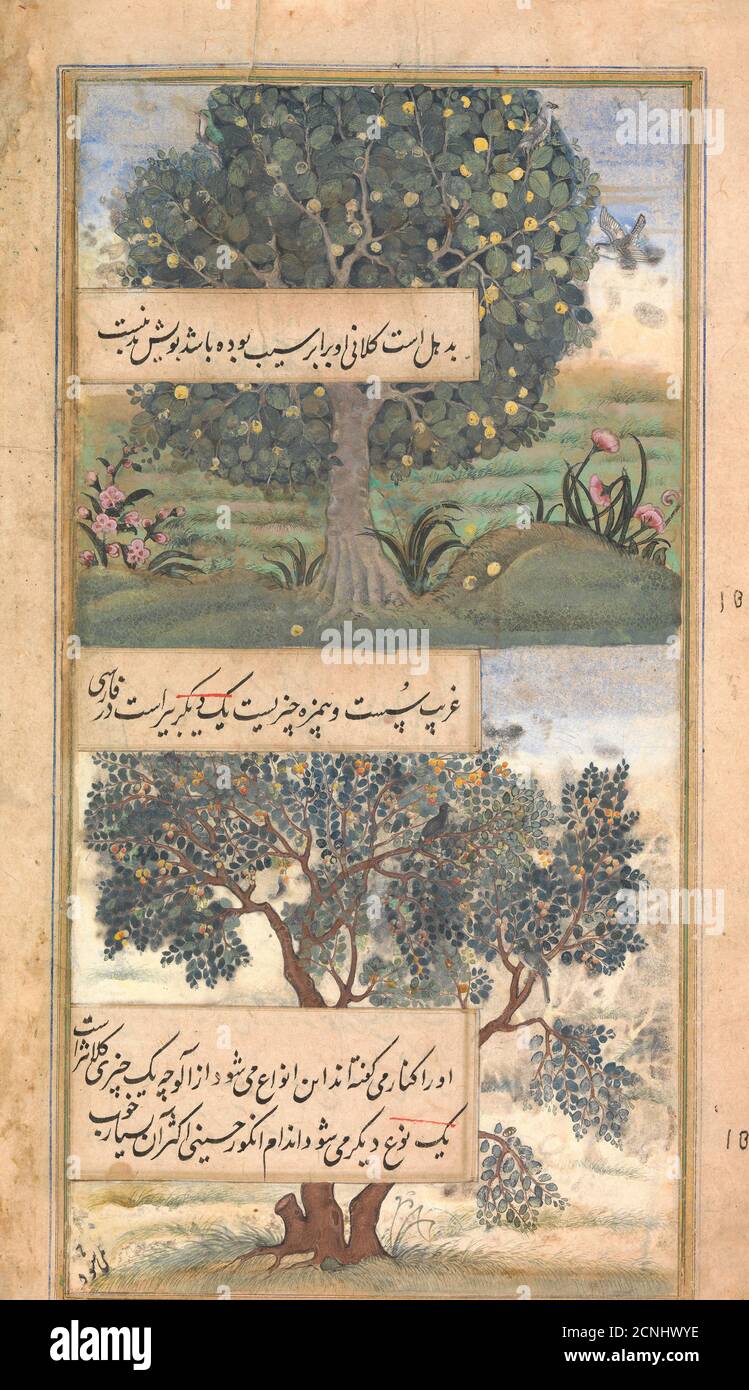 Three Trees of India, Folio from a Baburnama (Autobiography of Babur), late 16th century. Stock Photohttps://www.alamy.com/image-license-details/?v=1https://www.alamy.com/three-trees-of-india-folio-from-a-baburnama-autobiography-of-babur-late-16th-century-image374719058.html
Three Trees of India, Folio from a Baburnama (Autobiography of Babur), late 16th century. Stock Photohttps://www.alamy.com/image-license-details/?v=1https://www.alamy.com/three-trees-of-india-folio-from-a-baburnama-autobiography-of-babur-late-16th-century-image374719058.htmlRM2CNHWYE–Three Trees of India, Folio from a Baburnama (Autobiography of Babur), late 16th century.
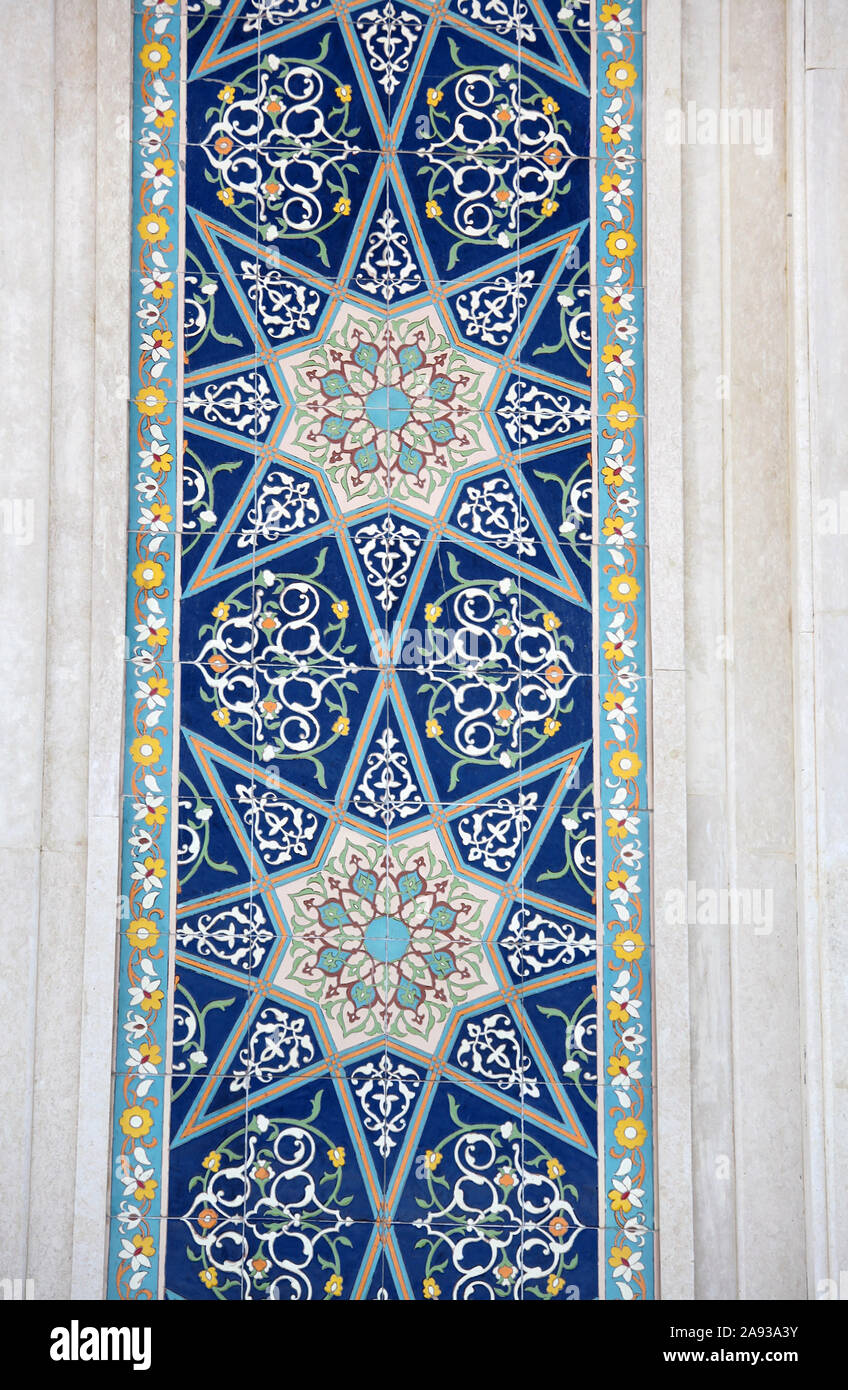 Museum of Zahiriddin Babur in Andijan Stock Photohttps://www.alamy.com/image-license-details/?v=1https://www.alamy.com/museum-of-zahiriddin-babur-in-andijan-image332602703.html
Museum of Zahiriddin Babur in Andijan Stock Photohttps://www.alamy.com/image-license-details/?v=1https://www.alamy.com/museum-of-zahiriddin-babur-in-andijan-image332602703.htmlRM2A93A3Y–Museum of Zahiriddin Babur in Andijan
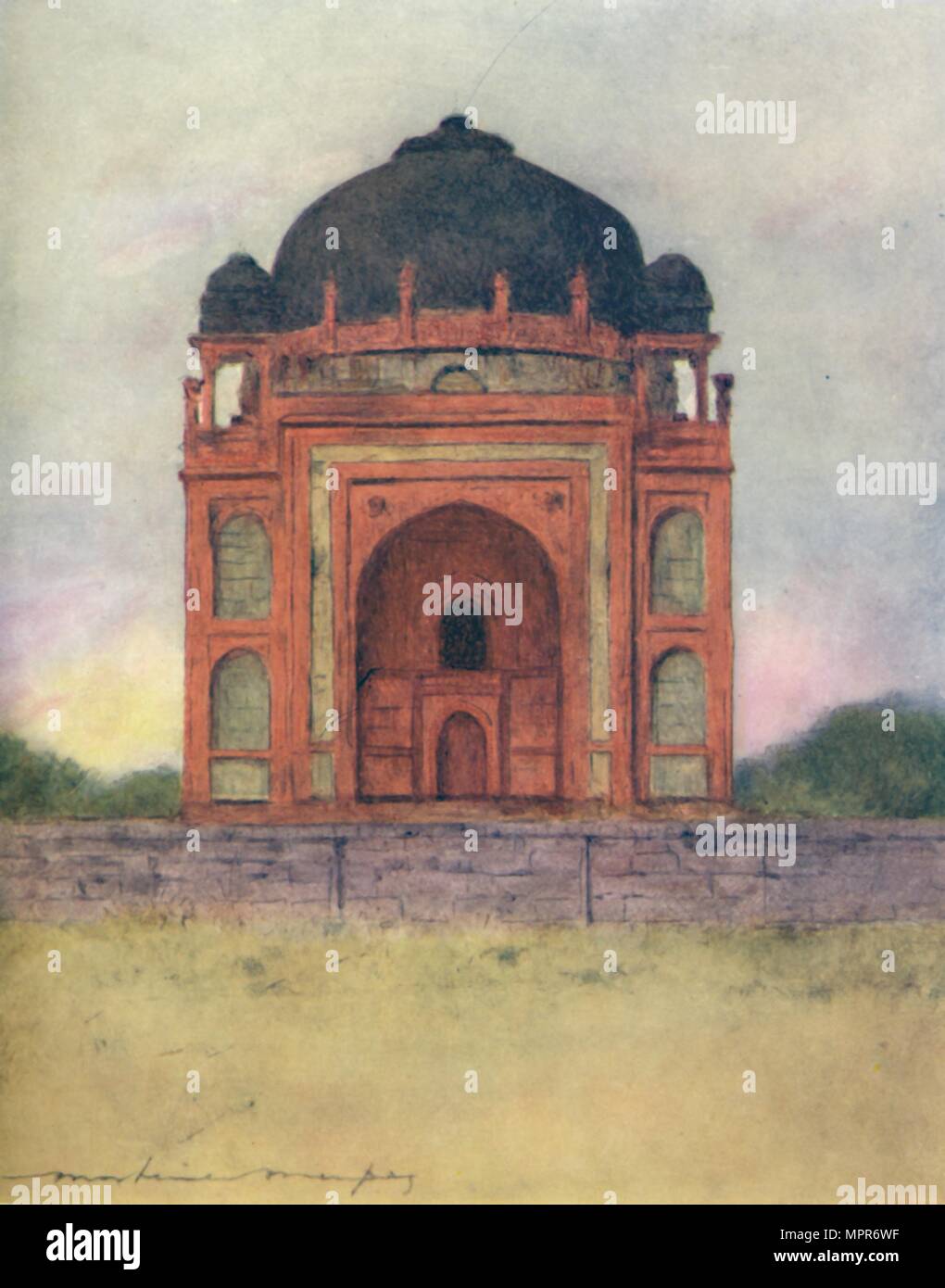 'King Babar's Tomb', 1905. Artist: Mortimer Luddington Menpes. Stock Photohttps://www.alamy.com/image-license-details/?v=1https://www.alamy.com/king-babars-tomb-1905-artist-mortimer-luddington-menpes-image186136427.html
'King Babar's Tomb', 1905. Artist: Mortimer Luddington Menpes. Stock Photohttps://www.alamy.com/image-license-details/?v=1https://www.alamy.com/king-babars-tomb-1905-artist-mortimer-luddington-menpes-image186136427.htmlRMMPR6WF–'King Babar's Tomb', 1905. Artist: Mortimer Luddington Menpes.
 Babur and His Army in the Sinjid Valley . English: On this folio from Walters manuscript W.596, Babur and his army in the Sinjid valley march toward Kabul. . 16th century AD (Mughal; Timurid). Babur (1483–1530) Alternative names Zahir-ud-din Muhammad Babur, Baber, Babar, فارسی: بابر Description Uzbekistani emperor Mughal emperor Date of birth/death 14 February 1483 26 December 1530 Location of birth/death Andijan Agra Authority control : Q797848 VIAF: 97090468 ISNI: 0000 0001 0845 1285 ULAN: 500212753 LCCN: n50053659 GND: 118841807 WorldCat 1280 Zahir al-Din Muhammad Babur - Ba Stock Photohttps://www.alamy.com/image-license-details/?v=1https://www.alamy.com/babur-and-his-army-in-the-sinjid-valley-english-on-this-folio-from-walters-manuscript-w596-babur-and-his-army-in-the-sinjid-valley-march-toward-kabul-16th-century-ad-mughal-timurid-babur-14831530-alternative-names-zahir-ud-din-muhammad-babur-baber-babar-description-uzbekistani-emperor-mughal-emperor-date-of-birthdeath-14-february-1483-26-december-1530-location-of-birthdeath-andijan-agra-authority-control-q797848-viaf97090468-isni0000-0001-0845-1285-ulan500212753-lccnn50053659-gnd118841807-worldcat-1280-zahir-al-din-muhammad-babur-ba-image185616093.html
Babur and His Army in the Sinjid Valley . English: On this folio from Walters manuscript W.596, Babur and his army in the Sinjid valley march toward Kabul. . 16th century AD (Mughal; Timurid). Babur (1483–1530) Alternative names Zahir-ud-din Muhammad Babur, Baber, Babar, فارسی: بابر Description Uzbekistani emperor Mughal emperor Date of birth/death 14 February 1483 26 December 1530 Location of birth/death Andijan Agra Authority control : Q797848 VIAF: 97090468 ISNI: 0000 0001 0845 1285 ULAN: 500212753 LCCN: n50053659 GND: 118841807 WorldCat 1280 Zahir al-Din Muhammad Babur - Ba Stock Photohttps://www.alamy.com/image-license-details/?v=1https://www.alamy.com/babur-and-his-army-in-the-sinjid-valley-english-on-this-folio-from-walters-manuscript-w596-babur-and-his-army-in-the-sinjid-valley-march-toward-kabul-16th-century-ad-mughal-timurid-babur-14831530-alternative-names-zahir-ud-din-muhammad-babur-baber-babar-description-uzbekistani-emperor-mughal-emperor-date-of-birthdeath-14-february-1483-26-december-1530-location-of-birthdeath-andijan-agra-authority-control-q797848-viaf97090468-isni0000-0001-0845-1285-ulan500212753-lccnn50053659-gnd118841807-worldcat-1280-zahir-al-din-muhammad-babur-ba-image185616093.htmlRMMNYF65–Babur and His Army in the Sinjid Valley . English: On this folio from Walters manuscript W.596, Babur and his army in the Sinjid valley march toward Kabul. . 16th century AD (Mughal; Timurid). Babur (1483–1530) Alternative names Zahir-ud-din Muhammad Babur, Baber, Babar, فارسی: بابر Description Uzbekistani emperor Mughal emperor Date of birth/death 14 February 1483 26 December 1530 Location of birth/death Andijan Agra Authority control : Q797848 VIAF: 97090468 ISNI: 0000 0001 0845 1285 ULAN: 500212753 LCCN: n50053659 GND: 118841807 WorldCat 1280 Zahir al-Din Muhammad Babur - Ba
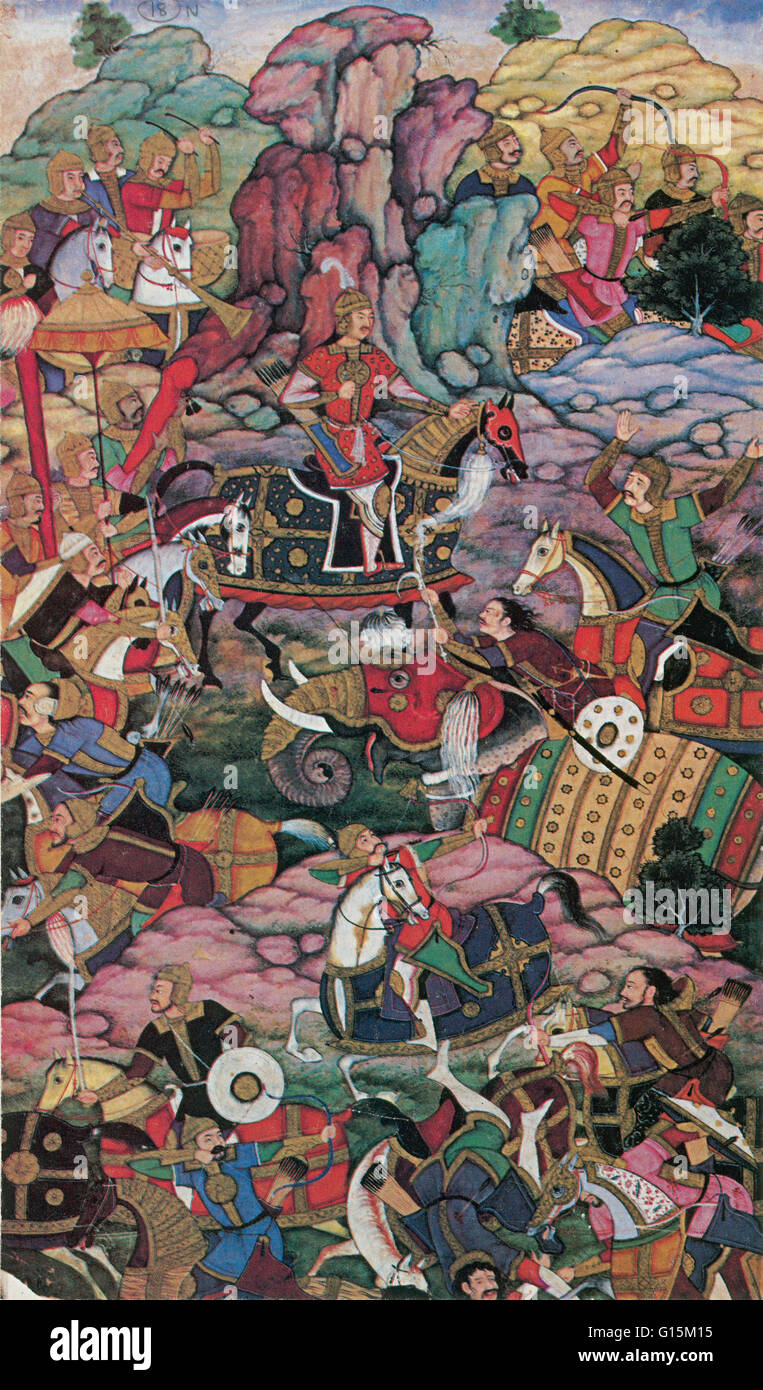 The first battle of Panipat took place in Northern India, and marked the beginning of the Mughal Empire. This was one of the earliest battles involving gunpowder firearms and field artillery. In 1526, the Mughal forces of Babur, the Timurid ruler of Kabul Stock Photohttps://www.alamy.com/image-license-details/?v=1https://www.alamy.com/stock-photo-the-first-battle-of-panipat-took-place-in-northern-india-and-marked-104002337.html
The first battle of Panipat took place in Northern India, and marked the beginning of the Mughal Empire. This was one of the earliest battles involving gunpowder firearms and field artillery. In 1526, the Mughal forces of Babur, the Timurid ruler of Kabul Stock Photohttps://www.alamy.com/image-license-details/?v=1https://www.alamy.com/stock-photo-the-first-battle-of-panipat-took-place-in-northern-india-and-marked-104002337.htmlRMG15M15–The first battle of Panipat took place in Northern India, and marked the beginning of the Mughal Empire. This was one of the earliest battles involving gunpowder firearms and field artillery. In 1526, the Mughal forces of Babur, the Timurid ruler of Kabul
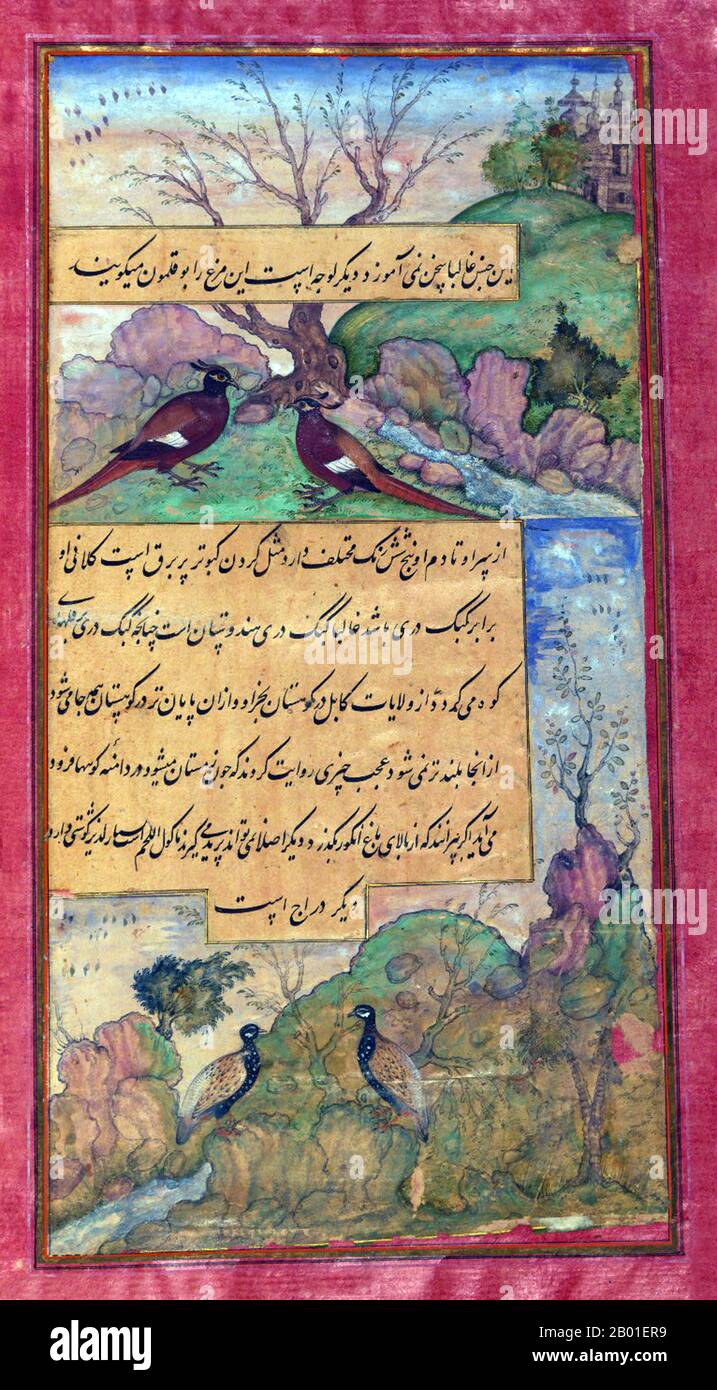 India: Animals of Hindustan - wild birds. Miniature painting from the Baburnama, late 16th century. Bāburnāma (literally: 'Book of Babur' or 'Letters of Babur'; alternatively known as Tuzk-e Babri) is the name given to the memoirs of Ẓahīr ud-Dīn Muḥammad Bābur (1483-1530), founder of the Mughal Empire and a great-great-great-grandson of Timur. It is an autobiographical work, originally written in the Chagatai language, known to Babur as 'Turki' (meaning Turkic), the spoken language of the Andijan-Timurids. Stock Photohttps://www.alamy.com/image-license-details/?v=1https://www.alamy.com/india-animals-of-hindustan-wild-birds-miniature-painting-from-the-baburnama-late-16th-century-bburnma-literally-book-of-babur-or-letters-of-babur-alternatively-known-as-tuzk-e-babri-is-the-name-given-to-the-memoirs-of-ahr-ud-dn-muammad-bbur-1483-1530-founder-of-the-mughal-empire-and-a-great-great-great-grandson-of-timur-it-is-an-autobiographical-work-originally-written-in-the-chagatai-language-known-to-babur-as-turki-meaning-turkic-the-spoken-language-of-the-andijan-timurids-image344240941.html
India: Animals of Hindustan - wild birds. Miniature painting from the Baburnama, late 16th century. Bāburnāma (literally: 'Book of Babur' or 'Letters of Babur'; alternatively known as Tuzk-e Babri) is the name given to the memoirs of Ẓahīr ud-Dīn Muḥammad Bābur (1483-1530), founder of the Mughal Empire and a great-great-great-grandson of Timur. It is an autobiographical work, originally written in the Chagatai language, known to Babur as 'Turki' (meaning Turkic), the spoken language of the Andijan-Timurids. Stock Photohttps://www.alamy.com/image-license-details/?v=1https://www.alamy.com/india-animals-of-hindustan-wild-birds-miniature-painting-from-the-baburnama-late-16th-century-bburnma-literally-book-of-babur-or-letters-of-babur-alternatively-known-as-tuzk-e-babri-is-the-name-given-to-the-memoirs-of-ahr-ud-dn-muammad-bbur-1483-1530-founder-of-the-mughal-empire-and-a-great-great-great-grandson-of-timur-it-is-an-autobiographical-work-originally-written-in-the-chagatai-language-known-to-babur-as-turki-meaning-turkic-the-spoken-language-of-the-andijan-timurids-image344240941.htmlRM2B01ER9–India: Animals of Hindustan - wild birds. Miniature painting from the Baburnama, late 16th century. Bāburnāma (literally: 'Book of Babur' or 'Letters of Babur'; alternatively known as Tuzk-e Babri) is the name given to the memoirs of Ẓahīr ud-Dīn Muḥammad Bābur (1483-1530), founder of the Mughal Empire and a great-great-great-grandson of Timur. It is an autobiographical work, originally written in the Chagatai language, known to Babur as 'Turki' (meaning Turkic), the spoken language of the Andijan-Timurids.
![SULTAN BABER [Babur 14 February 1483 – 26 December 1530), born Zahīr ud-Dīn Muhammad, was the founder of the Mughal Empire and first Emperor of the Mughal dynasty (r. 1526–1530) in the Indian subcontinent. He was a descendant of Timur and Genghis Khan through his father and mother respectively.He was also given the posthumous name of Firdaws Makani ('Dwelling in Paradise')] From the book ' The Oriental annual, or, Lives of the Moghul Emperors ' by the Rev. Hobart Caunter Published by Edward Bull, London 1837 engravings from drawings by William Daniell Stock Photo SULTAN BABER [Babur 14 February 1483 – 26 December 1530), born Zahīr ud-Dīn Muhammad, was the founder of the Mughal Empire and first Emperor of the Mughal dynasty (r. 1526–1530) in the Indian subcontinent. He was a descendant of Timur and Genghis Khan through his father and mother respectively.He was also given the posthumous name of Firdaws Makani ('Dwelling in Paradise')] From the book ' The Oriental annual, or, Lives of the Moghul Emperors ' by the Rev. Hobart Caunter Published by Edward Bull, London 1837 engravings from drawings by William Daniell Stock Photo](https://c8.alamy.com/comp/2H5AKBH/sultan-baber-babur-14-february-1483-26-december-1530-born-zahr-ud-dn-muhammad-was-the-founder-of-the-mughal-empire-and-first-emperor-of-the-mughal-dynasty-r-15261530-in-the-indian-subcontinent-he-was-a-descendant-of-timur-and-genghis-khan-through-his-father-and-mother-respectivelyhe-was-also-given-the-posthumous-name-of-firdaws-makani-dwelling-in-paradise-from-the-book-the-oriental-annual-or-lives-of-the-moghul-emperors-by-the-rev-hobart-caunter-published-by-edward-bull-london-1837-engravings-from-drawings-by-william-daniell-2H5AKBH.jpg) SULTAN BABER [Babur 14 February 1483 – 26 December 1530), born Zahīr ud-Dīn Muhammad, was the founder of the Mughal Empire and first Emperor of the Mughal dynasty (r. 1526–1530) in the Indian subcontinent. He was a descendant of Timur and Genghis Khan through his father and mother respectively.He was also given the posthumous name of Firdaws Makani ('Dwelling in Paradise')] From the book ' The Oriental annual, or, Lives of the Moghul Emperors ' by the Rev. Hobart Caunter Published by Edward Bull, London 1837 engravings from drawings by William Daniell Stock Photohttps://www.alamy.com/image-license-details/?v=1https://www.alamy.com/sultan-baber-babur-14-february-1483-26-december-1530-born-zahr-ud-dn-muhammad-was-the-founder-of-the-mughal-empire-and-first-emperor-of-the-mughal-dynasty-r-15261530-in-the-indian-subcontinent-he-was-a-descendant-of-timur-and-genghis-khan-through-his-father-and-mother-respectivelyhe-was-also-given-the-posthumous-name-of-firdaws-makani-dwelling-in-paradise-from-the-book-the-oriental-annual-or-lives-of-the-moghul-emperors-by-the-rev-hobart-caunter-published-by-edward-bull-london-1837-engravings-from-drawings-by-william-daniell-image450777589.html
SULTAN BABER [Babur 14 February 1483 – 26 December 1530), born Zahīr ud-Dīn Muhammad, was the founder of the Mughal Empire and first Emperor of the Mughal dynasty (r. 1526–1530) in the Indian subcontinent. He was a descendant of Timur and Genghis Khan through his father and mother respectively.He was also given the posthumous name of Firdaws Makani ('Dwelling in Paradise')] From the book ' The Oriental annual, or, Lives of the Moghul Emperors ' by the Rev. Hobart Caunter Published by Edward Bull, London 1837 engravings from drawings by William Daniell Stock Photohttps://www.alamy.com/image-license-details/?v=1https://www.alamy.com/sultan-baber-babur-14-february-1483-26-december-1530-born-zahr-ud-dn-muhammad-was-the-founder-of-the-mughal-empire-and-first-emperor-of-the-mughal-dynasty-r-15261530-in-the-indian-subcontinent-he-was-a-descendant-of-timur-and-genghis-khan-through-his-father-and-mother-respectivelyhe-was-also-given-the-posthumous-name-of-firdaws-makani-dwelling-in-paradise-from-the-book-the-oriental-annual-or-lives-of-the-moghul-emperors-by-the-rev-hobart-caunter-published-by-edward-bull-london-1837-engravings-from-drawings-by-william-daniell-image450777589.htmlRF2H5AKBH–SULTAN BABER [Babur 14 February 1483 – 26 December 1530), born Zahīr ud-Dīn Muhammad, was the founder of the Mughal Empire and first Emperor of the Mughal dynasty (r. 1526–1530) in the Indian subcontinent. He was a descendant of Timur and Genghis Khan through his father and mother respectively.He was also given the posthumous name of Firdaws Makani ('Dwelling in Paradise')] From the book ' The Oriental annual, or, Lives of the Moghul Emperors ' by the Rev. Hobart Caunter Published by Edward Bull, London 1837 engravings from drawings by William Daniell
 Museum of Zahiriddin Babur in Andijan Stock Photohttps://www.alamy.com/image-license-details/?v=1https://www.alamy.com/museum-of-zahiriddin-babur-in-andijan-image332606403.html
Museum of Zahiriddin Babur in Andijan Stock Photohttps://www.alamy.com/image-license-details/?v=1https://www.alamy.com/museum-of-zahiriddin-babur-in-andijan-image332606403.htmlRM2A93ET3–Museum of Zahiriddin Babur in Andijan
 . English: Illustrations from the Manuscript of Baburnama (Memoirs of Babur) - Late 16th Century Bāburnāma is the memoirs of Ẓahīr ud-Dīn Muḥammad Bābur (1483-1530), founder of the Mughal Empire and a great-great-great-grandson of Timur. It is an autobiographical work, originally written in the Chagatai language, known to Babur as 'Turki' (meaning Turkic), the spoken language of the Andijan-Timurids. Because of Babur's cultural origin, his prose is highly Persianized in its sentence structure, morphology, and vocabulary,and also contains many phrases and smaller poems in Persian. During Empero Stock Photohttps://www.alamy.com/image-license-details/?v=1https://www.alamy.com/english-illustrations-from-the-manuscript-of-baburnama-memoirs-of-babur-late-16th-century-bburnma-is-the-memoirs-of-ahr-ud-dn-muammad-bbur-1483-1530-founder-of-the-mughal-empire-and-a-great-great-great-grandson-of-timur-it-is-an-autobiographical-work-originally-written-in-the-chagatai-language-known-to-babur-as-turki-meaning-turkic-the-spoken-language-of-the-andijan-timurids-because-of-baburs-cultural-origin-his-prose-is-highly-persianized-in-its-sentence-structure-morphology-and-vocabularyand-also-contains-many-phrases-and-smaller-poems-in-persian-during-empero-image187567163.html
. English: Illustrations from the Manuscript of Baburnama (Memoirs of Babur) - Late 16th Century Bāburnāma is the memoirs of Ẓahīr ud-Dīn Muḥammad Bābur (1483-1530), founder of the Mughal Empire and a great-great-great-grandson of Timur. It is an autobiographical work, originally written in the Chagatai language, known to Babur as 'Turki' (meaning Turkic), the spoken language of the Andijan-Timurids. Because of Babur's cultural origin, his prose is highly Persianized in its sentence structure, morphology, and vocabulary,and also contains many phrases and smaller poems in Persian. During Empero Stock Photohttps://www.alamy.com/image-license-details/?v=1https://www.alamy.com/english-illustrations-from-the-manuscript-of-baburnama-memoirs-of-babur-late-16th-century-bburnma-is-the-memoirs-of-ahr-ud-dn-muammad-bbur-1483-1530-founder-of-the-mughal-empire-and-a-great-great-great-grandson-of-timur-it-is-an-autobiographical-work-originally-written-in-the-chagatai-language-known-to-babur-as-turki-meaning-turkic-the-spoken-language-of-the-andijan-timurids-because-of-baburs-cultural-origin-his-prose-is-highly-persianized-in-its-sentence-structure-morphology-and-vocabularyand-also-contains-many-phrases-and-smaller-poems-in-persian-during-empero-image187567163.htmlRMMW4BR7–. English: Illustrations from the Manuscript of Baburnama (Memoirs of Babur) - Late 16th Century Bāburnāma is the memoirs of Ẓahīr ud-Dīn Muḥammad Bābur (1483-1530), founder of the Mughal Empire and a great-great-great-grandson of Timur. It is an autobiographical work, originally written in the Chagatai language, known to Babur as 'Turki' (meaning Turkic), the spoken language of the Andijan-Timurids. Because of Babur's cultural origin, his prose is highly Persianized in its sentence structure, morphology, and vocabulary,and also contains many phrases and smaller poems in Persian. During Empero
 India: Babur being entertained at Ghazni by Jahangir Mirza. Miniature painting from the Baburnama, late 16th century. Bāburnāma (literally: 'Book of Babur' or 'Letters of Babur'; alternatively known as Tuzk-e Babri) is the name given to the memoirs of Ẓahīr ud-Dīn Muḥammad Bābur, founder of the Mughal Empire and a great-great-great-grandson of Timur. It is an autobiographical work, originally written in the Chagatai language, known to Babur as 'Turki' (meaning Turkic), the spoken language of the Andijan-Timurids. Stock Photohttps://www.alamy.com/image-license-details/?v=1https://www.alamy.com/india-babur-being-entertained-at-ghazni-by-jahangir-mirza-miniature-painting-from-the-baburnama-late-16th-century-bburnma-literally-book-of-babur-or-letters-of-babur-alternatively-known-as-tuzk-e-babri-is-the-name-given-to-the-memoirs-of-ahr-ud-dn-muammad-bbur-founder-of-the-mughal-empire-and-a-great-great-great-grandson-of-timur-it-is-an-autobiographical-work-originally-written-in-the-chagatai-language-known-to-babur-as-turki-meaning-turkic-the-spoken-language-of-the-andijan-timurids-image344240895.html
India: Babur being entertained at Ghazni by Jahangir Mirza. Miniature painting from the Baburnama, late 16th century. Bāburnāma (literally: 'Book of Babur' or 'Letters of Babur'; alternatively known as Tuzk-e Babri) is the name given to the memoirs of Ẓahīr ud-Dīn Muḥammad Bābur, founder of the Mughal Empire and a great-great-great-grandson of Timur. It is an autobiographical work, originally written in the Chagatai language, known to Babur as 'Turki' (meaning Turkic), the spoken language of the Andijan-Timurids. Stock Photohttps://www.alamy.com/image-license-details/?v=1https://www.alamy.com/india-babur-being-entertained-at-ghazni-by-jahangir-mirza-miniature-painting-from-the-baburnama-late-16th-century-bburnma-literally-book-of-babur-or-letters-of-babur-alternatively-known-as-tuzk-e-babri-is-the-name-given-to-the-memoirs-of-ahr-ud-dn-muammad-bbur-founder-of-the-mughal-empire-and-a-great-great-great-grandson-of-timur-it-is-an-autobiographical-work-originally-written-in-the-chagatai-language-known-to-babur-as-turki-meaning-turkic-the-spoken-language-of-the-andijan-timurids-image344240895.htmlRM2B01ENK–India: Babur being entertained at Ghazni by Jahangir Mirza. Miniature painting from the Baburnama, late 16th century. Bāburnāma (literally: 'Book of Babur' or 'Letters of Babur'; alternatively known as Tuzk-e Babri) is the name given to the memoirs of Ẓahīr ud-Dīn Muḥammad Bābur, founder of the Mughal Empire and a great-great-great-grandson of Timur. It is an autobiographical work, originally written in the Chagatai language, known to Babur as 'Turki' (meaning Turkic), the spoken language of the Andijan-Timurids.
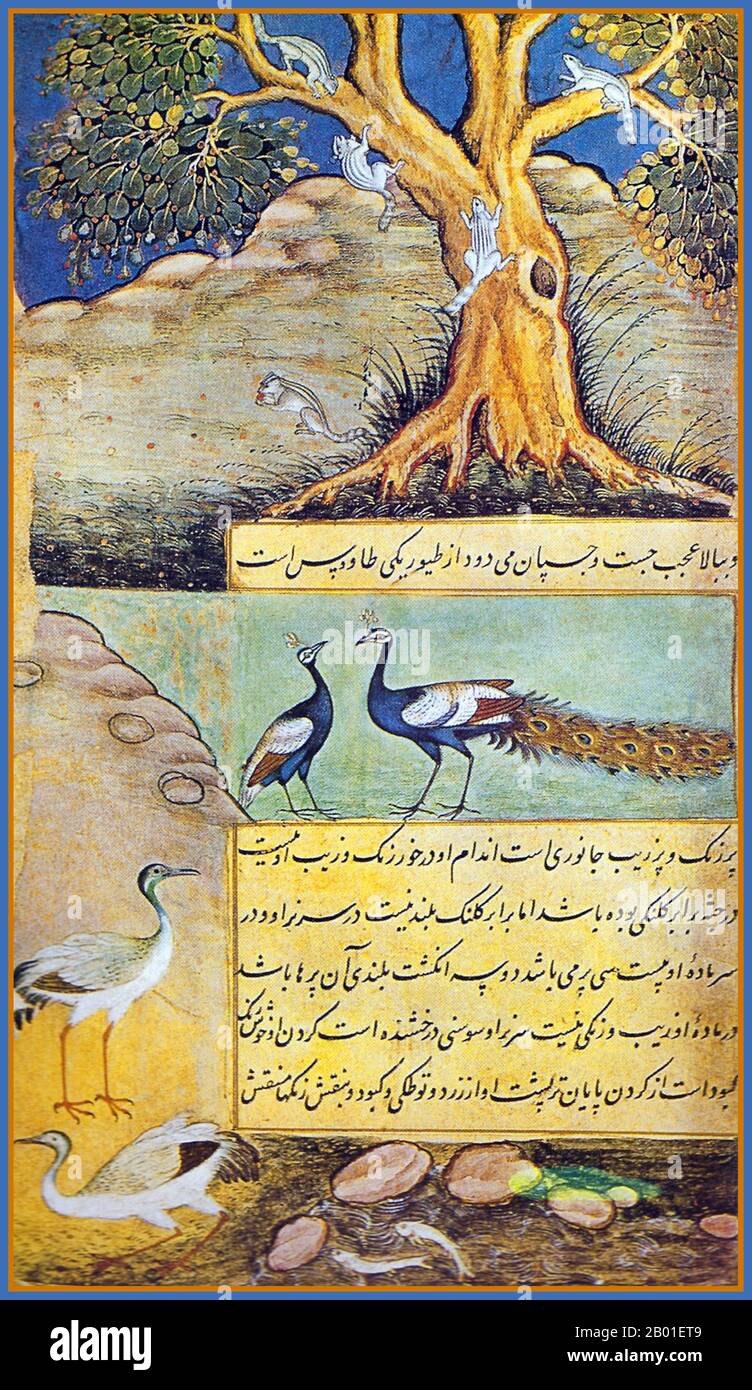 India: Animals of Hindustan - peafowl, cranes and squirrels. Miniature painting from the Baburnama, late 16th century. Bāburnāma (literally: 'Book of Babur' or 'Letters of Babur'; alternatively known as Tuzk-e Babri) is the name given to the memoirs of Ẓahīr ud-Dīn Muḥammad Bābur (1483-1530), founder of the Mughal Empire and a great-great-great-grandson of Timur. It is an autobiographical work, originally written in the Chagatai language, known to Babur as 'Turki' (meaning Turkic), the spoken language of the Andijan-Timurids. Stock Photohttps://www.alamy.com/image-license-details/?v=1https://www.alamy.com/india-animals-of-hindustan-peafowl-cranes-and-squirrels-miniature-painting-from-the-baburnama-late-16th-century-bburnma-literally-book-of-babur-or-letters-of-babur-alternatively-known-as-tuzk-e-babri-is-the-name-given-to-the-memoirs-of-ahr-ud-dn-muammad-bbur-1483-1530-founder-of-the-mughal-empire-and-a-great-great-great-grandson-of-timur-it-is-an-autobiographical-work-originally-written-in-the-chagatai-language-known-to-babur-as-turki-meaning-turkic-the-spoken-language-of-the-andijan-timurids-image344240969.html
India: Animals of Hindustan - peafowl, cranes and squirrels. Miniature painting from the Baburnama, late 16th century. Bāburnāma (literally: 'Book of Babur' or 'Letters of Babur'; alternatively known as Tuzk-e Babri) is the name given to the memoirs of Ẓahīr ud-Dīn Muḥammad Bābur (1483-1530), founder of the Mughal Empire and a great-great-great-grandson of Timur. It is an autobiographical work, originally written in the Chagatai language, known to Babur as 'Turki' (meaning Turkic), the spoken language of the Andijan-Timurids. Stock Photohttps://www.alamy.com/image-license-details/?v=1https://www.alamy.com/india-animals-of-hindustan-peafowl-cranes-and-squirrels-miniature-painting-from-the-baburnama-late-16th-century-bburnma-literally-book-of-babur-or-letters-of-babur-alternatively-known-as-tuzk-e-babri-is-the-name-given-to-the-memoirs-of-ahr-ud-dn-muammad-bbur-1483-1530-founder-of-the-mughal-empire-and-a-great-great-great-grandson-of-timur-it-is-an-autobiographical-work-originally-written-in-the-chagatai-language-known-to-babur-as-turki-meaning-turkic-the-spoken-language-of-the-andijan-timurids-image344240969.htmlRM2B01ET9–India: Animals of Hindustan - peafowl, cranes and squirrels. Miniature painting from the Baburnama, late 16th century. Bāburnāma (literally: 'Book of Babur' or 'Letters of Babur'; alternatively known as Tuzk-e Babri) is the name given to the memoirs of Ẓahīr ud-Dīn Muḥammad Bābur (1483-1530), founder of the Mughal Empire and a great-great-great-grandson of Timur. It is an autobiographical work, originally written in the Chagatai language, known to Babur as 'Turki' (meaning Turkic), the spoken language of the Andijan-Timurids.
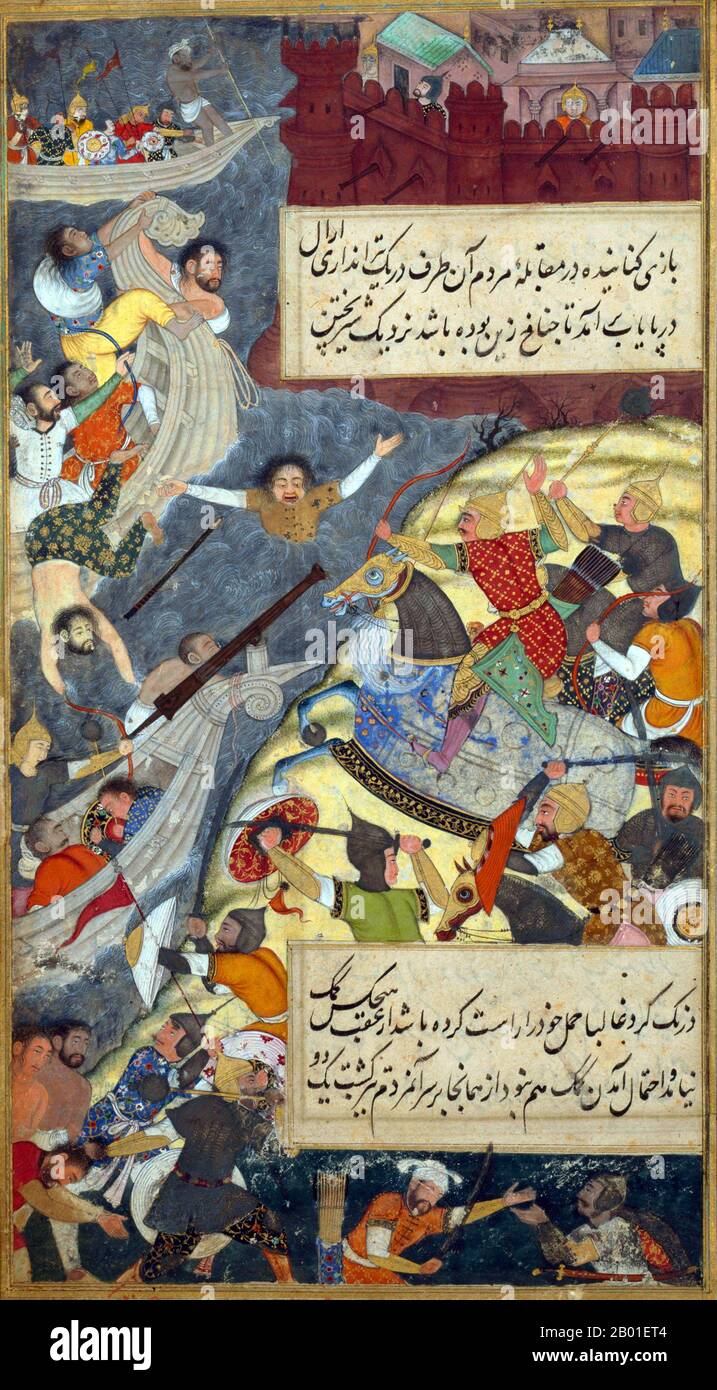 India: A battle by the banks of the River Indus. Miniature painting from the Baburnama, c. 1589. Bāburnāma (literally: 'Book of Babur' or 'Letters of Babur'; alternatively known as Tuzk-e Babri) is the name given to the memoirs of Ẓahīr ud-Dīn Muḥammad Bābur (1483-1530), founder of the Mughal Empire and a great-great-great-grandson of Timur. It is an autobiographical work, originally written in the Chagatai language, known to Babur as 'Turki' (meaning Turkic), the spoken language of the Andijan-Timurids. Stock Photohttps://www.alamy.com/image-license-details/?v=1https://www.alamy.com/india-a-battle-by-the-banks-of-the-river-indus-miniature-painting-from-the-baburnama-c-1589-bburnma-literally-book-of-babur-or-letters-of-babur-alternatively-known-as-tuzk-e-babri-is-the-name-given-to-the-memoirs-of-ahr-ud-dn-muammad-bbur-1483-1530-founder-of-the-mughal-empire-and-a-great-great-great-grandson-of-timur-it-is-an-autobiographical-work-originally-written-in-the-chagatai-language-known-to-babur-as-turki-meaning-turkic-the-spoken-language-of-the-andijan-timurids-image344240964.html
India: A battle by the banks of the River Indus. Miniature painting from the Baburnama, c. 1589. Bāburnāma (literally: 'Book of Babur' or 'Letters of Babur'; alternatively known as Tuzk-e Babri) is the name given to the memoirs of Ẓahīr ud-Dīn Muḥammad Bābur (1483-1530), founder of the Mughal Empire and a great-great-great-grandson of Timur. It is an autobiographical work, originally written in the Chagatai language, known to Babur as 'Turki' (meaning Turkic), the spoken language of the Andijan-Timurids. Stock Photohttps://www.alamy.com/image-license-details/?v=1https://www.alamy.com/india-a-battle-by-the-banks-of-the-river-indus-miniature-painting-from-the-baburnama-c-1589-bburnma-literally-book-of-babur-or-letters-of-babur-alternatively-known-as-tuzk-e-babri-is-the-name-given-to-the-memoirs-of-ahr-ud-dn-muammad-bbur-1483-1530-founder-of-the-mughal-empire-and-a-great-great-great-grandson-of-timur-it-is-an-autobiographical-work-originally-written-in-the-chagatai-language-known-to-babur-as-turki-meaning-turkic-the-spoken-language-of-the-andijan-timurids-image344240964.htmlRM2B01ET4–India: A battle by the banks of the River Indus. Miniature painting from the Baburnama, c. 1589. Bāburnāma (literally: 'Book of Babur' or 'Letters of Babur'; alternatively known as Tuzk-e Babri) is the name given to the memoirs of Ẓahīr ud-Dīn Muḥammad Bābur (1483-1530), founder of the Mughal Empire and a great-great-great-grandson of Timur. It is an autobiographical work, originally written in the Chagatai language, known to Babur as 'Turki' (meaning Turkic), the spoken language of the Andijan-Timurids.
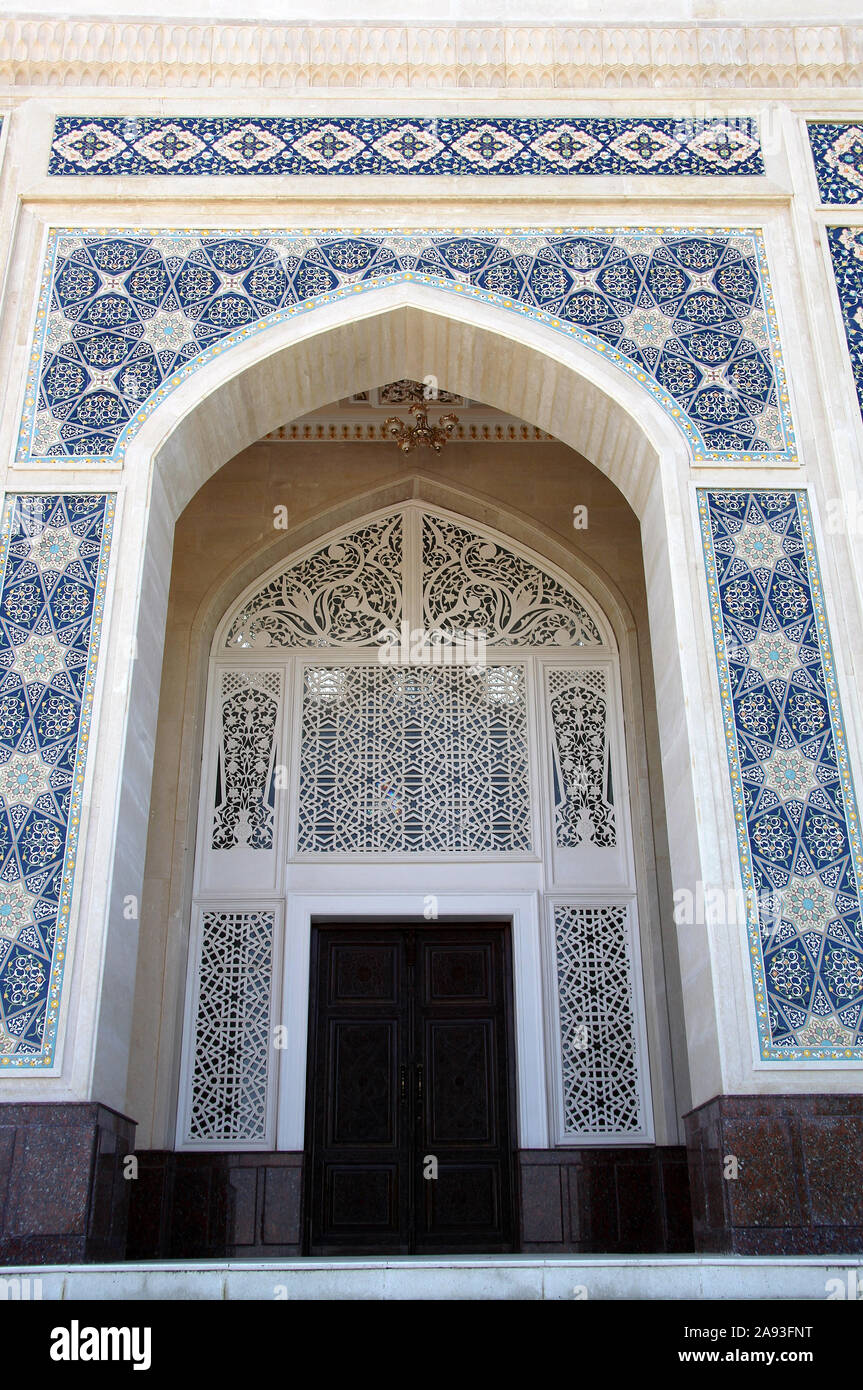 Museum of Zahiriddin Babur in Andijan Stock Photohttps://www.alamy.com/image-license-details/?v=1https://www.alamy.com/museum-of-zahiriddin-babur-in-andijan-image332607124.html
Museum of Zahiriddin Babur in Andijan Stock Photohttps://www.alamy.com/image-license-details/?v=1https://www.alamy.com/museum-of-zahiriddin-babur-in-andijan-image332607124.htmlRM2A93FNT–Museum of Zahiriddin Babur in Andijan
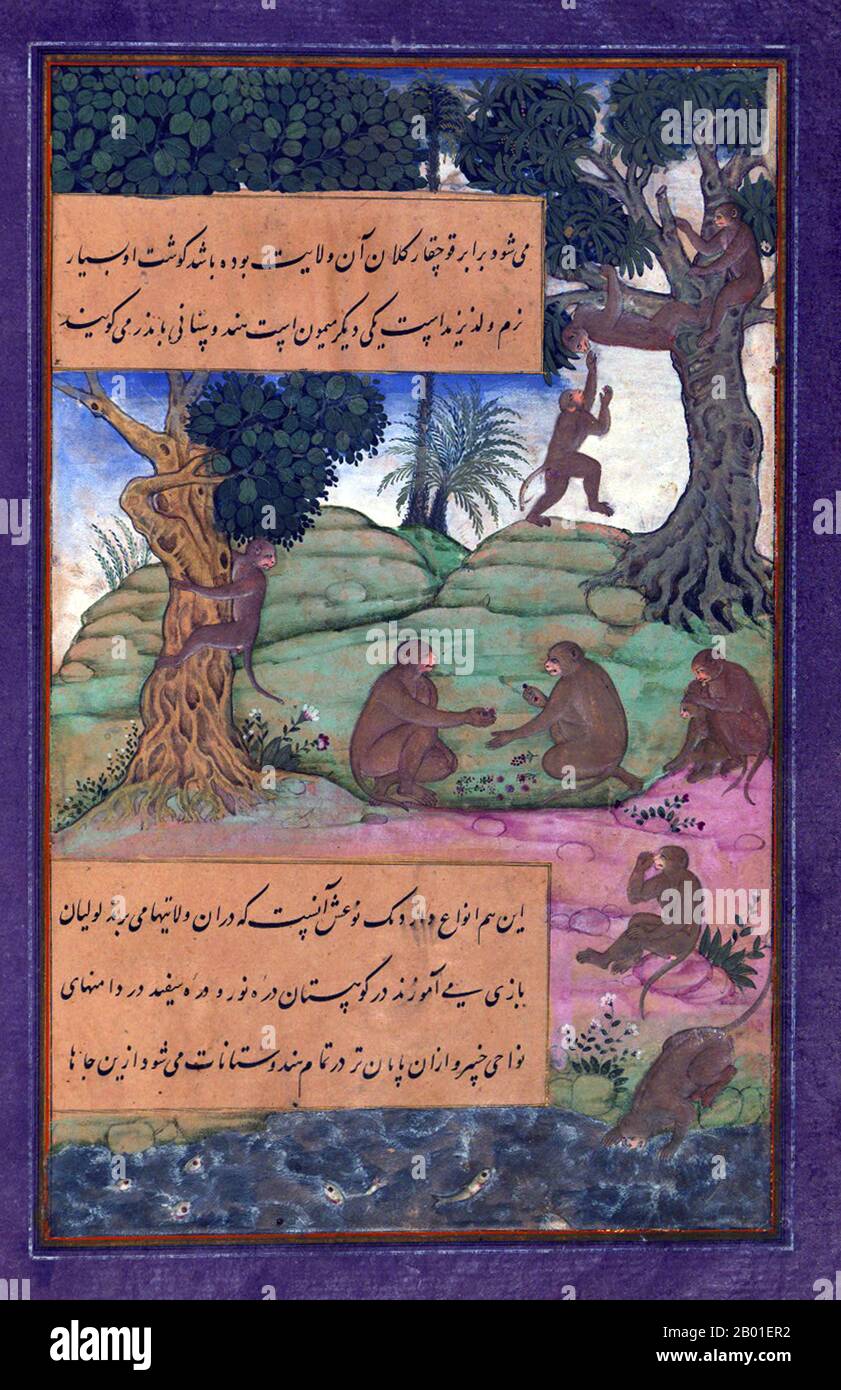 India: Animals of Hindustan - monkeys that can be taught to do tricks. Miniature painting from the Baburnama, late 16th century. Bāburnāma (literally: 'Book of Babur' or 'Letters of Babur'; alternatively known as Tuzk-e Babri) is the name given to the memoirs of Ẓahīr ud-Dīn Muḥammad Bābur (1483-1530), founder of the Mughal Empire and a great-great-great-grandson of Timur. It is an autobiographical work, originally written in the Chagatai language, known to Babur as 'Turki' (meaning Turkic), the spoken language of the Andijan-Timurids. Stock Photohttps://www.alamy.com/image-license-details/?v=1https://www.alamy.com/india-animals-of-hindustan-monkeys-that-can-be-taught-to-do-tricks-miniature-painting-from-the-baburnama-late-16th-century-bburnma-literally-book-of-babur-or-letters-of-babur-alternatively-known-as-tuzk-e-babri-is-the-name-given-to-the-memoirs-of-ahr-ud-dn-muammad-bbur-1483-1530-founder-of-the-mughal-empire-and-a-great-great-great-grandson-of-timur-it-is-an-autobiographical-work-originally-written-in-the-chagatai-language-known-to-babur-as-turki-meaning-turkic-the-spoken-language-of-the-andijan-timurids-image344240934.html
India: Animals of Hindustan - monkeys that can be taught to do tricks. Miniature painting from the Baburnama, late 16th century. Bāburnāma (literally: 'Book of Babur' or 'Letters of Babur'; alternatively known as Tuzk-e Babri) is the name given to the memoirs of Ẓahīr ud-Dīn Muḥammad Bābur (1483-1530), founder of the Mughal Empire and a great-great-great-grandson of Timur. It is an autobiographical work, originally written in the Chagatai language, known to Babur as 'Turki' (meaning Turkic), the spoken language of the Andijan-Timurids. Stock Photohttps://www.alamy.com/image-license-details/?v=1https://www.alamy.com/india-animals-of-hindustan-monkeys-that-can-be-taught-to-do-tricks-miniature-painting-from-the-baburnama-late-16th-century-bburnma-literally-book-of-babur-or-letters-of-babur-alternatively-known-as-tuzk-e-babri-is-the-name-given-to-the-memoirs-of-ahr-ud-dn-muammad-bbur-1483-1530-founder-of-the-mughal-empire-and-a-great-great-great-grandson-of-timur-it-is-an-autobiographical-work-originally-written-in-the-chagatai-language-known-to-babur-as-turki-meaning-turkic-the-spoken-language-of-the-andijan-timurids-image344240934.htmlRM2B01ER2–India: Animals of Hindustan - monkeys that can be taught to do tricks. Miniature painting from the Baburnama, late 16th century. Bāburnāma (literally: 'Book of Babur' or 'Letters of Babur'; alternatively known as Tuzk-e Babri) is the name given to the memoirs of Ẓahīr ud-Dīn Muḥammad Bābur (1483-1530), founder of the Mughal Empire and a great-great-great-grandson of Timur. It is an autobiographical work, originally written in the Chagatai language, known to Babur as 'Turki' (meaning Turkic), the spoken language of the Andijan-Timurids.
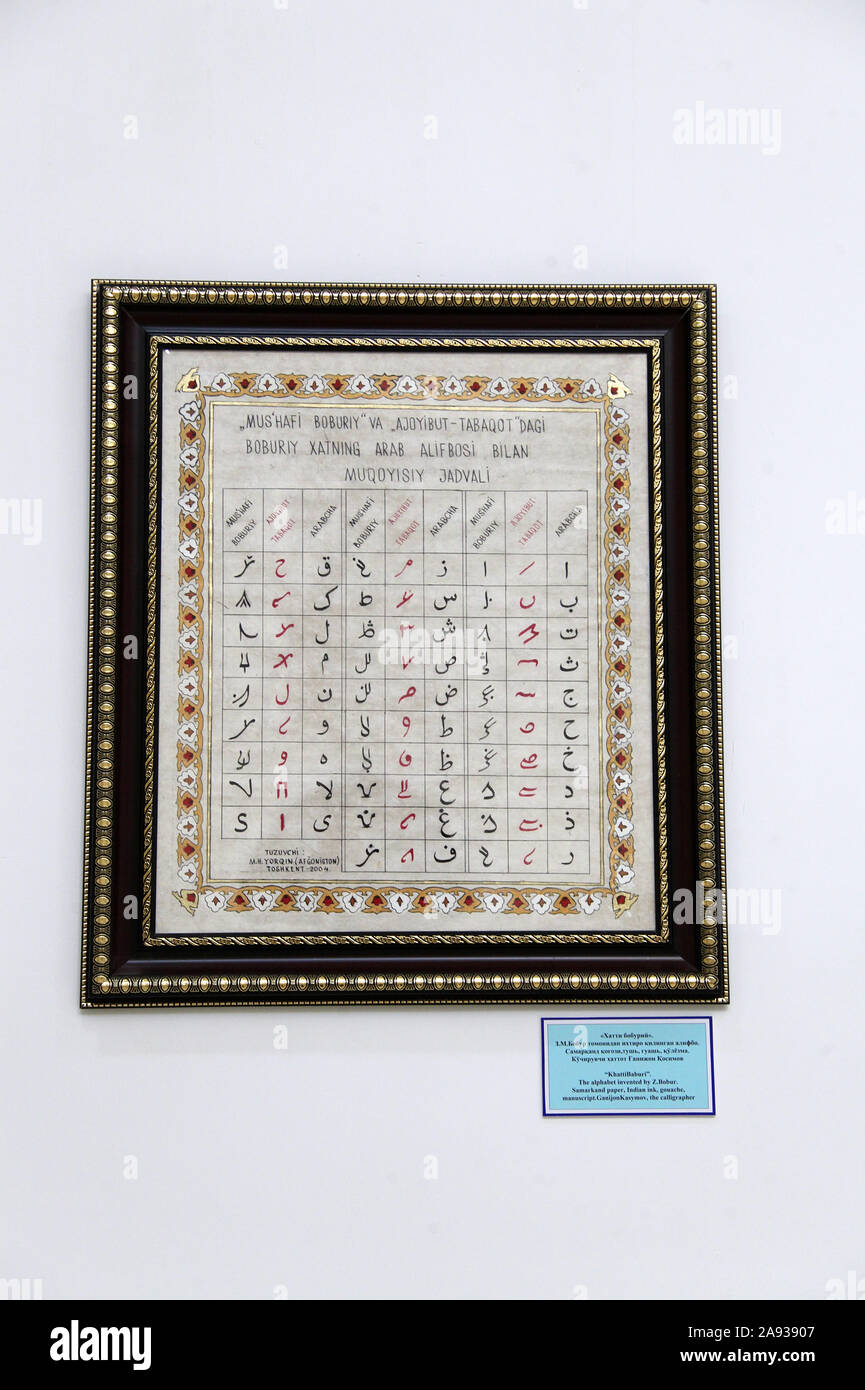 Alphabet invented by Babur displayed at the new museum in Andijan Stock Photohttps://www.alamy.com/image-license-details/?v=1https://www.alamy.com/alphabet-invented-by-babur-displayed-at-the-new-museum-in-andijan-image332601815.html
Alphabet invented by Babur displayed at the new museum in Andijan Stock Photohttps://www.alamy.com/image-license-details/?v=1https://www.alamy.com/alphabet-invented-by-babur-displayed-at-the-new-museum-in-andijan-image332601815.htmlRM2A93907–Alphabet invented by Babur displayed at the new museum in Andijan
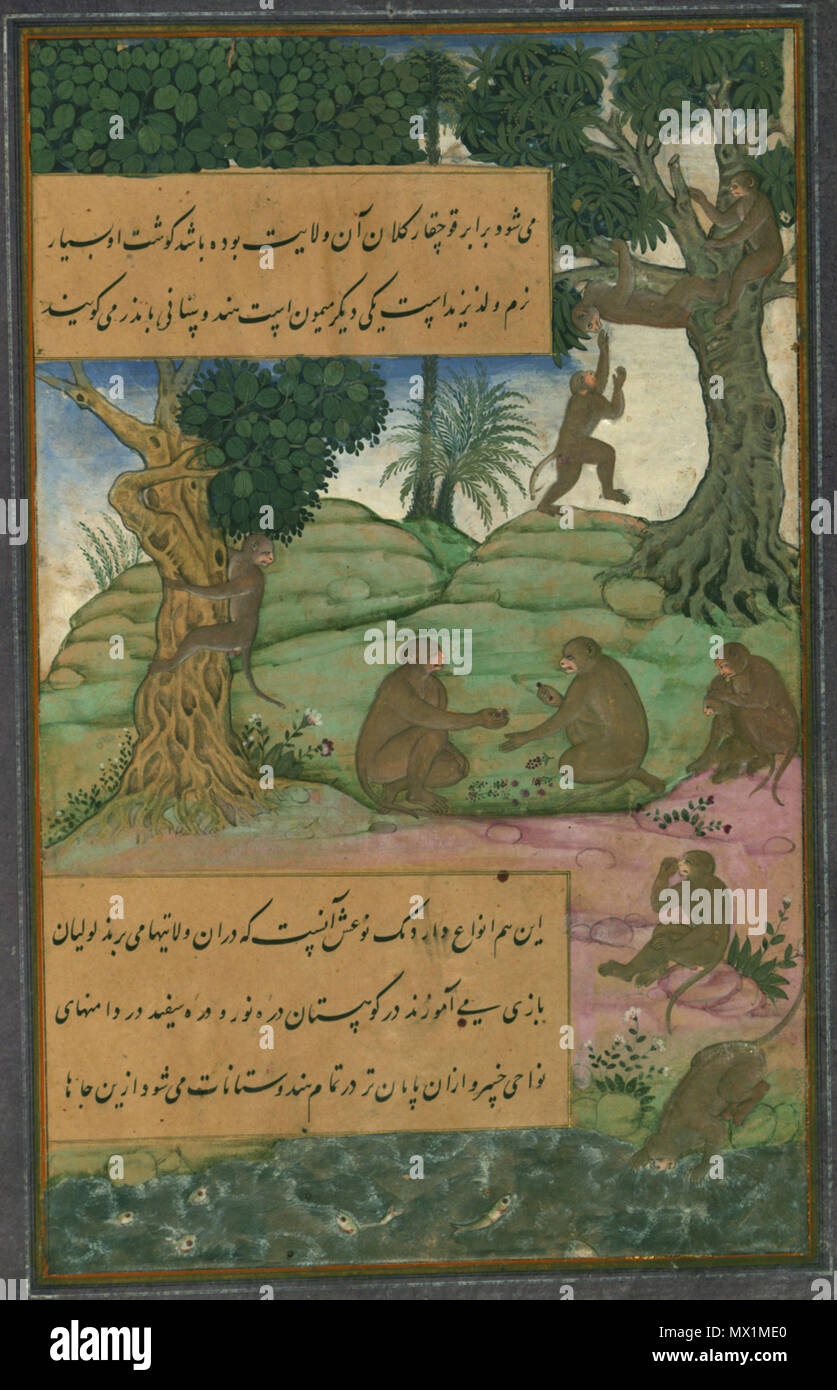 . English: Illustrations from the Manuscript of Baburnama (Memoirs of Babur) - Late 16th Century Bāburnāma is the memoirs of Ẓahīr ud-Dīn Muḥammad Bābur (1483-1530), founder of the Mughal Empire and a great-great-great-grandson of Timur. It is an autobiographical work, originally written in the Chagatai language, known to Babur as 'Turki' (meaning Turkic), the spoken language of the Andijan-Timurids. Because of Babur's cultural origin, his prose is highly Persianized in its sentence structure, morphology, and vocabulary,and also contains many phrases and smaller poems in Persian. During Empero Stock Photohttps://www.alamy.com/image-license-details/?v=1https://www.alamy.com/english-illustrations-from-the-manuscript-of-baburnama-memoirs-of-babur-late-16th-century-bburnma-is-the-memoirs-of-ahr-ud-dn-muammad-bbur-1483-1530-founder-of-the-mughal-empire-and-a-great-great-great-grandson-of-timur-it-is-an-autobiographical-work-originally-written-in-the-chagatai-language-known-to-babur-as-turki-meaning-turkic-the-spoken-language-of-the-andijan-timurids-because-of-baburs-cultural-origin-his-prose-is-highly-persianized-in-its-sentence-structure-morphology-and-vocabularyand-also-contains-many-phrases-and-smaller-poems-in-persian-during-empero-image188122760.html
. English: Illustrations from the Manuscript of Baburnama (Memoirs of Babur) - Late 16th Century Bāburnāma is the memoirs of Ẓahīr ud-Dīn Muḥammad Bābur (1483-1530), founder of the Mughal Empire and a great-great-great-grandson of Timur. It is an autobiographical work, originally written in the Chagatai language, known to Babur as 'Turki' (meaning Turkic), the spoken language of the Andijan-Timurids. Because of Babur's cultural origin, his prose is highly Persianized in its sentence structure, morphology, and vocabulary,and also contains many phrases and smaller poems in Persian. During Empero Stock Photohttps://www.alamy.com/image-license-details/?v=1https://www.alamy.com/english-illustrations-from-the-manuscript-of-baburnama-memoirs-of-babur-late-16th-century-bburnma-is-the-memoirs-of-ahr-ud-dn-muammad-bbur-1483-1530-founder-of-the-mughal-empire-and-a-great-great-great-grandson-of-timur-it-is-an-autobiographical-work-originally-written-in-the-chagatai-language-known-to-babur-as-turki-meaning-turkic-the-spoken-language-of-the-andijan-timurids-because-of-baburs-cultural-origin-his-prose-is-highly-persianized-in-its-sentence-structure-morphology-and-vocabularyand-also-contains-many-phrases-and-smaller-poems-in-persian-during-empero-image188122760.htmlRMMX1ME0–. English: Illustrations from the Manuscript of Baburnama (Memoirs of Babur) - Late 16th Century Bāburnāma is the memoirs of Ẓahīr ud-Dīn Muḥammad Bābur (1483-1530), founder of the Mughal Empire and a great-great-great-grandson of Timur. It is an autobiographical work, originally written in the Chagatai language, known to Babur as 'Turki' (meaning Turkic), the spoken language of the Andijan-Timurids. Because of Babur's cultural origin, his prose is highly Persianized in its sentence structure, morphology, and vocabulary,and also contains many phrases and smaller poems in Persian. During Empero
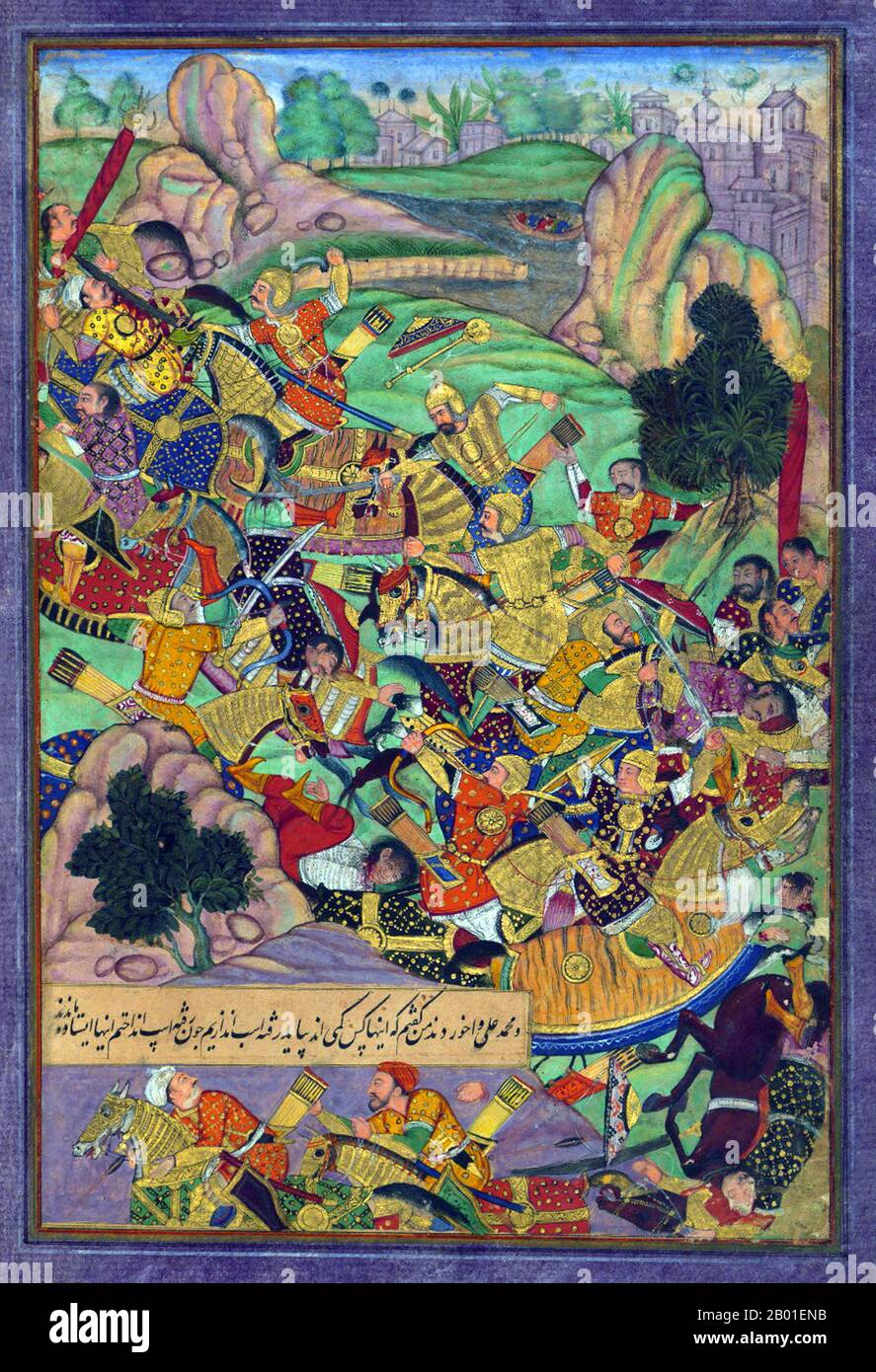 India: Zahir ud-din Muhammad Babur (1483-1531), the first Mughal Emperor, confronts his enemies. Miniature painting from the Baburnama, 16th century. Bāburnāma (literally: 'Book of Babur' or 'Letters of Babur'; alternatively known as Tuzk-e Babri) is the name given to the memoirs of Ẓahīr ud-Dīn Muḥammad Bābu, founder of the Mughal Empire and a great-great-great-grandson of Timur. It is an autobiographical work, originally written in the Chagatai language, known to Babur as 'Turki' (meaning Turkic), the spoken language of the Andijan-Timurids. Stock Photohttps://www.alamy.com/image-license-details/?v=1https://www.alamy.com/india-zahir-ud-din-muhammad-babur-1483-1531-the-first-mughal-emperor-confronts-his-enemies-miniature-painting-from-the-baburnama-16th-century-bburnma-literally-book-of-babur-or-letters-of-babur-alternatively-known-as-tuzk-e-babri-is-the-name-given-to-the-memoirs-of-ahr-ud-dn-muammad-bbu-founder-of-the-mughal-empire-and-a-great-great-great-grandson-of-timur-it-is-an-autobiographical-work-originally-written-in-the-chagatai-language-known-to-babur-as-turki-meaning-turkic-the-spoken-language-of-the-andijan-timurids-image344240887.html
India: Zahir ud-din Muhammad Babur (1483-1531), the first Mughal Emperor, confronts his enemies. Miniature painting from the Baburnama, 16th century. Bāburnāma (literally: 'Book of Babur' or 'Letters of Babur'; alternatively known as Tuzk-e Babri) is the name given to the memoirs of Ẓahīr ud-Dīn Muḥammad Bābu, founder of the Mughal Empire and a great-great-great-grandson of Timur. It is an autobiographical work, originally written in the Chagatai language, known to Babur as 'Turki' (meaning Turkic), the spoken language of the Andijan-Timurids. Stock Photohttps://www.alamy.com/image-license-details/?v=1https://www.alamy.com/india-zahir-ud-din-muhammad-babur-1483-1531-the-first-mughal-emperor-confronts-his-enemies-miniature-painting-from-the-baburnama-16th-century-bburnma-literally-book-of-babur-or-letters-of-babur-alternatively-known-as-tuzk-e-babri-is-the-name-given-to-the-memoirs-of-ahr-ud-dn-muammad-bbu-founder-of-the-mughal-empire-and-a-great-great-great-grandson-of-timur-it-is-an-autobiographical-work-originally-written-in-the-chagatai-language-known-to-babur-as-turki-meaning-turkic-the-spoken-language-of-the-andijan-timurids-image344240887.htmlRM2B01ENB–India: Zahir ud-din Muhammad Babur (1483-1531), the first Mughal Emperor, confronts his enemies. Miniature painting from the Baburnama, 16th century. Bāburnāma (literally: 'Book of Babur' or 'Letters of Babur'; alternatively known as Tuzk-e Babri) is the name given to the memoirs of Ẓahīr ud-Dīn Muḥammad Bābu, founder of the Mughal Empire and a great-great-great-grandson of Timur. It is an autobiographical work, originally written in the Chagatai language, known to Babur as 'Turki' (meaning Turkic), the spoken language of the Andijan-Timurids.
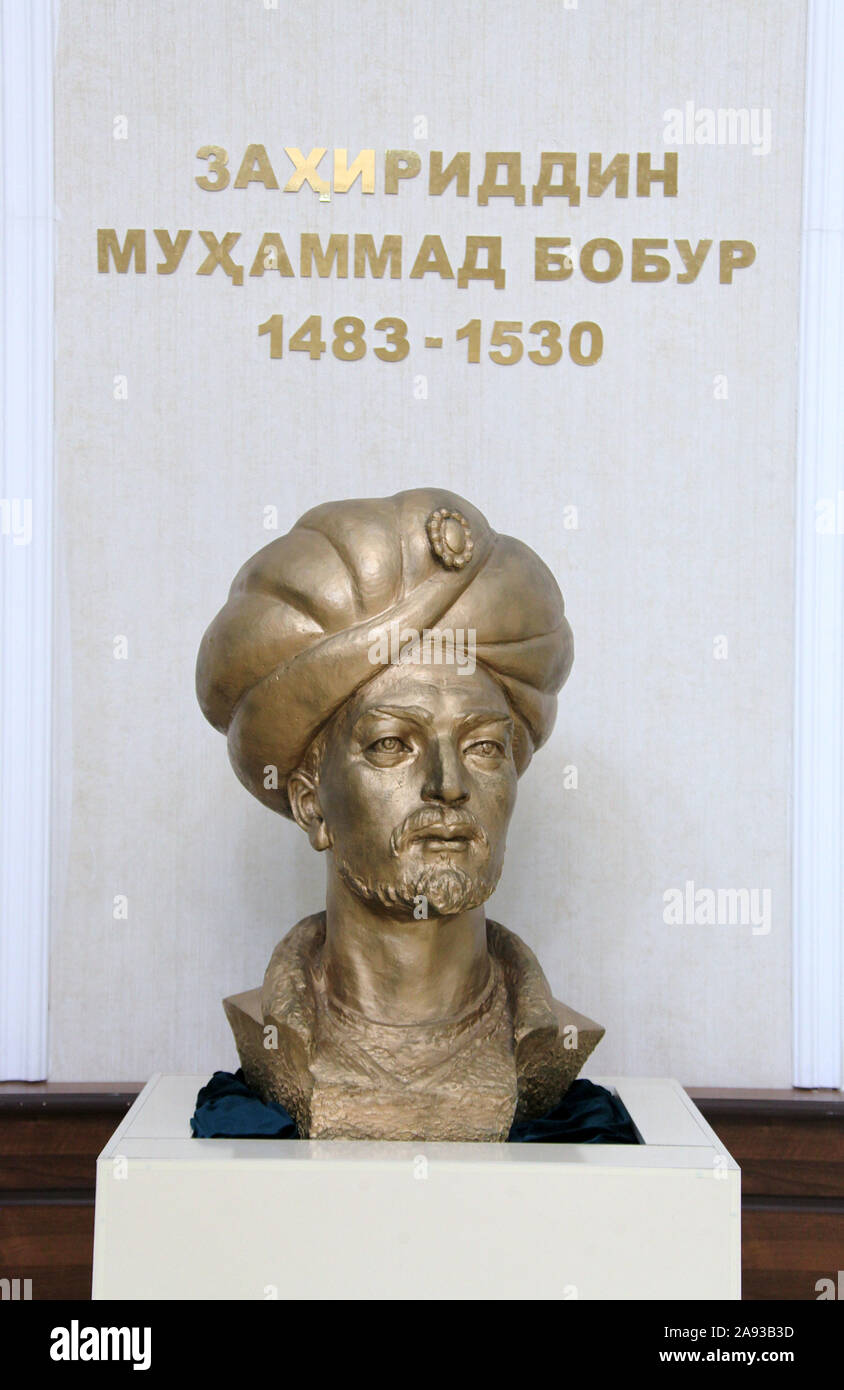 Bust of Zahiriddin Muhammad Bobur at his new museum in Andijan Stock Photohttps://www.alamy.com/image-license-details/?v=1https://www.alamy.com/bust-of-zahiriddin-muhammad-bobur-at-his-new-museum-in-andijan-image332603473.html
Bust of Zahiriddin Muhammad Bobur at his new museum in Andijan Stock Photohttps://www.alamy.com/image-license-details/?v=1https://www.alamy.com/bust-of-zahiriddin-muhammad-bobur-at-his-new-museum-in-andijan-image332603473.htmlRM2A93B3D–Bust of Zahiriddin Muhammad Bobur at his new museum in Andijan
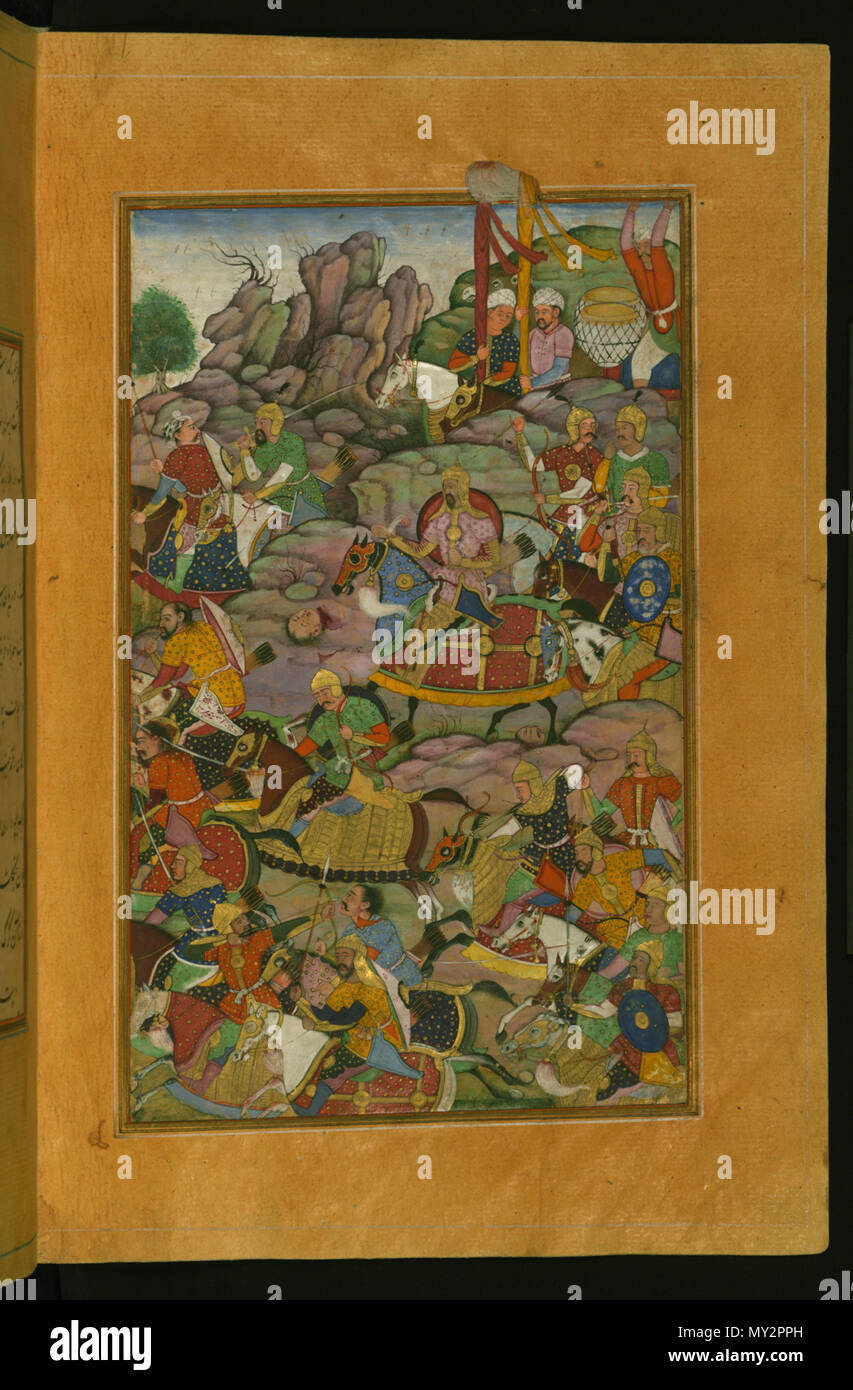 . English: Illustrations from the Manuscript of Baburnama (Memoirs of Babur) - Late 16th Century Bāburnāma is the memoirs of Ẓahīr ud-Dīn Muḥammad Bābur (1483-1530), founder of the Mughal Empire and a great-great-great-grandson of Timur. It is an autobiographical work, originally written in the Chagatai language, known to Babur as 'Turki' (meaning Turkic), the spoken language of the Andijan-Timurids. Because of Babur's cultural origin, his prose is highly Persianized in its sentence structure, morphology, and vocabulary,and also contains many phrases and smaller poems in Persian. During Empero Stock Photohttps://www.alamy.com/image-license-details/?v=1https://www.alamy.com/english-illustrations-from-the-manuscript-of-baburnama-memoirs-of-babur-late-16th-century-bburnma-is-the-memoirs-of-ahr-ud-dn-muammad-bbur-1483-1530-founder-of-the-mughal-empire-and-a-great-great-great-grandson-of-timur-it-is-an-autobiographical-work-originally-written-in-the-chagatai-language-known-to-babur-as-turki-meaning-turkic-the-spoken-language-of-the-andijan-timurids-because-of-baburs-cultural-origin-his-prose-is-highly-persianized-in-its-sentence-structure-morphology-and-vocabularyand-also-contains-many-phrases-and-smaller-poems-in-persian-during-empero-image188761177.html
. English: Illustrations from the Manuscript of Baburnama (Memoirs of Babur) - Late 16th Century Bāburnāma is the memoirs of Ẓahīr ud-Dīn Muḥammad Bābur (1483-1530), founder of the Mughal Empire and a great-great-great-grandson of Timur. It is an autobiographical work, originally written in the Chagatai language, known to Babur as 'Turki' (meaning Turkic), the spoken language of the Andijan-Timurids. Because of Babur's cultural origin, his prose is highly Persianized in its sentence structure, morphology, and vocabulary,and also contains many phrases and smaller poems in Persian. During Empero Stock Photohttps://www.alamy.com/image-license-details/?v=1https://www.alamy.com/english-illustrations-from-the-manuscript-of-baburnama-memoirs-of-babur-late-16th-century-bburnma-is-the-memoirs-of-ahr-ud-dn-muammad-bbur-1483-1530-founder-of-the-mughal-empire-and-a-great-great-great-grandson-of-timur-it-is-an-autobiographical-work-originally-written-in-the-chagatai-language-known-to-babur-as-turki-meaning-turkic-the-spoken-language-of-the-andijan-timurids-because-of-baburs-cultural-origin-his-prose-is-highly-persianized-in-its-sentence-structure-morphology-and-vocabularyand-also-contains-many-phrases-and-smaller-poems-in-persian-during-empero-image188761177.htmlRMMY2PPH–. English: Illustrations from the Manuscript of Baburnama (Memoirs of Babur) - Late 16th Century Bāburnāma is the memoirs of Ẓahīr ud-Dīn Muḥammad Bābur (1483-1530), founder of the Mughal Empire and a great-great-great-grandson of Timur. It is an autobiographical work, originally written in the Chagatai language, known to Babur as 'Turki' (meaning Turkic), the spoken language of the Andijan-Timurids. Because of Babur's cultural origin, his prose is highly Persianized in its sentence structure, morphology, and vocabulary,and also contains many phrases and smaller poems in Persian. During Empero
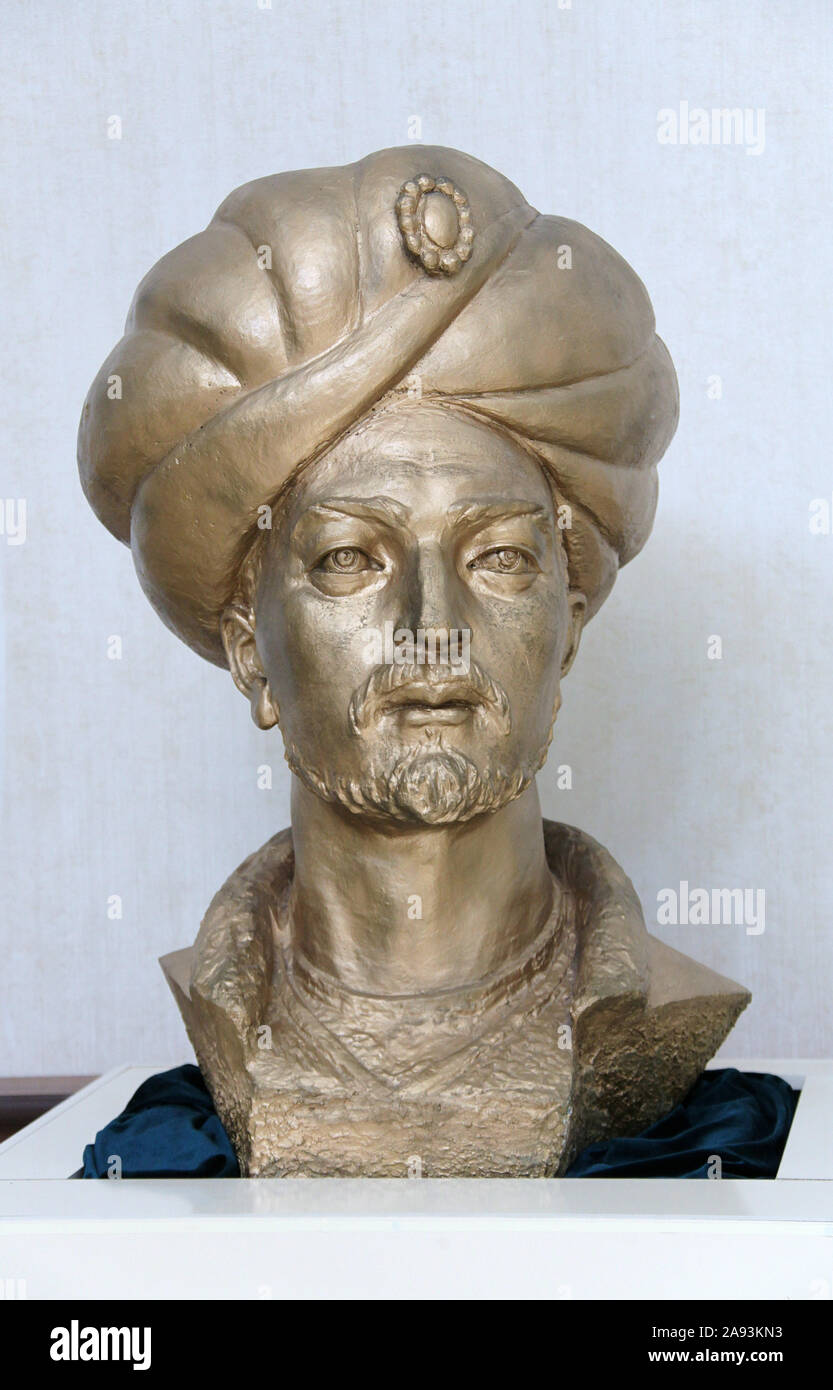 Bust of Zahiriddin Muhammad Bobur at his new museum in Andijan Stock Photohttps://www.alamy.com/image-license-details/?v=1https://www.alamy.com/bust-of-zahiriddin-muhammad-bobur-at-his-new-museum-in-andijan-image332610239.html
Bust of Zahiriddin Muhammad Bobur at his new museum in Andijan Stock Photohttps://www.alamy.com/image-license-details/?v=1https://www.alamy.com/bust-of-zahiriddin-muhammad-bobur-at-his-new-museum-in-andijan-image332610239.htmlRM2A93KN3–Bust of Zahiriddin Muhammad Bobur at his new museum in Andijan
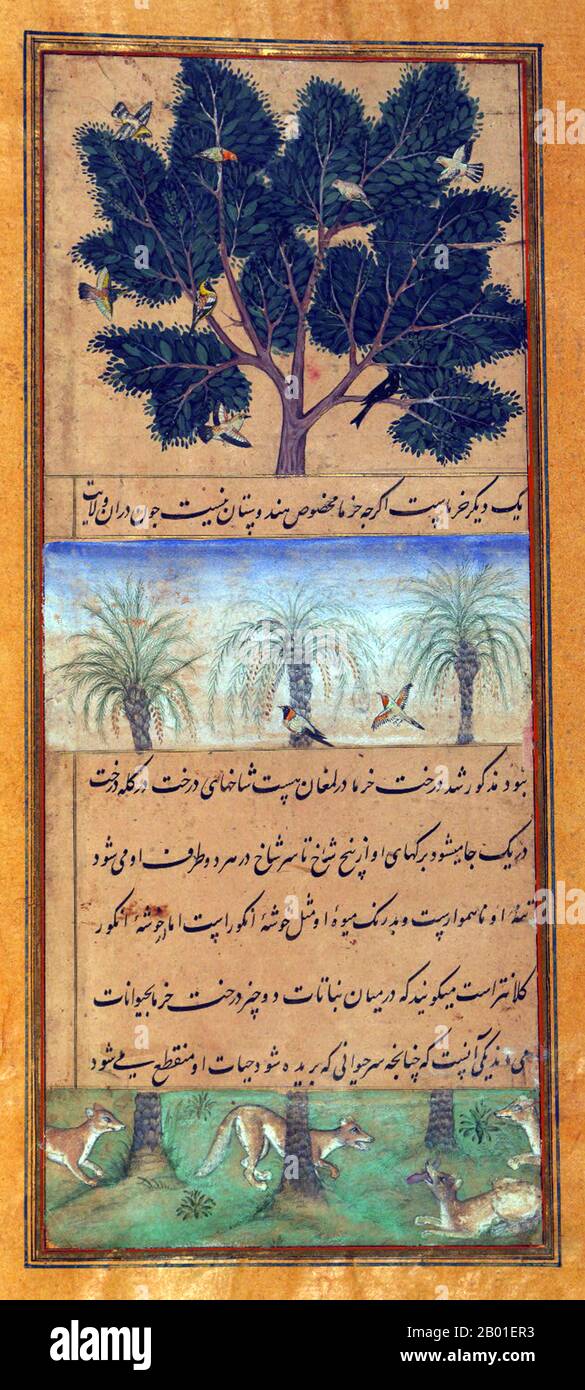 India: Animals of Hindustan - birds, foxes and palm trees. Miniature painting from the Baburnama, late 16th century. Bāburnāma (literally: 'Book of Babur' or 'Letters of Babur'; alternatively known as Tuzk-e Babri) is the name given to the memoirs of Ẓahīr ud-Dīn Muḥammad Bābur (1483-1530), founder of the Mughal Empire and a great-great-great-grandson of Timur. It is an autobiographical work, originally written in the Chagatai language, known to Babur as 'Turki' (meaning Turkic), the spoken language of the Andijan-Timurids. Stock Photohttps://www.alamy.com/image-license-details/?v=1https://www.alamy.com/india-animals-of-hindustan-birds-foxes-and-palm-trees-miniature-painting-from-the-baburnama-late-16th-century-bburnma-literally-book-of-babur-or-letters-of-babur-alternatively-known-as-tuzk-e-babri-is-the-name-given-to-the-memoirs-of-ahr-ud-dn-muammad-bbur-1483-1530-founder-of-the-mughal-empire-and-a-great-great-great-grandson-of-timur-it-is-an-autobiographical-work-originally-written-in-the-chagatai-language-known-to-babur-as-turki-meaning-turkic-the-spoken-language-of-the-andijan-timurids-image344240935.html
India: Animals of Hindustan - birds, foxes and palm trees. Miniature painting from the Baburnama, late 16th century. Bāburnāma (literally: 'Book of Babur' or 'Letters of Babur'; alternatively known as Tuzk-e Babri) is the name given to the memoirs of Ẓahīr ud-Dīn Muḥammad Bābur (1483-1530), founder of the Mughal Empire and a great-great-great-grandson of Timur. It is an autobiographical work, originally written in the Chagatai language, known to Babur as 'Turki' (meaning Turkic), the spoken language of the Andijan-Timurids. Stock Photohttps://www.alamy.com/image-license-details/?v=1https://www.alamy.com/india-animals-of-hindustan-birds-foxes-and-palm-trees-miniature-painting-from-the-baburnama-late-16th-century-bburnma-literally-book-of-babur-or-letters-of-babur-alternatively-known-as-tuzk-e-babri-is-the-name-given-to-the-memoirs-of-ahr-ud-dn-muammad-bbur-1483-1530-founder-of-the-mughal-empire-and-a-great-great-great-grandson-of-timur-it-is-an-autobiographical-work-originally-written-in-the-chagatai-language-known-to-babur-as-turki-meaning-turkic-the-spoken-language-of-the-andijan-timurids-image344240935.htmlRM2B01ER3–India: Animals of Hindustan - birds, foxes and palm trees. Miniature painting from the Baburnama, late 16th century. Bāburnāma (literally: 'Book of Babur' or 'Letters of Babur'; alternatively known as Tuzk-e Babri) is the name given to the memoirs of Ẓahīr ud-Dīn Muḥammad Bābur (1483-1530), founder of the Mughal Empire and a great-great-great-grandson of Timur. It is an autobiographical work, originally written in the Chagatai language, known to Babur as 'Turki' (meaning Turkic), the spoken language of the Andijan-Timurids.
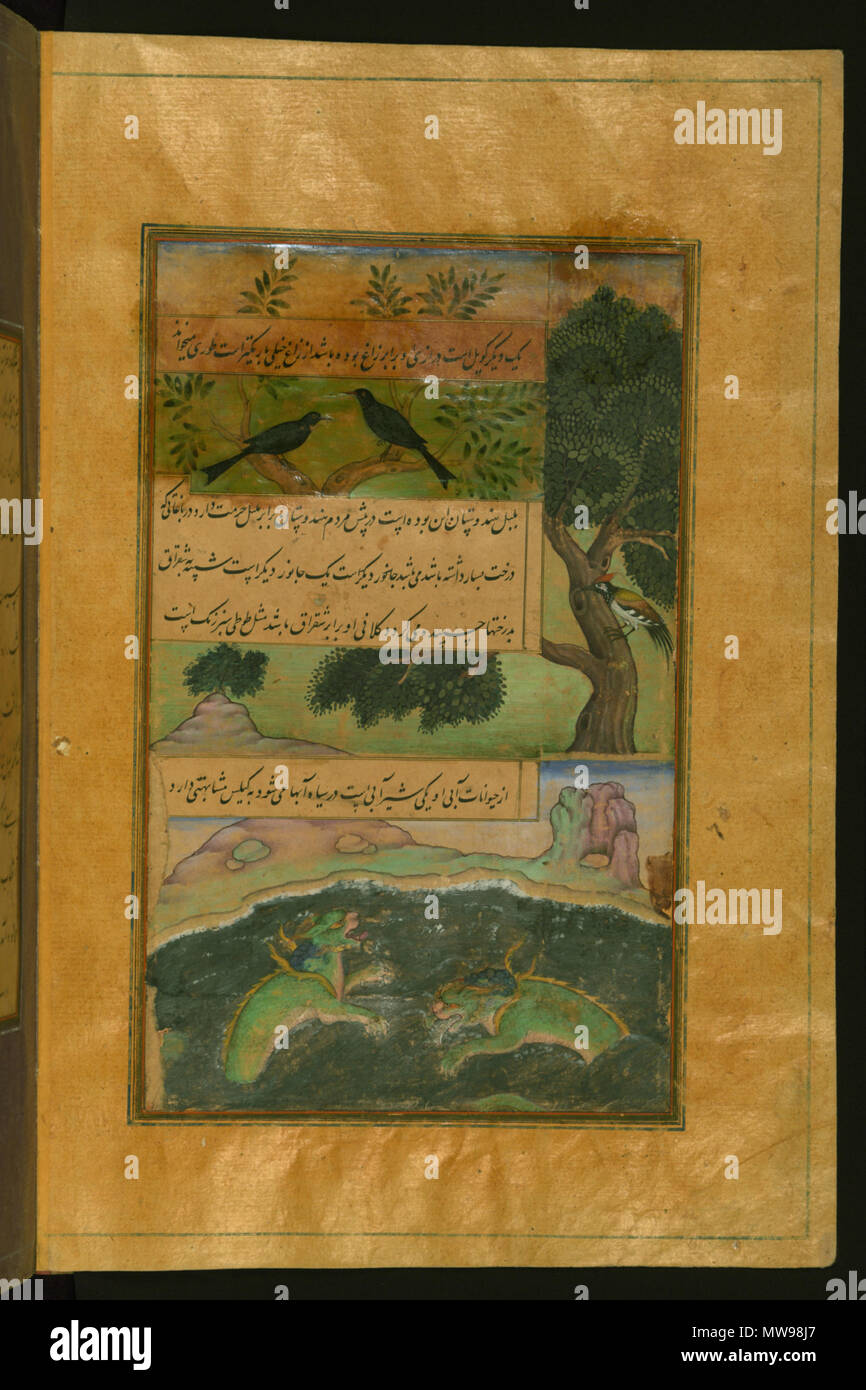 . English: Illustrations from the Manuscript of Baburnama (Memoirs of Babur) - Late 16th Century Bāburnāma is the memoirs of Ẓahīr ud-Dīn Muḥammad Bābur (1483-1530), founder of the Mughal Empire and a great-great-great-grandson of Timur. It is an autobiographical work, originally written in the Chagatai language, known to Babur as 'Turki' (meaning Turkic), the spoken language of the Andijan-Timurids. Because of Babur's cultural origin, his prose is highly Persianized in its sentence structure, morphology, and vocabulary,and also contains many phrases and smaller poems in Persian. During Empero Stock Photohttps://www.alamy.com/image-license-details/?v=1https://www.alamy.com/english-illustrations-from-the-manuscript-of-baburnama-memoirs-of-babur-late-16th-century-bburnma-is-the-memoirs-of-ahr-ud-dn-muammad-bbur-1483-1530-founder-of-the-mughal-empire-and-a-great-great-great-grandson-of-timur-it-is-an-autobiographical-work-originally-written-in-the-chagatai-language-known-to-babur-as-turki-meaning-turkic-the-spoken-language-of-the-andijan-timurids-because-of-baburs-cultural-origin-his-prose-is-highly-persianized-in-its-sentence-structure-morphology-and-vocabularyand-also-contains-many-phrases-and-smaller-poems-in-persian-during-empero-image187674431.html
. English: Illustrations from the Manuscript of Baburnama (Memoirs of Babur) - Late 16th Century Bāburnāma is the memoirs of Ẓahīr ud-Dīn Muḥammad Bābur (1483-1530), founder of the Mughal Empire and a great-great-great-grandson of Timur. It is an autobiographical work, originally written in the Chagatai language, known to Babur as 'Turki' (meaning Turkic), the spoken language of the Andijan-Timurids. Because of Babur's cultural origin, his prose is highly Persianized in its sentence structure, morphology, and vocabulary,and also contains many phrases and smaller poems in Persian. During Empero Stock Photohttps://www.alamy.com/image-license-details/?v=1https://www.alamy.com/english-illustrations-from-the-manuscript-of-baburnama-memoirs-of-babur-late-16th-century-bburnma-is-the-memoirs-of-ahr-ud-dn-muammad-bbur-1483-1530-founder-of-the-mughal-empire-and-a-great-great-great-grandson-of-timur-it-is-an-autobiographical-work-originally-written-in-the-chagatai-language-known-to-babur-as-turki-meaning-turkic-the-spoken-language-of-the-andijan-timurids-because-of-baburs-cultural-origin-his-prose-is-highly-persianized-in-its-sentence-structure-morphology-and-vocabularyand-also-contains-many-phrases-and-smaller-poems-in-persian-during-empero-image187674431.htmlRMMW98J7–. English: Illustrations from the Manuscript of Baburnama (Memoirs of Babur) - Late 16th Century Bāburnāma is the memoirs of Ẓahīr ud-Dīn Muḥammad Bābur (1483-1530), founder of the Mughal Empire and a great-great-great-grandson of Timur. It is an autobiographical work, originally written in the Chagatai language, known to Babur as 'Turki' (meaning Turkic), the spoken language of the Andijan-Timurids. Because of Babur's cultural origin, his prose is highly Persianized in its sentence structure, morphology, and vocabulary,and also contains many phrases and smaller poems in Persian. During Empero
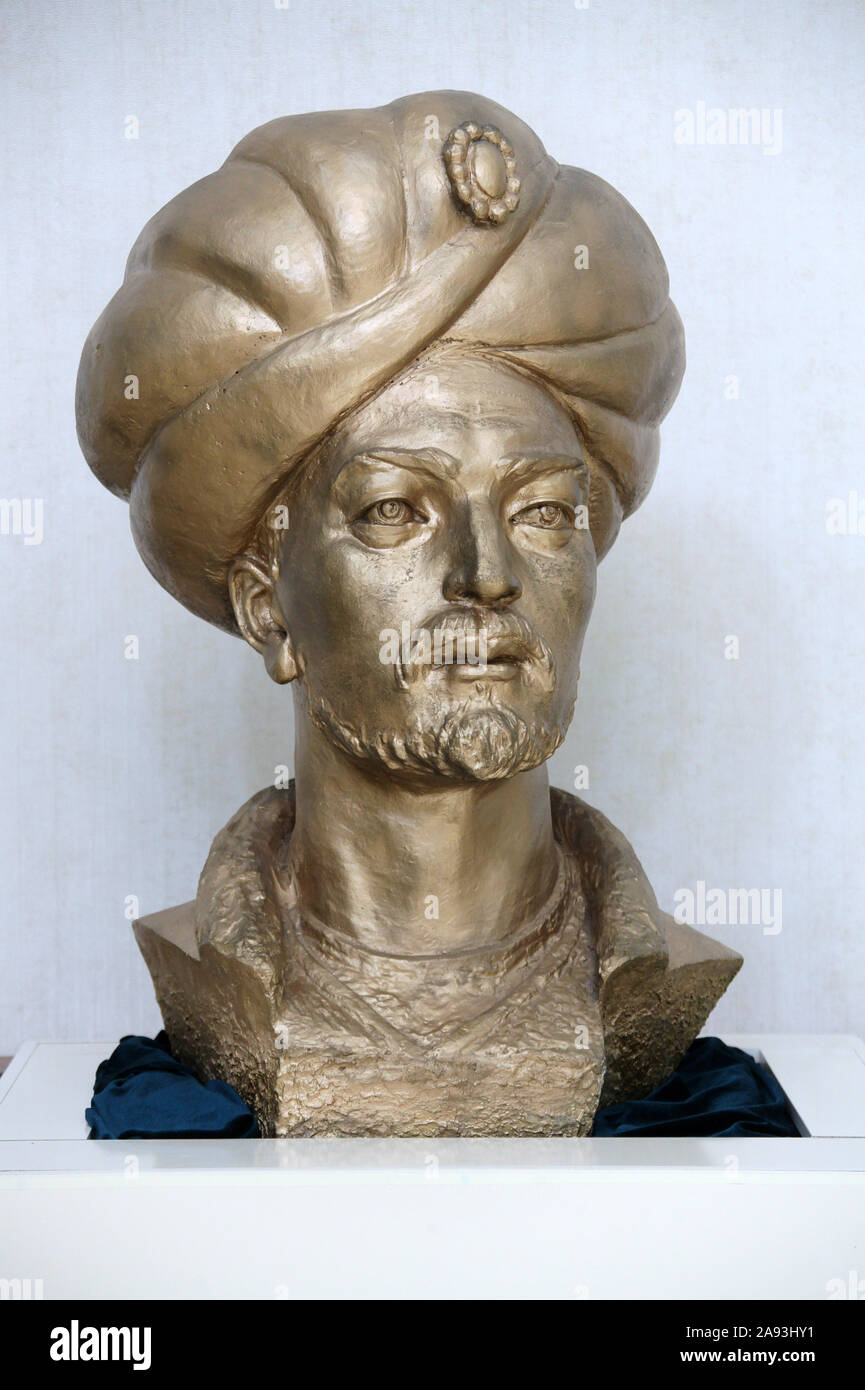 Bust of Zahiriddin Muhammad Bobur at his new museum in Andijan Stock Photohttps://www.alamy.com/image-license-details/?v=1https://www.alamy.com/bust-of-zahiriddin-muhammad-bobur-at-his-new-museum-in-andijan-image332608837.html
Bust of Zahiriddin Muhammad Bobur at his new museum in Andijan Stock Photohttps://www.alamy.com/image-license-details/?v=1https://www.alamy.com/bust-of-zahiriddin-muhammad-bobur-at-his-new-museum-in-andijan-image332608837.htmlRM2A93HY1–Bust of Zahiriddin Muhammad Bobur at his new museum in Andijan
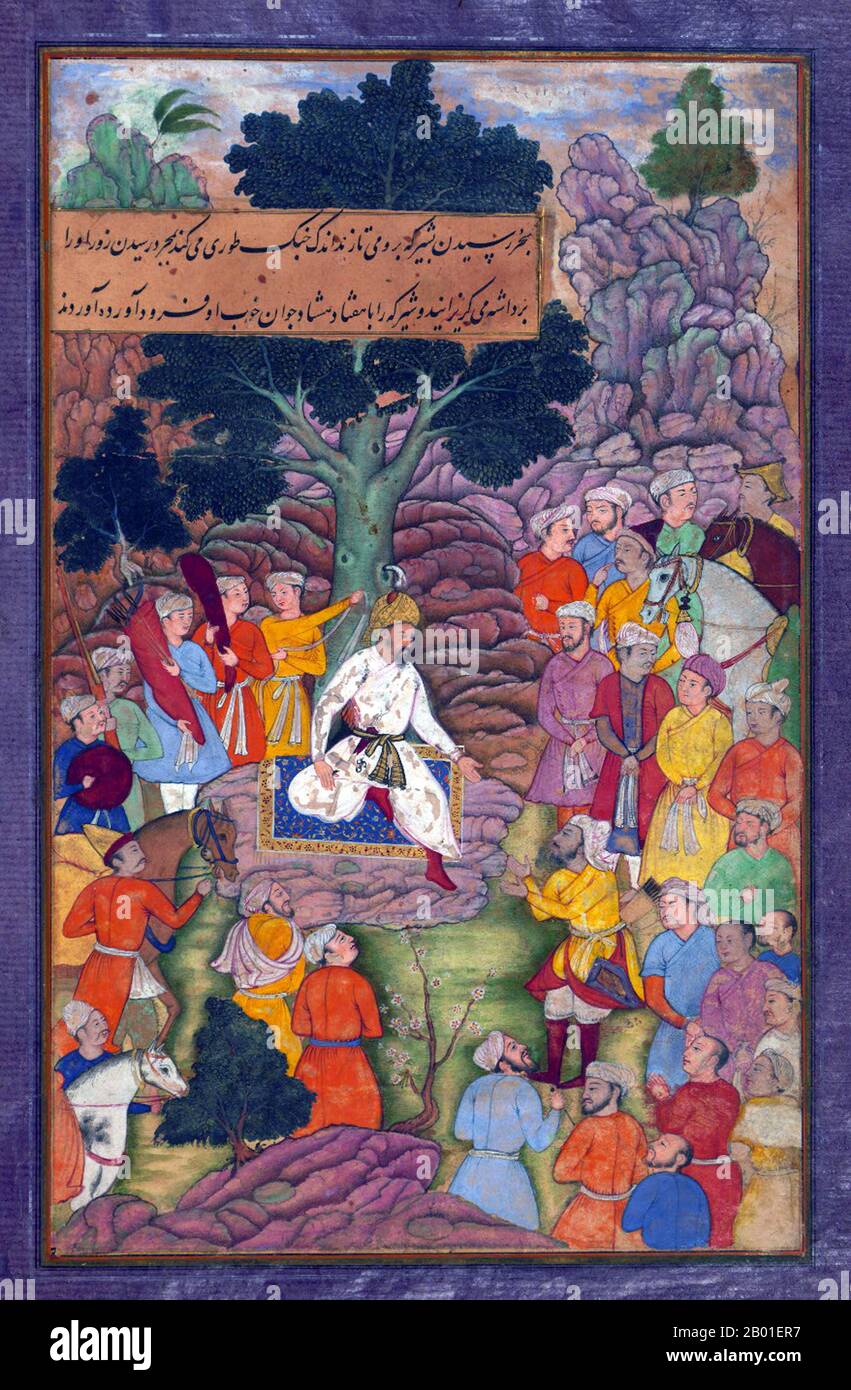 India: Babur and his army in the Sinjid valley march toward Kabul. Miniature painting from the Baburnama, late 16th century. Bāburnāma (literally: 'Book of Babur' or 'Letters of Babur'; alternatively known as Tuzk-e Babri) is the name given to the memoirs of Ẓahīr ud-Dīn Muḥammad Bābur (1483-1530), founder of the Mughal Empire and a great-great-great-grandson of Timur. It is an autobiographical work, originally written in the Chagatai language, known to Babur as 'Turki' (meaning Turkic), the spoken language of the Andijan-Timurids. Stock Photohttps://www.alamy.com/image-license-details/?v=1https://www.alamy.com/india-babur-and-his-army-in-the-sinjid-valley-march-toward-kabul-miniature-painting-from-the-baburnama-late-16th-century-bburnma-literally-book-of-babur-or-letters-of-babur-alternatively-known-as-tuzk-e-babri-is-the-name-given-to-the-memoirs-of-ahr-ud-dn-muammad-bbur-1483-1530-founder-of-the-mughal-empire-and-a-great-great-great-grandson-of-timur-it-is-an-autobiographical-work-originally-written-in-the-chagatai-language-known-to-babur-as-turki-meaning-turkic-the-spoken-language-of-the-andijan-timurids-image344240939.html
India: Babur and his army in the Sinjid valley march toward Kabul. Miniature painting from the Baburnama, late 16th century. Bāburnāma (literally: 'Book of Babur' or 'Letters of Babur'; alternatively known as Tuzk-e Babri) is the name given to the memoirs of Ẓahīr ud-Dīn Muḥammad Bābur (1483-1530), founder of the Mughal Empire and a great-great-great-grandson of Timur. It is an autobiographical work, originally written in the Chagatai language, known to Babur as 'Turki' (meaning Turkic), the spoken language of the Andijan-Timurids. Stock Photohttps://www.alamy.com/image-license-details/?v=1https://www.alamy.com/india-babur-and-his-army-in-the-sinjid-valley-march-toward-kabul-miniature-painting-from-the-baburnama-late-16th-century-bburnma-literally-book-of-babur-or-letters-of-babur-alternatively-known-as-tuzk-e-babri-is-the-name-given-to-the-memoirs-of-ahr-ud-dn-muammad-bbur-1483-1530-founder-of-the-mughal-empire-and-a-great-great-great-grandson-of-timur-it-is-an-autobiographical-work-originally-written-in-the-chagatai-language-known-to-babur-as-turki-meaning-turkic-the-spoken-language-of-the-andijan-timurids-image344240939.htmlRM2B01ER7–India: Babur and his army in the Sinjid valley march toward Kabul. Miniature painting from the Baburnama, late 16th century. Bāburnāma (literally: 'Book of Babur' or 'Letters of Babur'; alternatively known as Tuzk-e Babri) is the name given to the memoirs of Ẓahīr ud-Dīn Muḥammad Bābur (1483-1530), founder of the Mughal Empire and a great-great-great-grandson of Timur. It is an autobiographical work, originally written in the Chagatai language, known to Babur as 'Turki' (meaning Turkic), the spoken language of the Andijan-Timurids.
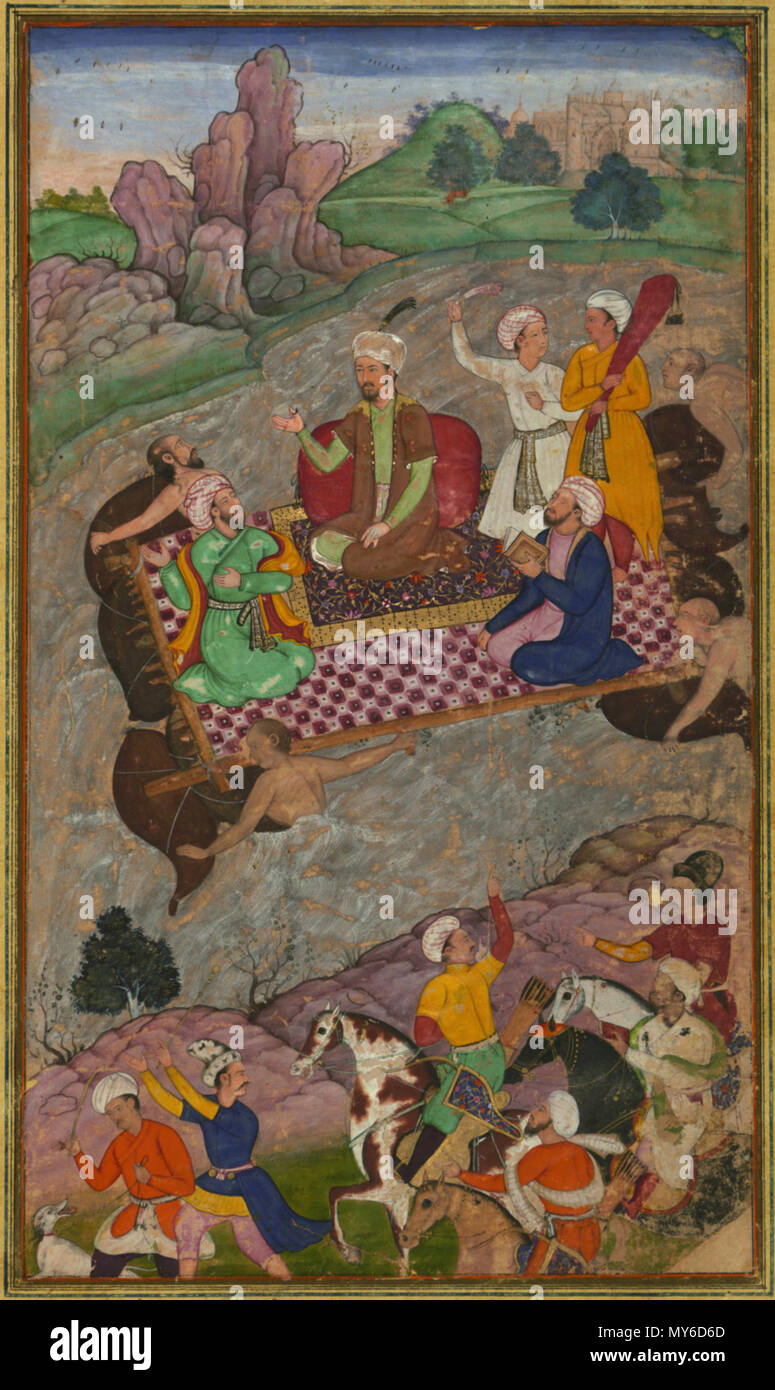 . English: Illustrations from the Manuscript of Baburnama (Memoirs of Babur) - Late 16th Century Bāburnāma is the memoirs of Ẓahīr ud-Dīn Muḥammad Bābur (1483-1530), founder of the Mughal Empire and a great-great-great-grandson of Timur. It is an autobiographical work, originally written in the Chagatai language, known to Babur as 'Turki' (meaning Turkic), the spoken language of the Andijan-Timurids. Because of Babur's cultural origin, his prose is highly Persianized in its sentence structure, morphology, and vocabulary,and also contains many phrases and smaller poems in Persian. During Empero Stock Photohttps://www.alamy.com/image-license-details/?v=1https://www.alamy.com/english-illustrations-from-the-manuscript-of-baburnama-memoirs-of-babur-late-16th-century-bburnma-is-the-memoirs-of-ahr-ud-dn-muammad-bbur-1483-1530-founder-of-the-mughal-empire-and-a-great-great-great-grandson-of-timur-it-is-an-autobiographical-work-originally-written-in-the-chagatai-language-known-to-babur-as-turki-meaning-turkic-the-spoken-language-of-the-andijan-timurids-because-of-baburs-cultural-origin-his-prose-is-highly-persianized-in-its-sentence-structure-morphology-and-vocabularyand-also-contains-many-phrases-and-smaller-poems-in-persian-during-empero-image188841477.html
. English: Illustrations from the Manuscript of Baburnama (Memoirs of Babur) - Late 16th Century Bāburnāma is the memoirs of Ẓahīr ud-Dīn Muḥammad Bābur (1483-1530), founder of the Mughal Empire and a great-great-great-grandson of Timur. It is an autobiographical work, originally written in the Chagatai language, known to Babur as 'Turki' (meaning Turkic), the spoken language of the Andijan-Timurids. Because of Babur's cultural origin, his prose is highly Persianized in its sentence structure, morphology, and vocabulary,and also contains many phrases and smaller poems in Persian. During Empero Stock Photohttps://www.alamy.com/image-license-details/?v=1https://www.alamy.com/english-illustrations-from-the-manuscript-of-baburnama-memoirs-of-babur-late-16th-century-bburnma-is-the-memoirs-of-ahr-ud-dn-muammad-bbur-1483-1530-founder-of-the-mughal-empire-and-a-great-great-great-grandson-of-timur-it-is-an-autobiographical-work-originally-written-in-the-chagatai-language-known-to-babur-as-turki-meaning-turkic-the-spoken-language-of-the-andijan-timurids-because-of-baburs-cultural-origin-his-prose-is-highly-persianized-in-its-sentence-structure-morphology-and-vocabularyand-also-contains-many-phrases-and-smaller-poems-in-persian-during-empero-image188841477.htmlRMMY6D6D–. English: Illustrations from the Manuscript of Baburnama (Memoirs of Babur) - Late 16th Century Bāburnāma is the memoirs of Ẓahīr ud-Dīn Muḥammad Bābur (1483-1530), founder of the Mughal Empire and a great-great-great-grandson of Timur. It is an autobiographical work, originally written in the Chagatai language, known to Babur as 'Turki' (meaning Turkic), the spoken language of the Andijan-Timurids. Because of Babur's cultural origin, his prose is highly Persianized in its sentence structure, morphology, and vocabulary,and also contains many phrases and smaller poems in Persian. During Empero
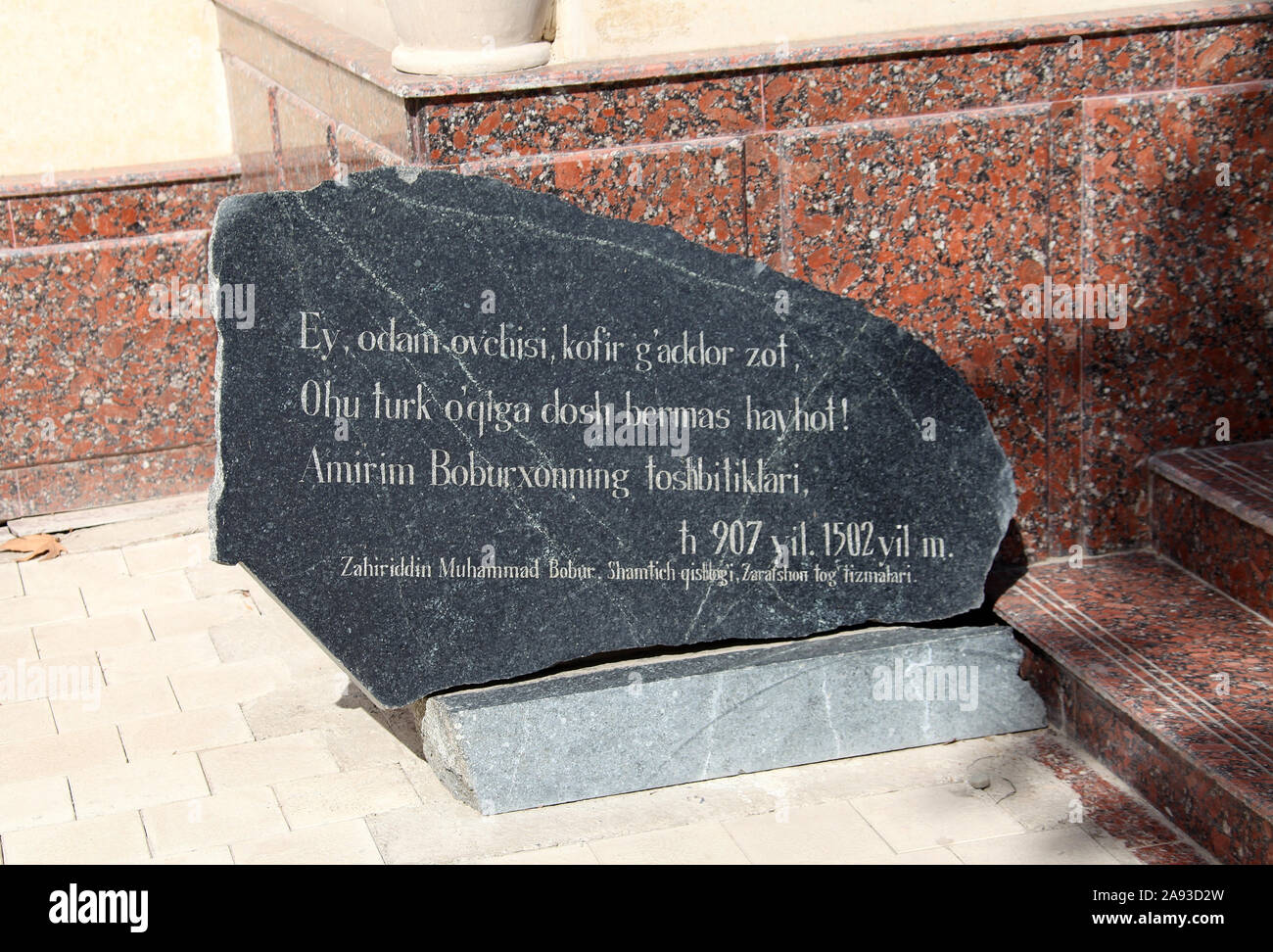 Exhibit at the House Museum of Bobur in Andijan Stock Photohttps://www.alamy.com/image-license-details/?v=1https://www.alamy.com/exhibit-at-the-house-museum-of-bobur-in-andijan-image332605025.html
Exhibit at the House Museum of Bobur in Andijan Stock Photohttps://www.alamy.com/image-license-details/?v=1https://www.alamy.com/exhibit-at-the-house-museum-of-bobur-in-andijan-image332605025.htmlRM2A93D2W–Exhibit at the House Museum of Bobur in Andijan
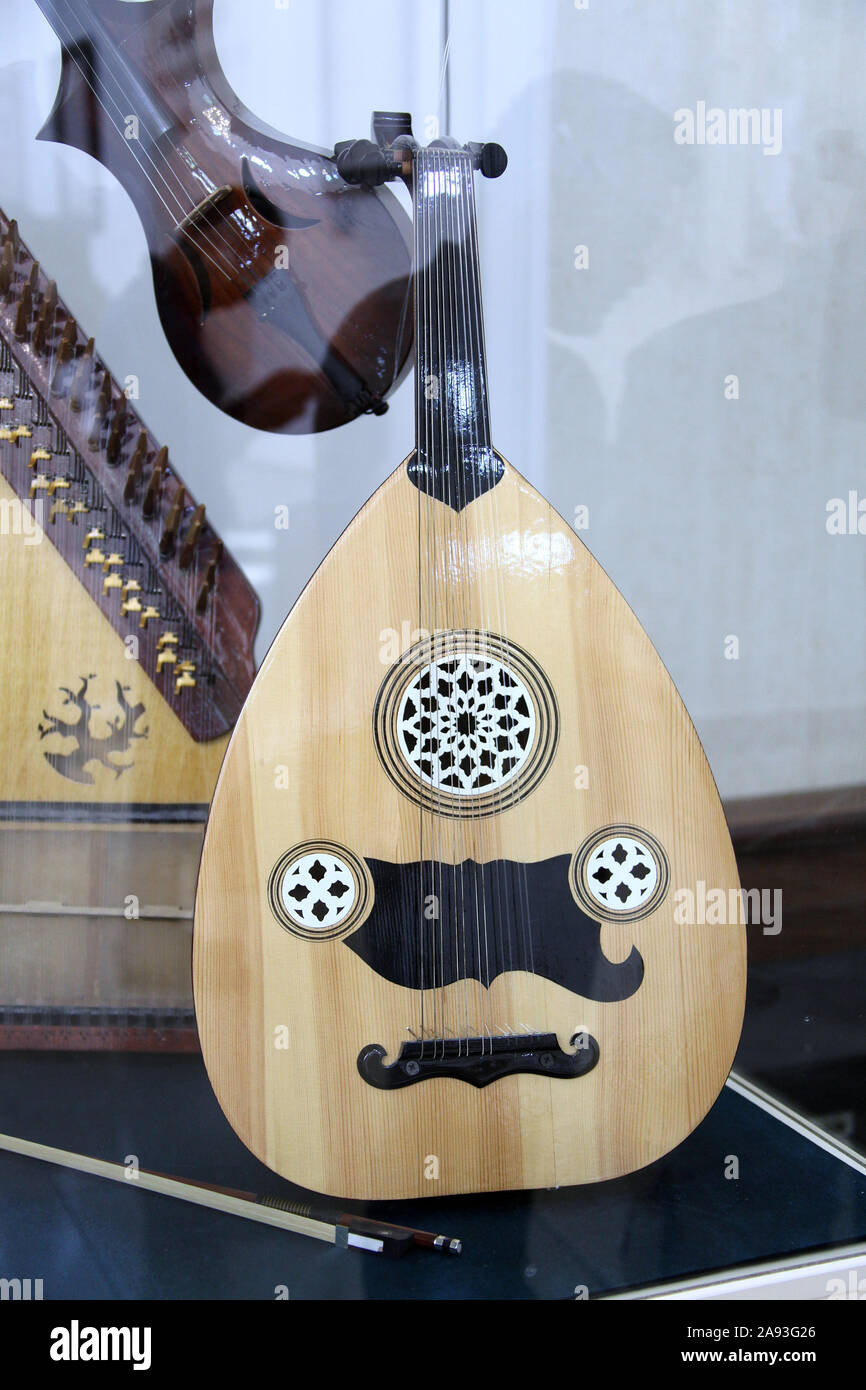 Traditional musical instruments exhibited at the Museum of Bobur in Uzbekistan Stock Photohttps://www.alamy.com/image-license-details/?v=1https://www.alamy.com/traditional-musical-instruments-exhibited-at-the-museum-of-bobur-in-uzbekistan-image332607358.html
Traditional musical instruments exhibited at the Museum of Bobur in Uzbekistan Stock Photohttps://www.alamy.com/image-license-details/?v=1https://www.alamy.com/traditional-musical-instruments-exhibited-at-the-museum-of-bobur-in-uzbekistan-image332607358.htmlRM2A93G26–Traditional musical instruments exhibited at the Museum of Bobur in Uzbekistan
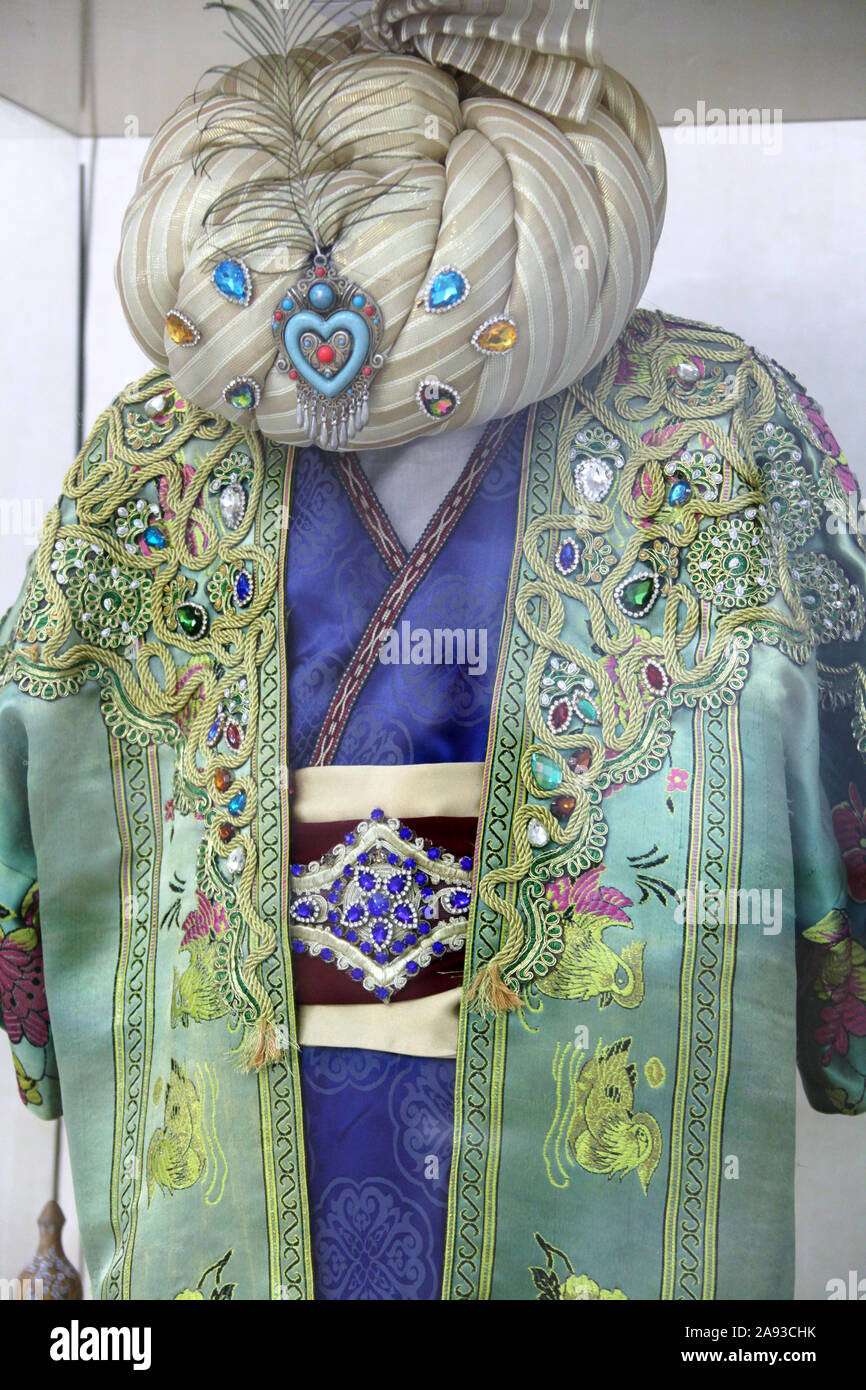 Example of the clothes worn by Bobur exhited in the museum at Andijan Stock Photohttps://www.alamy.com/image-license-details/?v=1https://www.alamy.com/example-of-the-clothes-worn-by-bobur-exhited-in-the-museum-at-andijan-image332604655.html
Example of the clothes worn by Bobur exhited in the museum at Andijan Stock Photohttps://www.alamy.com/image-license-details/?v=1https://www.alamy.com/example-of-the-clothes-worn-by-bobur-exhited-in-the-museum-at-andijan-image332604655.htmlRM2A93CHK–Example of the clothes worn by Bobur exhited in the museum at Andijan
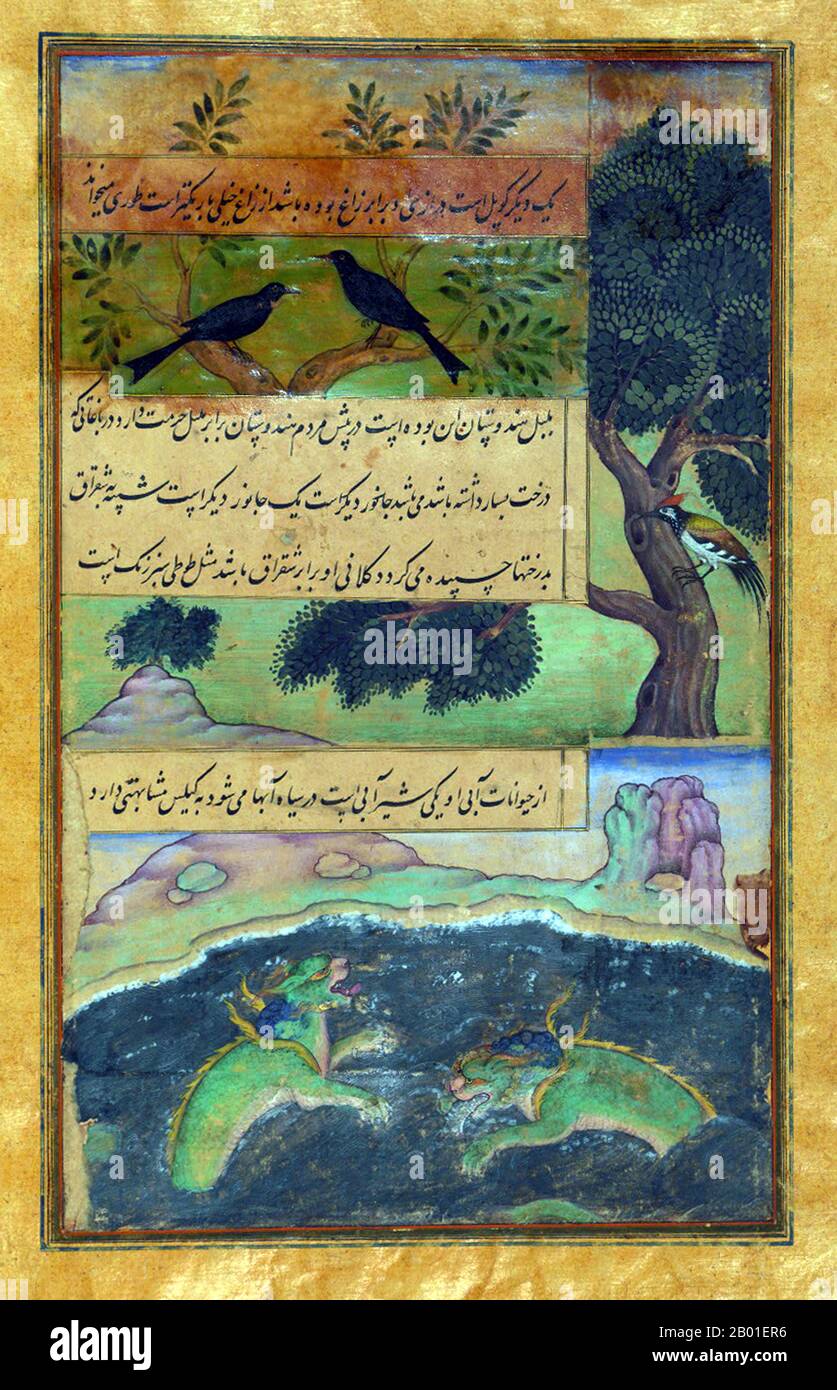 India: Animals of Hindustan - wild birds and dragon-like water creatures. Miniature painting from the Baburnama, late 16th century. Bāburnāma (literally: 'Book of Babur' or 'Letters of Babur'; alternatively known as Tuzk-e Babri) is the name given to the memoirs of Ẓahīr ud-Dīn Muḥammad Bābur (1483-1530), founder of the Mughal Empire and a great-great-great-grandson of Timur. It is an autobiographical work, originally written in the Chagatai language, known to Babur as 'Turki' (meaning Turkic), the spoken language of the Andijan-Timurids. Stock Photohttps://www.alamy.com/image-license-details/?v=1https://www.alamy.com/india-animals-of-hindustan-wild-birds-and-dragon-like-water-creatures-miniature-painting-from-the-baburnama-late-16th-century-bburnma-literally-book-of-babur-or-letters-of-babur-alternatively-known-as-tuzk-e-babri-is-the-name-given-to-the-memoirs-of-ahr-ud-dn-muammad-bbur-1483-1530-founder-of-the-mughal-empire-and-a-great-great-great-grandson-of-timur-it-is-an-autobiographical-work-originally-written-in-the-chagatai-language-known-to-babur-as-turki-meaning-turkic-the-spoken-language-of-the-andijan-timurids-image344240938.html
India: Animals of Hindustan - wild birds and dragon-like water creatures. Miniature painting from the Baburnama, late 16th century. Bāburnāma (literally: 'Book of Babur' or 'Letters of Babur'; alternatively known as Tuzk-e Babri) is the name given to the memoirs of Ẓahīr ud-Dīn Muḥammad Bābur (1483-1530), founder of the Mughal Empire and a great-great-great-grandson of Timur. It is an autobiographical work, originally written in the Chagatai language, known to Babur as 'Turki' (meaning Turkic), the spoken language of the Andijan-Timurids. Stock Photohttps://www.alamy.com/image-license-details/?v=1https://www.alamy.com/india-animals-of-hindustan-wild-birds-and-dragon-like-water-creatures-miniature-painting-from-the-baburnama-late-16th-century-bburnma-literally-book-of-babur-or-letters-of-babur-alternatively-known-as-tuzk-e-babri-is-the-name-given-to-the-memoirs-of-ahr-ud-dn-muammad-bbur-1483-1530-founder-of-the-mughal-empire-and-a-great-great-great-grandson-of-timur-it-is-an-autobiographical-work-originally-written-in-the-chagatai-language-known-to-babur-as-turki-meaning-turkic-the-spoken-language-of-the-andijan-timurids-image344240938.htmlRM2B01ER6–India: Animals of Hindustan - wild birds and dragon-like water creatures. Miniature painting from the Baburnama, late 16th century. Bāburnāma (literally: 'Book of Babur' or 'Letters of Babur'; alternatively known as Tuzk-e Babri) is the name given to the memoirs of Ẓahīr ud-Dīn Muḥammad Bābur (1483-1530), founder of the Mughal Empire and a great-great-great-grandson of Timur. It is an autobiographical work, originally written in the Chagatai language, known to Babur as 'Turki' (meaning Turkic), the spoken language of the Andijan-Timurids.
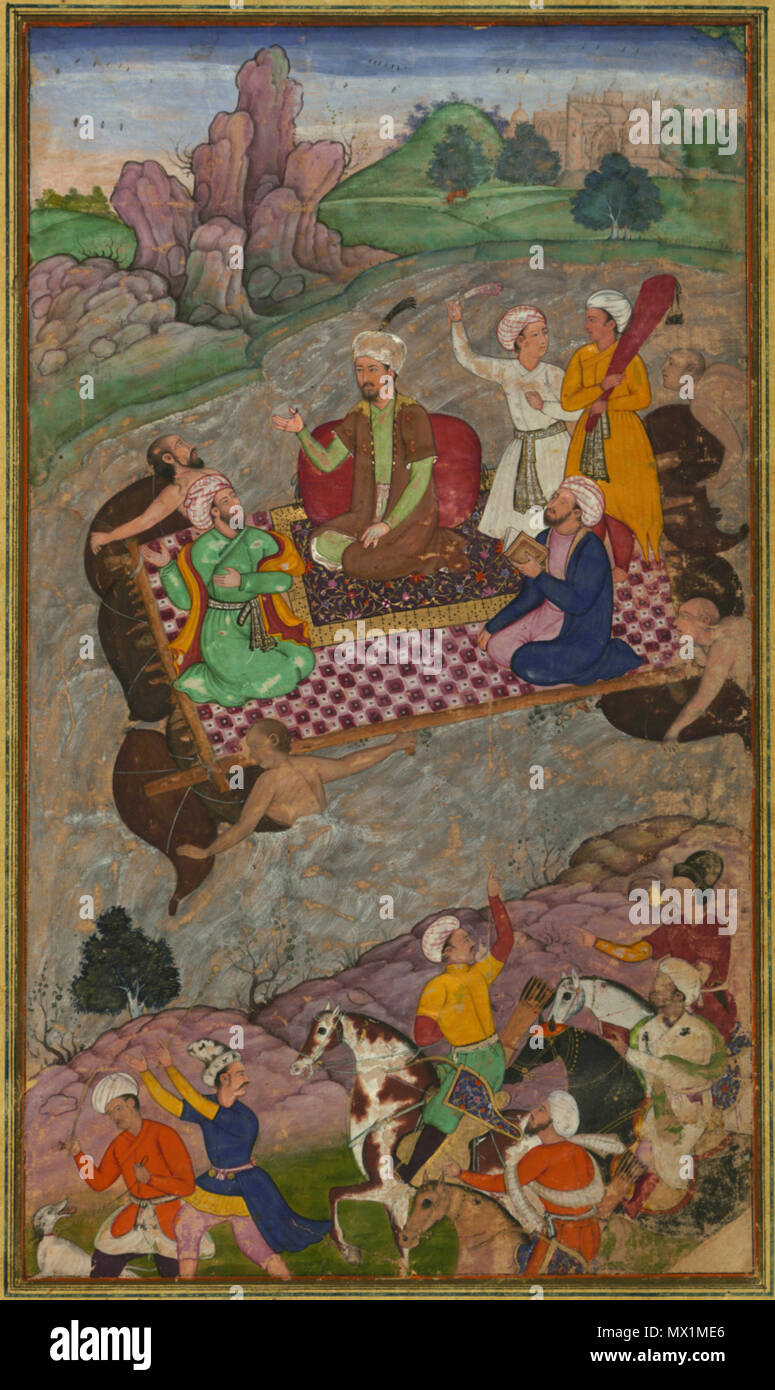 . English: Illustrations from the Manuscript of Baburnama (Memoirs of Babur) - Late 16th Century Bāburnāma is the memoirs of Ẓahīr ud-Dīn Muḥammad Bābur (1483-1530), founder of the Mughal Empire and a great-great-great-grandson of Timur. It is an autobiographical work, originally written in the Chagatai language, known to Babur as 'Turki' (meaning Turkic), the spoken language of the Andijan-Timurids. Because of Babur's cultural origin, his prose is highly Persianized in its sentence structure, morphology, and vocabulary,and also contains many phrases and smaller poems in Persian. During Empero Stock Photohttps://www.alamy.com/image-license-details/?v=1https://www.alamy.com/english-illustrations-from-the-manuscript-of-baburnama-memoirs-of-babur-late-16th-century-bburnma-is-the-memoirs-of-ahr-ud-dn-muammad-bbur-1483-1530-founder-of-the-mughal-empire-and-a-great-great-great-grandson-of-timur-it-is-an-autobiographical-work-originally-written-in-the-chagatai-language-known-to-babur-as-turki-meaning-turkic-the-spoken-language-of-the-andijan-timurids-because-of-baburs-cultural-origin-his-prose-is-highly-persianized-in-its-sentence-structure-morphology-and-vocabularyand-also-contains-many-phrases-and-smaller-poems-in-persian-during-empero-image188122766.html
. English: Illustrations from the Manuscript of Baburnama (Memoirs of Babur) - Late 16th Century Bāburnāma is the memoirs of Ẓahīr ud-Dīn Muḥammad Bābur (1483-1530), founder of the Mughal Empire and a great-great-great-grandson of Timur. It is an autobiographical work, originally written in the Chagatai language, known to Babur as 'Turki' (meaning Turkic), the spoken language of the Andijan-Timurids. Because of Babur's cultural origin, his prose is highly Persianized in its sentence structure, morphology, and vocabulary,and also contains many phrases and smaller poems in Persian. During Empero Stock Photohttps://www.alamy.com/image-license-details/?v=1https://www.alamy.com/english-illustrations-from-the-manuscript-of-baburnama-memoirs-of-babur-late-16th-century-bburnma-is-the-memoirs-of-ahr-ud-dn-muammad-bbur-1483-1530-founder-of-the-mughal-empire-and-a-great-great-great-grandson-of-timur-it-is-an-autobiographical-work-originally-written-in-the-chagatai-language-known-to-babur-as-turki-meaning-turkic-the-spoken-language-of-the-andijan-timurids-because-of-baburs-cultural-origin-his-prose-is-highly-persianized-in-its-sentence-structure-morphology-and-vocabularyand-also-contains-many-phrases-and-smaller-poems-in-persian-during-empero-image188122766.htmlRMMX1ME6–. English: Illustrations from the Manuscript of Baburnama (Memoirs of Babur) - Late 16th Century Bāburnāma is the memoirs of Ẓahīr ud-Dīn Muḥammad Bābur (1483-1530), founder of the Mughal Empire and a great-great-great-grandson of Timur. It is an autobiographical work, originally written in the Chagatai language, known to Babur as 'Turki' (meaning Turkic), the spoken language of the Andijan-Timurids. Because of Babur's cultural origin, his prose is highly Persianized in its sentence structure, morphology, and vocabulary,and also contains many phrases and smaller poems in Persian. During Empero
 India: Animals of Hindustan - small deer and cows called gīnī. Miniature painting from the Baburnama, late 16th century. Bāburnāma (literally: 'Book of Babur' or 'Letters of Babur'; alternatively known as Tuzk-e Babri) is the name given to the memoirs of Ẓahīr ud-Dīn Muḥammad Bābur (1483-1530), founder of the Mughal Empire and a great-great-great-grandson of Timur. It is an autobiographical work, originally written in the Chagatai language, known to Babur as 'Turki' (meaning Turkic), the spoken language of the Andijan-Timurids. Stock Photohttps://www.alamy.com/image-license-details/?v=1https://www.alamy.com/india-animals-of-hindustan-small-deer-and-cows-called-gn-miniature-painting-from-the-baburnama-late-16th-century-bburnma-literally-book-of-babur-or-letters-of-babur-alternatively-known-as-tuzk-e-babri-is-the-name-given-to-the-memoirs-of-ahr-ud-dn-muammad-bbur-1483-1530-founder-of-the-mughal-empire-and-a-great-great-great-grandson-of-timur-it-is-an-autobiographical-work-originally-written-in-the-chagatai-language-known-to-babur-as-turki-meaning-turkic-the-spoken-language-of-the-andijan-timurids-image344240931.html
India: Animals of Hindustan - small deer and cows called gīnī. Miniature painting from the Baburnama, late 16th century. Bāburnāma (literally: 'Book of Babur' or 'Letters of Babur'; alternatively known as Tuzk-e Babri) is the name given to the memoirs of Ẓahīr ud-Dīn Muḥammad Bābur (1483-1530), founder of the Mughal Empire and a great-great-great-grandson of Timur. It is an autobiographical work, originally written in the Chagatai language, known to Babur as 'Turki' (meaning Turkic), the spoken language of the Andijan-Timurids. Stock Photohttps://www.alamy.com/image-license-details/?v=1https://www.alamy.com/india-animals-of-hindustan-small-deer-and-cows-called-gn-miniature-painting-from-the-baburnama-late-16th-century-bburnma-literally-book-of-babur-or-letters-of-babur-alternatively-known-as-tuzk-e-babri-is-the-name-given-to-the-memoirs-of-ahr-ud-dn-muammad-bbur-1483-1530-founder-of-the-mughal-empire-and-a-great-great-great-grandson-of-timur-it-is-an-autobiographical-work-originally-written-in-the-chagatai-language-known-to-babur-as-turki-meaning-turkic-the-spoken-language-of-the-andijan-timurids-image344240931.htmlRM2B01EPY–India: Animals of Hindustan - small deer and cows called gīnī. Miniature painting from the Baburnama, late 16th century. Bāburnāma (literally: 'Book of Babur' or 'Letters of Babur'; alternatively known as Tuzk-e Babri) is the name given to the memoirs of Ẓahīr ud-Dīn Muḥammad Bābur (1483-1530), founder of the Mughal Empire and a great-great-great-grandson of Timur. It is an autobiographical work, originally written in the Chagatai language, known to Babur as 'Turki' (meaning Turkic), the spoken language of the Andijan-Timurids.
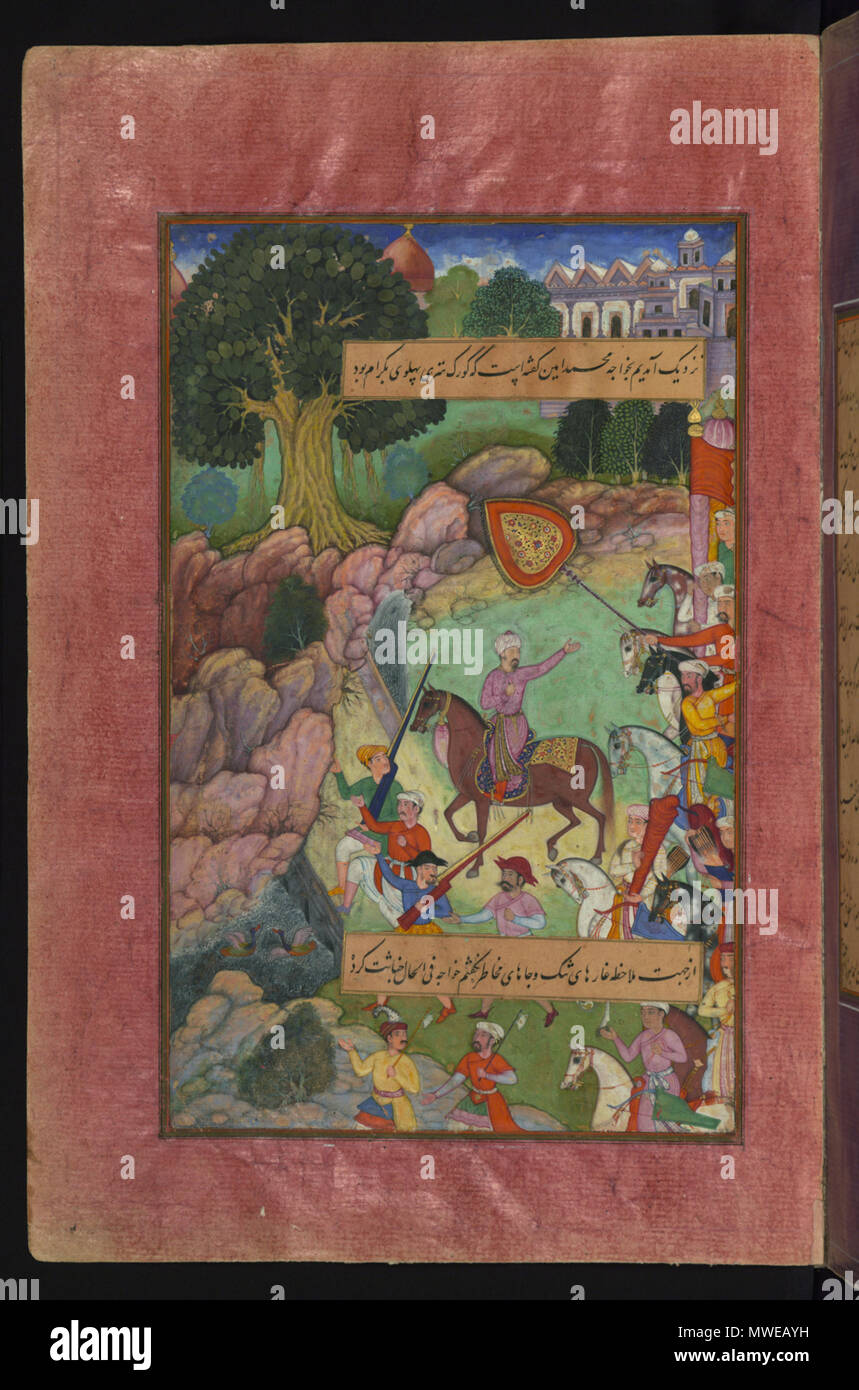 . English: Illustrations from the Manuscript of Baburnama (Memoirs of Babur) - Late 16th Century Bāburnāma is the memoirs of Ẓahīr ud-Dīn Muḥammad Bābur (1483-1530), founder of the Mughal Empire and a great-great-great-grandson of Timur. It is an autobiographical work, originally written in the Chagatai language, known to Babur as 'Turki' (meaning Turkic), the spoken language of the Andijan-Timurids. Because of Babur's cultural origin, his prose is highly Persianized in its sentence structure, morphology, and vocabulary,and also contains many phrases and smaller poems in Persian. During Empero Stock Photohttps://www.alamy.com/image-license-details/?v=1https://www.alamy.com/english-illustrations-from-the-manuscript-of-baburnama-memoirs-of-babur-late-16th-century-bburnma-is-the-memoirs-of-ahr-ud-dn-muammad-bbur-1483-1530-founder-of-the-mughal-empire-and-a-great-great-great-grandson-of-timur-it-is-an-autobiographical-work-originally-written-in-the-chagatai-language-known-to-babur-as-turki-meaning-turkic-the-spoken-language-of-the-andijan-timurids-because-of-baburs-cultural-origin-his-prose-is-highly-persianized-in-its-sentence-structure-morphology-and-vocabularyand-also-contains-many-phrases-and-smaller-poems-in-persian-during-empero-image187786021.html
. English: Illustrations from the Manuscript of Baburnama (Memoirs of Babur) - Late 16th Century Bāburnāma is the memoirs of Ẓahīr ud-Dīn Muḥammad Bābur (1483-1530), founder of the Mughal Empire and a great-great-great-grandson of Timur. It is an autobiographical work, originally written in the Chagatai language, known to Babur as 'Turki' (meaning Turkic), the spoken language of the Andijan-Timurids. Because of Babur's cultural origin, his prose is highly Persianized in its sentence structure, morphology, and vocabulary,and also contains many phrases and smaller poems in Persian. During Empero Stock Photohttps://www.alamy.com/image-license-details/?v=1https://www.alamy.com/english-illustrations-from-the-manuscript-of-baburnama-memoirs-of-babur-late-16th-century-bburnma-is-the-memoirs-of-ahr-ud-dn-muammad-bbur-1483-1530-founder-of-the-mughal-empire-and-a-great-great-great-grandson-of-timur-it-is-an-autobiographical-work-originally-written-in-the-chagatai-language-known-to-babur-as-turki-meaning-turkic-the-spoken-language-of-the-andijan-timurids-because-of-baburs-cultural-origin-his-prose-is-highly-persianized-in-its-sentence-structure-morphology-and-vocabularyand-also-contains-many-phrases-and-smaller-poems-in-persian-during-empero-image187786021.htmlRMMWEAYH–. English: Illustrations from the Manuscript of Baburnama (Memoirs of Babur) - Late 16th Century Bāburnāma is the memoirs of Ẓahīr ud-Dīn Muḥammad Bābur (1483-1530), founder of the Mughal Empire and a great-great-great-grandson of Timur. It is an autobiographical work, originally written in the Chagatai language, known to Babur as 'Turki' (meaning Turkic), the spoken language of the Andijan-Timurids. Because of Babur's cultural origin, his prose is highly Persianized in its sentence structure, morphology, and vocabulary,and also contains many phrases and smaller poems in Persian. During Empero
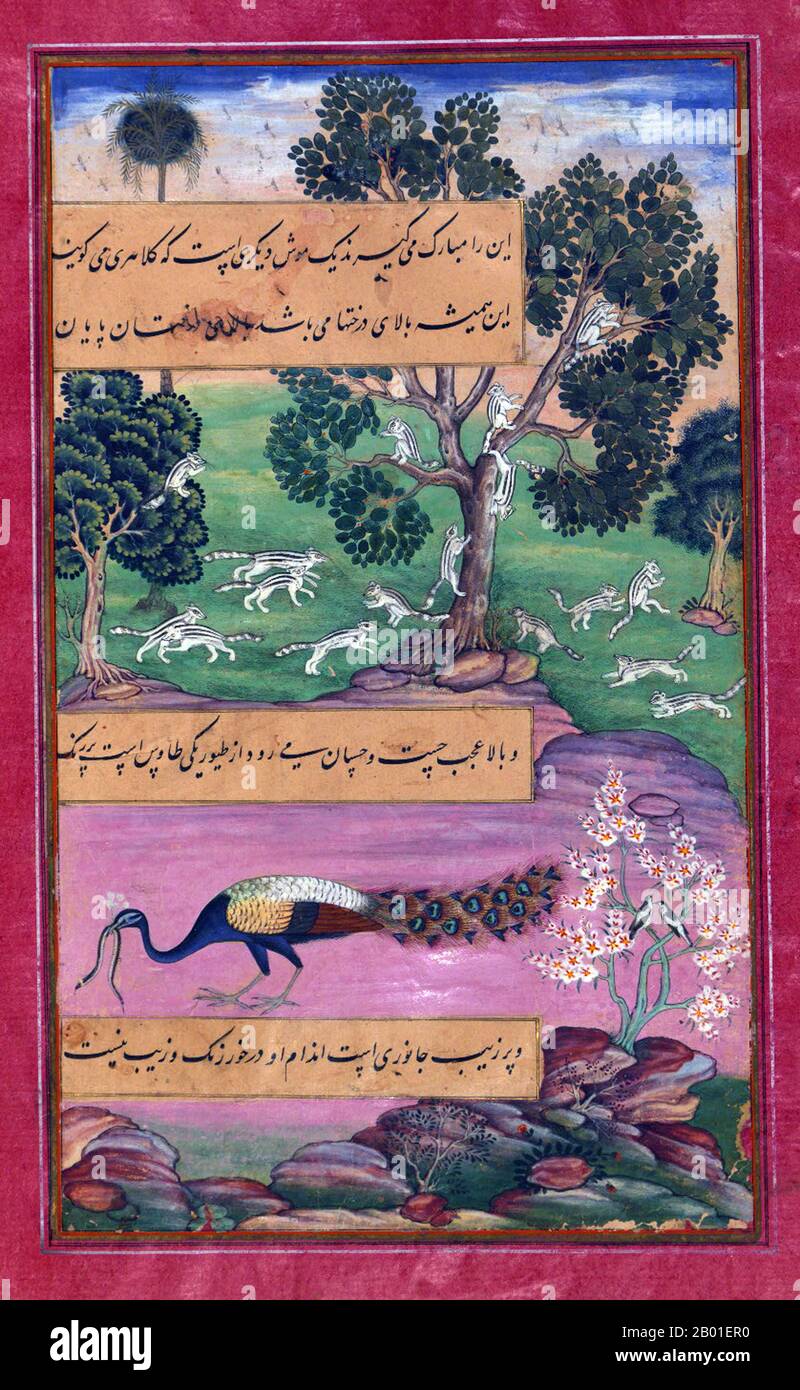 India: Animals of Hindustan - monkeys, rodents and a peacock. Miniature painting from the Baburnama, late 16th century. Bāburnāma (literally: 'Book of Babur' or 'Letters of Babur'; alternatively known as Tuzk-e Babri) is the name given to the memoirs of Ẓahīr ud-Dīn Muḥammad Bābur (1483-1530), founder of the Mughal Empire and a great-great-great-grandson of Timur. It is an autobiographical work, originally written in the Chagatai language, known to Babur as 'Turki' (meaning Turkic), the spoken language of the Andijan-Timurids. Stock Photohttps://www.alamy.com/image-license-details/?v=1https://www.alamy.com/india-animals-of-hindustan-monkeys-rodents-and-a-peacock-miniature-painting-from-the-baburnama-late-16th-century-bburnma-literally-book-of-babur-or-letters-of-babur-alternatively-known-as-tuzk-e-babri-is-the-name-given-to-the-memoirs-of-ahr-ud-dn-muammad-bbur-1483-1530-founder-of-the-mughal-empire-and-a-great-great-great-grandson-of-timur-it-is-an-autobiographical-work-originally-written-in-the-chagatai-language-known-to-babur-as-turki-meaning-turkic-the-spoken-language-of-the-andijan-timurids-image344240932.html
India: Animals of Hindustan - monkeys, rodents and a peacock. Miniature painting from the Baburnama, late 16th century. Bāburnāma (literally: 'Book of Babur' or 'Letters of Babur'; alternatively known as Tuzk-e Babri) is the name given to the memoirs of Ẓahīr ud-Dīn Muḥammad Bābur (1483-1530), founder of the Mughal Empire and a great-great-great-grandson of Timur. It is an autobiographical work, originally written in the Chagatai language, known to Babur as 'Turki' (meaning Turkic), the spoken language of the Andijan-Timurids. Stock Photohttps://www.alamy.com/image-license-details/?v=1https://www.alamy.com/india-animals-of-hindustan-monkeys-rodents-and-a-peacock-miniature-painting-from-the-baburnama-late-16th-century-bburnma-literally-book-of-babur-or-letters-of-babur-alternatively-known-as-tuzk-e-babri-is-the-name-given-to-the-memoirs-of-ahr-ud-dn-muammad-bbur-1483-1530-founder-of-the-mughal-empire-and-a-great-great-great-grandson-of-timur-it-is-an-autobiographical-work-originally-written-in-the-chagatai-language-known-to-babur-as-turki-meaning-turkic-the-spoken-language-of-the-andijan-timurids-image344240932.htmlRM2B01ER0–India: Animals of Hindustan - monkeys, rodents and a peacock. Miniature painting from the Baburnama, late 16th century. Bāburnāma (literally: 'Book of Babur' or 'Letters of Babur'; alternatively known as Tuzk-e Babri) is the name given to the memoirs of Ẓahīr ud-Dīn Muḥammad Bābur (1483-1530), founder of the Mughal Empire and a great-great-great-grandson of Timur. It is an autobiographical work, originally written in the Chagatai language, known to Babur as 'Turki' (meaning Turkic), the spoken language of the Andijan-Timurids.
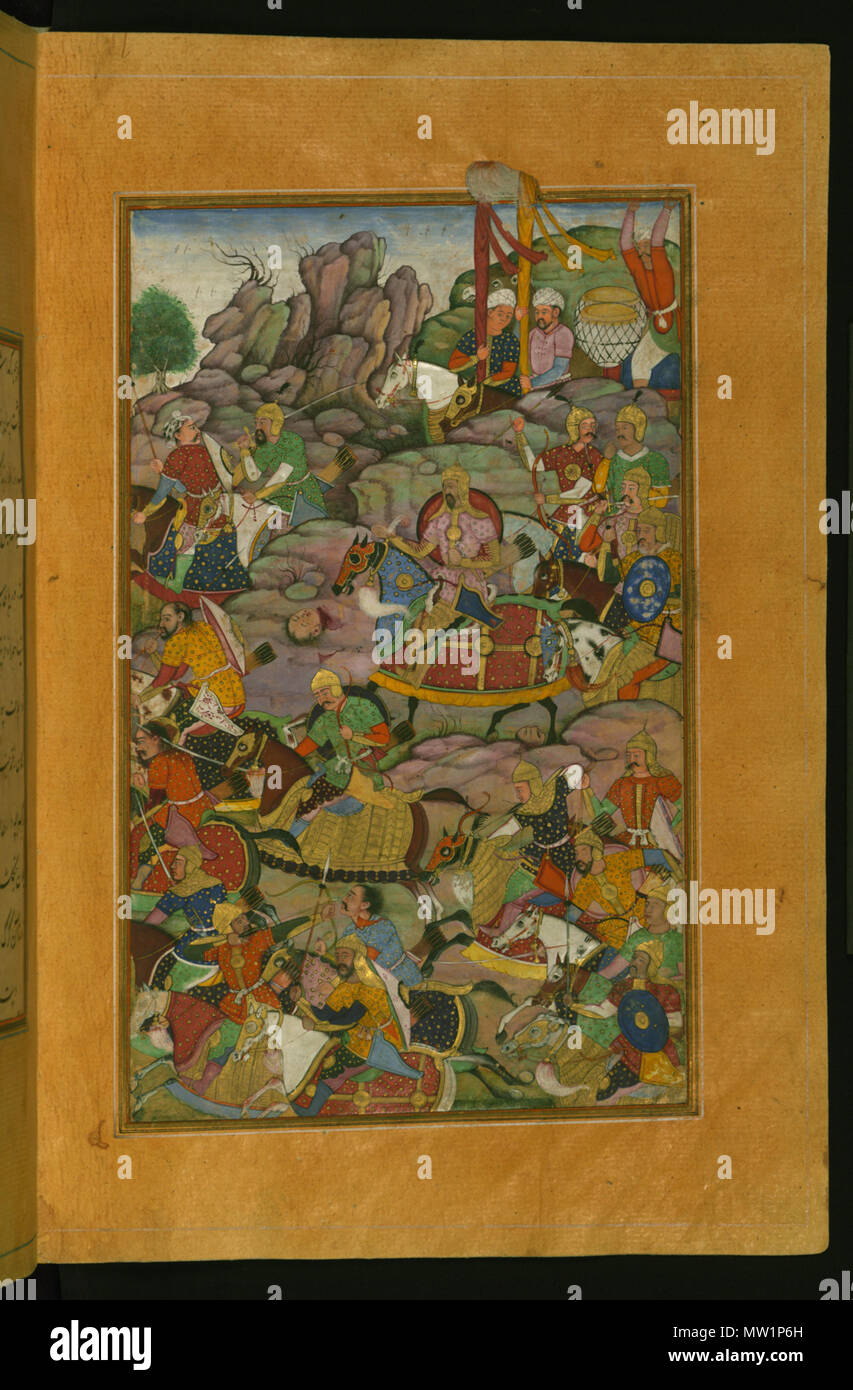 . English: Illustrations from the Manuscript of Baburnama (Memoirs of Babur) - Late 16th Century Bāburnāma is the memoirs of Ẓahīr ud-Dīn Muḥammad Bābur (1483-1530), founder of the Mughal Empire and a great-great-great-grandson of Timur. It is an autobiographical work, originally written in the Chagatai language, known to Babur as 'Turki' (meaning Turkic), the spoken language of the Andijan-Timurids. Because of Babur's cultural origin, his prose is highly Persianized in its sentence structure, morphology, and vocabulary,and also contains many phrases and smaller poems in Persian. During Empero Stock Photohttps://www.alamy.com/image-license-details/?v=1https://www.alamy.com/english-illustrations-from-the-manuscript-of-baburnama-memoirs-of-babur-late-16th-century-bburnma-is-the-memoirs-of-ahr-ud-dn-muammad-bbur-1483-1530-founder-of-the-mughal-empire-and-a-great-great-great-grandson-of-timur-it-is-an-autobiographical-work-originally-written-in-the-chagatai-language-known-to-babur-as-turki-meaning-turkic-the-spoken-language-of-the-andijan-timurids-because-of-baburs-cultural-origin-his-prose-is-highly-persianized-in-its-sentence-structure-morphology-and-vocabularyand-also-contains-many-phrases-and-smaller-poems-in-persian-during-empero-image187509465.html
. English: Illustrations from the Manuscript of Baburnama (Memoirs of Babur) - Late 16th Century Bāburnāma is the memoirs of Ẓahīr ud-Dīn Muḥammad Bābur (1483-1530), founder of the Mughal Empire and a great-great-great-grandson of Timur. It is an autobiographical work, originally written in the Chagatai language, known to Babur as 'Turki' (meaning Turkic), the spoken language of the Andijan-Timurids. Because of Babur's cultural origin, his prose is highly Persianized in its sentence structure, morphology, and vocabulary,and also contains many phrases and smaller poems in Persian. During Empero Stock Photohttps://www.alamy.com/image-license-details/?v=1https://www.alamy.com/english-illustrations-from-the-manuscript-of-baburnama-memoirs-of-babur-late-16th-century-bburnma-is-the-memoirs-of-ahr-ud-dn-muammad-bbur-1483-1530-founder-of-the-mughal-empire-and-a-great-great-great-grandson-of-timur-it-is-an-autobiographical-work-originally-written-in-the-chagatai-language-known-to-babur-as-turki-meaning-turkic-the-spoken-language-of-the-andijan-timurids-because-of-baburs-cultural-origin-his-prose-is-highly-persianized-in-its-sentence-structure-morphology-and-vocabularyand-also-contains-many-phrases-and-smaller-poems-in-persian-during-empero-image187509465.htmlRMMW1P6H–. English: Illustrations from the Manuscript of Baburnama (Memoirs of Babur) - Late 16th Century Bāburnāma is the memoirs of Ẓahīr ud-Dīn Muḥammad Bābur (1483-1530), founder of the Mughal Empire and a great-great-great-grandson of Timur. It is an autobiographical work, originally written in the Chagatai language, known to Babur as 'Turki' (meaning Turkic), the spoken language of the Andijan-Timurids. Because of Babur's cultural origin, his prose is highly Persianized in its sentence structure, morphology, and vocabulary,and also contains many phrases and smaller poems in Persian. During Empero
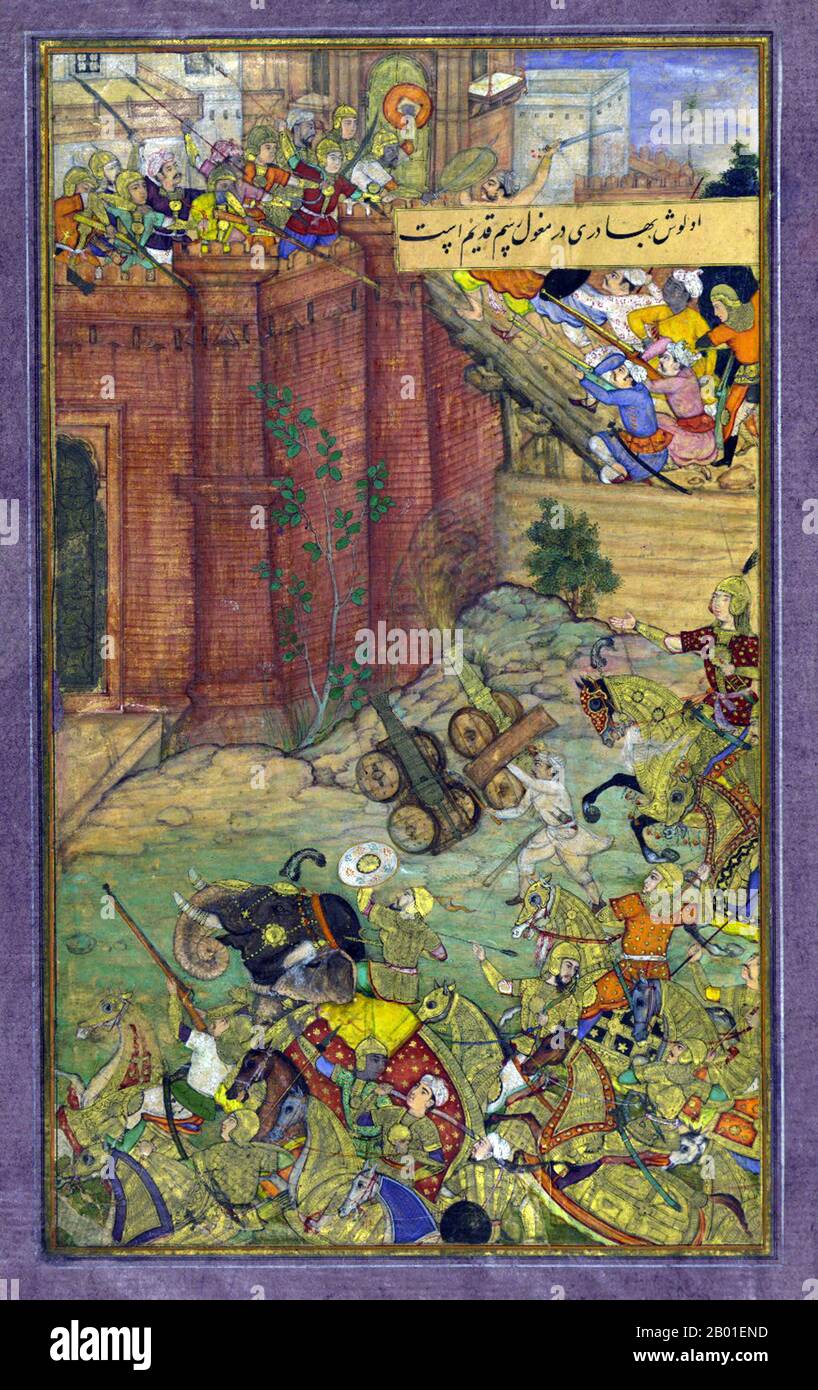 India: Zahir ud-din Muhammad Babur (1483-1531), the first Mughal Emperor, at the siege of Isfarah. Miniature painting from the Baburnama, c. 1590. Bāburnāma (literally: 'Book of Babur' or 'Letters of Babur'; alternatively known as Tuzk-e Babri) is the name given to the memoirs of Ẓahīr ud-Dīn Muḥammad Bābur, founder of the Mughal Empire and a great-great-great-grandson of Timur. It is an autobiographical work, originally written in the Chagatai language, known to Babur as 'Turki' (meaning Turkic), the spoken language of the Andijan-Timurids. Stock Photohttps://www.alamy.com/image-license-details/?v=1https://www.alamy.com/india-zahir-ud-din-muhammad-babur-1483-1531-the-first-mughal-emperor-at-the-siege-of-isfarah-miniature-painting-from-the-baburnama-c-1590-bburnma-literally-book-of-babur-or-letters-of-babur-alternatively-known-as-tuzk-e-babri-is-the-name-given-to-the-memoirs-of-ahr-ud-dn-muammad-bbur-founder-of-the-mughal-empire-and-a-great-great-great-grandson-of-timur-it-is-an-autobiographical-work-originally-written-in-the-chagatai-language-known-to-babur-as-turki-meaning-turkic-the-spoken-language-of-the-andijan-timurids-image344240889.html
India: Zahir ud-din Muhammad Babur (1483-1531), the first Mughal Emperor, at the siege of Isfarah. Miniature painting from the Baburnama, c. 1590. Bāburnāma (literally: 'Book of Babur' or 'Letters of Babur'; alternatively known as Tuzk-e Babri) is the name given to the memoirs of Ẓahīr ud-Dīn Muḥammad Bābur, founder of the Mughal Empire and a great-great-great-grandson of Timur. It is an autobiographical work, originally written in the Chagatai language, known to Babur as 'Turki' (meaning Turkic), the spoken language of the Andijan-Timurids. Stock Photohttps://www.alamy.com/image-license-details/?v=1https://www.alamy.com/india-zahir-ud-din-muhammad-babur-1483-1531-the-first-mughal-emperor-at-the-siege-of-isfarah-miniature-painting-from-the-baburnama-c-1590-bburnma-literally-book-of-babur-or-letters-of-babur-alternatively-known-as-tuzk-e-babri-is-the-name-given-to-the-memoirs-of-ahr-ud-dn-muammad-bbur-founder-of-the-mughal-empire-and-a-great-great-great-grandson-of-timur-it-is-an-autobiographical-work-originally-written-in-the-chagatai-language-known-to-babur-as-turki-meaning-turkic-the-spoken-language-of-the-andijan-timurids-image344240889.htmlRM2B01END–India: Zahir ud-din Muhammad Babur (1483-1531), the first Mughal Emperor, at the siege of Isfarah. Miniature painting from the Baburnama, c. 1590. Bāburnāma (literally: 'Book of Babur' or 'Letters of Babur'; alternatively known as Tuzk-e Babri) is the name given to the memoirs of Ẓahīr ud-Dīn Muḥammad Bābur, founder of the Mughal Empire and a great-great-great-grandson of Timur. It is an autobiographical work, originally written in the Chagatai language, known to Babur as 'Turki' (meaning Turkic), the spoken language of the Andijan-Timurids.
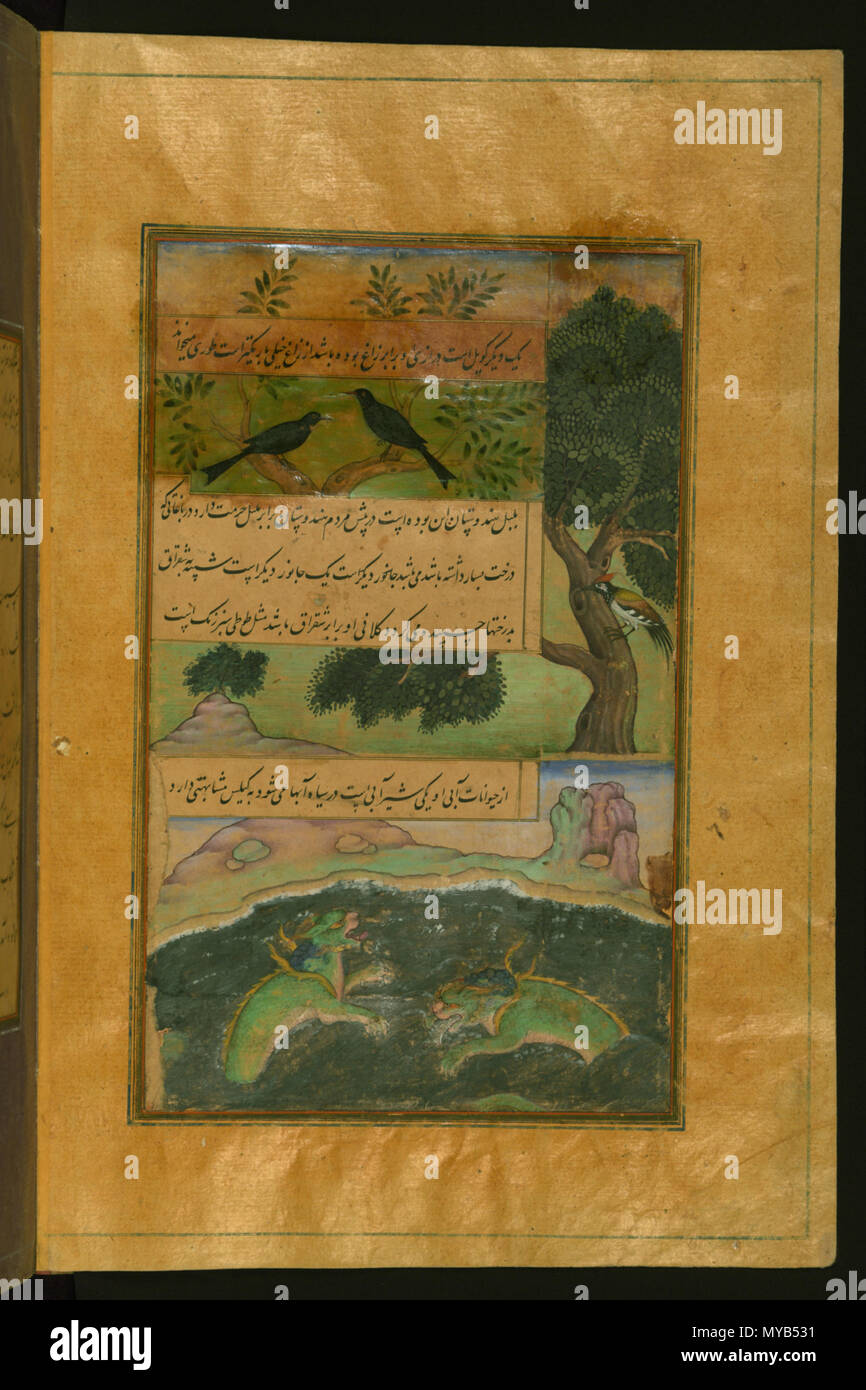 . English: Illustrations from the Manuscript of Baburnama (Memoirs of Babur) - Late 16th Century Bāburnāma is the memoirs of Ẓahīr ud-Dīn Muḥammad Bābur (1483-1530), founder of the Mughal Empire and a great-great-great-grandson of Timur. It is an autobiographical work, originally written in the Chagatai language, known to Babur as 'Turki' (meaning Turkic), the spoken language of the Andijan-Timurids. Because of Babur's cultural origin, his prose is highly Persianized in its sentence structure, morphology, and vocabulary,and also contains many phrases and smaller poems in Persian. During Empero Stock Photohttps://www.alamy.com/image-license-details/?v=1https://www.alamy.com/english-illustrations-from-the-manuscript-of-baburnama-memoirs-of-babur-late-16th-century-bburnma-is-the-memoirs-of-ahr-ud-dn-muammad-bbur-1483-1530-founder-of-the-mughal-empire-and-a-great-great-great-grandson-of-timur-it-is-an-autobiographical-work-originally-written-in-the-chagatai-language-known-to-babur-as-turki-meaning-turkic-the-spoken-language-of-the-andijan-timurids-because-of-baburs-cultural-origin-his-prose-is-highly-persianized-in-its-sentence-structure-morphology-and-vocabularyand-also-contains-many-phrases-and-smaller-poems-in-persian-during-empero-image188944869.html
. English: Illustrations from the Manuscript of Baburnama (Memoirs of Babur) - Late 16th Century Bāburnāma is the memoirs of Ẓahīr ud-Dīn Muḥammad Bābur (1483-1530), founder of the Mughal Empire and a great-great-great-grandson of Timur. It is an autobiographical work, originally written in the Chagatai language, known to Babur as 'Turki' (meaning Turkic), the spoken language of the Andijan-Timurids. Because of Babur's cultural origin, his prose is highly Persianized in its sentence structure, morphology, and vocabulary,and also contains many phrases and smaller poems in Persian. During Empero Stock Photohttps://www.alamy.com/image-license-details/?v=1https://www.alamy.com/english-illustrations-from-the-manuscript-of-baburnama-memoirs-of-babur-late-16th-century-bburnma-is-the-memoirs-of-ahr-ud-dn-muammad-bbur-1483-1530-founder-of-the-mughal-empire-and-a-great-great-great-grandson-of-timur-it-is-an-autobiographical-work-originally-written-in-the-chagatai-language-known-to-babur-as-turki-meaning-turkic-the-spoken-language-of-the-andijan-timurids-because-of-baburs-cultural-origin-his-prose-is-highly-persianized-in-its-sentence-structure-morphology-and-vocabularyand-also-contains-many-phrases-and-smaller-poems-in-persian-during-empero-image188944869.htmlRMMYB531–. English: Illustrations from the Manuscript of Baburnama (Memoirs of Babur) - Late 16th Century Bāburnāma is the memoirs of Ẓahīr ud-Dīn Muḥammad Bābur (1483-1530), founder of the Mughal Empire and a great-great-great-grandson of Timur. It is an autobiographical work, originally written in the Chagatai language, known to Babur as 'Turki' (meaning Turkic), the spoken language of the Andijan-Timurids. Because of Babur's cultural origin, his prose is highly Persianized in its sentence structure, morphology, and vocabulary,and also contains many phrases and smaller poems in Persian. During Empero
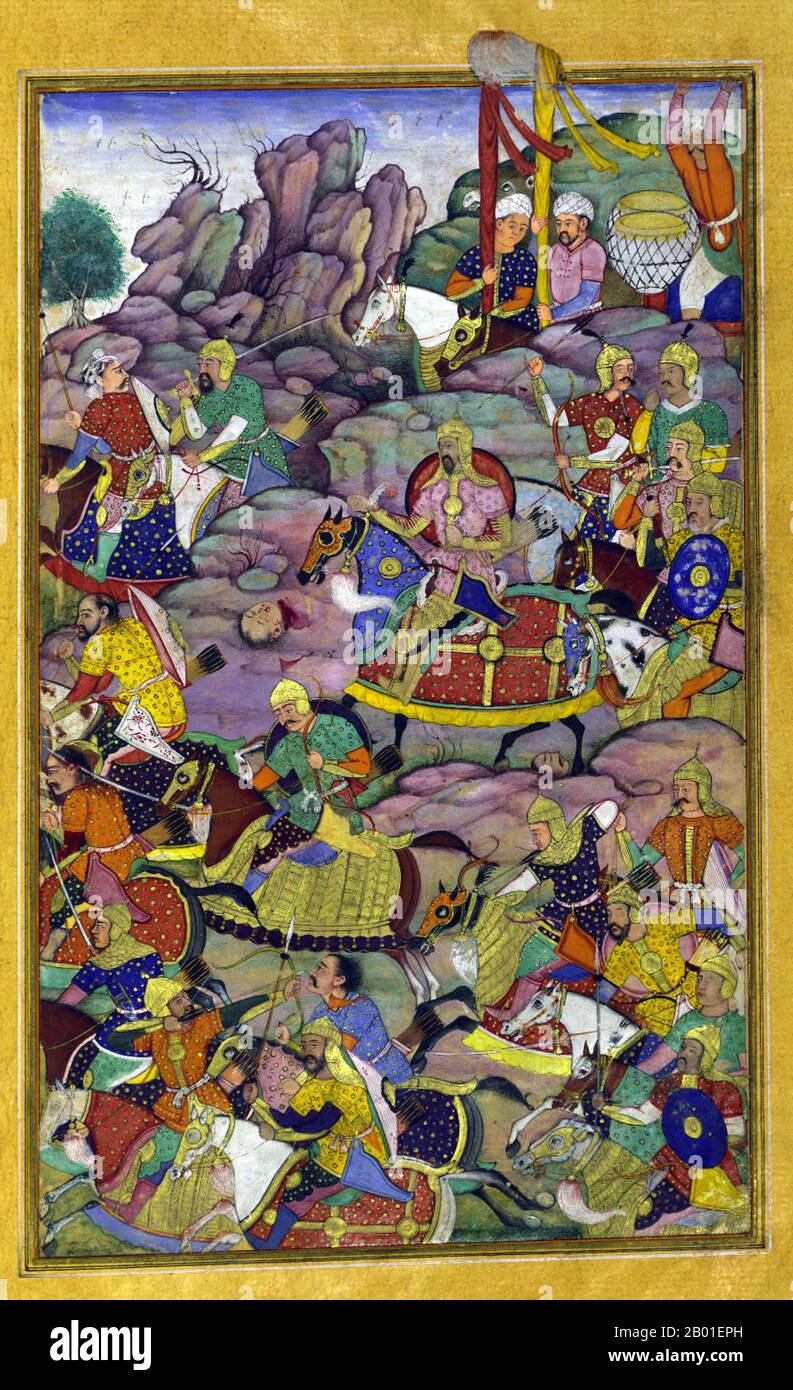 India: The final phase of the battle of Kandahar on the side of the Murghan mountain. Miniature painting from the Baburnama, late 16th century. Bāburnāma (literally: 'Book of Babur' or 'Letters of Babur'; alternatively known as Tuzk-e Babri) is the name given to the memoirs of Ẓahīr ud-Dīn Muḥammad Bābur (1483-1530), founder of the Mughal Empire and a great-great-great-grandson of Timur. It is an autobiographical work, originally written in the Chagatai language, known to Babur as 'Turki' (meaning Turkic), the spoken language of the Andijan-Timurids. Stock Photohttps://www.alamy.com/image-license-details/?v=1https://www.alamy.com/india-the-final-phase-of-the-battle-of-kandahar-on-the-side-of-the-murghan-mountain-miniature-painting-from-the-baburnama-late-16th-century-bburnma-literally-book-of-babur-or-letters-of-babur-alternatively-known-as-tuzk-e-babri-is-the-name-given-to-the-memoirs-of-ahr-ud-dn-muammad-bbur-1483-1530-founder-of-the-mughal-empire-and-a-great-great-great-grandson-of-timur-it-is-an-autobiographical-work-originally-written-in-the-chagatai-language-known-to-babur-as-turki-meaning-turkic-the-spoken-language-of-the-andijan-timurids-image344240921.html
India: The final phase of the battle of Kandahar on the side of the Murghan mountain. Miniature painting from the Baburnama, late 16th century. Bāburnāma (literally: 'Book of Babur' or 'Letters of Babur'; alternatively known as Tuzk-e Babri) is the name given to the memoirs of Ẓahīr ud-Dīn Muḥammad Bābur (1483-1530), founder of the Mughal Empire and a great-great-great-grandson of Timur. It is an autobiographical work, originally written in the Chagatai language, known to Babur as 'Turki' (meaning Turkic), the spoken language of the Andijan-Timurids. Stock Photohttps://www.alamy.com/image-license-details/?v=1https://www.alamy.com/india-the-final-phase-of-the-battle-of-kandahar-on-the-side-of-the-murghan-mountain-miniature-painting-from-the-baburnama-late-16th-century-bburnma-literally-book-of-babur-or-letters-of-babur-alternatively-known-as-tuzk-e-babri-is-the-name-given-to-the-memoirs-of-ahr-ud-dn-muammad-bbur-1483-1530-founder-of-the-mughal-empire-and-a-great-great-great-grandson-of-timur-it-is-an-autobiographical-work-originally-written-in-the-chagatai-language-known-to-babur-as-turki-meaning-turkic-the-spoken-language-of-the-andijan-timurids-image344240921.htmlRM2B01EPH–India: The final phase of the battle of Kandahar on the side of the Murghan mountain. Miniature painting from the Baburnama, late 16th century. Bāburnāma (literally: 'Book of Babur' or 'Letters of Babur'; alternatively known as Tuzk-e Babri) is the name given to the memoirs of Ẓahīr ud-Dīn Muḥammad Bābur (1483-1530), founder of the Mughal Empire and a great-great-great-grandson of Timur. It is an autobiographical work, originally written in the Chagatai language, known to Babur as 'Turki' (meaning Turkic), the spoken language of the Andijan-Timurids.
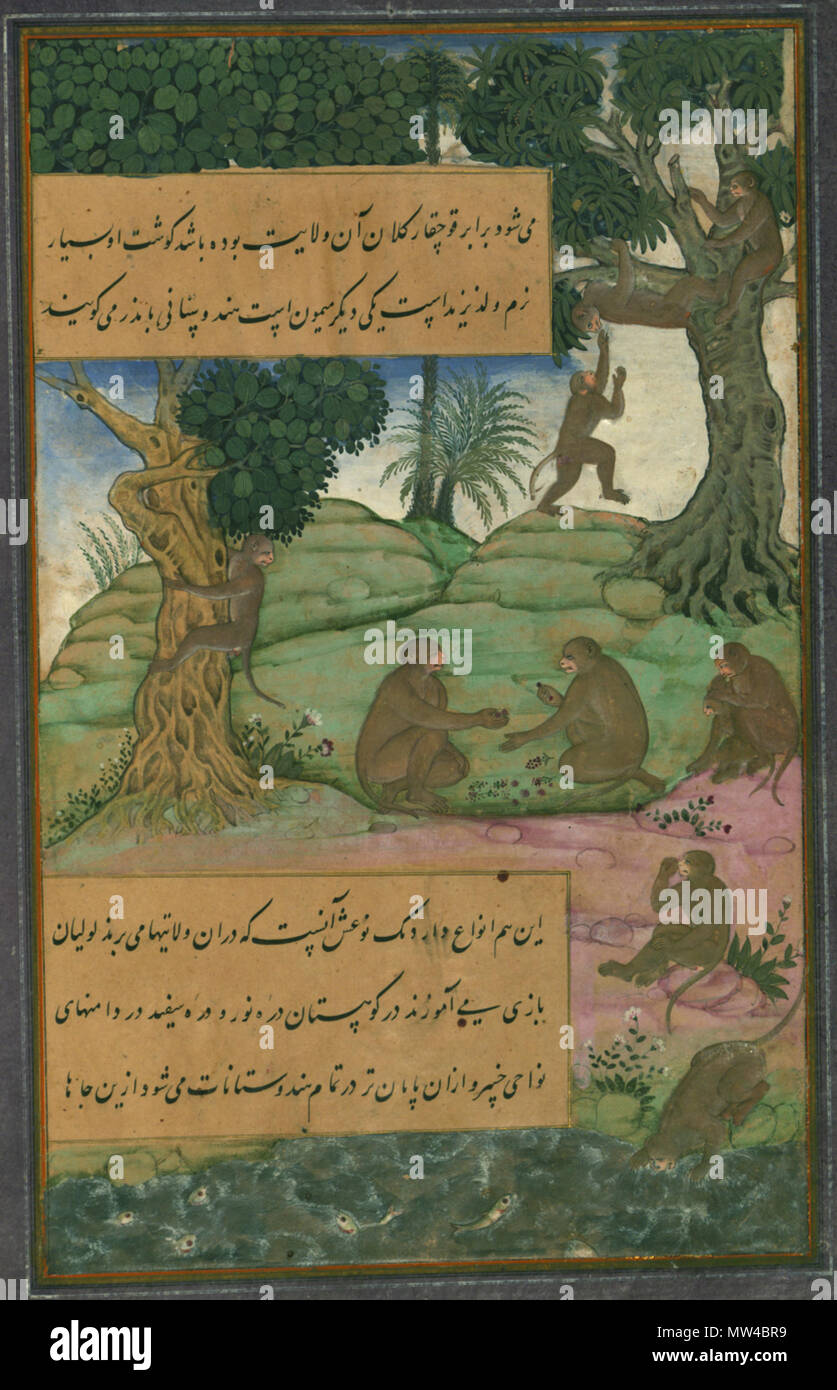 . English: Illustrations from the Manuscript of Baburnama (Memoirs of Babur) - Late 16th Century Bāburnāma is the memoirs of Ẓahīr ud-Dīn Muḥammad Bābur (1483-1530), founder of the Mughal Empire and a great-great-great-grandson of Timur. It is an autobiographical work, originally written in the Chagatai language, known to Babur as 'Turki' (meaning Turkic), the spoken language of the Andijan-Timurids. Because of Babur's cultural origin, his prose is highly Persianized in its sentence structure, morphology, and vocabulary,and also contains many phrases and smaller poems in Persian. During Empero Stock Photohttps://www.alamy.com/image-license-details/?v=1https://www.alamy.com/english-illustrations-from-the-manuscript-of-baburnama-memoirs-of-babur-late-16th-century-bburnma-is-the-memoirs-of-ahr-ud-dn-muammad-bbur-1483-1530-founder-of-the-mughal-empire-and-a-great-great-great-grandson-of-timur-it-is-an-autobiographical-work-originally-written-in-the-chagatai-language-known-to-babur-as-turki-meaning-turkic-the-spoken-language-of-the-andijan-timurids-because-of-baburs-cultural-origin-his-prose-is-highly-persianized-in-its-sentence-structure-morphology-and-vocabularyand-also-contains-many-phrases-and-smaller-poems-in-persian-during-empero-image187567165.html
. English: Illustrations from the Manuscript of Baburnama (Memoirs of Babur) - Late 16th Century Bāburnāma is the memoirs of Ẓahīr ud-Dīn Muḥammad Bābur (1483-1530), founder of the Mughal Empire and a great-great-great-grandson of Timur. It is an autobiographical work, originally written in the Chagatai language, known to Babur as 'Turki' (meaning Turkic), the spoken language of the Andijan-Timurids. Because of Babur's cultural origin, his prose is highly Persianized in its sentence structure, morphology, and vocabulary,and also contains many phrases and smaller poems in Persian. During Empero Stock Photohttps://www.alamy.com/image-license-details/?v=1https://www.alamy.com/english-illustrations-from-the-manuscript-of-baburnama-memoirs-of-babur-late-16th-century-bburnma-is-the-memoirs-of-ahr-ud-dn-muammad-bbur-1483-1530-founder-of-the-mughal-empire-and-a-great-great-great-grandson-of-timur-it-is-an-autobiographical-work-originally-written-in-the-chagatai-language-known-to-babur-as-turki-meaning-turkic-the-spoken-language-of-the-andijan-timurids-because-of-baburs-cultural-origin-his-prose-is-highly-persianized-in-its-sentence-structure-morphology-and-vocabularyand-also-contains-many-phrases-and-smaller-poems-in-persian-during-empero-image187567165.htmlRMMW4BR9–. English: Illustrations from the Manuscript of Baburnama (Memoirs of Babur) - Late 16th Century Bāburnāma is the memoirs of Ẓahīr ud-Dīn Muḥammad Bābur (1483-1530), founder of the Mughal Empire and a great-great-great-grandson of Timur. It is an autobiographical work, originally written in the Chagatai language, known to Babur as 'Turki' (meaning Turkic), the spoken language of the Andijan-Timurids. Because of Babur's cultural origin, his prose is highly Persianized in its sentence structure, morphology, and vocabulary,and also contains many phrases and smaller poems in Persian. During Empero
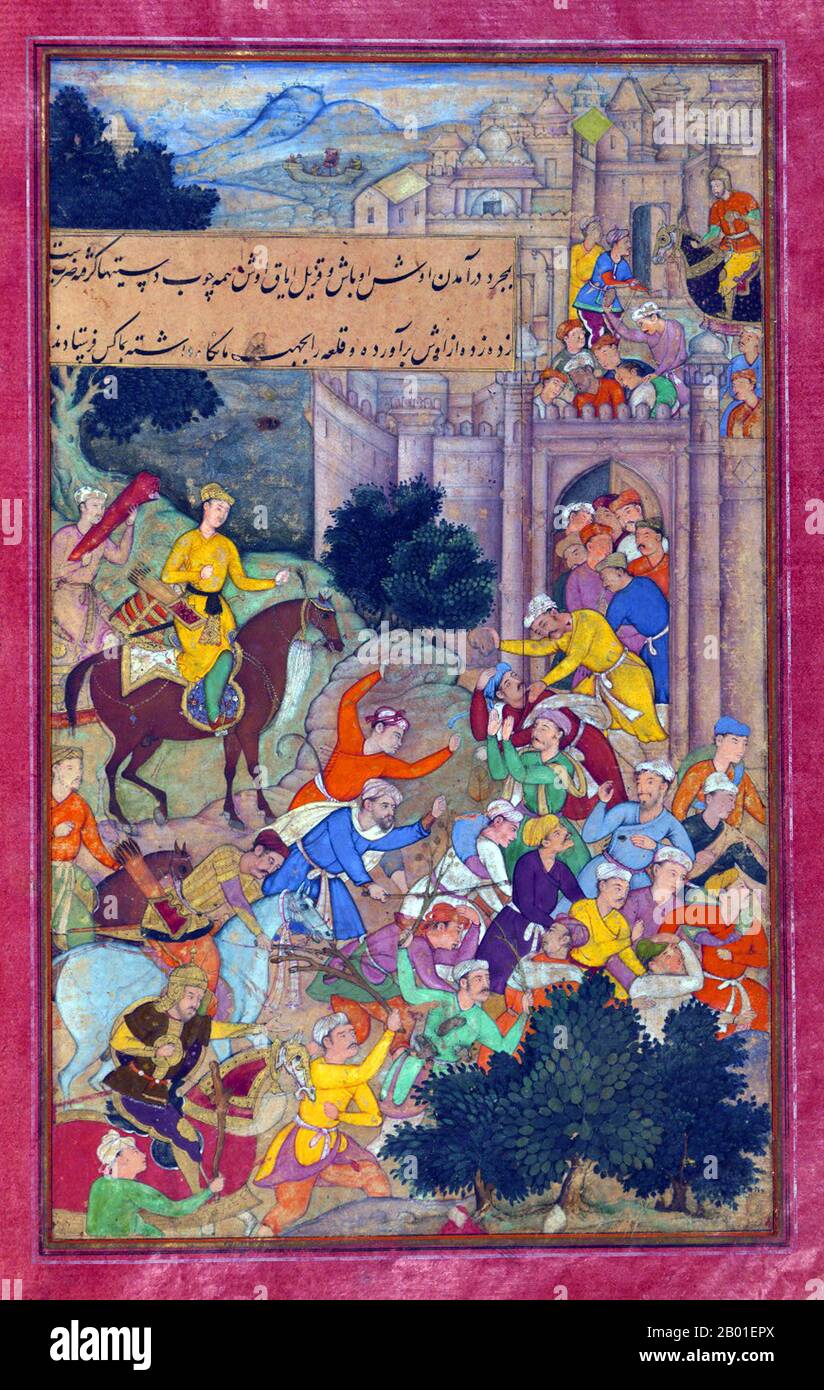 India: The inhabitants of Osh (Ūsh) drive the enemy out with sticks and clubs to defend the town for Babur. Miniature painting from the Baburnama, late 16th century. Bāburnāma (literally: 'Book of Babur' or 'Letters of Babur'; alternatively known as Tuzk-e Babri) is the name given to the memoirs of Ẓahīr ud-Dīn Muḥammad Bābur (1483-1530), founder of the Mughal Empire and a great-great-great-grandson of Timur. It is an autobiographical work, originally written in the Chagatai language, known to Babur as 'Turki' (meaning Turkic), the spoken language of the Andijan-Timurids. Stock Photohttps://www.alamy.com/image-license-details/?v=1https://www.alamy.com/india-the-inhabitants-of-osh-sh-drive-the-enemy-out-with-sticks-and-clubs-to-defend-the-town-for-babur-miniature-painting-from-the-baburnama-late-16th-century-bburnma-literally-book-of-babur-or-letters-of-babur-alternatively-known-as-tuzk-e-babri-is-the-name-given-to-the-memoirs-of-ahr-ud-dn-muammad-bbur-1483-1530-founder-of-the-mughal-empire-and-a-great-great-great-grandson-of-timur-it-is-an-autobiographical-work-originally-written-in-the-chagatai-language-known-to-babur-as-turki-meaning-turkic-the-spoken-language-of-the-andijan-timurids-image344240930.html
India: The inhabitants of Osh (Ūsh) drive the enemy out with sticks and clubs to defend the town for Babur. Miniature painting from the Baburnama, late 16th century. Bāburnāma (literally: 'Book of Babur' or 'Letters of Babur'; alternatively known as Tuzk-e Babri) is the name given to the memoirs of Ẓahīr ud-Dīn Muḥammad Bābur (1483-1530), founder of the Mughal Empire and a great-great-great-grandson of Timur. It is an autobiographical work, originally written in the Chagatai language, known to Babur as 'Turki' (meaning Turkic), the spoken language of the Andijan-Timurids. Stock Photohttps://www.alamy.com/image-license-details/?v=1https://www.alamy.com/india-the-inhabitants-of-osh-sh-drive-the-enemy-out-with-sticks-and-clubs-to-defend-the-town-for-babur-miniature-painting-from-the-baburnama-late-16th-century-bburnma-literally-book-of-babur-or-letters-of-babur-alternatively-known-as-tuzk-e-babri-is-the-name-given-to-the-memoirs-of-ahr-ud-dn-muammad-bbur-1483-1530-founder-of-the-mughal-empire-and-a-great-great-great-grandson-of-timur-it-is-an-autobiographical-work-originally-written-in-the-chagatai-language-known-to-babur-as-turki-meaning-turkic-the-spoken-language-of-the-andijan-timurids-image344240930.htmlRM2B01EPX–India: The inhabitants of Osh (Ūsh) drive the enemy out with sticks and clubs to defend the town for Babur. Miniature painting from the Baburnama, late 16th century. Bāburnāma (literally: 'Book of Babur' or 'Letters of Babur'; alternatively known as Tuzk-e Babri) is the name given to the memoirs of Ẓahīr ud-Dīn Muḥammad Bābur (1483-1530), founder of the Mughal Empire and a great-great-great-grandson of Timur. It is an autobiographical work, originally written in the Chagatai language, known to Babur as 'Turki' (meaning Turkic), the spoken language of the Andijan-Timurids.
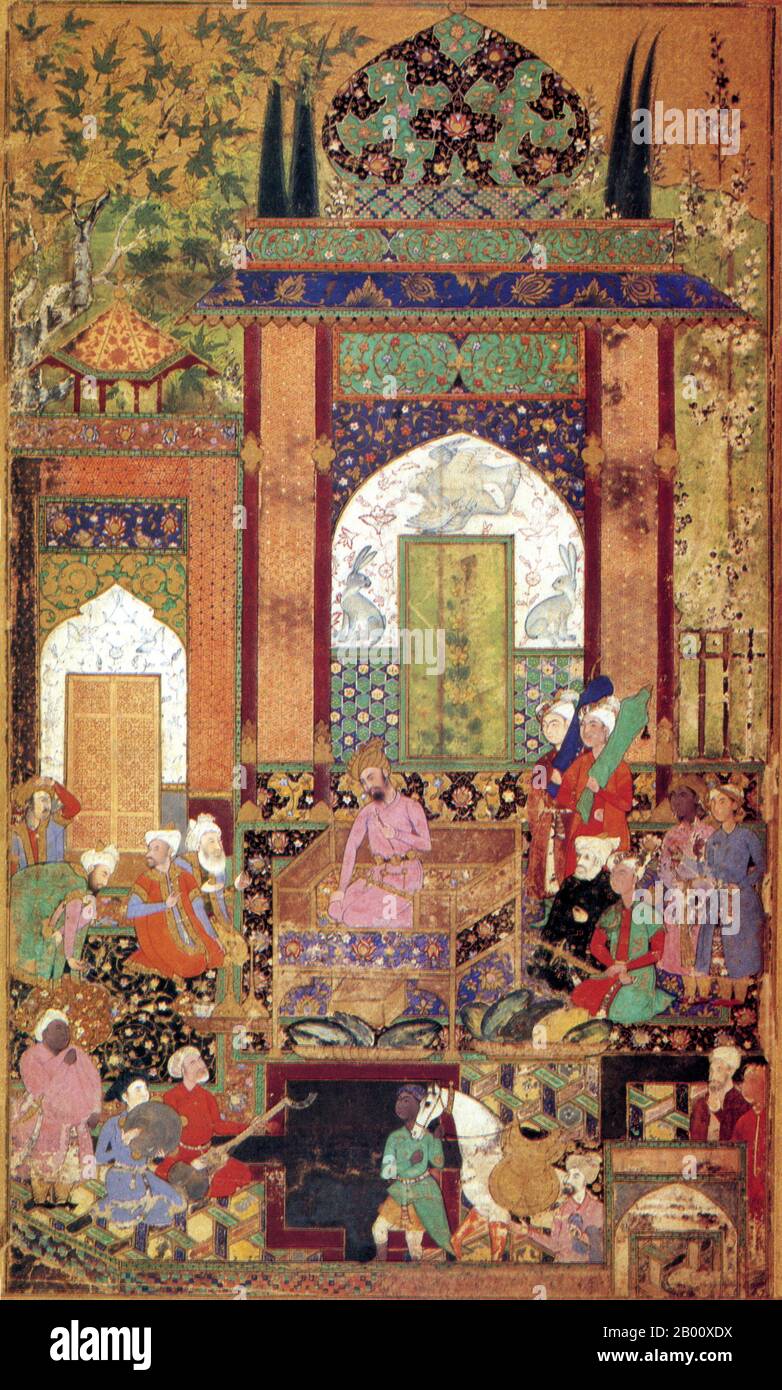 India: The first great Mughal emperor, Babur, receives a courtier in this illustration by Farrukh Beg (1545-1615) from a 1589 copy of his autobiography, ‘Barburnama’. Zahir ud-din Muhammad Babur (1483—1530-1) was a Muslim conqueror from Central Asia who succeeded in laying the basis for the Mughal dynasty of India. He was a direct descendant of Timur (Tamerlane) and of Genghis Khan. Babur identified his lineage as Timurid and Chaghatay-Turkic, while his origin, milieu, training and culture were steeped in Persian culture. Stock Photohttps://www.alamy.com/image-license-details/?v=1https://www.alamy.com/india-the-first-great-mughal-emperor-babur-receives-a-courtier-in-this-illustration-by-farrukh-beg-1545-1615-from-a-1589-copy-of-his-autobiography-barburnama-zahir-ud-din-muhammad-babur-14831530-1-was-a-muslim-conqueror-from-central-asia-who-succeeded-in-laying-the-basis-for-the-mughal-dynasty-of-india-he-was-a-direct-descendant-of-timur-tamerlane-and-of-genghis-khan-babur-identified-his-lineage-as-timurid-and-chaghatay-turkic-while-his-origin-milieu-training-and-culture-were-steeped-in-persian-culture-image344228134.html
India: The first great Mughal emperor, Babur, receives a courtier in this illustration by Farrukh Beg (1545-1615) from a 1589 copy of his autobiography, ‘Barburnama’. Zahir ud-din Muhammad Babur (1483—1530-1) was a Muslim conqueror from Central Asia who succeeded in laying the basis for the Mughal dynasty of India. He was a direct descendant of Timur (Tamerlane) and of Genghis Khan. Babur identified his lineage as Timurid and Chaghatay-Turkic, while his origin, milieu, training and culture were steeped in Persian culture. Stock Photohttps://www.alamy.com/image-license-details/?v=1https://www.alamy.com/india-the-first-great-mughal-emperor-babur-receives-a-courtier-in-this-illustration-by-farrukh-beg-1545-1615-from-a-1589-copy-of-his-autobiography-barburnama-zahir-ud-din-muhammad-babur-14831530-1-was-a-muslim-conqueror-from-central-asia-who-succeeded-in-laying-the-basis-for-the-mughal-dynasty-of-india-he-was-a-direct-descendant-of-timur-tamerlane-and-of-genghis-khan-babur-identified-his-lineage-as-timurid-and-chaghatay-turkic-while-his-origin-milieu-training-and-culture-were-steeped-in-persian-culture-image344228134.htmlRM2B00XDX–India: The first great Mughal emperor, Babur, receives a courtier in this illustration by Farrukh Beg (1545-1615) from a 1589 copy of his autobiography, ‘Barburnama’. Zahir ud-din Muhammad Babur (1483—1530-1) was a Muslim conqueror from Central Asia who succeeded in laying the basis for the Mughal dynasty of India. He was a direct descendant of Timur (Tamerlane) and of Genghis Khan. Babur identified his lineage as Timurid and Chaghatay-Turkic, while his origin, milieu, training and culture were steeped in Persian culture.
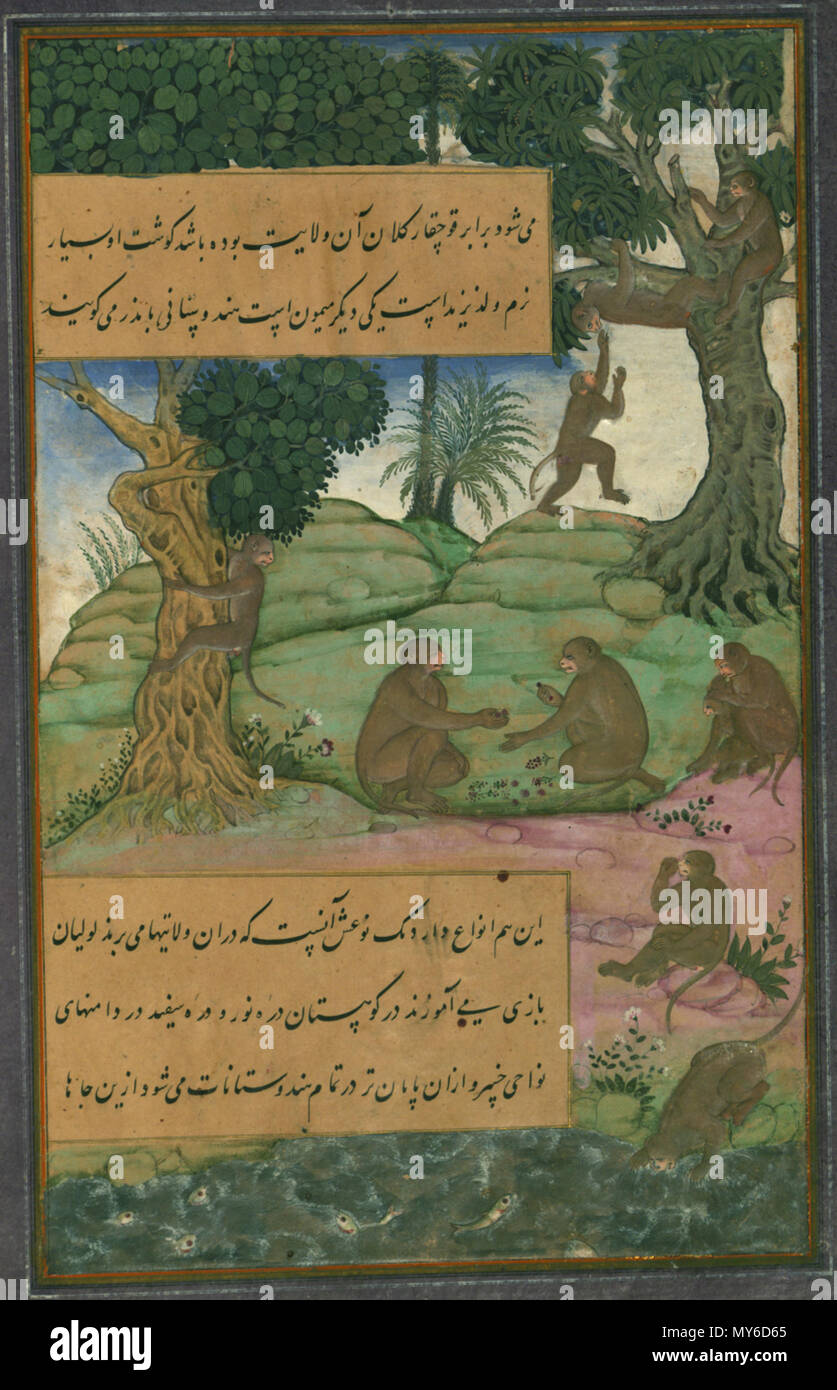 . English: Illustrations from the Manuscript of Baburnama (Memoirs of Babur) - Late 16th Century Bāburnāma is the memoirs of Ẓahīr ud-Dīn Muḥammad Bābur (1483-1530), founder of the Mughal Empire and a great-great-great-grandson of Timur. It is an autobiographical work, originally written in the Chagatai language, known to Babur as 'Turki' (meaning Turkic), the spoken language of the Andijan-Timurids. Because of Babur's cultural origin, his prose is highly Persianized in its sentence structure, morphology, and vocabulary,and also contains many phrases and smaller poems in Persian. During Empero Stock Photohttps://www.alamy.com/image-license-details/?v=1https://www.alamy.com/english-illustrations-from-the-manuscript-of-baburnama-memoirs-of-babur-late-16th-century-bburnma-is-the-memoirs-of-ahr-ud-dn-muammad-bbur-1483-1530-founder-of-the-mughal-empire-and-a-great-great-great-grandson-of-timur-it-is-an-autobiographical-work-originally-written-in-the-chagatai-language-known-to-babur-as-turki-meaning-turkic-the-spoken-language-of-the-andijan-timurids-because-of-baburs-cultural-origin-his-prose-is-highly-persianized-in-its-sentence-structure-morphology-and-vocabularyand-also-contains-many-phrases-and-smaller-poems-in-persian-during-empero-image188841469.html
. English: Illustrations from the Manuscript of Baburnama (Memoirs of Babur) - Late 16th Century Bāburnāma is the memoirs of Ẓahīr ud-Dīn Muḥammad Bābur (1483-1530), founder of the Mughal Empire and a great-great-great-grandson of Timur. It is an autobiographical work, originally written in the Chagatai language, known to Babur as 'Turki' (meaning Turkic), the spoken language of the Andijan-Timurids. Because of Babur's cultural origin, his prose is highly Persianized in its sentence structure, morphology, and vocabulary,and also contains many phrases and smaller poems in Persian. During Empero Stock Photohttps://www.alamy.com/image-license-details/?v=1https://www.alamy.com/english-illustrations-from-the-manuscript-of-baburnama-memoirs-of-babur-late-16th-century-bburnma-is-the-memoirs-of-ahr-ud-dn-muammad-bbur-1483-1530-founder-of-the-mughal-empire-and-a-great-great-great-grandson-of-timur-it-is-an-autobiographical-work-originally-written-in-the-chagatai-language-known-to-babur-as-turki-meaning-turkic-the-spoken-language-of-the-andijan-timurids-because-of-baburs-cultural-origin-his-prose-is-highly-persianized-in-its-sentence-structure-morphology-and-vocabularyand-also-contains-many-phrases-and-smaller-poems-in-persian-during-empero-image188841469.htmlRMMY6D65–. English: Illustrations from the Manuscript of Baburnama (Memoirs of Babur) - Late 16th Century Bāburnāma is the memoirs of Ẓahīr ud-Dīn Muḥammad Bābur (1483-1530), founder of the Mughal Empire and a great-great-great-grandson of Timur. It is an autobiographical work, originally written in the Chagatai language, known to Babur as 'Turki' (meaning Turkic), the spoken language of the Andijan-Timurids. Because of Babur's cultural origin, his prose is highly Persianized in its sentence structure, morphology, and vocabulary,and also contains many phrases and smaller poems in Persian. During Empero
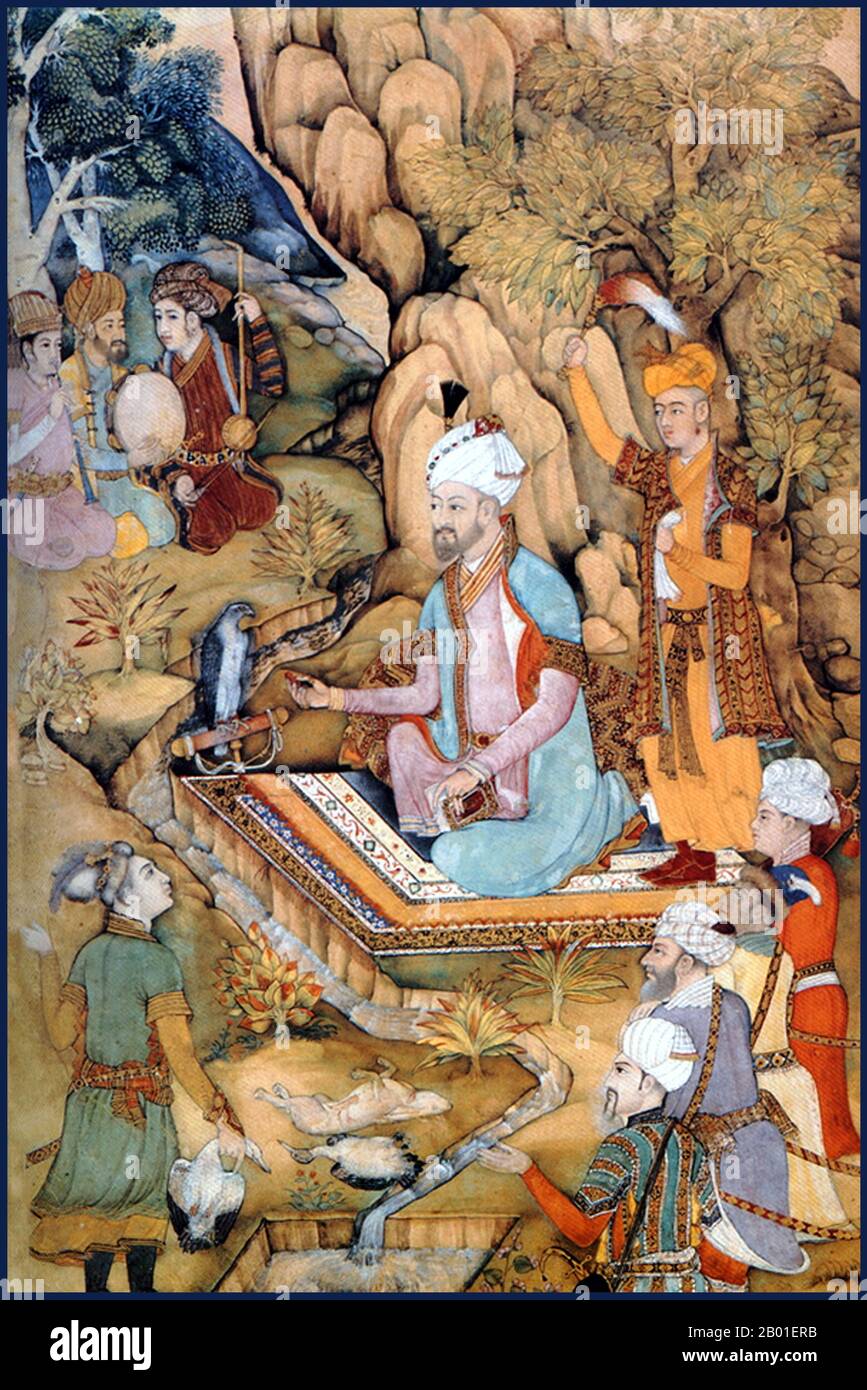 India: Zahir ud-din Muhammad Babur (1483-1530), the first Mughal Emperor, relaxing while being entertained. Miniature painting from the Baburnama, c. 1605. Bāburnāma (literally: 'Book of Babur' or 'Letters of Babur'; alternatively known as Tuzk-e Babri) is the name given to the memoirs of Ẓahīr ud-Dīn Muḥammad Bābu, founder of the Mughal Empire and a great-great-great-grandson of Timur. It is an autobiographical work, originally written in the Chagatai language, known to Babur as 'Turki' (meaning Turkic), the spoken language of the Andijan-Timurids. Stock Photohttps://www.alamy.com/image-license-details/?v=1https://www.alamy.com/india-zahir-ud-din-muhammad-babur-1483-1530-the-first-mughal-emperor-relaxing-while-being-entertained-miniature-painting-from-the-baburnama-c-1605-bburnma-literally-book-of-babur-or-letters-of-babur-alternatively-known-as-tuzk-e-babri-is-the-name-given-to-the-memoirs-of-ahr-ud-dn-muammad-bbu-founder-of-the-mughal-empire-and-a-great-great-great-grandson-of-timur-it-is-an-autobiographical-work-originally-written-in-the-chagatai-language-known-to-babur-as-turki-meaning-turkic-the-spoken-language-of-the-andijan-timurids-image344240943.html
India: Zahir ud-din Muhammad Babur (1483-1530), the first Mughal Emperor, relaxing while being entertained. Miniature painting from the Baburnama, c. 1605. Bāburnāma (literally: 'Book of Babur' or 'Letters of Babur'; alternatively known as Tuzk-e Babri) is the name given to the memoirs of Ẓahīr ud-Dīn Muḥammad Bābu, founder of the Mughal Empire and a great-great-great-grandson of Timur. It is an autobiographical work, originally written in the Chagatai language, known to Babur as 'Turki' (meaning Turkic), the spoken language of the Andijan-Timurids. Stock Photohttps://www.alamy.com/image-license-details/?v=1https://www.alamy.com/india-zahir-ud-din-muhammad-babur-1483-1530-the-first-mughal-emperor-relaxing-while-being-entertained-miniature-painting-from-the-baburnama-c-1605-bburnma-literally-book-of-babur-or-letters-of-babur-alternatively-known-as-tuzk-e-babri-is-the-name-given-to-the-memoirs-of-ahr-ud-dn-muammad-bbu-founder-of-the-mughal-empire-and-a-great-great-great-grandson-of-timur-it-is-an-autobiographical-work-originally-written-in-the-chagatai-language-known-to-babur-as-turki-meaning-turkic-the-spoken-language-of-the-andijan-timurids-image344240943.htmlRM2B01ERB–India: Zahir ud-din Muhammad Babur (1483-1530), the first Mughal Emperor, relaxing while being entertained. Miniature painting from the Baburnama, c. 1605. Bāburnāma (literally: 'Book of Babur' or 'Letters of Babur'; alternatively known as Tuzk-e Babri) is the name given to the memoirs of Ẓahīr ud-Dīn Muḥammad Bābu, founder of the Mughal Empire and a great-great-great-grandson of Timur. It is an autobiographical work, originally written in the Chagatai language, known to Babur as 'Turki' (meaning Turkic), the spoken language of the Andijan-Timurids.
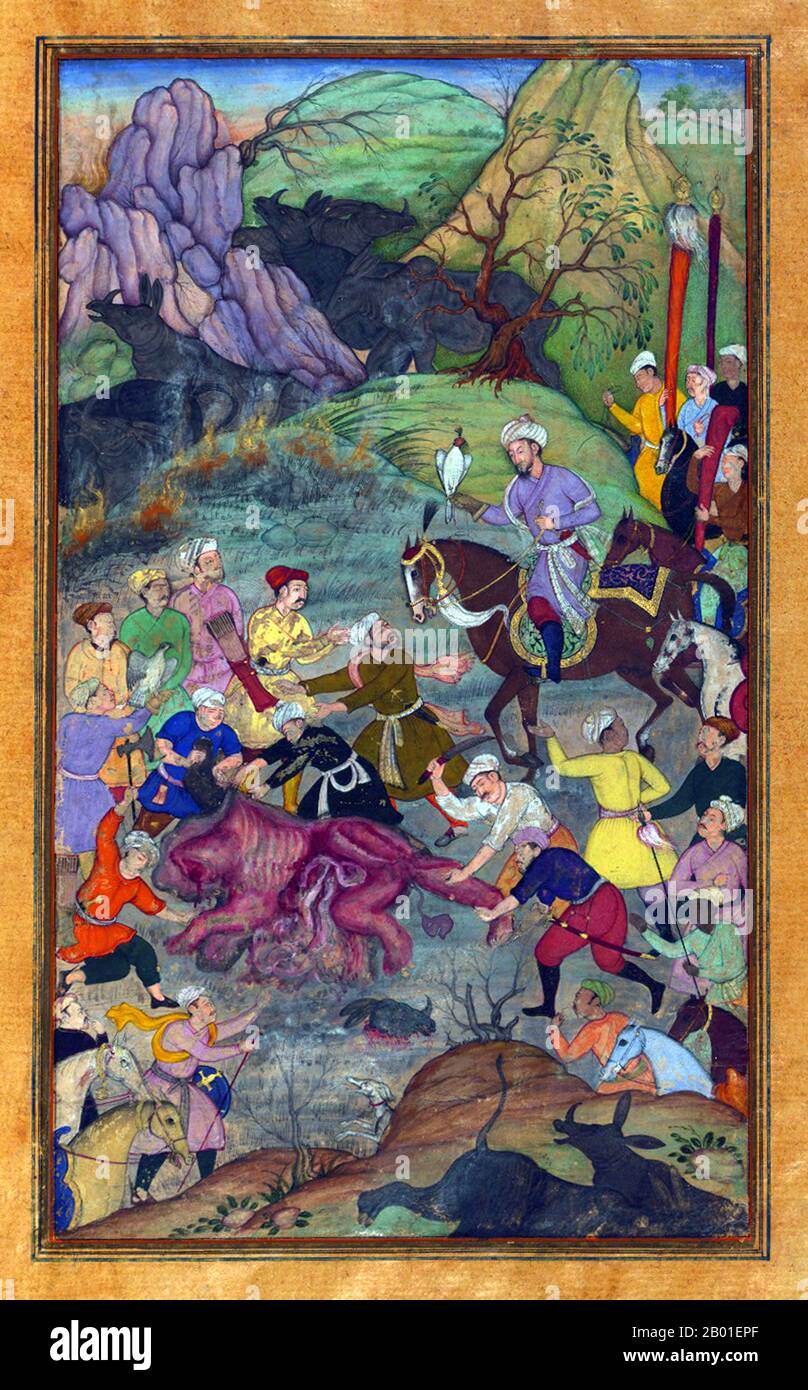 India: Zahir ud-din Muhammad Babur (1483-1530) the first Mughal Emperor, hunting for rhinoceros in Swat. Miniature painting from the Baburnama, late 16th century. Bāburnāma (literally: 'Book of Babur' or 'Letters of Babur'; alternatively known as Tuzk-e Babri) is the name given to the memoirs of Ẓahīr ud-Dīn Muḥammad Bābur, founder of the Mughal Empire and a great-great-great-grandson of Timur. It is an autobiographical work, originally written in the Chagatai language, known to Babur as 'Turki' (meaning Turkic), the spoken language of the Andijan-Timurids. Stock Photohttps://www.alamy.com/image-license-details/?v=1https://www.alamy.com/india-zahir-ud-din-muhammad-babur-1483-1530-the-first-mughal-emperor-hunting-for-rhinoceros-in-swat-miniature-painting-from-the-baburnama-late-16th-century-bburnma-literally-book-of-babur-or-letters-of-babur-alternatively-known-as-tuzk-e-babri-is-the-name-given-to-the-memoirs-of-ahr-ud-dn-muammad-bbur-founder-of-the-mughal-empire-and-a-great-great-great-grandson-of-timur-it-is-an-autobiographical-work-originally-written-in-the-chagatai-language-known-to-babur-as-turki-meaning-turkic-the-spoken-language-of-the-andijan-timurids-image344240919.html
India: Zahir ud-din Muhammad Babur (1483-1530) the first Mughal Emperor, hunting for rhinoceros in Swat. Miniature painting from the Baburnama, late 16th century. Bāburnāma (literally: 'Book of Babur' or 'Letters of Babur'; alternatively known as Tuzk-e Babri) is the name given to the memoirs of Ẓahīr ud-Dīn Muḥammad Bābur, founder of the Mughal Empire and a great-great-great-grandson of Timur. It is an autobiographical work, originally written in the Chagatai language, known to Babur as 'Turki' (meaning Turkic), the spoken language of the Andijan-Timurids. Stock Photohttps://www.alamy.com/image-license-details/?v=1https://www.alamy.com/india-zahir-ud-din-muhammad-babur-1483-1530-the-first-mughal-emperor-hunting-for-rhinoceros-in-swat-miniature-painting-from-the-baburnama-late-16th-century-bburnma-literally-book-of-babur-or-letters-of-babur-alternatively-known-as-tuzk-e-babri-is-the-name-given-to-the-memoirs-of-ahr-ud-dn-muammad-bbur-founder-of-the-mughal-empire-and-a-great-great-great-grandson-of-timur-it-is-an-autobiographical-work-originally-written-in-the-chagatai-language-known-to-babur-as-turki-meaning-turkic-the-spoken-language-of-the-andijan-timurids-image344240919.htmlRM2B01EPF–India: Zahir ud-din Muhammad Babur (1483-1530) the first Mughal Emperor, hunting for rhinoceros in Swat. Miniature painting from the Baburnama, late 16th century. Bāburnāma (literally: 'Book of Babur' or 'Letters of Babur'; alternatively known as Tuzk-e Babri) is the name given to the memoirs of Ẓahīr ud-Dīn Muḥammad Bābur, founder of the Mughal Empire and a great-great-great-grandson of Timur. It is an autobiographical work, originally written in the Chagatai language, known to Babur as 'Turki' (meaning Turkic), the spoken language of the Andijan-Timurids.
 . English: Illustrations from the Manuscript of Baburnama (Memoirs of Babur) - Late 16th Century Bāburnāma is the memoirs of Ẓahīr ud-Dīn Muḥammad Bābur (1483-1530), founder of the Mughal Empire and a great-great-great-grandson of Timur. It is an autobiographical work, originally written in the Chagatai language, known to Babur as 'Turki' (meaning Turkic), the spoken language of the Andijan-Timurids. Because of Babur's cultural origin, his prose is highly Persianized in its sentence structure, morphology, and vocabulary,and also contains many phrases and smaller poems in Persian. During Empero Stock Photohttps://www.alamy.com/image-license-details/?v=1https://www.alamy.com/english-illustrations-from-the-manuscript-of-baburnama-memoirs-of-babur-late-16th-century-bburnma-is-the-memoirs-of-ahr-ud-dn-muammad-bbur-1483-1530-founder-of-the-mughal-empire-and-a-great-great-great-grandson-of-timur-it-is-an-autobiographical-work-originally-written-in-the-chagatai-language-known-to-babur-as-turki-meaning-turkic-the-spoken-language-of-the-andijan-timurids-because-of-baburs-cultural-origin-his-prose-is-highly-persianized-in-its-sentence-structure-morphology-and-vocabularyand-also-contains-many-phrases-and-smaller-poems-in-persian-during-empero-image188320491.html
. English: Illustrations from the Manuscript of Baburnama (Memoirs of Babur) - Late 16th Century Bāburnāma is the memoirs of Ẓahīr ud-Dīn Muḥammad Bābur (1483-1530), founder of the Mughal Empire and a great-great-great-grandson of Timur. It is an autobiographical work, originally written in the Chagatai language, known to Babur as 'Turki' (meaning Turkic), the spoken language of the Andijan-Timurids. Because of Babur's cultural origin, his prose is highly Persianized in its sentence structure, morphology, and vocabulary,and also contains many phrases and smaller poems in Persian. During Empero Stock Photohttps://www.alamy.com/image-license-details/?v=1https://www.alamy.com/english-illustrations-from-the-manuscript-of-baburnama-memoirs-of-babur-late-16th-century-bburnma-is-the-memoirs-of-ahr-ud-dn-muammad-bbur-1483-1530-founder-of-the-mughal-empire-and-a-great-great-great-grandson-of-timur-it-is-an-autobiographical-work-originally-written-in-the-chagatai-language-known-to-babur-as-turki-meaning-turkic-the-spoken-language-of-the-andijan-timurids-because-of-baburs-cultural-origin-his-prose-is-highly-persianized-in-its-sentence-structure-morphology-and-vocabularyand-also-contains-many-phrases-and-smaller-poems-in-persian-during-empero-image188320491.htmlRMMXAMKR–. English: Illustrations from the Manuscript of Baburnama (Memoirs of Babur) - Late 16th Century Bāburnāma is the memoirs of Ẓahīr ud-Dīn Muḥammad Bābur (1483-1530), founder of the Mughal Empire and a great-great-great-grandson of Timur. It is an autobiographical work, originally written in the Chagatai language, known to Babur as 'Turki' (meaning Turkic), the spoken language of the Andijan-Timurids. Because of Babur's cultural origin, his prose is highly Persianized in its sentence structure, morphology, and vocabulary,and also contains many phrases and smaller poems in Persian. During Empero
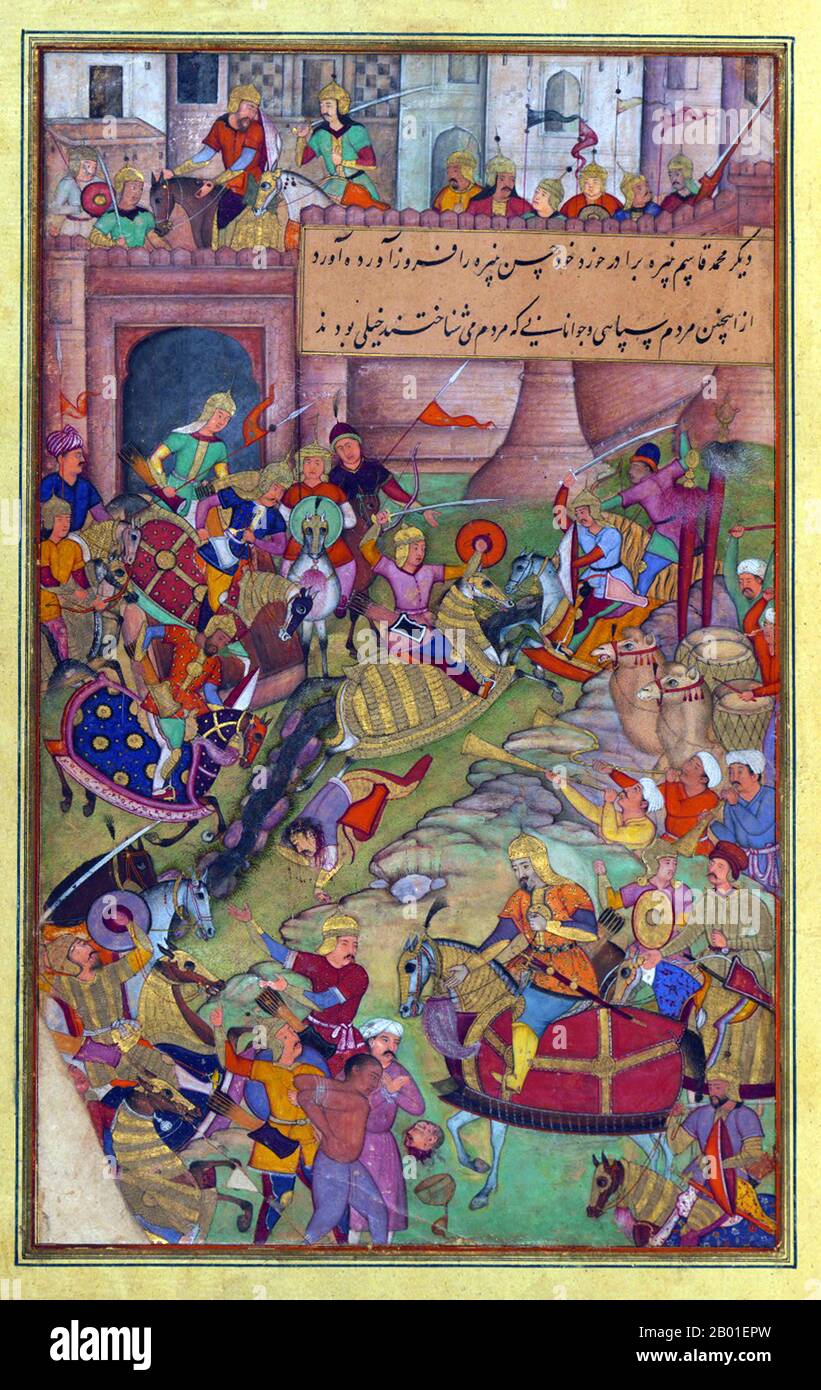 India: Zahir ud-din Muhammad Babur (1483-1530), the first Mughal Emperor, captures the city of Samarkand. Miniature painting from the Baburnama, late 16th century. Bāburnāma (literally: 'Book of Babur' or 'Letters of Babur'; alternatively known as Tuzk-e Babri) is the name given to the memoirs of Ẓahīr ud-Dīn Muḥammad Bābur, founder of the Mughal Empire and a great-great-great-grandson of Timur. It is an autobiographical work, originally written in the Chagatai language, known to Babur as 'Turki' (meaning Turkic), the spoken language of the Andijan-Timurids. Stock Photohttps://www.alamy.com/image-license-details/?v=1https://www.alamy.com/india-zahir-ud-din-muhammad-babur-1483-1530-the-first-mughal-emperor-captures-the-city-of-samarkand-miniature-painting-from-the-baburnama-late-16th-century-bburnma-literally-book-of-babur-or-letters-of-babur-alternatively-known-as-tuzk-e-babri-is-the-name-given-to-the-memoirs-of-ahr-ud-dn-muammad-bbur-founder-of-the-mughal-empire-and-a-great-great-great-grandson-of-timur-it-is-an-autobiographical-work-originally-written-in-the-chagatai-language-known-to-babur-as-turki-meaning-turkic-the-spoken-language-of-the-andijan-timurids-image344240929.html
India: Zahir ud-din Muhammad Babur (1483-1530), the first Mughal Emperor, captures the city of Samarkand. Miniature painting from the Baburnama, late 16th century. Bāburnāma (literally: 'Book of Babur' or 'Letters of Babur'; alternatively known as Tuzk-e Babri) is the name given to the memoirs of Ẓahīr ud-Dīn Muḥammad Bābur, founder of the Mughal Empire and a great-great-great-grandson of Timur. It is an autobiographical work, originally written in the Chagatai language, known to Babur as 'Turki' (meaning Turkic), the spoken language of the Andijan-Timurids. Stock Photohttps://www.alamy.com/image-license-details/?v=1https://www.alamy.com/india-zahir-ud-din-muhammad-babur-1483-1530-the-first-mughal-emperor-captures-the-city-of-samarkand-miniature-painting-from-the-baburnama-late-16th-century-bburnma-literally-book-of-babur-or-letters-of-babur-alternatively-known-as-tuzk-e-babri-is-the-name-given-to-the-memoirs-of-ahr-ud-dn-muammad-bbur-founder-of-the-mughal-empire-and-a-great-great-great-grandson-of-timur-it-is-an-autobiographical-work-originally-written-in-the-chagatai-language-known-to-babur-as-turki-meaning-turkic-the-spoken-language-of-the-andijan-timurids-image344240929.htmlRM2B01EPW–India: Zahir ud-din Muhammad Babur (1483-1530), the first Mughal Emperor, captures the city of Samarkand. Miniature painting from the Baburnama, late 16th century. Bāburnāma (literally: 'Book of Babur' or 'Letters of Babur'; alternatively known as Tuzk-e Babri) is the name given to the memoirs of Ẓahīr ud-Dīn Muḥammad Bābur, founder of the Mughal Empire and a great-great-great-grandson of Timur. It is an autobiographical work, originally written in the Chagatai language, known to Babur as 'Turki' (meaning Turkic), the spoken language of the Andijan-Timurids.
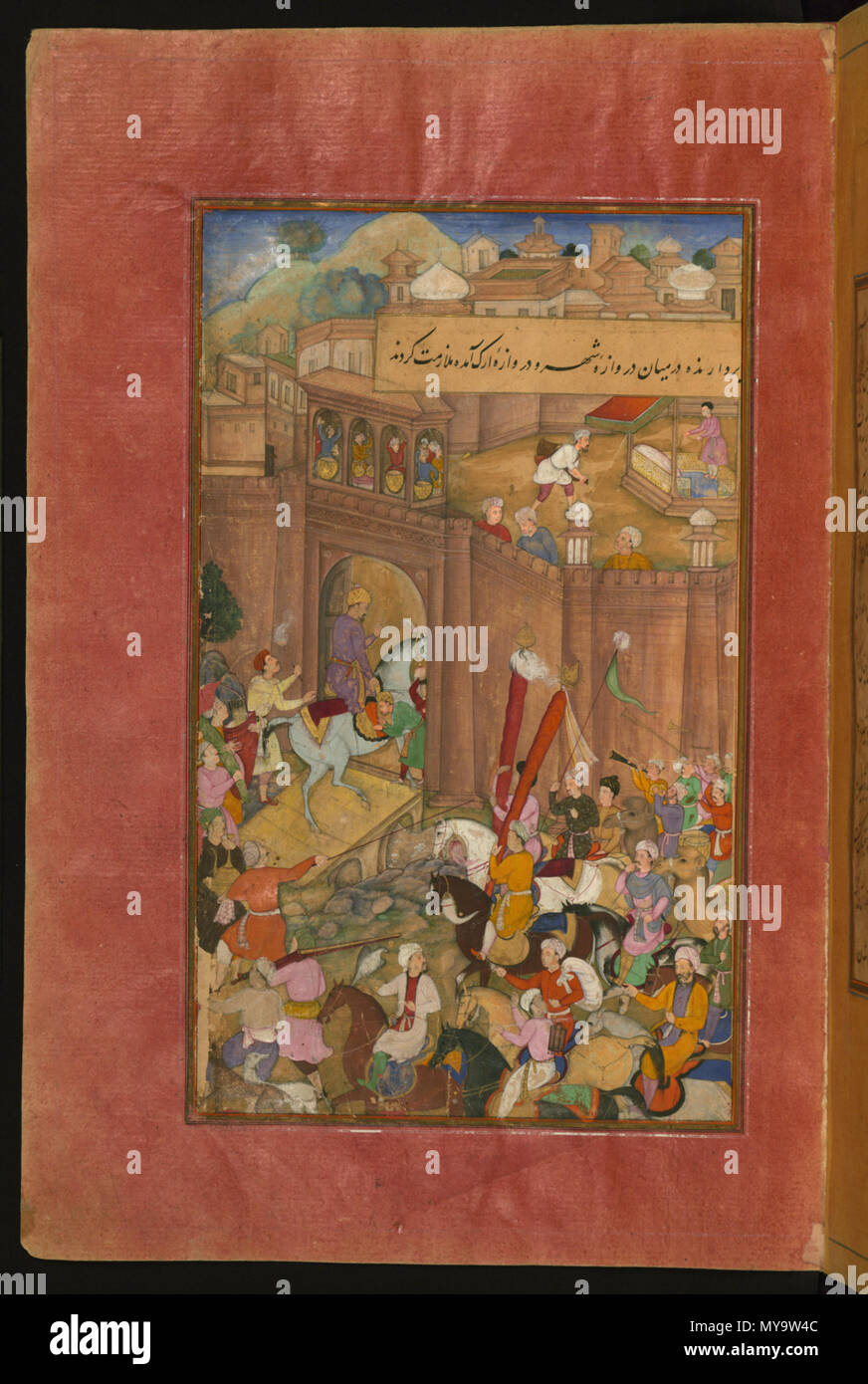 . English: Illustrations from the Manuscript of Baburnama (Memoirs of Babur) - Late 16th Century Bāburnāma is the memoirs of Ẓahīr ud-Dīn Muḥammad Bābur (1483-1530), founder of the Mughal Empire and a great-great-great-grandson of Timur. It is an autobiographical work, originally written in the Chagatai language, known to Babur as 'Turki' (meaning Turkic), the spoken language of the Andijan-Timurids. Because of Babur's cultural origin, his prose is highly Persianized in its sentence structure, morphology, and vocabulary,and also contains many phrases and smaller poems in Persian. During Empero Stock Photohttps://www.alamy.com/image-license-details/?v=1https://www.alamy.com/english-illustrations-from-the-manuscript-of-baburnama-memoirs-of-babur-late-16th-century-bburnma-is-the-memoirs-of-ahr-ud-dn-muammad-bbur-1483-1530-founder-of-the-mughal-empire-and-a-great-great-great-grandson-of-timur-it-is-an-autobiographical-work-originally-written-in-the-chagatai-language-known-to-babur-as-turki-meaning-turkic-the-spoken-language-of-the-andijan-timurids-because-of-baburs-cultural-origin-his-prose-is-highly-persianized-in-its-sentence-structure-morphology-and-vocabularyand-also-contains-many-phrases-and-smaller-poems-in-persian-during-empero-image188916684.html
. English: Illustrations from the Manuscript of Baburnama (Memoirs of Babur) - Late 16th Century Bāburnāma is the memoirs of Ẓahīr ud-Dīn Muḥammad Bābur (1483-1530), founder of the Mughal Empire and a great-great-great-grandson of Timur. It is an autobiographical work, originally written in the Chagatai language, known to Babur as 'Turki' (meaning Turkic), the spoken language of the Andijan-Timurids. Because of Babur's cultural origin, his prose is highly Persianized in its sentence structure, morphology, and vocabulary,and also contains many phrases and smaller poems in Persian. During Empero Stock Photohttps://www.alamy.com/image-license-details/?v=1https://www.alamy.com/english-illustrations-from-the-manuscript-of-baburnama-memoirs-of-babur-late-16th-century-bburnma-is-the-memoirs-of-ahr-ud-dn-muammad-bbur-1483-1530-founder-of-the-mughal-empire-and-a-great-great-great-grandson-of-timur-it-is-an-autobiographical-work-originally-written-in-the-chagatai-language-known-to-babur-as-turki-meaning-turkic-the-spoken-language-of-the-andijan-timurids-because-of-baburs-cultural-origin-his-prose-is-highly-persianized-in-its-sentence-structure-morphology-and-vocabularyand-also-contains-many-phrases-and-smaller-poems-in-persian-during-empero-image188916684.htmlRMMY9W4C–. English: Illustrations from the Manuscript of Baburnama (Memoirs of Babur) - Late 16th Century Bāburnāma is the memoirs of Ẓahīr ud-Dīn Muḥammad Bābur (1483-1530), founder of the Mughal Empire and a great-great-great-grandson of Timur. It is an autobiographical work, originally written in the Chagatai language, known to Babur as 'Turki' (meaning Turkic), the spoken language of the Andijan-Timurids. Because of Babur's cultural origin, his prose is highly Persianized in its sentence structure, morphology, and vocabulary,and also contains many phrases and smaller poems in Persian. During Empero
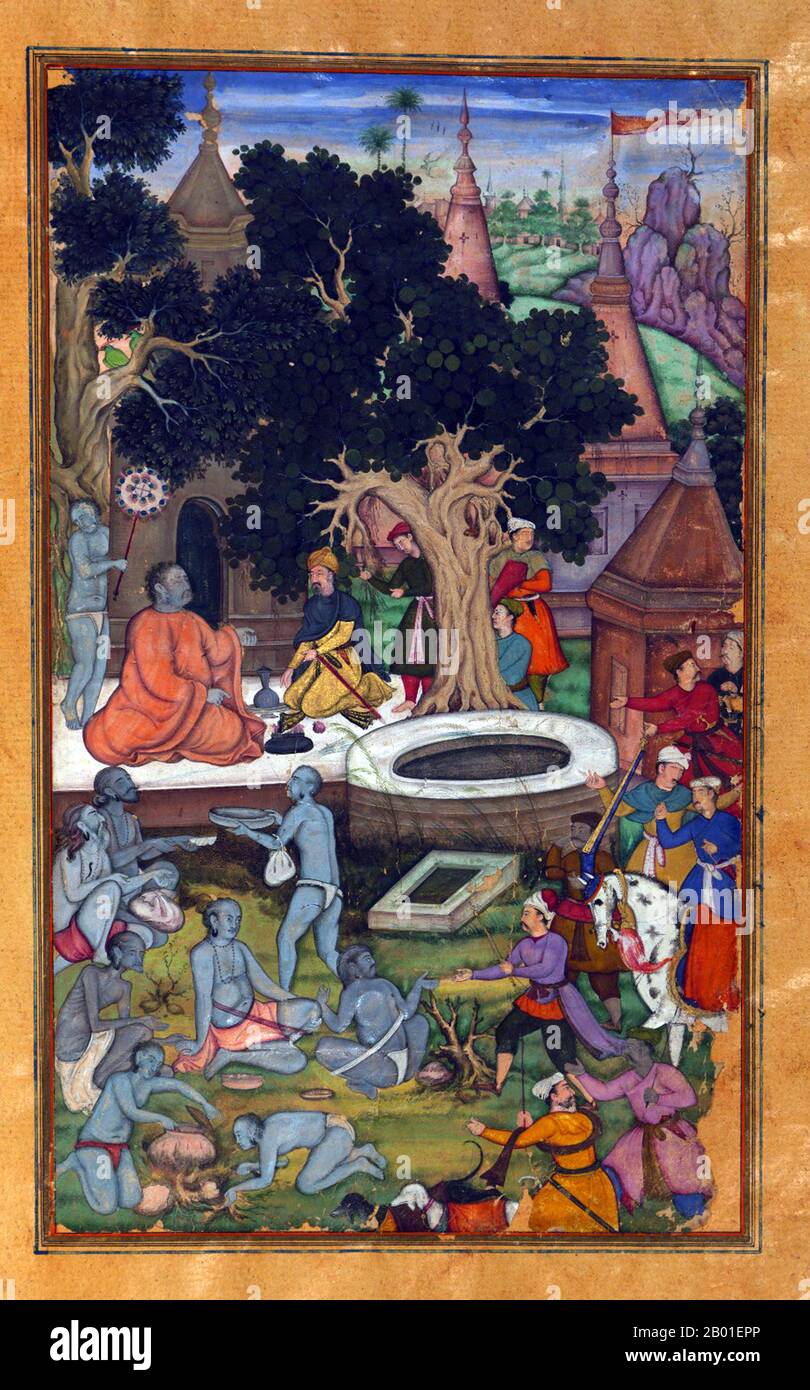 India: Babur and his warriors visiting the Hindu temple Gurh Kattri (Kūr Katrī) in Bigram. Miniature painting from the Baburnama, late 16th century. Bāburnāma (literally: 'Book of Babur' or 'Letters of Babur'; alternatively known as Tuzk-e Babri) is the name given to the memoirs of Ẓahīr ud-Dīn Muḥammad Bābur (1483-1530), founder of the Mughal Empire and a great-great-great-grandson of Timur. It is an autobiographical work, originally written in the Chagatai language, known to Babur as 'Turki' (meaning Turkic), the spoken language of the Andijan-Timurids. Stock Photohttps://www.alamy.com/image-license-details/?v=1https://www.alamy.com/india-babur-and-his-warriors-visiting-the-hindu-temple-gurh-kattri-kr-katr-in-bigram-miniature-painting-from-the-baburnama-late-16th-century-bburnma-literally-book-of-babur-or-letters-of-babur-alternatively-known-as-tuzk-e-babri-is-the-name-given-to-the-memoirs-of-ahr-ud-dn-muammad-bbur-1483-1530-founder-of-the-mughal-empire-and-a-great-great-great-grandson-of-timur-it-is-an-autobiographical-work-originally-written-in-the-chagatai-language-known-to-babur-as-turki-meaning-turkic-the-spoken-language-of-the-andijan-timurids-image344240926.html
India: Babur and his warriors visiting the Hindu temple Gurh Kattri (Kūr Katrī) in Bigram. Miniature painting from the Baburnama, late 16th century. Bāburnāma (literally: 'Book of Babur' or 'Letters of Babur'; alternatively known as Tuzk-e Babri) is the name given to the memoirs of Ẓahīr ud-Dīn Muḥammad Bābur (1483-1530), founder of the Mughal Empire and a great-great-great-grandson of Timur. It is an autobiographical work, originally written in the Chagatai language, known to Babur as 'Turki' (meaning Turkic), the spoken language of the Andijan-Timurids. Stock Photohttps://www.alamy.com/image-license-details/?v=1https://www.alamy.com/india-babur-and-his-warriors-visiting-the-hindu-temple-gurh-kattri-kr-katr-in-bigram-miniature-painting-from-the-baburnama-late-16th-century-bburnma-literally-book-of-babur-or-letters-of-babur-alternatively-known-as-tuzk-e-babri-is-the-name-given-to-the-memoirs-of-ahr-ud-dn-muammad-bbur-1483-1530-founder-of-the-mughal-empire-and-a-great-great-great-grandson-of-timur-it-is-an-autobiographical-work-originally-written-in-the-chagatai-language-known-to-babur-as-turki-meaning-turkic-the-spoken-language-of-the-andijan-timurids-image344240926.htmlRM2B01EPP–India: Babur and his warriors visiting the Hindu temple Gurh Kattri (Kūr Katrī) in Bigram. Miniature painting from the Baburnama, late 16th century. Bāburnāma (literally: 'Book of Babur' or 'Letters of Babur'; alternatively known as Tuzk-e Babri) is the name given to the memoirs of Ẓahīr ud-Dīn Muḥammad Bābur (1483-1530), founder of the Mughal Empire and a great-great-great-grandson of Timur. It is an autobiographical work, originally written in the Chagatai language, known to Babur as 'Turki' (meaning Turkic), the spoken language of the Andijan-Timurids.
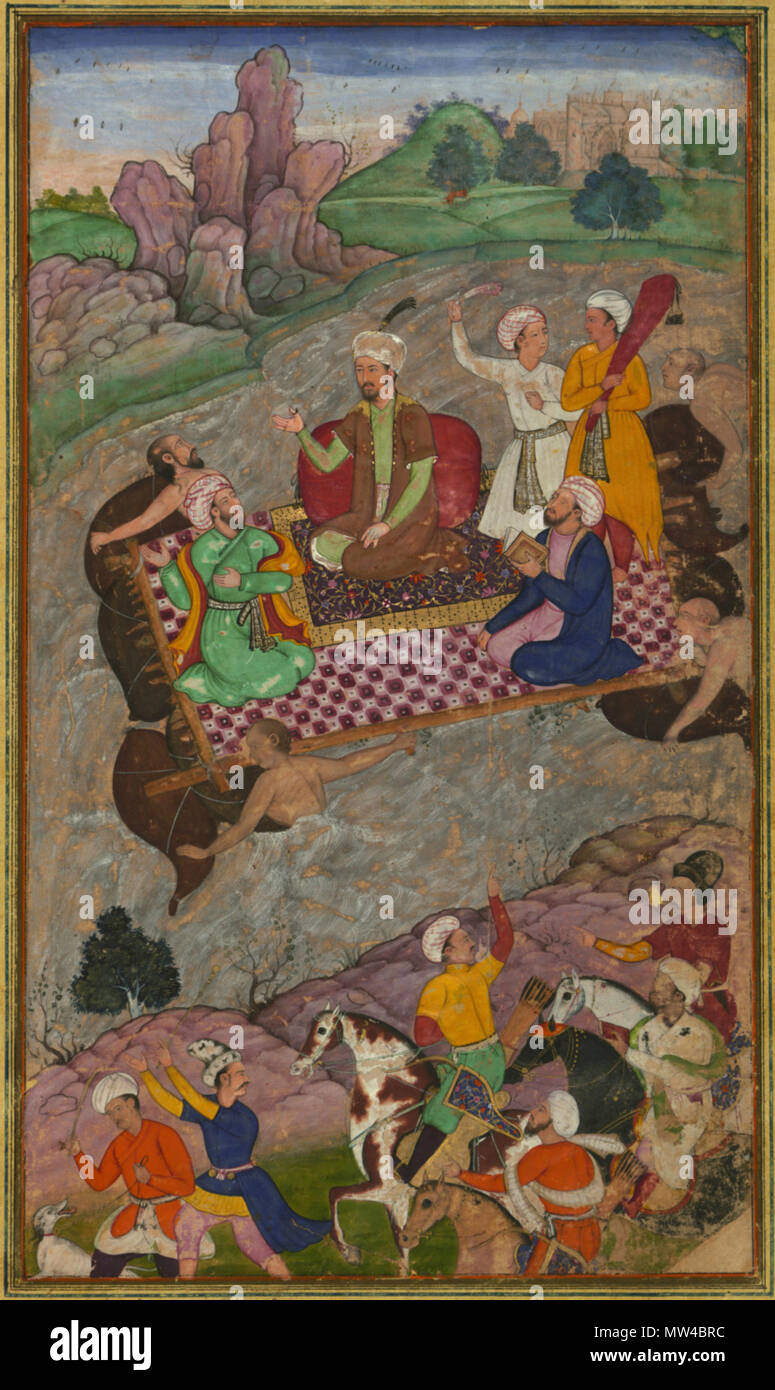 . English: Illustrations from the Manuscript of Baburnama (Memoirs of Babur) - Late 16th Century Bāburnāma is the memoirs of Ẓahīr ud-Dīn Muḥammad Bābur (1483-1530), founder of the Mughal Empire and a great-great-great-grandson of Timur. It is an autobiographical work, originally written in the Chagatai language, known to Babur as 'Turki' (meaning Turkic), the spoken language of the Andijan-Timurids. Because of Babur's cultural origin, his prose is highly Persianized in its sentence structure, morphology, and vocabulary,and also contains many phrases and smaller poems in Persian. During Empero Stock Photohttps://www.alamy.com/image-license-details/?v=1https://www.alamy.com/english-illustrations-from-the-manuscript-of-baburnama-memoirs-of-babur-late-16th-century-bburnma-is-the-memoirs-of-ahr-ud-dn-muammad-bbur-1483-1530-founder-of-the-mughal-empire-and-a-great-great-great-grandson-of-timur-it-is-an-autobiographical-work-originally-written-in-the-chagatai-language-known-to-babur-as-turki-meaning-turkic-the-spoken-language-of-the-andijan-timurids-because-of-baburs-cultural-origin-his-prose-is-highly-persianized-in-its-sentence-structure-morphology-and-vocabularyand-also-contains-many-phrases-and-smaller-poems-in-persian-during-empero-image187567168.html
. English: Illustrations from the Manuscript of Baburnama (Memoirs of Babur) - Late 16th Century Bāburnāma is the memoirs of Ẓahīr ud-Dīn Muḥammad Bābur (1483-1530), founder of the Mughal Empire and a great-great-great-grandson of Timur. It is an autobiographical work, originally written in the Chagatai language, known to Babur as 'Turki' (meaning Turkic), the spoken language of the Andijan-Timurids. Because of Babur's cultural origin, his prose is highly Persianized in its sentence structure, morphology, and vocabulary,and also contains many phrases and smaller poems in Persian. During Empero Stock Photohttps://www.alamy.com/image-license-details/?v=1https://www.alamy.com/english-illustrations-from-the-manuscript-of-baburnama-memoirs-of-babur-late-16th-century-bburnma-is-the-memoirs-of-ahr-ud-dn-muammad-bbur-1483-1530-founder-of-the-mughal-empire-and-a-great-great-great-grandson-of-timur-it-is-an-autobiographical-work-originally-written-in-the-chagatai-language-known-to-babur-as-turki-meaning-turkic-the-spoken-language-of-the-andijan-timurids-because-of-baburs-cultural-origin-his-prose-is-highly-persianized-in-its-sentence-structure-morphology-and-vocabularyand-also-contains-many-phrases-and-smaller-poems-in-persian-during-empero-image187567168.htmlRMMW4BRC–. English: Illustrations from the Manuscript of Baburnama (Memoirs of Babur) - Late 16th Century Bāburnāma is the memoirs of Ẓahīr ud-Dīn Muḥammad Bābur (1483-1530), founder of the Mughal Empire and a great-great-great-grandson of Timur. It is an autobiographical work, originally written in the Chagatai language, known to Babur as 'Turki' (meaning Turkic), the spoken language of the Andijan-Timurids. Because of Babur's cultural origin, his prose is highly Persianized in its sentence structure, morphology, and vocabulary,and also contains many phrases and smaller poems in Persian. During Empero
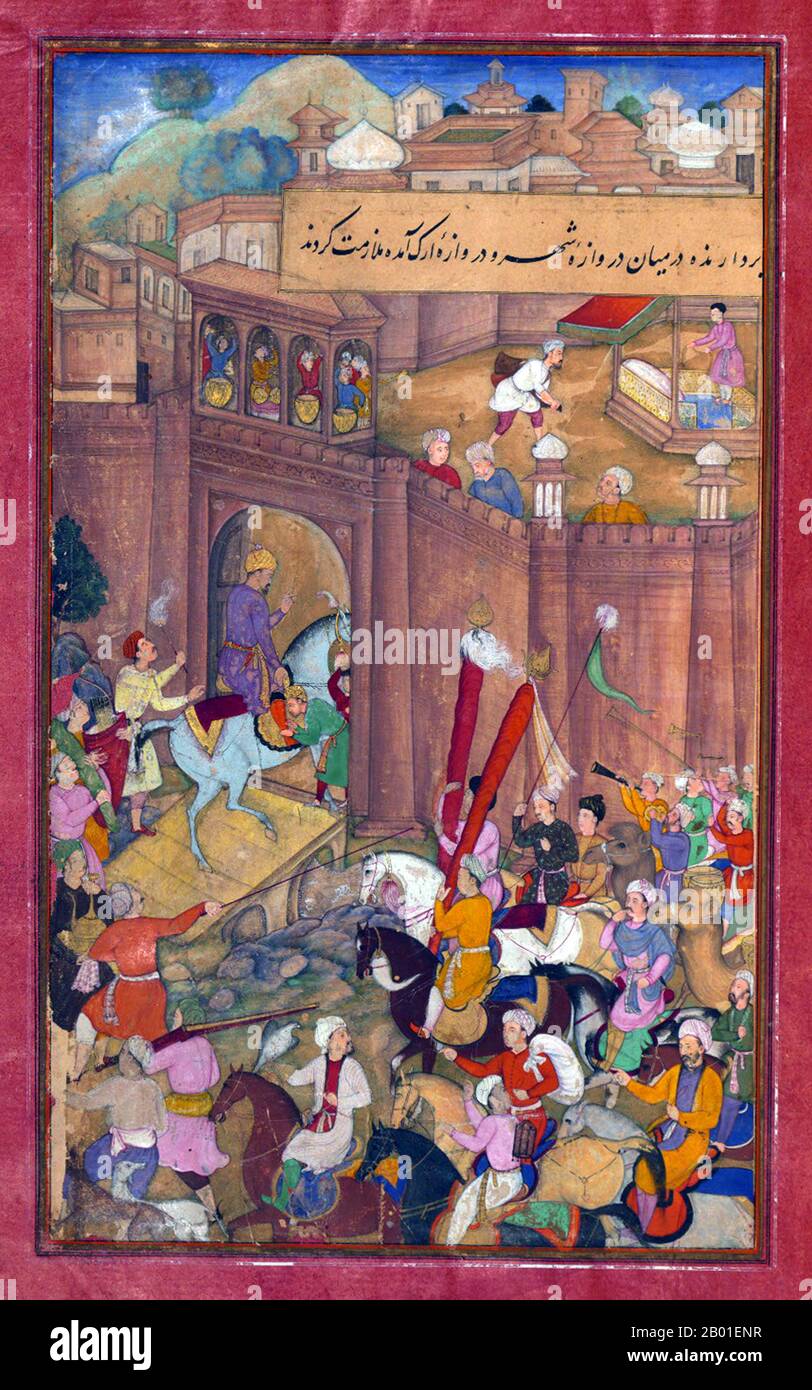 India: Zahir ud-din Muhammad Babur (1483-1530) the first Mughal Emperor, is welcomed to Kabul by Qāsim Beg, the city qadi, along with his retinue. Miniature painting from the Baburnama, late 16th century. Bāburnāma (literally: 'Book of Babur' or 'Letters of Babur'; alternatively known as Tuzk-e Babri) is the name given to the memoirs of Ẓahīr ud-Dīn Muḥammad Bābur, founder of the Mughal Empire and a great-great-great-grandson of Timur. It is an autobiographical work, originally written in the Chagatai language, known to Babur as 'Turki' (meaning Turkic). Stock Photohttps://www.alamy.com/image-license-details/?v=1https://www.alamy.com/india-zahir-ud-din-muhammad-babur-1483-1530-the-first-mughal-emperor-is-welcomed-to-kabul-by-qsim-beg-the-city-qadi-along-with-his-retinue-miniature-painting-from-the-baburnama-late-16th-century-bburnma-literally-book-of-babur-or-letters-of-babur-alternatively-known-as-tuzk-e-babri-is-the-name-given-to-the-memoirs-of-ahr-ud-dn-muammad-bbur-founder-of-the-mughal-empire-and-a-great-great-great-grandson-of-timur-it-is-an-autobiographical-work-originally-written-in-the-chagatai-language-known-to-babur-as-turki-meaning-turkic-image344240899.html
India: Zahir ud-din Muhammad Babur (1483-1530) the first Mughal Emperor, is welcomed to Kabul by Qāsim Beg, the city qadi, along with his retinue. Miniature painting from the Baburnama, late 16th century. Bāburnāma (literally: 'Book of Babur' or 'Letters of Babur'; alternatively known as Tuzk-e Babri) is the name given to the memoirs of Ẓahīr ud-Dīn Muḥammad Bābur, founder of the Mughal Empire and a great-great-great-grandson of Timur. It is an autobiographical work, originally written in the Chagatai language, known to Babur as 'Turki' (meaning Turkic). Stock Photohttps://www.alamy.com/image-license-details/?v=1https://www.alamy.com/india-zahir-ud-din-muhammad-babur-1483-1530-the-first-mughal-emperor-is-welcomed-to-kabul-by-qsim-beg-the-city-qadi-along-with-his-retinue-miniature-painting-from-the-baburnama-late-16th-century-bburnma-literally-book-of-babur-or-letters-of-babur-alternatively-known-as-tuzk-e-babri-is-the-name-given-to-the-memoirs-of-ahr-ud-dn-muammad-bbur-founder-of-the-mughal-empire-and-a-great-great-great-grandson-of-timur-it-is-an-autobiographical-work-originally-written-in-the-chagatai-language-known-to-babur-as-turki-meaning-turkic-image344240899.htmlRM2B01ENR–India: Zahir ud-din Muhammad Babur (1483-1530) the first Mughal Emperor, is welcomed to Kabul by Qāsim Beg, the city qadi, along with his retinue. Miniature painting from the Baburnama, late 16th century. Bāburnāma (literally: 'Book of Babur' or 'Letters of Babur'; alternatively known as Tuzk-e Babri) is the name given to the memoirs of Ẓahīr ud-Dīn Muḥammad Bābur, founder of the Mughal Empire and a great-great-great-grandson of Timur. It is an autobiographical work, originally written in the Chagatai language, known to Babur as 'Turki' (meaning Turkic).
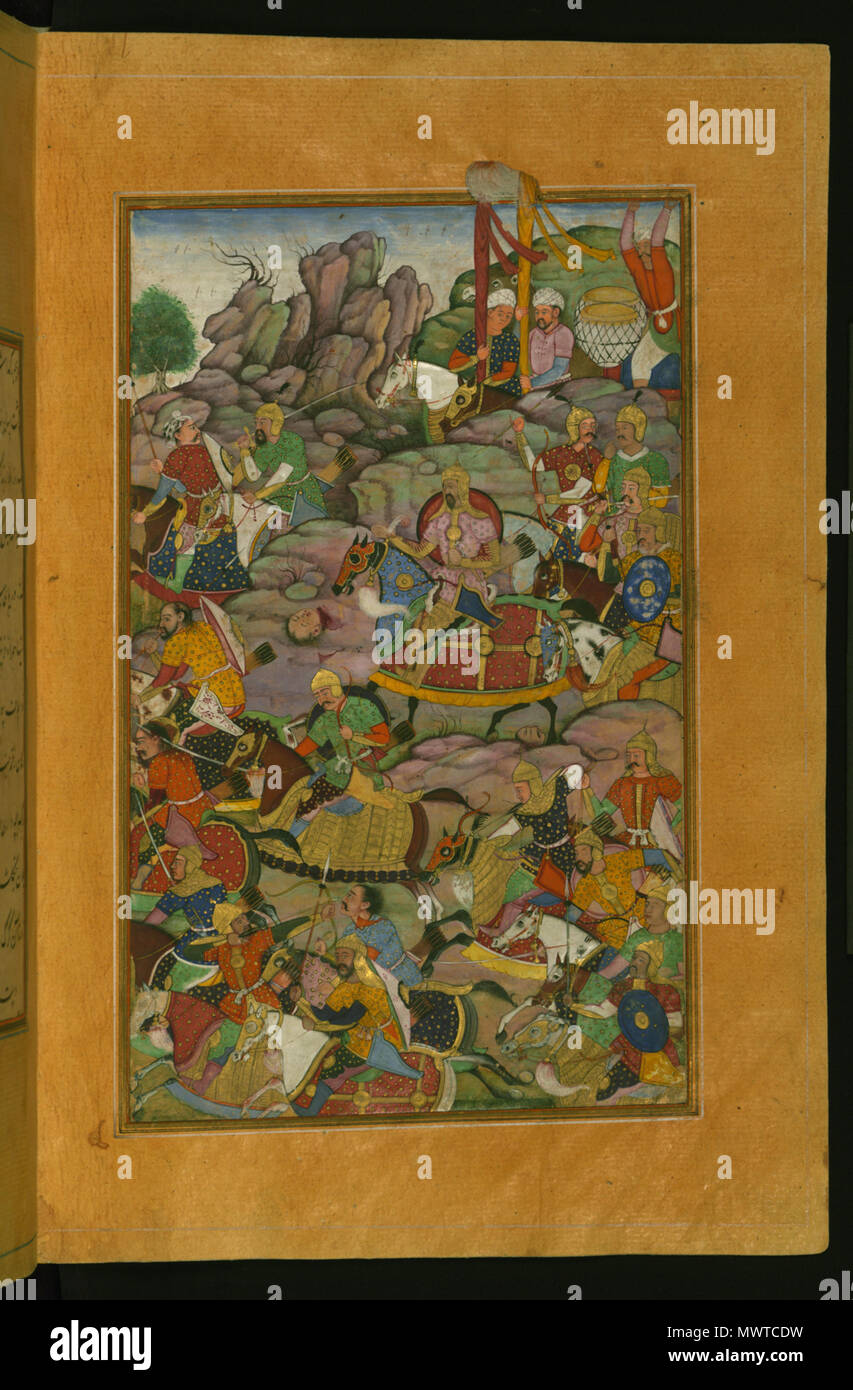 . English: Illustrations from the Manuscript of Baburnama (Memoirs of Babur) - Late 16th Century Bāburnāma is the memoirs of Ẓahīr ud-Dīn Muḥammad Bābur (1483-1530), founder of the Mughal Empire and a great-great-great-grandson of Timur. It is an autobiographical work, originally written in the Chagatai language, known to Babur as 'Turki' (meaning Turkic), the spoken language of the Andijan-Timurids. Because of Babur's cultural origin, his prose is highly Persianized in its sentence structure, morphology, and vocabulary,and also contains many phrases and smaller poems in Persian. During Empero Stock Photohttps://www.alamy.com/image-license-details/?v=1https://www.alamy.com/english-illustrations-from-the-manuscript-of-baburnama-memoirs-of-babur-late-16th-century-bburnma-is-the-memoirs-of-ahr-ud-dn-muammad-bbur-1483-1530-founder-of-the-mughal-empire-and-a-great-great-great-grandson-of-timur-it-is-an-autobiographical-work-originally-written-in-the-chagatai-language-known-to-babur-as-turki-meaning-turkic-the-spoken-language-of-the-andijan-timurids-because-of-baburs-cultural-origin-his-prose-is-highly-persianized-in-its-sentence-structure-morphology-and-vocabularyand-also-contains-many-phrases-and-smaller-poems-in-persian-during-empero-image188006725.html
. English: Illustrations from the Manuscript of Baburnama (Memoirs of Babur) - Late 16th Century Bāburnāma is the memoirs of Ẓahīr ud-Dīn Muḥammad Bābur (1483-1530), founder of the Mughal Empire and a great-great-great-grandson of Timur. It is an autobiographical work, originally written in the Chagatai language, known to Babur as 'Turki' (meaning Turkic), the spoken language of the Andijan-Timurids. Because of Babur's cultural origin, his prose is highly Persianized in its sentence structure, morphology, and vocabulary,and also contains many phrases and smaller poems in Persian. During Empero Stock Photohttps://www.alamy.com/image-license-details/?v=1https://www.alamy.com/english-illustrations-from-the-manuscript-of-baburnama-memoirs-of-babur-late-16th-century-bburnma-is-the-memoirs-of-ahr-ud-dn-muammad-bbur-1483-1530-founder-of-the-mughal-empire-and-a-great-great-great-grandson-of-timur-it-is-an-autobiographical-work-originally-written-in-the-chagatai-language-known-to-babur-as-turki-meaning-turkic-the-spoken-language-of-the-andijan-timurids-because-of-baburs-cultural-origin-his-prose-is-highly-persianized-in-its-sentence-structure-morphology-and-vocabularyand-also-contains-many-phrases-and-smaller-poems-in-persian-during-empero-image188006725.htmlRMMWTCDW–. English: Illustrations from the Manuscript of Baburnama (Memoirs of Babur) - Late 16th Century Bāburnāma is the memoirs of Ẓahīr ud-Dīn Muḥammad Bābur (1483-1530), founder of the Mughal Empire and a great-great-great-grandson of Timur. It is an autobiographical work, originally written in the Chagatai language, known to Babur as 'Turki' (meaning Turkic), the spoken language of the Andijan-Timurids. Because of Babur's cultural origin, his prose is highly Persianized in its sentence structure, morphology, and vocabulary,and also contains many phrases and smaller poems in Persian. During Empero
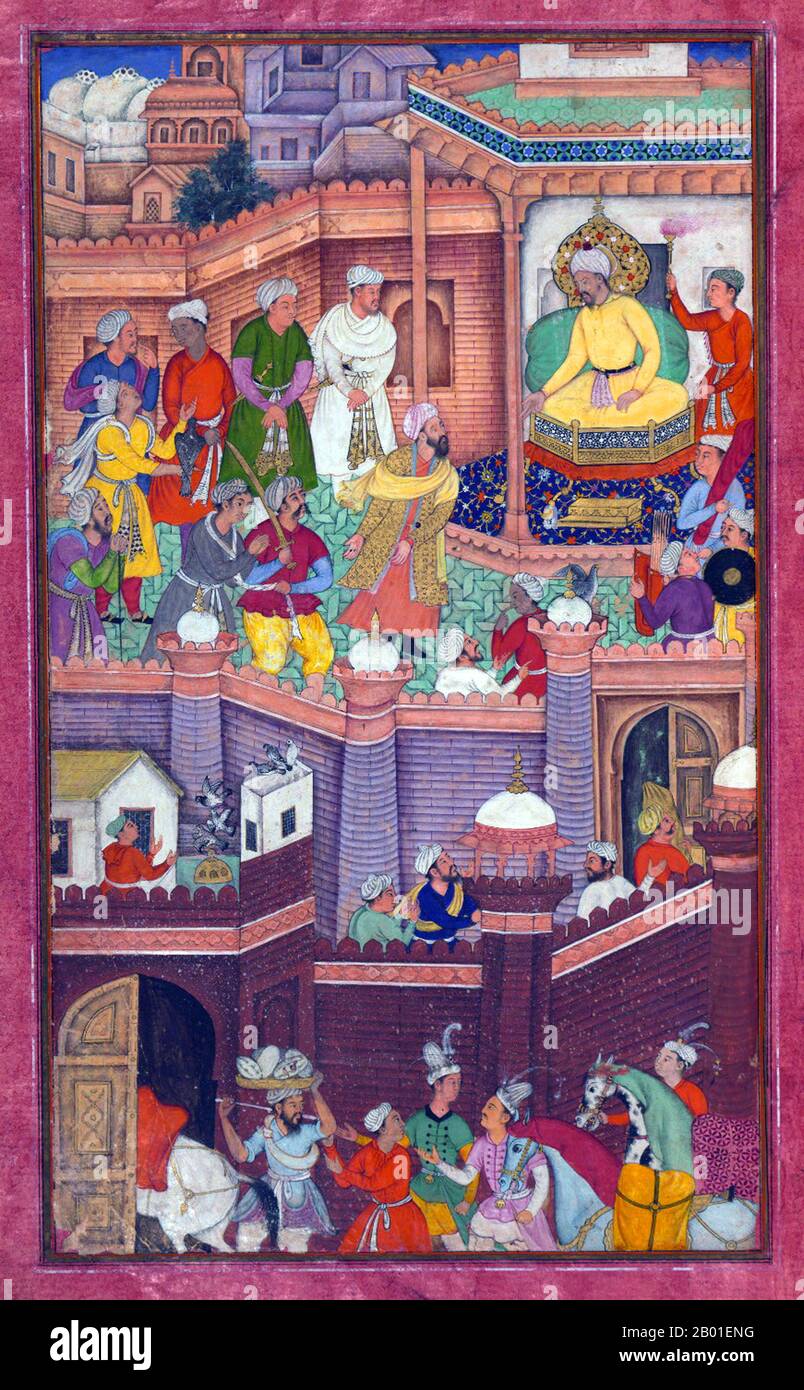 India: Despite his treachery, Muḥammad Ḥusaym Mīrzā, a relative of Babur, is being released and sent to Khurāsān. Miniature painting from the Baburnama, late 16th century. Bāburnāma (literally: 'Book of Babur' or 'Letters of Babur'; alternatively known as Tuzk-e Babri) is the name given to the memoirs of Ẓahīr ud-Dīn Muḥammad Bābur (1483-1530), founder of the Mughal Empire and a great-great-great-grandson of Timur. It is an autobiographical work, originally written in the Chagatai language, known to Babur as 'Turki' (meaning Turkic), the spoken language of the Andijan-Timurids. Stock Photohttps://www.alamy.com/image-license-details/?v=1https://www.alamy.com/india-despite-his-treachery-muammad-usaym-mrz-a-relative-of-babur-is-being-released-and-sent-to-khursn-miniature-painting-from-the-baburnama-late-16th-century-bburnma-literally-book-of-babur-or-letters-of-babur-alternatively-known-as-tuzk-e-babri-is-the-name-given-to-the-memoirs-of-ahr-ud-dn-muammad-bbur-1483-1530-founder-of-the-mughal-empire-and-a-great-great-great-grandson-of-timur-it-is-an-autobiographical-work-originally-written-in-the-chagatai-language-known-to-babur-as-turki-meaning-turkic-the-spoken-language-of-the-andijan-timurids-image344240892.html
India: Despite his treachery, Muḥammad Ḥusaym Mīrzā, a relative of Babur, is being released and sent to Khurāsān. Miniature painting from the Baburnama, late 16th century. Bāburnāma (literally: 'Book of Babur' or 'Letters of Babur'; alternatively known as Tuzk-e Babri) is the name given to the memoirs of Ẓahīr ud-Dīn Muḥammad Bābur (1483-1530), founder of the Mughal Empire and a great-great-great-grandson of Timur. It is an autobiographical work, originally written in the Chagatai language, known to Babur as 'Turki' (meaning Turkic), the spoken language of the Andijan-Timurids. Stock Photohttps://www.alamy.com/image-license-details/?v=1https://www.alamy.com/india-despite-his-treachery-muammad-usaym-mrz-a-relative-of-babur-is-being-released-and-sent-to-khursn-miniature-painting-from-the-baburnama-late-16th-century-bburnma-literally-book-of-babur-or-letters-of-babur-alternatively-known-as-tuzk-e-babri-is-the-name-given-to-the-memoirs-of-ahr-ud-dn-muammad-bbur-1483-1530-founder-of-the-mughal-empire-and-a-great-great-great-grandson-of-timur-it-is-an-autobiographical-work-originally-written-in-the-chagatai-language-known-to-babur-as-turki-meaning-turkic-the-spoken-language-of-the-andijan-timurids-image344240892.htmlRM2B01ENG–India: Despite his treachery, Muḥammad Ḥusaym Mīrzā, a relative of Babur, is being released and sent to Khurāsān. Miniature painting from the Baburnama, late 16th century. Bāburnāma (literally: 'Book of Babur' or 'Letters of Babur'; alternatively known as Tuzk-e Babri) is the name given to the memoirs of Ẓahīr ud-Dīn Muḥammad Bābur (1483-1530), founder of the Mughal Empire and a great-great-great-grandson of Timur. It is an autobiographical work, originally written in the Chagatai language, known to Babur as 'Turki' (meaning Turkic), the spoken language of the Andijan-Timurids.
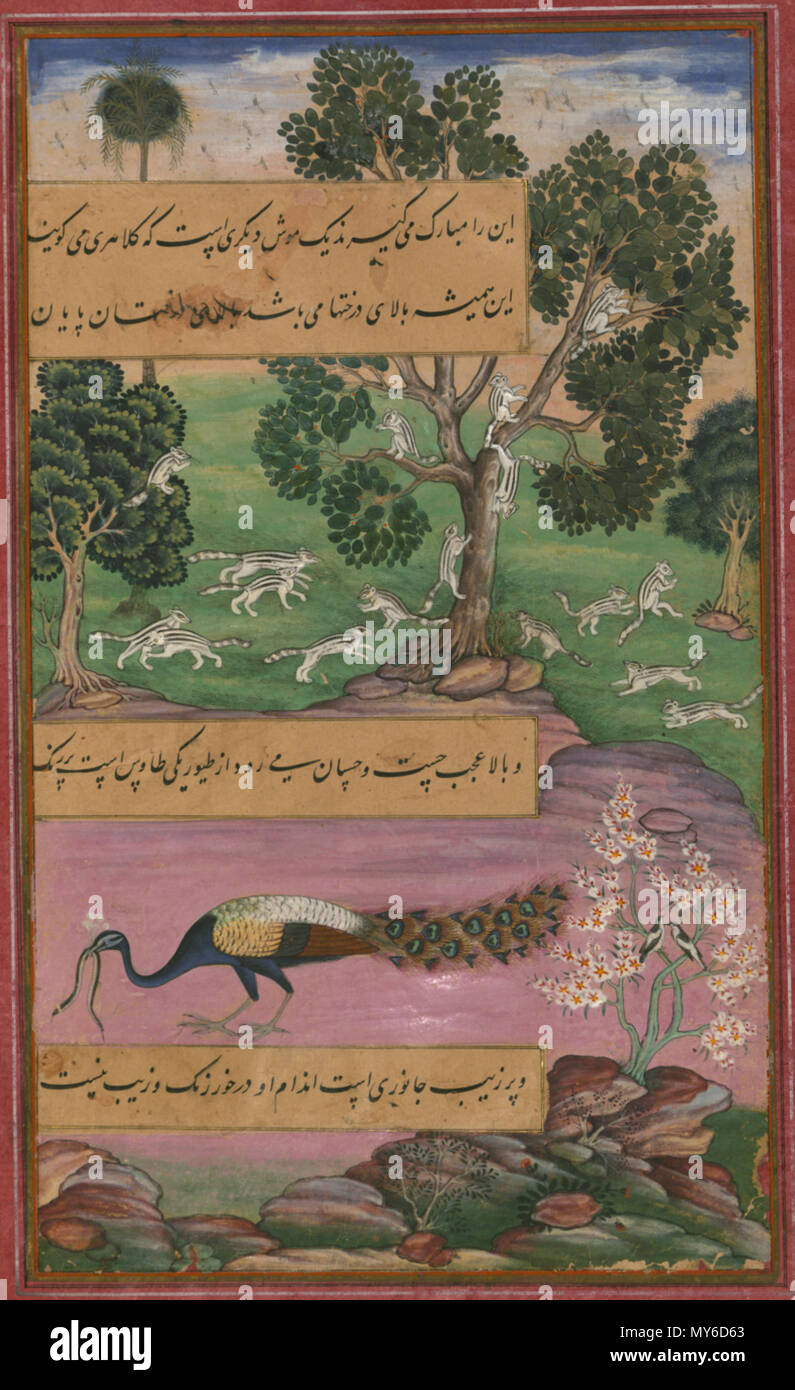 . English: Illustrations from the Manuscript of Baburnama (Memoirs of Babur) - Late 16th Century Bāburnāma is the memoirs of Ẓahīr ud-Dīn Muḥammad Bābur (1483-1530), founder of the Mughal Empire and a great-great-great-grandson of Timur. It is an autobiographical work, originally written in the Chagatai language, known to Babur as 'Turki' (meaning Turkic), the spoken language of the Andijan-Timurids. Because of Babur's cultural origin, his prose is highly Persianized in its sentence structure, morphology, and vocabulary,and also contains many phrases and smaller poems in Persian. During Empero Stock Photohttps://www.alamy.com/image-license-details/?v=1https://www.alamy.com/english-illustrations-from-the-manuscript-of-baburnama-memoirs-of-babur-late-16th-century-bburnma-is-the-memoirs-of-ahr-ud-dn-muammad-bbur-1483-1530-founder-of-the-mughal-empire-and-a-great-great-great-grandson-of-timur-it-is-an-autobiographical-work-originally-written-in-the-chagatai-language-known-to-babur-as-turki-meaning-turkic-the-spoken-language-of-the-andijan-timurids-because-of-baburs-cultural-origin-his-prose-is-highly-persianized-in-its-sentence-structure-morphology-and-vocabularyand-also-contains-many-phrases-and-smaller-poems-in-persian-during-empero-image188841467.html
. English: Illustrations from the Manuscript of Baburnama (Memoirs of Babur) - Late 16th Century Bāburnāma is the memoirs of Ẓahīr ud-Dīn Muḥammad Bābur (1483-1530), founder of the Mughal Empire and a great-great-great-grandson of Timur. It is an autobiographical work, originally written in the Chagatai language, known to Babur as 'Turki' (meaning Turkic), the spoken language of the Andijan-Timurids. Because of Babur's cultural origin, his prose is highly Persianized in its sentence structure, morphology, and vocabulary,and also contains many phrases and smaller poems in Persian. During Empero Stock Photohttps://www.alamy.com/image-license-details/?v=1https://www.alamy.com/english-illustrations-from-the-manuscript-of-baburnama-memoirs-of-babur-late-16th-century-bburnma-is-the-memoirs-of-ahr-ud-dn-muammad-bbur-1483-1530-founder-of-the-mughal-empire-and-a-great-great-great-grandson-of-timur-it-is-an-autobiographical-work-originally-written-in-the-chagatai-language-known-to-babur-as-turki-meaning-turkic-the-spoken-language-of-the-andijan-timurids-because-of-baburs-cultural-origin-his-prose-is-highly-persianized-in-its-sentence-structure-morphology-and-vocabularyand-also-contains-many-phrases-and-smaller-poems-in-persian-during-empero-image188841467.htmlRMMY6D63–. English: Illustrations from the Manuscript of Baburnama (Memoirs of Babur) - Late 16th Century Bāburnāma is the memoirs of Ẓahīr ud-Dīn Muḥammad Bābur (1483-1530), founder of the Mughal Empire and a great-great-great-grandson of Timur. It is an autobiographical work, originally written in the Chagatai language, known to Babur as 'Turki' (meaning Turkic), the spoken language of the Andijan-Timurids. Because of Babur's cultural origin, his prose is highly Persianized in its sentence structure, morphology, and vocabulary,and also contains many phrases and smaller poems in Persian. During Empero
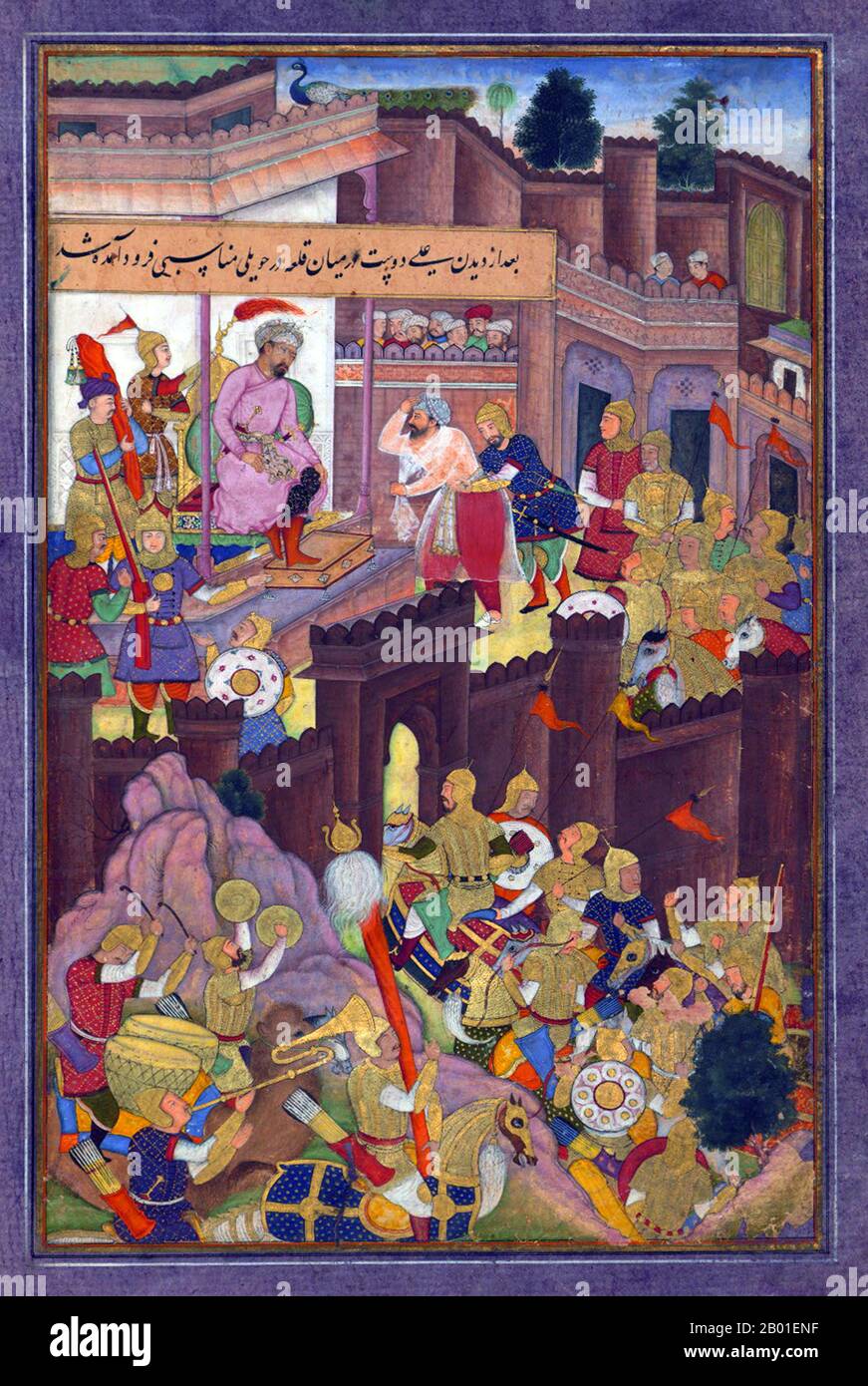 India: Having opened the gates of Murghīnān Fort, ʿAlī Dūst Ṭaghāyī pays homage to Babur. Miniature painting from the Baburnama, late 16th century. Bāburnāma (literally: 'Book of Babur' or 'Letters of Babur'; alternatively known as Tuzk-e Babri) is the name given to the memoirs of Ẓahīr ud-Dīn Muḥammad Bābur (1483-1530), founder of the Mughal Empire and a great-great-great-grandson of Timur. It is an autobiographical work, originally written in the Chagatai language, known to Babur as 'Turki' (meaning Turkic), the spoken language of the Andijan-Timurids. Stock Photohttps://www.alamy.com/image-license-details/?v=1https://www.alamy.com/india-having-opened-the-gates-of-murghnn-fort-al-dst-aghy-pays-homage-to-babur-miniature-painting-from-the-baburnama-late-16th-century-bburnma-literally-book-of-babur-or-letters-of-babur-alternatively-known-as-tuzk-e-babri-is-the-name-given-to-the-memoirs-of-ahr-ud-dn-muammad-bbur-1483-1530-founder-of-the-mughal-empire-and-a-great-great-great-grandson-of-timur-it-is-an-autobiographical-work-originally-written-in-the-chagatai-language-known-to-babur-as-turki-meaning-turkic-the-spoken-language-of-the-andijan-timurids-image344240891.html
India: Having opened the gates of Murghīnān Fort, ʿAlī Dūst Ṭaghāyī pays homage to Babur. Miniature painting from the Baburnama, late 16th century. Bāburnāma (literally: 'Book of Babur' or 'Letters of Babur'; alternatively known as Tuzk-e Babri) is the name given to the memoirs of Ẓahīr ud-Dīn Muḥammad Bābur (1483-1530), founder of the Mughal Empire and a great-great-great-grandson of Timur. It is an autobiographical work, originally written in the Chagatai language, known to Babur as 'Turki' (meaning Turkic), the spoken language of the Andijan-Timurids. Stock Photohttps://www.alamy.com/image-license-details/?v=1https://www.alamy.com/india-having-opened-the-gates-of-murghnn-fort-al-dst-aghy-pays-homage-to-babur-miniature-painting-from-the-baburnama-late-16th-century-bburnma-literally-book-of-babur-or-letters-of-babur-alternatively-known-as-tuzk-e-babri-is-the-name-given-to-the-memoirs-of-ahr-ud-dn-muammad-bbur-1483-1530-founder-of-the-mughal-empire-and-a-great-great-great-grandson-of-timur-it-is-an-autobiographical-work-originally-written-in-the-chagatai-language-known-to-babur-as-turki-meaning-turkic-the-spoken-language-of-the-andijan-timurids-image344240891.htmlRM2B01ENF–India: Having opened the gates of Murghīnān Fort, ʿAlī Dūst Ṭaghāyī pays homage to Babur. Miniature painting from the Baburnama, late 16th century. Bāburnāma (literally: 'Book of Babur' or 'Letters of Babur'; alternatively known as Tuzk-e Babri) is the name given to the memoirs of Ẓahīr ud-Dīn Muḥammad Bābur (1483-1530), founder of the Mughal Empire and a great-great-great-grandson of Timur. It is an autobiographical work, originally written in the Chagatai language, known to Babur as 'Turki' (meaning Turkic), the spoken language of the Andijan-Timurids.
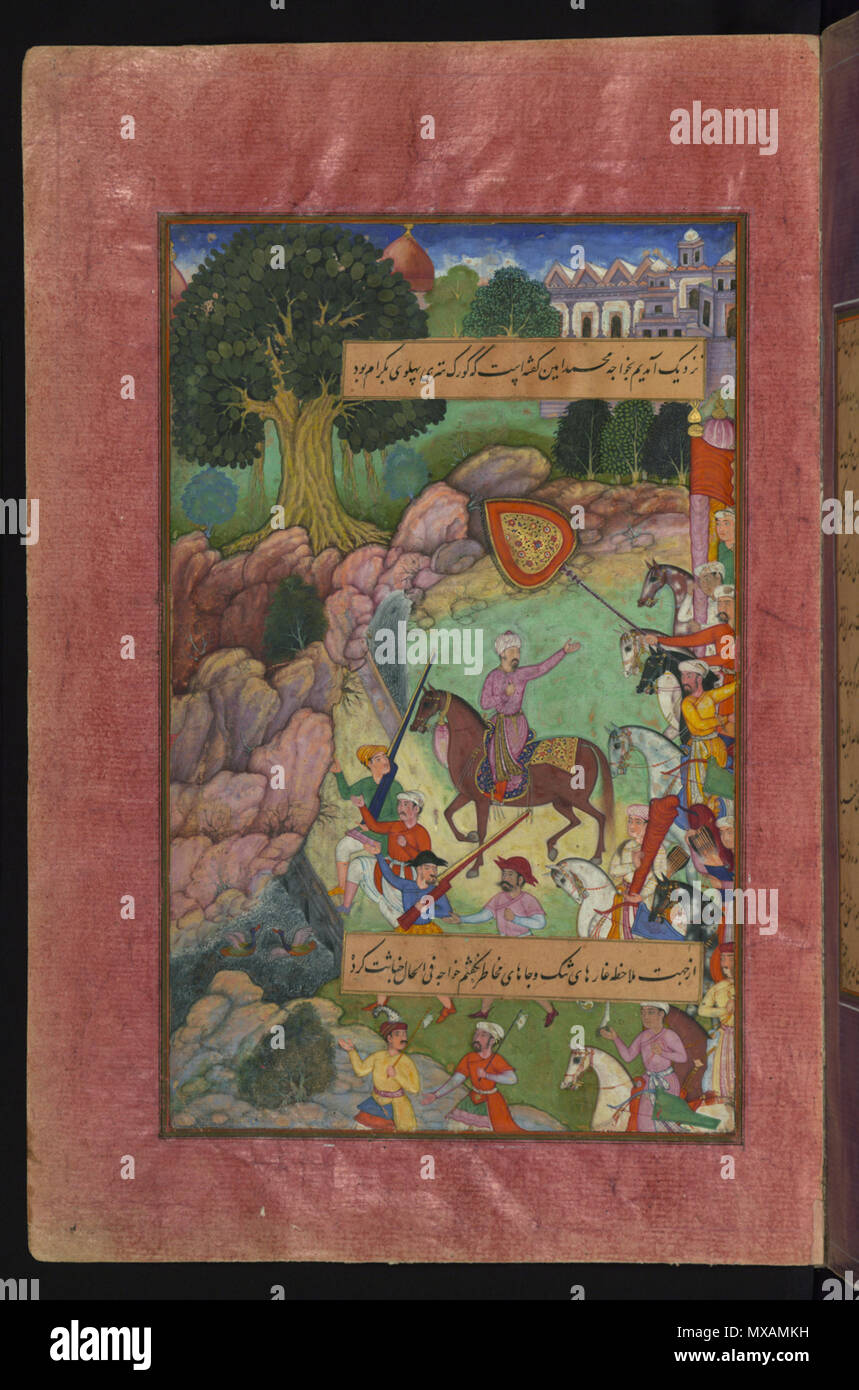 . English: Illustrations from the Manuscript of Baburnama (Memoirs of Babur) - Late 16th Century Bāburnāma is the memoirs of Ẓahīr ud-Dīn Muḥammad Bābur (1483-1530), founder of the Mughal Empire and a great-great-great-grandson of Timur. It is an autobiographical work, originally written in the Chagatai language, known to Babur as 'Turki' (meaning Turkic), the spoken language of the Andijan-Timurids. Because of Babur's cultural origin, his prose is highly Persianized in its sentence structure, morphology, and vocabulary,and also contains many phrases and smaller poems in Persian. During Empero Stock Photohttps://www.alamy.com/image-license-details/?v=1https://www.alamy.com/english-illustrations-from-the-manuscript-of-baburnama-memoirs-of-babur-late-16th-century-bburnma-is-the-memoirs-of-ahr-ud-dn-muammad-bbur-1483-1530-founder-of-the-mughal-empire-and-a-great-great-great-grandson-of-timur-it-is-an-autobiographical-work-originally-written-in-the-chagatai-language-known-to-babur-as-turki-meaning-turkic-the-spoken-language-of-the-andijan-timurids-because-of-baburs-cultural-origin-his-prose-is-highly-persianized-in-its-sentence-structure-morphology-and-vocabularyand-also-contains-many-phrases-and-smaller-poems-in-persian-during-empero-image188320485.html
. English: Illustrations from the Manuscript of Baburnama (Memoirs of Babur) - Late 16th Century Bāburnāma is the memoirs of Ẓahīr ud-Dīn Muḥammad Bābur (1483-1530), founder of the Mughal Empire and a great-great-great-grandson of Timur. It is an autobiographical work, originally written in the Chagatai language, known to Babur as 'Turki' (meaning Turkic), the spoken language of the Andijan-Timurids. Because of Babur's cultural origin, his prose is highly Persianized in its sentence structure, morphology, and vocabulary,and also contains many phrases and smaller poems in Persian. During Empero Stock Photohttps://www.alamy.com/image-license-details/?v=1https://www.alamy.com/english-illustrations-from-the-manuscript-of-baburnama-memoirs-of-babur-late-16th-century-bburnma-is-the-memoirs-of-ahr-ud-dn-muammad-bbur-1483-1530-founder-of-the-mughal-empire-and-a-great-great-great-grandson-of-timur-it-is-an-autobiographical-work-originally-written-in-the-chagatai-language-known-to-babur-as-turki-meaning-turkic-the-spoken-language-of-the-andijan-timurids-because-of-baburs-cultural-origin-his-prose-is-highly-persianized-in-its-sentence-structure-morphology-and-vocabularyand-also-contains-many-phrases-and-smaller-poems-in-persian-during-empero-image188320485.htmlRMMXAMKH–. English: Illustrations from the Manuscript of Baburnama (Memoirs of Babur) - Late 16th Century Bāburnāma is the memoirs of Ẓahīr ud-Dīn Muḥammad Bābur (1483-1530), founder of the Mughal Empire and a great-great-great-grandson of Timur. It is an autobiographical work, originally written in the Chagatai language, known to Babur as 'Turki' (meaning Turkic), the spoken language of the Andijan-Timurids. Because of Babur's cultural origin, his prose is highly Persianized in its sentence structure, morphology, and vocabulary,and also contains many phrases and smaller poems in Persian. During Empero
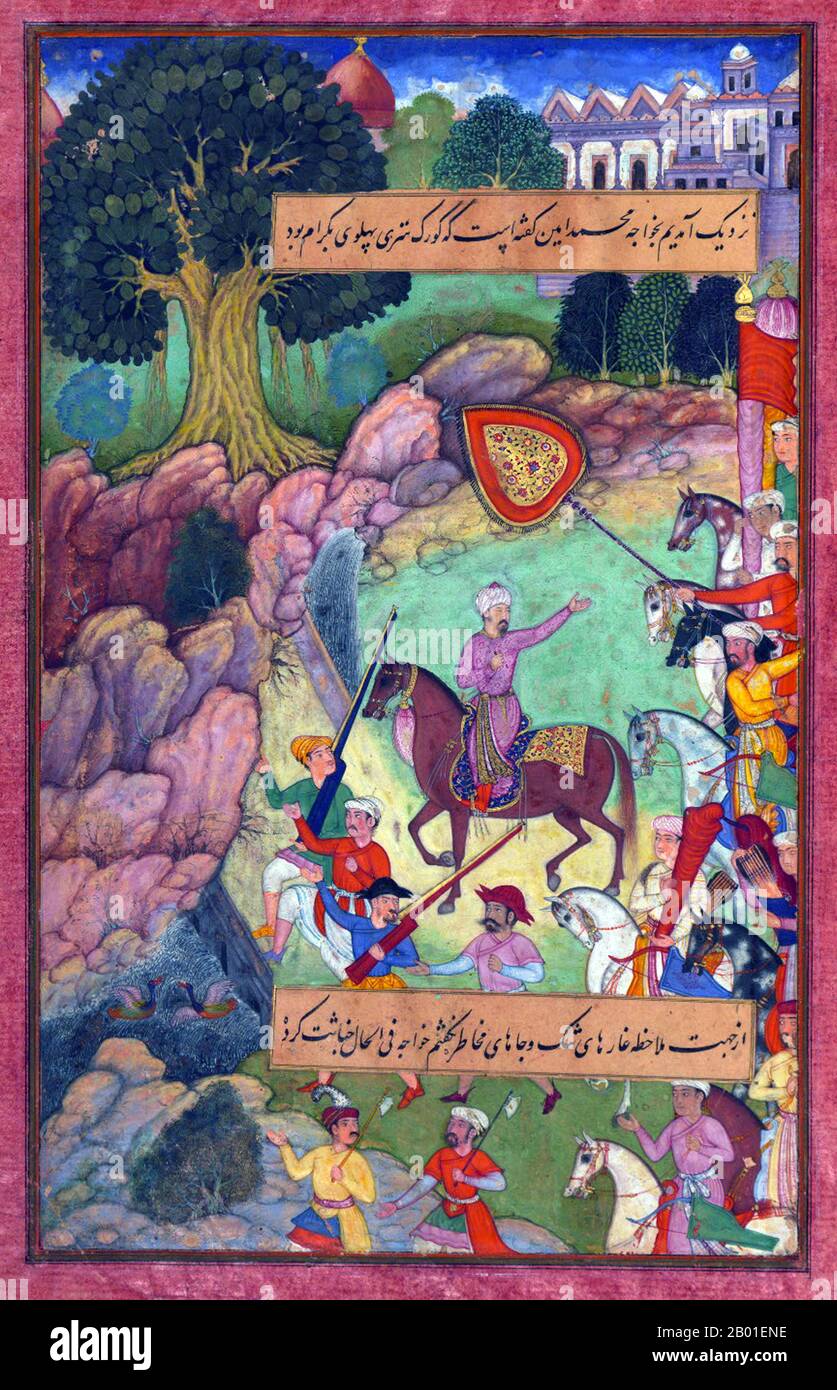 India: On their way to Hindustan, Babur and his men stop for the night before crossing the Indus river. Miniature painting from the Baburnama, late 16th century. Bāburnāma (literally: 'Book of Babur' or 'Letters of Babur'; alternatively known as Tuzk-e Babri) is the name given to the memoirs of Ẓahīr ud-Dīn Muḥammad Bābur (1483-1530), founder of the Mughal Empire and a great-great-great-grandson of Timur. It is an autobiographical work, originally written in the Chagatai language, known to Babur as 'Turki' (meaning Turkic), the spoken language of the Andijan-Timurids. Stock Photohttps://www.alamy.com/image-license-details/?v=1https://www.alamy.com/india-on-their-way-to-hindustan-babur-and-his-men-stop-for-the-night-before-crossing-the-indus-river-miniature-painting-from-the-baburnama-late-16th-century-bburnma-literally-book-of-babur-or-letters-of-babur-alternatively-known-as-tuzk-e-babri-is-the-name-given-to-the-memoirs-of-ahr-ud-dn-muammad-bbur-1483-1530-founder-of-the-mughal-empire-and-a-great-great-great-grandson-of-timur-it-is-an-autobiographical-work-originally-written-in-the-chagatai-language-known-to-babur-as-turki-meaning-turkic-the-spoken-language-of-the-andijan-timurids-image344240890.html
India: On their way to Hindustan, Babur and his men stop for the night before crossing the Indus river. Miniature painting from the Baburnama, late 16th century. Bāburnāma (literally: 'Book of Babur' or 'Letters of Babur'; alternatively known as Tuzk-e Babri) is the name given to the memoirs of Ẓahīr ud-Dīn Muḥammad Bābur (1483-1530), founder of the Mughal Empire and a great-great-great-grandson of Timur. It is an autobiographical work, originally written in the Chagatai language, known to Babur as 'Turki' (meaning Turkic), the spoken language of the Andijan-Timurids. Stock Photohttps://www.alamy.com/image-license-details/?v=1https://www.alamy.com/india-on-their-way-to-hindustan-babur-and-his-men-stop-for-the-night-before-crossing-the-indus-river-miniature-painting-from-the-baburnama-late-16th-century-bburnma-literally-book-of-babur-or-letters-of-babur-alternatively-known-as-tuzk-e-babri-is-the-name-given-to-the-memoirs-of-ahr-ud-dn-muammad-bbur-1483-1530-founder-of-the-mughal-empire-and-a-great-great-great-grandson-of-timur-it-is-an-autobiographical-work-originally-written-in-the-chagatai-language-known-to-babur-as-turki-meaning-turkic-the-spoken-language-of-the-andijan-timurids-image344240890.htmlRM2B01ENE–India: On their way to Hindustan, Babur and his men stop for the night before crossing the Indus river. Miniature painting from the Baburnama, late 16th century. Bāburnāma (literally: 'Book of Babur' or 'Letters of Babur'; alternatively known as Tuzk-e Babri) is the name given to the memoirs of Ẓahīr ud-Dīn Muḥammad Bābur (1483-1530), founder of the Mughal Empire and a great-great-great-grandson of Timur. It is an autobiographical work, originally written in the Chagatai language, known to Babur as 'Turki' (meaning Turkic), the spoken language of the Andijan-Timurids.
 India: Zahir ud-din Muhammad Babur (1483-1530), the first Mughal Emperor, hunting Rhinoceros near Peshawar. Miniature painting from the Baburnama, c. 1598. Bāburnāma (literally: 'Book of Babur' or 'Letters of Babur'; alternatively known as Tuzk-e Babri) is the name given to the memoirs of Ẓahīr ud-Dīn Muḥammad Bābur, founder of the Mughal Empire and a great-great-great-grandson of Timur. It is an autobiographical work, originally written in the Chagatai language, known to Babur as 'Turki' (meaning Turkic), the spoken language of the Andijan-Timurids. Stock Photohttps://www.alamy.com/image-license-details/?v=1https://www.alamy.com/india-zahir-ud-din-muhammad-babur-1483-1530-the-first-mughal-emperor-hunting-rhinoceros-near-peshawar-miniature-painting-from-the-baburnama-c-1598-bburnma-literally-book-of-babur-or-letters-of-babur-alternatively-known-as-tuzk-e-babri-is-the-name-given-to-the-memoirs-of-ahr-ud-dn-muammad-bbur-founder-of-the-mughal-empire-and-a-great-great-great-grandson-of-timur-it-is-an-autobiographical-work-originally-written-in-the-chagatai-language-known-to-babur-as-turki-meaning-turkic-the-spoken-language-of-the-andijan-timurids-image344240945.html
India: Zahir ud-din Muhammad Babur (1483-1530), the first Mughal Emperor, hunting Rhinoceros near Peshawar. Miniature painting from the Baburnama, c. 1598. Bāburnāma (literally: 'Book of Babur' or 'Letters of Babur'; alternatively known as Tuzk-e Babri) is the name given to the memoirs of Ẓahīr ud-Dīn Muḥammad Bābur, founder of the Mughal Empire and a great-great-great-grandson of Timur. It is an autobiographical work, originally written in the Chagatai language, known to Babur as 'Turki' (meaning Turkic), the spoken language of the Andijan-Timurids. Stock Photohttps://www.alamy.com/image-license-details/?v=1https://www.alamy.com/india-zahir-ud-din-muhammad-babur-1483-1530-the-first-mughal-emperor-hunting-rhinoceros-near-peshawar-miniature-painting-from-the-baburnama-c-1598-bburnma-literally-book-of-babur-or-letters-of-babur-alternatively-known-as-tuzk-e-babri-is-the-name-given-to-the-memoirs-of-ahr-ud-dn-muammad-bbur-founder-of-the-mughal-empire-and-a-great-great-great-grandson-of-timur-it-is-an-autobiographical-work-originally-written-in-the-chagatai-language-known-to-babur-as-turki-meaning-turkic-the-spoken-language-of-the-andijan-timurids-image344240945.htmlRM2B01ERD–India: Zahir ud-din Muhammad Babur (1483-1530), the first Mughal Emperor, hunting Rhinoceros near Peshawar. Miniature painting from the Baburnama, c. 1598. Bāburnāma (literally: 'Book of Babur' or 'Letters of Babur'; alternatively known as Tuzk-e Babri) is the name given to the memoirs of Ẓahīr ud-Dīn Muḥammad Bābur, founder of the Mughal Empire and a great-great-great-grandson of Timur. It is an autobiographical work, originally written in the Chagatai language, known to Babur as 'Turki' (meaning Turkic), the spoken language of the Andijan-Timurids.
 India: Zahir ud-din Muhammad Babur (1483-1530), the first Mughal Emperor, battle with Afghans at the Jīkdālīk (Jagdalak) pass. Miniature painting from the Baburnama, late 16th century. Bāburnāma (literally: 'Book of Babur' or 'Letters of Babur'; alternatively known as Tuzk-e Babri) is the name given to the memoirs of Ẓahīr ud-Dīn Muḥammad Bābur, founder of the Mughal Empire and a great-great-great-grandson of Timur. It is an autobiographical work, originally written in the Chagatai language, known to Babur as 'Turki' (meaning Turkic), the spoken language of the Andijan-Timurids. Stock Photohttps://www.alamy.com/image-license-details/?v=1https://www.alamy.com/india-zahir-ud-din-muhammad-babur-1483-1530-the-first-mughal-emperor-battle-with-afghans-at-the-jkdlk-jagdalak-pass-miniature-painting-from-the-baburnama-late-16th-century-bburnma-literally-book-of-babur-or-letters-of-babur-alternatively-known-as-tuzk-e-babri-is-the-name-given-to-the-memoirs-of-ahr-ud-dn-muammad-bbur-founder-of-the-mughal-empire-and-a-great-great-great-grandson-of-timur-it-is-an-autobiographical-work-originally-written-in-the-chagatai-language-known-to-babur-as-turki-meaning-turkic-the-spoken-language-of-the-andijan-timurids-image344240897.html
India: Zahir ud-din Muhammad Babur (1483-1530), the first Mughal Emperor, battle with Afghans at the Jīkdālīk (Jagdalak) pass. Miniature painting from the Baburnama, late 16th century. Bāburnāma (literally: 'Book of Babur' or 'Letters of Babur'; alternatively known as Tuzk-e Babri) is the name given to the memoirs of Ẓahīr ud-Dīn Muḥammad Bābur, founder of the Mughal Empire and a great-great-great-grandson of Timur. It is an autobiographical work, originally written in the Chagatai language, known to Babur as 'Turki' (meaning Turkic), the spoken language of the Andijan-Timurids. Stock Photohttps://www.alamy.com/image-license-details/?v=1https://www.alamy.com/india-zahir-ud-din-muhammad-babur-1483-1530-the-first-mughal-emperor-battle-with-afghans-at-the-jkdlk-jagdalak-pass-miniature-painting-from-the-baburnama-late-16th-century-bburnma-literally-book-of-babur-or-letters-of-babur-alternatively-known-as-tuzk-e-babri-is-the-name-given-to-the-memoirs-of-ahr-ud-dn-muammad-bbur-founder-of-the-mughal-empire-and-a-great-great-great-grandson-of-timur-it-is-an-autobiographical-work-originally-written-in-the-chagatai-language-known-to-babur-as-turki-meaning-turkic-the-spoken-language-of-the-andijan-timurids-image344240897.htmlRM2B01ENN–India: Zahir ud-din Muhammad Babur (1483-1530), the first Mughal Emperor, battle with Afghans at the Jīkdālīk (Jagdalak) pass. Miniature painting from the Baburnama, late 16th century. Bāburnāma (literally: 'Book of Babur' or 'Letters of Babur'; alternatively known as Tuzk-e Babri) is the name given to the memoirs of Ẓahīr ud-Dīn Muḥammad Bābur, founder of the Mughal Empire and a great-great-great-grandson of Timur. It is an autobiographical work, originally written in the Chagatai language, known to Babur as 'Turki' (meaning Turkic), the spoken language of the Andijan-Timurids.
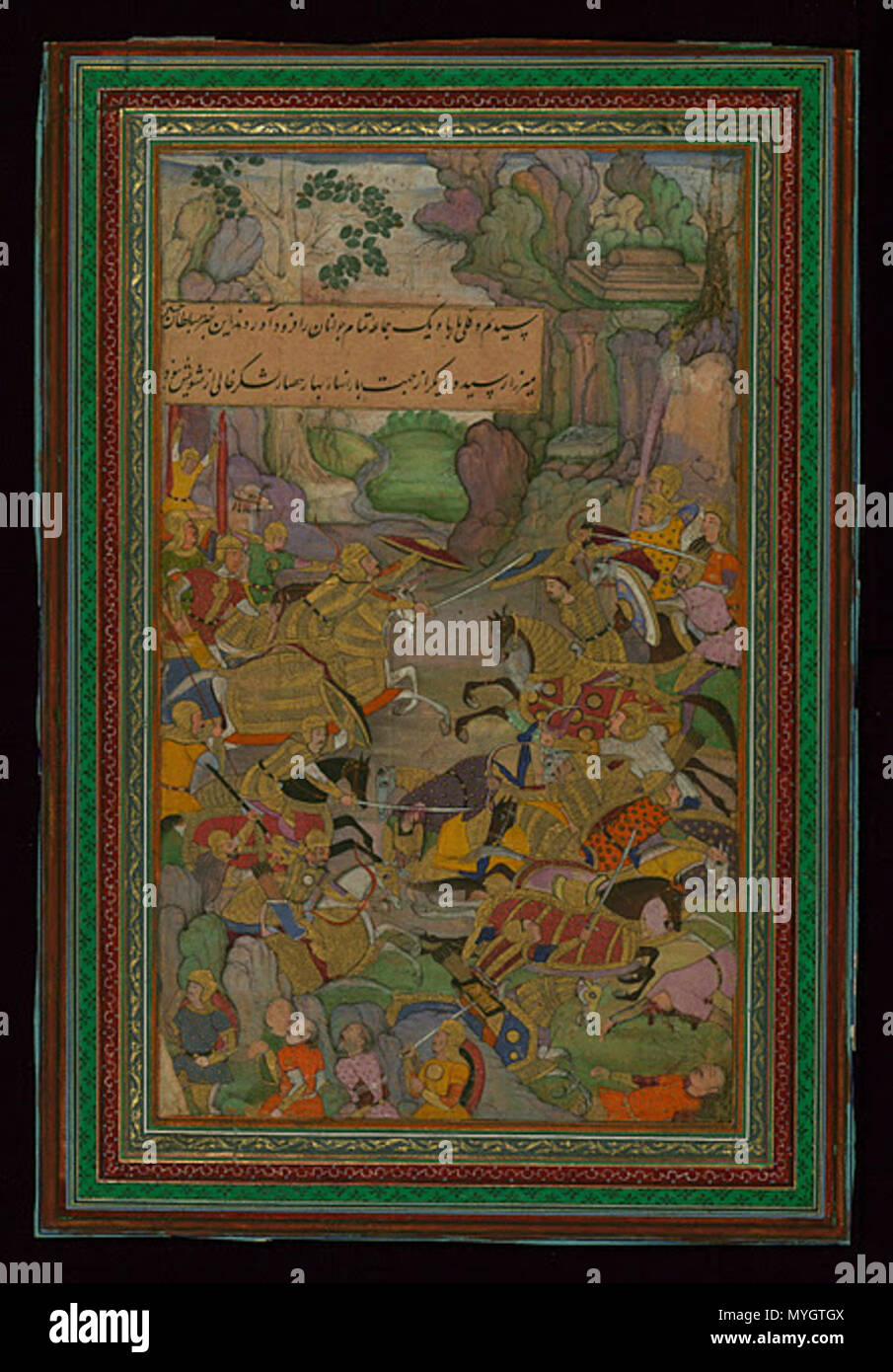 . English: Illustrations from the Manuscript of Baburnama (Memoirs of Babur) - Late 16th Century Bāburnāma is the memoirs of Ẓahīr ud-Dīn Muḥammad Bābur (1483-1530), founder of the Mughal Empire and a great-great-great-grandson of Timur. It is an autobiographical work, originally written in the Chagatai language, known to Babur as 'Turki' (meaning Turkic), the spoken language of the Andijan-Timurids. Because of Babur's cultural origin, his prose is highly Persianized in its sentence structure, morphology, and vocabulary,and also contains many phrases and smaller poems in Persian. During Empero Stock Photohttps://www.alamy.com/image-license-details/?v=1https://www.alamy.com/english-illustrations-from-the-manuscript-of-baburnama-memoirs-of-babur-late-16th-century-bburnma-is-the-memoirs-of-ahr-ud-dn-muammad-bbur-1483-1530-founder-of-the-mughal-empire-and-a-great-great-great-grandson-of-timur-it-is-an-autobiographical-work-originally-written-in-the-chagatai-language-known-to-babur-as-turki-meaning-turkic-the-spoken-language-of-the-andijan-timurids-because-of-baburs-cultural-origin-his-prose-is-highly-persianized-in-its-sentence-structure-morphology-and-vocabularyand-also-contains-many-phrases-and-smaller-poems-in-persian-during-empero-image189069914.html
. English: Illustrations from the Manuscript of Baburnama (Memoirs of Babur) - Late 16th Century Bāburnāma is the memoirs of Ẓahīr ud-Dīn Muḥammad Bābur (1483-1530), founder of the Mughal Empire and a great-great-great-grandson of Timur. It is an autobiographical work, originally written in the Chagatai language, known to Babur as 'Turki' (meaning Turkic), the spoken language of the Andijan-Timurids. Because of Babur's cultural origin, his prose is highly Persianized in its sentence structure, morphology, and vocabulary,and also contains many phrases and smaller poems in Persian. During Empero Stock Photohttps://www.alamy.com/image-license-details/?v=1https://www.alamy.com/english-illustrations-from-the-manuscript-of-baburnama-memoirs-of-babur-late-16th-century-bburnma-is-the-memoirs-of-ahr-ud-dn-muammad-bbur-1483-1530-founder-of-the-mughal-empire-and-a-great-great-great-grandson-of-timur-it-is-an-autobiographical-work-originally-written-in-the-chagatai-language-known-to-babur-as-turki-meaning-turkic-the-spoken-language-of-the-andijan-timurids-because-of-baburs-cultural-origin-his-prose-is-highly-persianized-in-its-sentence-structure-morphology-and-vocabularyand-also-contains-many-phrases-and-smaller-poems-in-persian-during-empero-image189069914.htmlRMMYGTGX–. English: Illustrations from the Manuscript of Baburnama (Memoirs of Babur) - Late 16th Century Bāburnāma is the memoirs of Ẓahīr ud-Dīn Muḥammad Bābur (1483-1530), founder of the Mughal Empire and a great-great-great-grandson of Timur. It is an autobiographical work, originally written in the Chagatai language, known to Babur as 'Turki' (meaning Turkic), the spoken language of the Andijan-Timurids. Because of Babur's cultural origin, his prose is highly Persianized in its sentence structure, morphology, and vocabulary,and also contains many phrases and smaller poems in Persian. During Empero
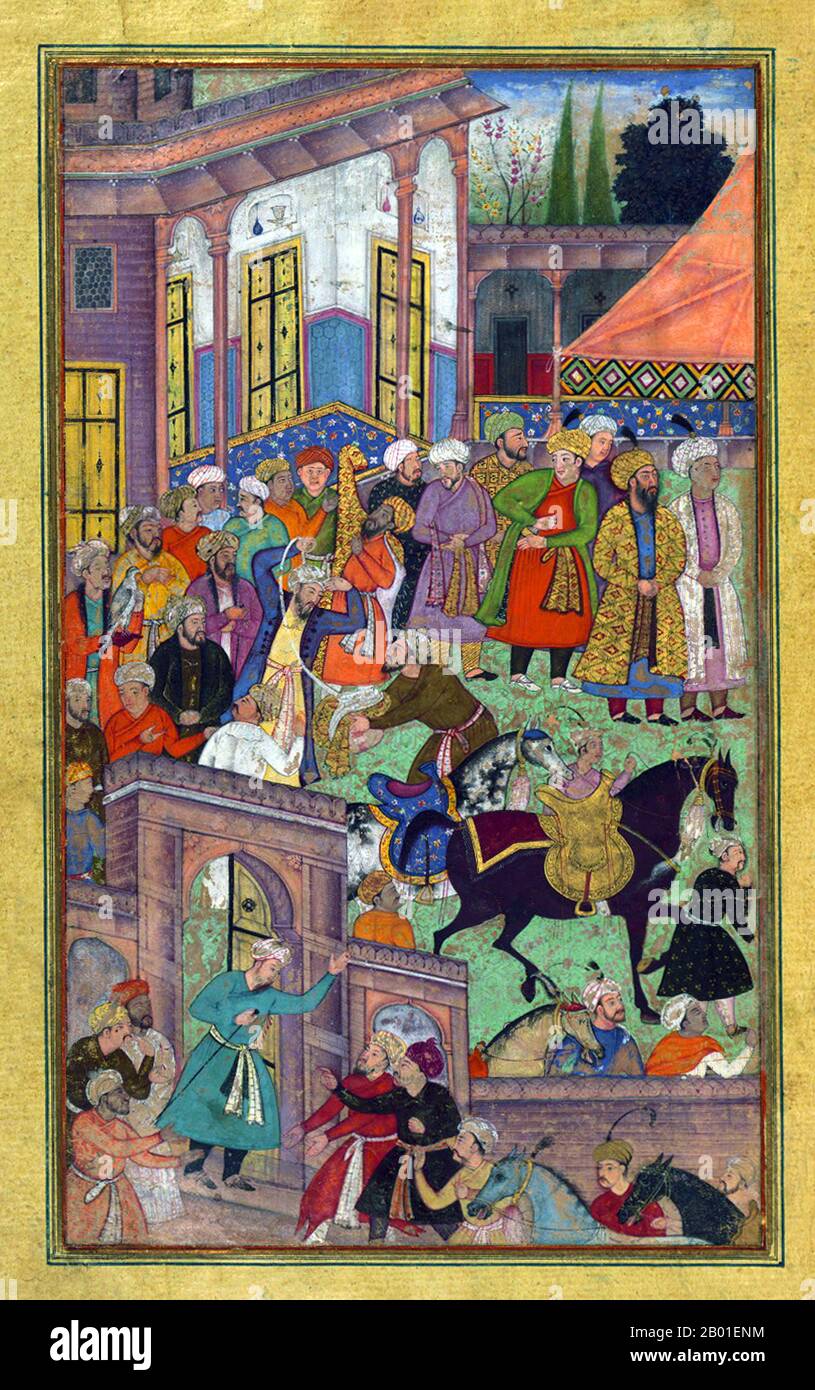 India: An awards ceremony in the Sultan Ibrāhīm’s court before being sent on an expedition to Sambhal. Miniature painting form the Baburnama, late 16th century. Bāburnāma (literally: 'Book of Babur' or 'Letters of Babur'; alternatively known as Tuzk-e Babri) is the name given to the memoirs of Ẓahīr ud-Dīn Muḥammad Bābur (1483-1530), founder of the Mughal Empire and a great-great-great-grandson of Timur. It is an autobiographical work, originally written in the Chagatai language, known to Babur as 'Turki' (meaning Turkic), the spoken language of the Andijan-Timurids. Stock Photohttps://www.alamy.com/image-license-details/?v=1https://www.alamy.com/india-an-awards-ceremony-in-the-sultan-ibrhms-court-before-being-sent-on-an-expedition-to-sambhal-miniature-painting-form-the-baburnama-late-16th-century-bburnma-literally-book-of-babur-or-letters-of-babur-alternatively-known-as-tuzk-e-babri-is-the-name-given-to-the-memoirs-of-ahr-ud-dn-muammad-bbur-1483-1530-founder-of-the-mughal-empire-and-a-great-great-great-grandson-of-timur-it-is-an-autobiographical-work-originally-written-in-the-chagatai-language-known-to-babur-as-turki-meaning-turkic-the-spoken-language-of-the-andijan-timurids-image344240896.html
India: An awards ceremony in the Sultan Ibrāhīm’s court before being sent on an expedition to Sambhal. Miniature painting form the Baburnama, late 16th century. Bāburnāma (literally: 'Book of Babur' or 'Letters of Babur'; alternatively known as Tuzk-e Babri) is the name given to the memoirs of Ẓahīr ud-Dīn Muḥammad Bābur (1483-1530), founder of the Mughal Empire and a great-great-great-grandson of Timur. It is an autobiographical work, originally written in the Chagatai language, known to Babur as 'Turki' (meaning Turkic), the spoken language of the Andijan-Timurids. Stock Photohttps://www.alamy.com/image-license-details/?v=1https://www.alamy.com/india-an-awards-ceremony-in-the-sultan-ibrhms-court-before-being-sent-on-an-expedition-to-sambhal-miniature-painting-form-the-baburnama-late-16th-century-bburnma-literally-book-of-babur-or-letters-of-babur-alternatively-known-as-tuzk-e-babri-is-the-name-given-to-the-memoirs-of-ahr-ud-dn-muammad-bbur-1483-1530-founder-of-the-mughal-empire-and-a-great-great-great-grandson-of-timur-it-is-an-autobiographical-work-originally-written-in-the-chagatai-language-known-to-babur-as-turki-meaning-turkic-the-spoken-language-of-the-andijan-timurids-image344240896.htmlRM2B01ENM–India: An awards ceremony in the Sultan Ibrāhīm’s court before being sent on an expedition to Sambhal. Miniature painting form the Baburnama, late 16th century. Bāburnāma (literally: 'Book of Babur' or 'Letters of Babur'; alternatively known as Tuzk-e Babri) is the name given to the memoirs of Ẓahīr ud-Dīn Muḥammad Bābur (1483-1530), founder of the Mughal Empire and a great-great-great-grandson of Timur. It is an autobiographical work, originally written in the Chagatai language, known to Babur as 'Turki' (meaning Turkic), the spoken language of the Andijan-Timurids.
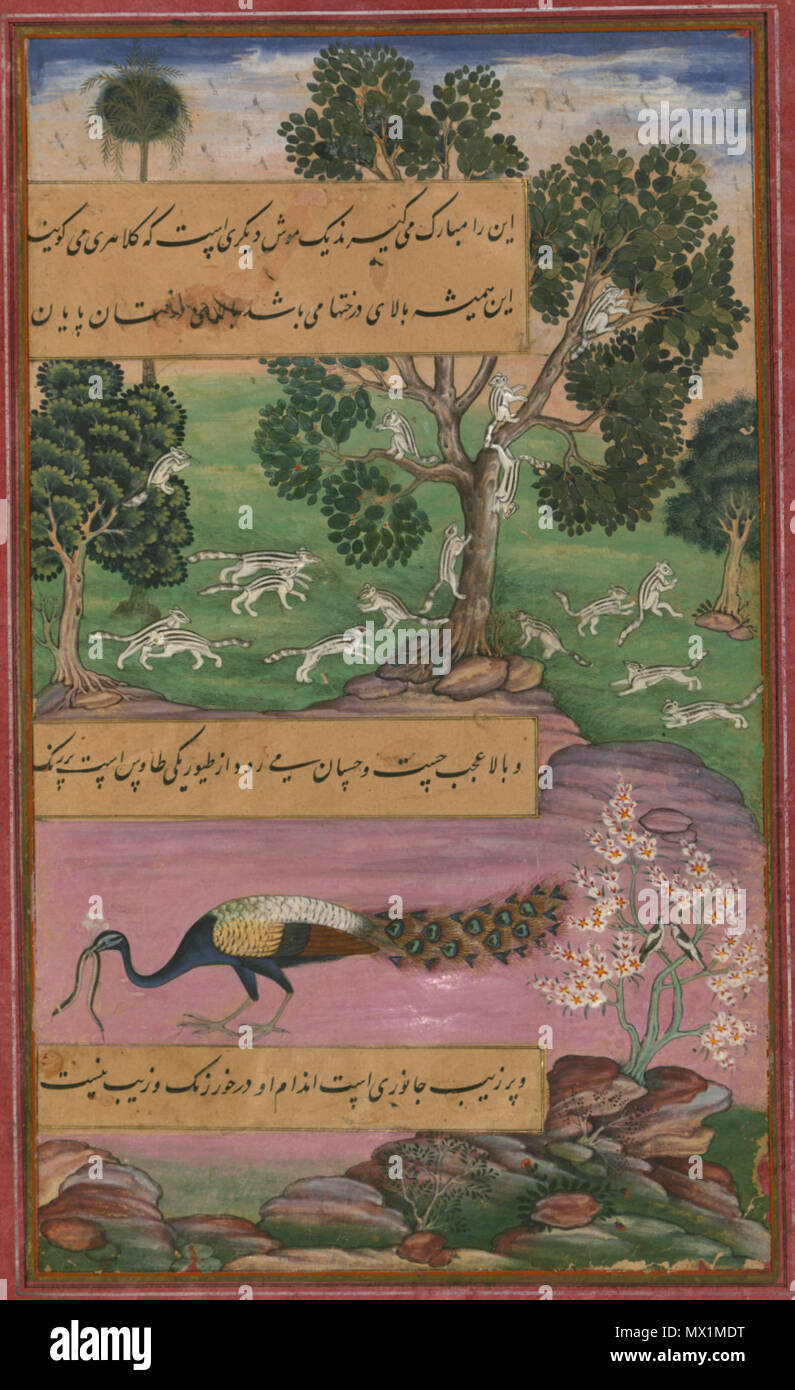 . English: Illustrations from the Manuscript of Baburnama (Memoirs of Babur) - Late 16th Century Bāburnāma is the memoirs of Ẓahīr ud-Dīn Muḥammad Bābur (1483-1530), founder of the Mughal Empire and a great-great-great-grandson of Timur. It is an autobiographical work, originally written in the Chagatai language, known to Babur as 'Turki' (meaning Turkic), the spoken language of the Andijan-Timurids. Because of Babur's cultural origin, his prose is highly Persianized in its sentence structure, morphology, and vocabulary,and also contains many phrases and smaller poems in Persian. During Empero Stock Photohttps://www.alamy.com/image-license-details/?v=1https://www.alamy.com/english-illustrations-from-the-manuscript-of-baburnama-memoirs-of-babur-late-16th-century-bburnma-is-the-memoirs-of-ahr-ud-dn-muammad-bbur-1483-1530-founder-of-the-mughal-empire-and-a-great-great-great-grandson-of-timur-it-is-an-autobiographical-work-originally-written-in-the-chagatai-language-known-to-babur-as-turki-meaning-turkic-the-spoken-language-of-the-andijan-timurids-because-of-baburs-cultural-origin-his-prose-is-highly-persianized-in-its-sentence-structure-morphology-and-vocabularyand-also-contains-many-phrases-and-smaller-poems-in-persian-during-empero-image188122756.html
. English: Illustrations from the Manuscript of Baburnama (Memoirs of Babur) - Late 16th Century Bāburnāma is the memoirs of Ẓahīr ud-Dīn Muḥammad Bābur (1483-1530), founder of the Mughal Empire and a great-great-great-grandson of Timur. It is an autobiographical work, originally written in the Chagatai language, known to Babur as 'Turki' (meaning Turkic), the spoken language of the Andijan-Timurids. Because of Babur's cultural origin, his prose is highly Persianized in its sentence structure, morphology, and vocabulary,and also contains many phrases and smaller poems in Persian. During Empero Stock Photohttps://www.alamy.com/image-license-details/?v=1https://www.alamy.com/english-illustrations-from-the-manuscript-of-baburnama-memoirs-of-babur-late-16th-century-bburnma-is-the-memoirs-of-ahr-ud-dn-muammad-bbur-1483-1530-founder-of-the-mughal-empire-and-a-great-great-great-grandson-of-timur-it-is-an-autobiographical-work-originally-written-in-the-chagatai-language-known-to-babur-as-turki-meaning-turkic-the-spoken-language-of-the-andijan-timurids-because-of-baburs-cultural-origin-his-prose-is-highly-persianized-in-its-sentence-structure-morphology-and-vocabularyand-also-contains-many-phrases-and-smaller-poems-in-persian-during-empero-image188122756.htmlRMMX1MDT–. English: Illustrations from the Manuscript of Baburnama (Memoirs of Babur) - Late 16th Century Bāburnāma is the memoirs of Ẓahīr ud-Dīn Muḥammad Bābur (1483-1530), founder of the Mughal Empire and a great-great-great-grandson of Timur. It is an autobiographical work, originally written in the Chagatai language, known to Babur as 'Turki' (meaning Turkic), the spoken language of the Andijan-Timurids. Because of Babur's cultural origin, his prose is highly Persianized in its sentence structure, morphology, and vocabulary,and also contains many phrases and smaller poems in Persian. During Empero
 India: Zahir ud-din Muhammad Babur (1483-1530), the first Mughal Emperor, defeats Sultan Ibrāhīm, the last of the Lōdī Sultans of Delhi, at the Battle of Panipat. Miniature painting from the Baburnama, late 16th century. Bāburnāma (literally: 'Book of Babur' or 'Letters of Babur'; alternatively known as Tuzk-e Babri) is the name given to the memoirs of Ẓahīr ud-Dīn Muḥammad Bābur, founder of the Mughal Empire and a great-great-great-grandson of Timur. It is an autobiographical work, originally written in the Chagatai language, known to Babur as 'Turki' (meaning Turkic). Stock Photohttps://www.alamy.com/image-license-details/?v=1https://www.alamy.com/india-zahir-ud-din-muhammad-babur-1483-1530-the-first-mughal-emperor-defeats-sultan-ibrhm-the-last-of-the-ld-sultans-of-delhi-at-the-battle-of-panipat-miniature-painting-from-the-baburnama-late-16th-century-bburnma-literally-book-of-babur-or-letters-of-babur-alternatively-known-as-tuzk-e-babri-is-the-name-given-to-the-memoirs-of-ahr-ud-dn-muammad-bbur-founder-of-the-mughal-empire-and-a-great-great-great-grandson-of-timur-it-is-an-autobiographical-work-originally-written-in-the-chagatai-language-known-to-babur-as-turki-meaning-turkic-image344240898.html
India: Zahir ud-din Muhammad Babur (1483-1530), the first Mughal Emperor, defeats Sultan Ibrāhīm, the last of the Lōdī Sultans of Delhi, at the Battle of Panipat. Miniature painting from the Baburnama, late 16th century. Bāburnāma (literally: 'Book of Babur' or 'Letters of Babur'; alternatively known as Tuzk-e Babri) is the name given to the memoirs of Ẓahīr ud-Dīn Muḥammad Bābur, founder of the Mughal Empire and a great-great-great-grandson of Timur. It is an autobiographical work, originally written in the Chagatai language, known to Babur as 'Turki' (meaning Turkic). Stock Photohttps://www.alamy.com/image-license-details/?v=1https://www.alamy.com/india-zahir-ud-din-muhammad-babur-1483-1530-the-first-mughal-emperor-defeats-sultan-ibrhm-the-last-of-the-ld-sultans-of-delhi-at-the-battle-of-panipat-miniature-painting-from-the-baburnama-late-16th-century-bburnma-literally-book-of-babur-or-letters-of-babur-alternatively-known-as-tuzk-e-babri-is-the-name-given-to-the-memoirs-of-ahr-ud-dn-muammad-bbur-founder-of-the-mughal-empire-and-a-great-great-great-grandson-of-timur-it-is-an-autobiographical-work-originally-written-in-the-chagatai-language-known-to-babur-as-turki-meaning-turkic-image344240898.htmlRM2B01ENP–India: Zahir ud-din Muhammad Babur (1483-1530), the first Mughal Emperor, defeats Sultan Ibrāhīm, the last of the Lōdī Sultans of Delhi, at the Battle of Panipat. Miniature painting from the Baburnama, late 16th century. Bāburnāma (literally: 'Book of Babur' or 'Letters of Babur'; alternatively known as Tuzk-e Babri) is the name given to the memoirs of Ẓahīr ud-Dīn Muḥammad Bābur, founder of the Mughal Empire and a great-great-great-grandson of Timur. It is an autobiographical work, originally written in the Chagatai language, known to Babur as 'Turki' (meaning Turkic).
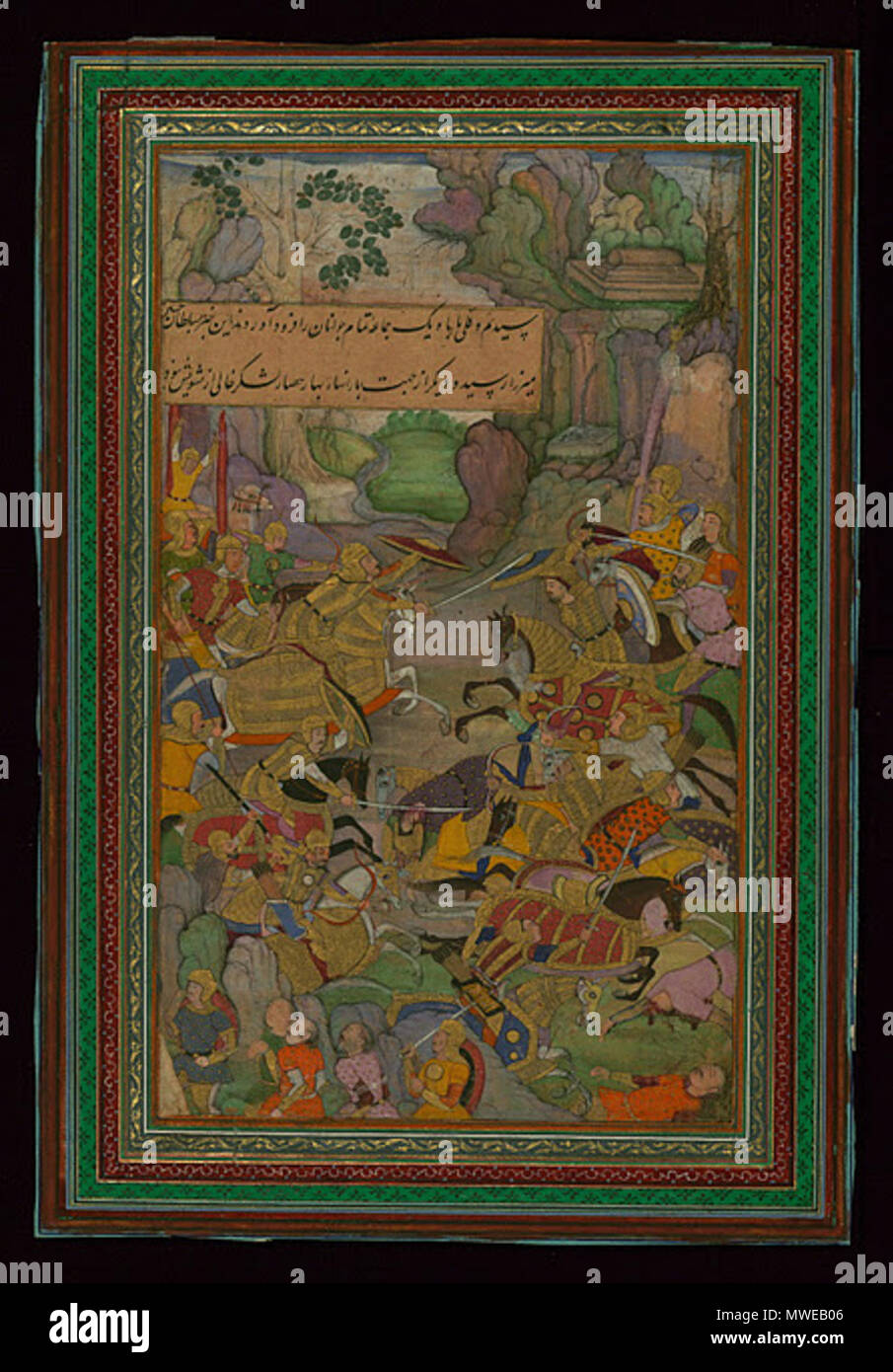 . English: Illustrations from the Manuscript of Baburnama (Memoirs of Babur) - Late 16th Century Bāburnāma is the memoirs of Ẓahīr ud-Dīn Muḥammad Bābur (1483-1530), founder of the Mughal Empire and a great-great-great-grandson of Timur. It is an autobiographical work, originally written in the Chagatai language, known to Babur as 'Turki' (meaning Turkic), the spoken language of the Andijan-Timurids. Because of Babur's cultural origin, his prose is highly Persianized in its sentence structure, morphology, and vocabulary,and also contains many phrases and smaller poems in Persian. During Empero Stock Photohttps://www.alamy.com/image-license-details/?v=1https://www.alamy.com/english-illustrations-from-the-manuscript-of-baburnama-memoirs-of-babur-late-16th-century-bburnma-is-the-memoirs-of-ahr-ud-dn-muammad-bbur-1483-1530-founder-of-the-mughal-empire-and-a-great-great-great-grandson-of-timur-it-is-an-autobiographical-work-originally-written-in-the-chagatai-language-known-to-babur-as-turki-meaning-turkic-the-spoken-language-of-the-andijan-timurids-because-of-baburs-cultural-origin-his-prose-is-highly-persianized-in-its-sentence-structure-morphology-and-vocabularyand-also-contains-many-phrases-and-smaller-poems-in-persian-during-empero-image187786038.html
. English: Illustrations from the Manuscript of Baburnama (Memoirs of Babur) - Late 16th Century Bāburnāma is the memoirs of Ẓahīr ud-Dīn Muḥammad Bābur (1483-1530), founder of the Mughal Empire and a great-great-great-grandson of Timur. It is an autobiographical work, originally written in the Chagatai language, known to Babur as 'Turki' (meaning Turkic), the spoken language of the Andijan-Timurids. Because of Babur's cultural origin, his prose is highly Persianized in its sentence structure, morphology, and vocabulary,and also contains many phrases and smaller poems in Persian. During Empero Stock Photohttps://www.alamy.com/image-license-details/?v=1https://www.alamy.com/english-illustrations-from-the-manuscript-of-baburnama-memoirs-of-babur-late-16th-century-bburnma-is-the-memoirs-of-ahr-ud-dn-muammad-bbur-1483-1530-founder-of-the-mughal-empire-and-a-great-great-great-grandson-of-timur-it-is-an-autobiographical-work-originally-written-in-the-chagatai-language-known-to-babur-as-turki-meaning-turkic-the-spoken-language-of-the-andijan-timurids-because-of-baburs-cultural-origin-his-prose-is-highly-persianized-in-its-sentence-structure-morphology-and-vocabularyand-also-contains-many-phrases-and-smaller-poems-in-persian-during-empero-image187786038.htmlRMMWEB06–. English: Illustrations from the Manuscript of Baburnama (Memoirs of Babur) - Late 16th Century Bāburnāma is the memoirs of Ẓahīr ud-Dīn Muḥammad Bābur (1483-1530), founder of the Mughal Empire and a great-great-great-grandson of Timur. It is an autobiographical work, originally written in the Chagatai language, known to Babur as 'Turki' (meaning Turkic), the spoken language of the Andijan-Timurids. Because of Babur's cultural origin, his prose is highly Persianized in its sentence structure, morphology, and vocabulary,and also contains many phrases and smaller poems in Persian. During Empero
 India: Bāqī Chaghānyānī pays homage to Babur, near the river Oxus (Āmū Daryā), in 910 AH/1504 CE. Miniature painting from the Baburnama, late 16th century. Bāburnāma (literally: 'Book of Babur' or 'Letters of Babur'; alternatively known as Tuzk-e Babri) is the name given to the memoirs of Ẓahīr ud-Dīn Muḥammad Bābur (1483-1530), founder of the Mughal Empire and a great-great-great-grandson of Timur. It is an autobiographical work, originally written in the Chagatai language, known to Babur as 'Turki' (meaning Turkic), the spoken language of the Andijan-Timurids. Stock Photohttps://www.alamy.com/image-license-details/?v=1https://www.alamy.com/india-bq-chaghnyn-pays-homage-to-babur-near-the-river-oxus-m-dary-in-910-ah1504-ce-miniature-painting-from-the-baburnama-late-16th-century-bburnma-literally-book-of-babur-or-letters-of-babur-alternatively-known-as-tuzk-e-babri-is-the-name-given-to-the-memoirs-of-ahr-ud-dn-muammad-bbur-1483-1530-founder-of-the-mughal-empire-and-a-great-great-great-grandson-of-timur-it-is-an-autobiographical-work-originally-written-in-the-chagatai-language-known-to-babur-as-turki-meaning-turkic-the-spoken-language-of-the-andijan-timurids-image344240928.html
India: Bāqī Chaghānyānī pays homage to Babur, near the river Oxus (Āmū Daryā), in 910 AH/1504 CE. Miniature painting from the Baburnama, late 16th century. Bāburnāma (literally: 'Book of Babur' or 'Letters of Babur'; alternatively known as Tuzk-e Babri) is the name given to the memoirs of Ẓahīr ud-Dīn Muḥammad Bābur (1483-1530), founder of the Mughal Empire and a great-great-great-grandson of Timur. It is an autobiographical work, originally written in the Chagatai language, known to Babur as 'Turki' (meaning Turkic), the spoken language of the Andijan-Timurids. Stock Photohttps://www.alamy.com/image-license-details/?v=1https://www.alamy.com/india-bq-chaghnyn-pays-homage-to-babur-near-the-river-oxus-m-dary-in-910-ah1504-ce-miniature-painting-from-the-baburnama-late-16th-century-bburnma-literally-book-of-babur-or-letters-of-babur-alternatively-known-as-tuzk-e-babri-is-the-name-given-to-the-memoirs-of-ahr-ud-dn-muammad-bbur-1483-1530-founder-of-the-mughal-empire-and-a-great-great-great-grandson-of-timur-it-is-an-autobiographical-work-originally-written-in-the-chagatai-language-known-to-babur-as-turki-meaning-turkic-the-spoken-language-of-the-andijan-timurids-image344240928.htmlRM2B01EPT–India: Bāqī Chaghānyānī pays homage to Babur, near the river Oxus (Āmū Daryā), in 910 AH/1504 CE. Miniature painting from the Baburnama, late 16th century. Bāburnāma (literally: 'Book of Babur' or 'Letters of Babur'; alternatively known as Tuzk-e Babri) is the name given to the memoirs of Ẓahīr ud-Dīn Muḥammad Bābur (1483-1530), founder of the Mughal Empire and a great-great-great-grandson of Timur. It is an autobiographical work, originally written in the Chagatai language, known to Babur as 'Turki' (meaning Turkic), the spoken language of the Andijan-Timurids.
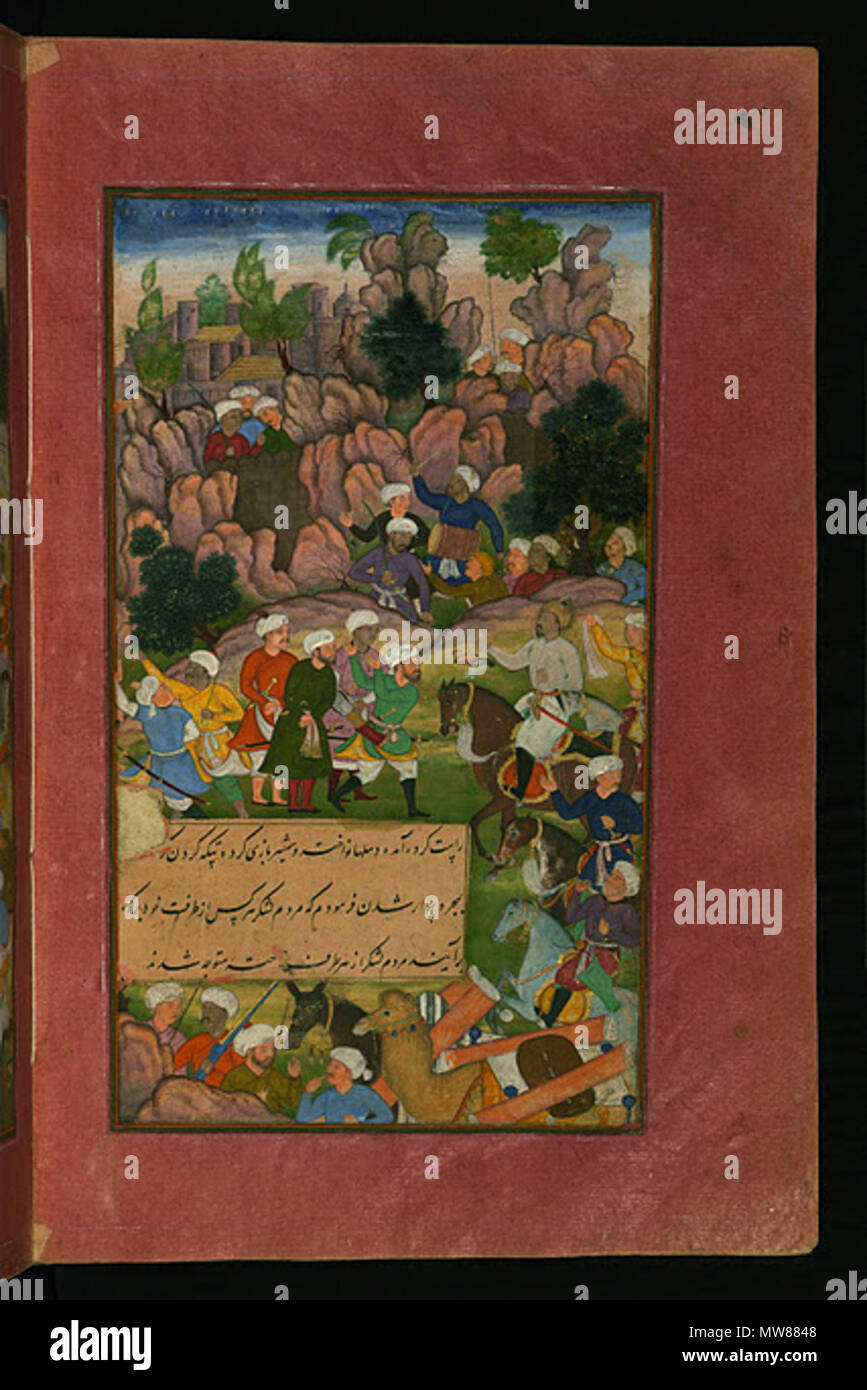 . English: Illustrations from the Manuscript of Baburnama (Memoirs of Babur) - Late 16th Century Bāburnāma is the memoirs of Ẓahīr ud-Dīn Muḥammad Bābur (1483-1530), founder of the Mughal Empire and a great-great-great-grandson of Timur. It is an autobiographical work, originally written in the Chagatai language, known to Babur as 'Turki' (meaning Turkic), the spoken language of the Andijan-Timurids. Because of Babur's cultural origin, his prose is highly Persianized in its sentence structure, morphology, and vocabulary,and also contains many phrases and smaller poems in Persian. During Empero Stock Photohttps://www.alamy.com/image-license-details/?v=1https://www.alamy.com/english-illustrations-from-the-manuscript-of-baburnama-memoirs-of-babur-late-16th-century-bburnma-is-the-memoirs-of-ahr-ud-dn-muammad-bbur-1483-1530-founder-of-the-mughal-empire-and-a-great-great-great-grandson-of-timur-it-is-an-autobiographical-work-originally-written-in-the-chagatai-language-known-to-babur-as-turki-meaning-turkic-the-spoken-language-of-the-andijan-timurids-because-of-baburs-cultural-origin-his-prose-is-highly-persianized-in-its-sentence-structure-morphology-and-vocabularyand-also-contains-many-phrases-and-smaller-poems-in-persian-during-empero-image187652088.html
. English: Illustrations from the Manuscript of Baburnama (Memoirs of Babur) - Late 16th Century Bāburnāma is the memoirs of Ẓahīr ud-Dīn Muḥammad Bābur (1483-1530), founder of the Mughal Empire and a great-great-great-grandson of Timur. It is an autobiographical work, originally written in the Chagatai language, known to Babur as 'Turki' (meaning Turkic), the spoken language of the Andijan-Timurids. Because of Babur's cultural origin, his prose is highly Persianized in its sentence structure, morphology, and vocabulary,and also contains many phrases and smaller poems in Persian. During Empero Stock Photohttps://www.alamy.com/image-license-details/?v=1https://www.alamy.com/english-illustrations-from-the-manuscript-of-baburnama-memoirs-of-babur-late-16th-century-bburnma-is-the-memoirs-of-ahr-ud-dn-muammad-bbur-1483-1530-founder-of-the-mughal-empire-and-a-great-great-great-grandson-of-timur-it-is-an-autobiographical-work-originally-written-in-the-chagatai-language-known-to-babur-as-turki-meaning-turkic-the-spoken-language-of-the-andijan-timurids-because-of-baburs-cultural-origin-his-prose-is-highly-persianized-in-its-sentence-structure-morphology-and-vocabularyand-also-contains-many-phrases-and-smaller-poems-in-persian-during-empero-image187652088.htmlRMMW8848–. English: Illustrations from the Manuscript of Baburnama (Memoirs of Babur) - Late 16th Century Bāburnāma is the memoirs of Ẓahīr ud-Dīn Muḥammad Bābur (1483-1530), founder of the Mughal Empire and a great-great-great-grandson of Timur. It is an autobiographical work, originally written in the Chagatai language, known to Babur as 'Turki' (meaning Turkic), the spoken language of the Andijan-Timurids. Because of Babur's cultural origin, his prose is highly Persianized in its sentence structure, morphology, and vocabulary,and also contains many phrases and smaller poems in Persian. During Empero
 India: Babur on the way to Hindustan camps at Jām and with the help of his guide Malik Bū Saʿīd Kamarī explores Bagram. Miniature painting from the Baburnama, late 16th century. Bāburnāma (literally: 'Book of Babur' or 'Letters of Babur'; alternatively known as Tuzk-e Babri) is the name given to the memoirs of Ẓahīr ud-Dīn Muḥammad Bābur (1483-1530), founder of the Mughal Empire and a great-great-great-grandson of Timur. It is an autobiographical work, originally written in the Chagatai language, known to Babur as 'Turki' (meaning Turkic), the spoken language of the Andijan-Timurids. Stock Photohttps://www.alamy.com/image-license-details/?v=1https://www.alamy.com/india-babur-on-the-way-to-hindustan-camps-at-jm-and-with-the-help-of-his-guide-malik-b-sad-kamar-explores-bagram-miniature-painting-from-the-baburnama-late-16th-century-bburnma-literally-book-of-babur-or-letters-of-babur-alternatively-known-as-tuzk-e-babri-is-the-name-given-to-the-memoirs-of-ahr-ud-dn-muammad-bbur-1483-1530-founder-of-the-mughal-empire-and-a-great-great-great-grandson-of-timur-it-is-an-autobiographical-work-originally-written-in-the-chagatai-language-known-to-babur-as-turki-meaning-turkic-the-spoken-language-of-the-andijan-timurids-image344240894.html
India: Babur on the way to Hindustan camps at Jām and with the help of his guide Malik Bū Saʿīd Kamarī explores Bagram. Miniature painting from the Baburnama, late 16th century. Bāburnāma (literally: 'Book of Babur' or 'Letters of Babur'; alternatively known as Tuzk-e Babri) is the name given to the memoirs of Ẓahīr ud-Dīn Muḥammad Bābur (1483-1530), founder of the Mughal Empire and a great-great-great-grandson of Timur. It is an autobiographical work, originally written in the Chagatai language, known to Babur as 'Turki' (meaning Turkic), the spoken language of the Andijan-Timurids. Stock Photohttps://www.alamy.com/image-license-details/?v=1https://www.alamy.com/india-babur-on-the-way-to-hindustan-camps-at-jm-and-with-the-help-of-his-guide-malik-b-sad-kamar-explores-bagram-miniature-painting-from-the-baburnama-late-16th-century-bburnma-literally-book-of-babur-or-letters-of-babur-alternatively-known-as-tuzk-e-babri-is-the-name-given-to-the-memoirs-of-ahr-ud-dn-muammad-bbur-1483-1530-founder-of-the-mughal-empire-and-a-great-great-great-grandson-of-timur-it-is-an-autobiographical-work-originally-written-in-the-chagatai-language-known-to-babur-as-turki-meaning-turkic-the-spoken-language-of-the-andijan-timurids-image344240894.htmlRM2B01ENJ–India: Babur on the way to Hindustan camps at Jām and with the help of his guide Malik Bū Saʿīd Kamarī explores Bagram. Miniature painting from the Baburnama, late 16th century. Bāburnāma (literally: 'Book of Babur' or 'Letters of Babur'; alternatively known as Tuzk-e Babri) is the name given to the memoirs of Ẓahīr ud-Dīn Muḥammad Bābur (1483-1530), founder of the Mughal Empire and a great-great-great-grandson of Timur. It is an autobiographical work, originally written in the Chagatai language, known to Babur as 'Turki' (meaning Turkic), the spoken language of the Andijan-Timurids.
 . English: Illustrations from the Manuscript of Baburnama (Memoirs of Babur) - Late 16th Century Bāburnāma is the memoirs of Ẓahīr ud-Dīn Muḥammad Bābur (1483-1530), founder of the Mughal Empire and a great-great-great-grandson of Timur. It is an autobiographical work, originally written in the Chagatai language, known to Babur as 'Turki' (meaning Turkic), the spoken language of the Andijan-Timurids. Because of Babur's cultural origin, his prose is highly Persianized in its sentence structure, morphology, and vocabulary,and also contains many phrases and smaller poems in Persian. During Empero Stock Photohttps://www.alamy.com/image-license-details/?v=1https://www.alamy.com/english-illustrations-from-the-manuscript-of-baburnama-memoirs-of-babur-late-16th-century-bburnma-is-the-memoirs-of-ahr-ud-dn-muammad-bbur-1483-1530-founder-of-the-mughal-empire-and-a-great-great-great-grandson-of-timur-it-is-an-autobiographical-work-originally-written-in-the-chagatai-language-known-to-babur-as-turki-meaning-turkic-the-spoken-language-of-the-andijan-timurids-because-of-baburs-cultural-origin-his-prose-is-highly-persianized-in-its-sentence-structure-morphology-and-vocabularyand-also-contains-many-phrases-and-smaller-poems-in-persian-during-empero-image189069895.html
. English: Illustrations from the Manuscript of Baburnama (Memoirs of Babur) - Late 16th Century Bāburnāma is the memoirs of Ẓahīr ud-Dīn Muḥammad Bābur (1483-1530), founder of the Mughal Empire and a great-great-great-grandson of Timur. It is an autobiographical work, originally written in the Chagatai language, known to Babur as 'Turki' (meaning Turkic), the spoken language of the Andijan-Timurids. Because of Babur's cultural origin, his prose is highly Persianized in its sentence structure, morphology, and vocabulary,and also contains many phrases and smaller poems in Persian. During Empero Stock Photohttps://www.alamy.com/image-license-details/?v=1https://www.alamy.com/english-illustrations-from-the-manuscript-of-baburnama-memoirs-of-babur-late-16th-century-bburnma-is-the-memoirs-of-ahr-ud-dn-muammad-bbur-1483-1530-founder-of-the-mughal-empire-and-a-great-great-great-grandson-of-timur-it-is-an-autobiographical-work-originally-written-in-the-chagatai-language-known-to-babur-as-turki-meaning-turkic-the-spoken-language-of-the-andijan-timurids-because-of-baburs-cultural-origin-his-prose-is-highly-persianized-in-its-sentence-structure-morphology-and-vocabularyand-also-contains-many-phrases-and-smaller-poems-in-persian-during-empero-image189069895.htmlRMMYGTG7–. English: Illustrations from the Manuscript of Baburnama (Memoirs of Babur) - Late 16th Century Bāburnāma is the memoirs of Ẓahīr ud-Dīn Muḥammad Bābur (1483-1530), founder of the Mughal Empire and a great-great-great-grandson of Timur. It is an autobiographical work, originally written in the Chagatai language, known to Babur as 'Turki' (meaning Turkic), the spoken language of the Andijan-Timurids. Because of Babur's cultural origin, his prose is highly Persianized in its sentence structure, morphology, and vocabulary,and also contains many phrases and smaller poems in Persian. During Empero
 India: Zahir ud-din Muhammad Babur (1483-1530), the first Mughal Emperor, receives homage from Ḥamzah Sulṭān, Mahdī Sulṭan and Mamāq Sulṭān. Miniature painting from the Baburnama, late 16th century. Bāburnāma (literally: 'Book of Babur' or 'Letters of Babur'; alternatively known as Tuzk-e Babri) is the name given to the memoirs of Ẓahīr ud-Dīn Muḥammad Bābur, founder of the Mughal Empire and a great-great-great-grandson of Timur. It is an autobiographical work, originally written in the Chagatai language, known to Babur as 'Turki' (meaning Turkic), the spoken language of the Andijan-Timurids. Stock Photohttps://www.alamy.com/image-license-details/?v=1https://www.alamy.com/india-zahir-ud-din-muhammad-babur-1483-1530-the-first-mughal-emperor-receives-homage-from-amzah-suln-mahd-sulan-and-mamq-suln-miniature-painting-from-the-baburnama-late-16th-century-bburnma-literally-book-of-babur-or-letters-of-babur-alternatively-known-as-tuzk-e-babri-is-the-name-given-to-the-memoirs-of-ahr-ud-dn-muammad-bbur-founder-of-the-mughal-empire-and-a-great-great-great-grandson-of-timur-it-is-an-autobiographical-work-originally-written-in-the-chagatai-language-known-to-babur-as-turki-meaning-turkic-the-spoken-language-of-the-andijan-timurids-image344240918.html
India: Zahir ud-din Muhammad Babur (1483-1530), the first Mughal Emperor, receives homage from Ḥamzah Sulṭān, Mahdī Sulṭan and Mamāq Sulṭān. Miniature painting from the Baburnama, late 16th century. Bāburnāma (literally: 'Book of Babur' or 'Letters of Babur'; alternatively known as Tuzk-e Babri) is the name given to the memoirs of Ẓahīr ud-Dīn Muḥammad Bābur, founder of the Mughal Empire and a great-great-great-grandson of Timur. It is an autobiographical work, originally written in the Chagatai language, known to Babur as 'Turki' (meaning Turkic), the spoken language of the Andijan-Timurids. Stock Photohttps://www.alamy.com/image-license-details/?v=1https://www.alamy.com/india-zahir-ud-din-muhammad-babur-1483-1530-the-first-mughal-emperor-receives-homage-from-amzah-suln-mahd-sulan-and-mamq-suln-miniature-painting-from-the-baburnama-late-16th-century-bburnma-literally-book-of-babur-or-letters-of-babur-alternatively-known-as-tuzk-e-babri-is-the-name-given-to-the-memoirs-of-ahr-ud-dn-muammad-bbur-founder-of-the-mughal-empire-and-a-great-great-great-grandson-of-timur-it-is-an-autobiographical-work-originally-written-in-the-chagatai-language-known-to-babur-as-turki-meaning-turkic-the-spoken-language-of-the-andijan-timurids-image344240918.htmlRM2B01EPE–India: Zahir ud-din Muhammad Babur (1483-1530), the first Mughal Emperor, receives homage from Ḥamzah Sulṭān, Mahdī Sulṭan and Mamāq Sulṭān. Miniature painting from the Baburnama, late 16th century. Bāburnāma (literally: 'Book of Babur' or 'Letters of Babur'; alternatively known as Tuzk-e Babri) is the name given to the memoirs of Ẓahīr ud-Dīn Muḥammad Bābur, founder of the Mughal Empire and a great-great-great-grandson of Timur. It is an autobiographical work, originally written in the Chagatai language, known to Babur as 'Turki' (meaning Turkic), the spoken language of the Andijan-Timurids.
 . English: Illustrations from the Manuscript of Baburnama (Memoirs of Babur) - Late 16th Century Bāburnāma is the memoirs of Ẓahīr ud-Dīn Muḥammad Bābur (1483-1530), founder of the Mughal Empire and a great-great-great-grandson of Timur. It is an autobiographical work, originally written in the Chagatai language, known to Babur as 'Turki' (meaning Turkic), the spoken language of the Andijan-Timurids. Because of Babur's cultural origin, his prose is highly Persianized in its sentence structure, morphology, and vocabulary,and also contains many phrases and smaller poems in Persian. During Empero Stock Photohttps://www.alamy.com/image-license-details/?v=1https://www.alamy.com/english-illustrations-from-the-manuscript-of-baburnama-memoirs-of-babur-late-16th-century-bburnma-is-the-memoirs-of-ahr-ud-dn-muammad-bbur-1483-1530-founder-of-the-mughal-empire-and-a-great-great-great-grandson-of-timur-it-is-an-autobiographical-work-originally-written-in-the-chagatai-language-known-to-babur-as-turki-meaning-turkic-the-spoken-language-of-the-andijan-timurids-because-of-baburs-cultural-origin-his-prose-is-highly-persianized-in-its-sentence-structure-morphology-and-vocabularyand-also-contains-many-phrases-and-smaller-poems-in-persian-during-empero-image188211163.html
. English: Illustrations from the Manuscript of Baburnama (Memoirs of Babur) - Late 16th Century Bāburnāma is the memoirs of Ẓahīr ud-Dīn Muḥammad Bābur (1483-1530), founder of the Mughal Empire and a great-great-great-grandson of Timur. It is an autobiographical work, originally written in the Chagatai language, known to Babur as 'Turki' (meaning Turkic), the spoken language of the Andijan-Timurids. Because of Babur's cultural origin, his prose is highly Persianized in its sentence structure, morphology, and vocabulary,and also contains many phrases and smaller poems in Persian. During Empero Stock Photohttps://www.alamy.com/image-license-details/?v=1https://www.alamy.com/english-illustrations-from-the-manuscript-of-baburnama-memoirs-of-babur-late-16th-century-bburnma-is-the-memoirs-of-ahr-ud-dn-muammad-bbur-1483-1530-founder-of-the-mughal-empire-and-a-great-great-great-grandson-of-timur-it-is-an-autobiographical-work-originally-written-in-the-chagatai-language-known-to-babur-as-turki-meaning-turkic-the-spoken-language-of-the-andijan-timurids-because-of-baburs-cultural-origin-his-prose-is-highly-persianized-in-its-sentence-structure-morphology-and-vocabularyand-also-contains-many-phrases-and-smaller-poems-in-persian-during-empero-image188211163.htmlRMMX5N77–. English: Illustrations from the Manuscript of Baburnama (Memoirs of Babur) - Late 16th Century Bāburnāma is the memoirs of Ẓahīr ud-Dīn Muḥammad Bābur (1483-1530), founder of the Mughal Empire and a great-great-great-grandson of Timur. It is an autobiographical work, originally written in the Chagatai language, known to Babur as 'Turki' (meaning Turkic), the spoken language of the Andijan-Timurids. Because of Babur's cultural origin, his prose is highly Persianized in its sentence structure, morphology, and vocabulary,and also contains many phrases and smaller poems in Persian. During Empero
 India: Zahir ud-din Muhammad Babur (1483-1531), the first Mughal Emperor, with attendants in a garden pavilion. Watercolour painting, c. 1605. Zahir ud-din Muhammad Babur was a Muslim conqueror from Central Asia who, following a series of setbacks, finally succeeded in laying the basis for the Mughal dynasty of South Asia. He was a direct descendant of Timur through his father, and a descendant also of Genghis Khan through his mother. Babur identified his lineage as Timurid and Chaghatay-Turkic, while his origin, milieu, training and culture were steeped in Persian culture. Stock Photohttps://www.alamy.com/image-license-details/?v=1https://www.alamy.com/india-zahir-ud-din-muhammad-babur-1483-1531-the-first-mughal-emperor-with-attendants-in-a-garden-pavilion-watercolour-painting-c-1605-zahir-ud-din-muhammad-babur-was-a-muslim-conqueror-from-central-asia-who-following-a-series-of-setbacks-finally-succeeded-in-laying-the-basis-for-the-mughal-dynasty-of-south-asia-he-was-a-direct-descendant-of-timur-through-his-father-and-a-descendant-also-of-genghis-khan-through-his-mother-babur-identified-his-lineage-as-timurid-and-chaghatay-turkic-while-his-origin-milieu-training-and-culture-were-steeped-in-persian-culture-image344240885.html
India: Zahir ud-din Muhammad Babur (1483-1531), the first Mughal Emperor, with attendants in a garden pavilion. Watercolour painting, c. 1605. Zahir ud-din Muhammad Babur was a Muslim conqueror from Central Asia who, following a series of setbacks, finally succeeded in laying the basis for the Mughal dynasty of South Asia. He was a direct descendant of Timur through his father, and a descendant also of Genghis Khan through his mother. Babur identified his lineage as Timurid and Chaghatay-Turkic, while his origin, milieu, training and culture were steeped in Persian culture. Stock Photohttps://www.alamy.com/image-license-details/?v=1https://www.alamy.com/india-zahir-ud-din-muhammad-babur-1483-1531-the-first-mughal-emperor-with-attendants-in-a-garden-pavilion-watercolour-painting-c-1605-zahir-ud-din-muhammad-babur-was-a-muslim-conqueror-from-central-asia-who-following-a-series-of-setbacks-finally-succeeded-in-laying-the-basis-for-the-mughal-dynasty-of-south-asia-he-was-a-direct-descendant-of-timur-through-his-father-and-a-descendant-also-of-genghis-khan-through-his-mother-babur-identified-his-lineage-as-timurid-and-chaghatay-turkic-while-his-origin-milieu-training-and-culture-were-steeped-in-persian-culture-image344240885.htmlRM2B01EN9–India: Zahir ud-din Muhammad Babur (1483-1531), the first Mughal Emperor, with attendants in a garden pavilion. Watercolour painting, c. 1605. Zahir ud-din Muhammad Babur was a Muslim conqueror from Central Asia who, following a series of setbacks, finally succeeded in laying the basis for the Mughal dynasty of South Asia. He was a direct descendant of Timur through his father, and a descendant also of Genghis Khan through his mother. Babur identified his lineage as Timurid and Chaghatay-Turkic, while his origin, milieu, training and culture were steeped in Persian culture.
 . English: Illustrations from the Manuscript of Baburnama (Memoirs of Babur) - Late 16th Century Bāburnāma is the memoirs of Ẓahīr ud-Dīn Muḥammad Bābur (1483-1530), founder of the Mughal Empire and a great-great-great-grandson of Timur. It is an autobiographical work, originally written in the Chagatai language, known to Babur as 'Turki' (meaning Turkic), the spoken language of the Andijan-Timurids. Because of Babur's cultural origin, his prose is highly Persianized in its sentence structure, morphology, and vocabulary,and also contains many phrases and smaller poems in Persian. During Empero Stock Photohttps://www.alamy.com/image-license-details/?v=1https://www.alamy.com/english-illustrations-from-the-manuscript-of-baburnama-memoirs-of-babur-late-16th-century-bburnma-is-the-memoirs-of-ahr-ud-dn-muammad-bbur-1483-1530-founder-of-the-mughal-empire-and-a-great-great-great-grandson-of-timur-it-is-an-autobiographical-work-originally-written-in-the-chagatai-language-known-to-babur-as-turki-meaning-turkic-the-spoken-language-of-the-andijan-timurids-because-of-baburs-cultural-origin-his-prose-is-highly-persianized-in-its-sentence-structure-morphology-and-vocabularyand-also-contains-many-phrases-and-smaller-poems-in-persian-during-empero-image188192565.html
. English: Illustrations from the Manuscript of Baburnama (Memoirs of Babur) - Late 16th Century Bāburnāma is the memoirs of Ẓahīr ud-Dīn Muḥammad Bābur (1483-1530), founder of the Mughal Empire and a great-great-great-grandson of Timur. It is an autobiographical work, originally written in the Chagatai language, known to Babur as 'Turki' (meaning Turkic), the spoken language of the Andijan-Timurids. Because of Babur's cultural origin, his prose is highly Persianized in its sentence structure, morphology, and vocabulary,and also contains many phrases and smaller poems in Persian. During Empero Stock Photohttps://www.alamy.com/image-license-details/?v=1https://www.alamy.com/english-illustrations-from-the-manuscript-of-baburnama-memoirs-of-babur-late-16th-century-bburnma-is-the-memoirs-of-ahr-ud-dn-muammad-bbur-1483-1530-founder-of-the-mughal-empire-and-a-great-great-great-grandson-of-timur-it-is-an-autobiographical-work-originally-written-in-the-chagatai-language-known-to-babur-as-turki-meaning-turkic-the-spoken-language-of-the-andijan-timurids-because-of-baburs-cultural-origin-his-prose-is-highly-persianized-in-its-sentence-structure-morphology-and-vocabularyand-also-contains-many-phrases-and-smaller-poems-in-persian-during-empero-image188192565.htmlRMMX4WF1–. English: Illustrations from the Manuscript of Baburnama (Memoirs of Babur) - Late 16th Century Bāburnāma is the memoirs of Ẓahīr ud-Dīn Muḥammad Bābur (1483-1530), founder of the Mughal Empire and a great-great-great-grandson of Timur. It is an autobiographical work, originally written in the Chagatai language, known to Babur as 'Turki' (meaning Turkic), the spoken language of the Andijan-Timurids. Because of Babur's cultural origin, his prose is highly Persianized in its sentence structure, morphology, and vocabulary,and also contains many phrases and smaller poems in Persian. During Empero
 India: Babur, during his second Hindustan campaign, riding a raft from Kunar back to Atar, where he made camp. Miniature painting from the Baburnama, late 16th century. Bāburnāma (literally: 'Book of Babur' or 'Letters of Babur'; alternatively known as Tuzk-e Babri) is the name given to the memoirs of Ẓahīr ud-Dīn Muḥammad Bābur (1483-1530), founder of the Mughal Empire and a great-great-great-grandson of Timur. It is an autobiographical work, originally written in the Chagatai language, known to Babur as 'Turki' (meaning Turkic), the spoken language of the Andijan-Timurids. Stock Photohttps://www.alamy.com/image-license-details/?v=1https://www.alamy.com/india-babur-during-his-second-hindustan-campaign-riding-a-raft-from-kunar-back-to-atar-where-he-made-camp-miniature-painting-from-the-baburnama-late-16th-century-bburnma-literally-book-of-babur-or-letters-of-babur-alternatively-known-as-tuzk-e-babri-is-the-name-given-to-the-memoirs-of-ahr-ud-dn-muammad-bbur-1483-1530-founder-of-the-mughal-empire-and-a-great-great-great-grandson-of-timur-it-is-an-autobiographical-work-originally-written-in-the-chagatai-language-known-to-babur-as-turki-meaning-turkic-the-spoken-language-of-the-andijan-timurids-image344240901.html
India: Babur, during his second Hindustan campaign, riding a raft from Kunar back to Atar, where he made camp. Miniature painting from the Baburnama, late 16th century. Bāburnāma (literally: 'Book of Babur' or 'Letters of Babur'; alternatively known as Tuzk-e Babri) is the name given to the memoirs of Ẓahīr ud-Dīn Muḥammad Bābur (1483-1530), founder of the Mughal Empire and a great-great-great-grandson of Timur. It is an autobiographical work, originally written in the Chagatai language, known to Babur as 'Turki' (meaning Turkic), the spoken language of the Andijan-Timurids. Stock Photohttps://www.alamy.com/image-license-details/?v=1https://www.alamy.com/india-babur-during-his-second-hindustan-campaign-riding-a-raft-from-kunar-back-to-atar-where-he-made-camp-miniature-painting-from-the-baburnama-late-16th-century-bburnma-literally-book-of-babur-or-letters-of-babur-alternatively-known-as-tuzk-e-babri-is-the-name-given-to-the-memoirs-of-ahr-ud-dn-muammad-bbur-1483-1530-founder-of-the-mughal-empire-and-a-great-great-great-grandson-of-timur-it-is-an-autobiographical-work-originally-written-in-the-chagatai-language-known-to-babur-as-turki-meaning-turkic-the-spoken-language-of-the-andijan-timurids-image344240901.htmlRM2B01ENW–India: Babur, during his second Hindustan campaign, riding a raft from Kunar back to Atar, where he made camp. Miniature painting from the Baburnama, late 16th century. Bāburnāma (literally: 'Book of Babur' or 'Letters of Babur'; alternatively known as Tuzk-e Babri) is the name given to the memoirs of Ẓahīr ud-Dīn Muḥammad Bābur (1483-1530), founder of the Mughal Empire and a great-great-great-grandson of Timur. It is an autobiographical work, originally written in the Chagatai language, known to Babur as 'Turki' (meaning Turkic), the spoken language of the Andijan-Timurids.
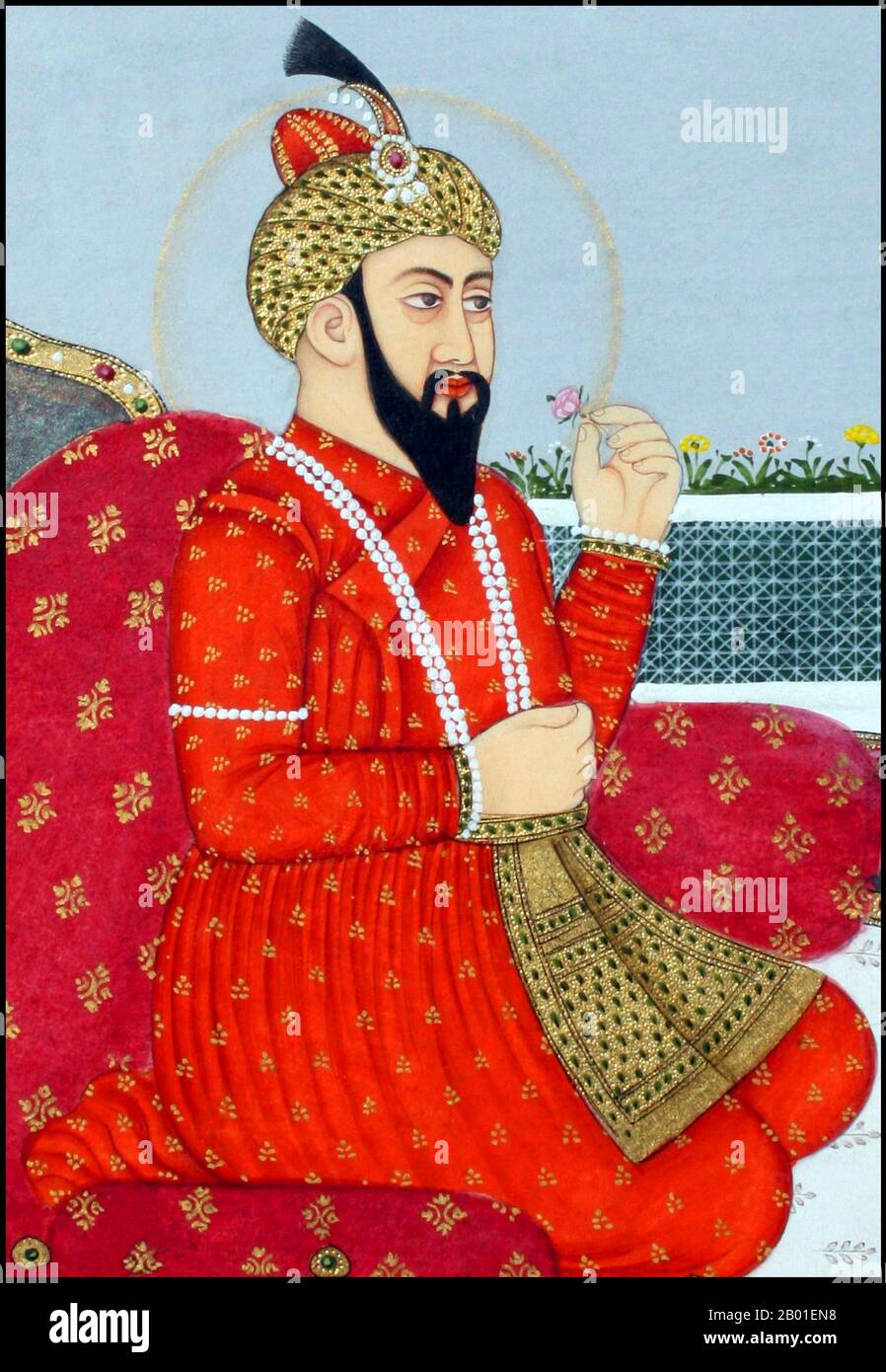 India: Zahir ud-din Muhammad Babur (14 February 1483 - 26 December 1530), first Mughal Emperor. Gouache watercolour painting, late 18th century. Zahir ud-din Muhammad Babur was a Muslim conqueror from Central Asia who, following a series of setbacks, finally succeeded in laying the basis for the Mughal dynasty of South Asia. He was a direct descendant of Timur through his father, and a descendant also of Genghis Khan through his mother. Babur identified his lineage as Timurid and Chaghatay-Turkic, while his origin, milieu, training and culture were steeped in Persian culture. Stock Photohttps://www.alamy.com/image-license-details/?v=1https://www.alamy.com/india-zahir-ud-din-muhammad-babur-14-february-1483-26-december-1530-first-mughal-emperor-gouache-watercolour-painting-late-18th-century-zahir-ud-din-muhammad-babur-was-a-muslim-conqueror-from-central-asia-who-following-a-series-of-setbacks-finally-succeeded-in-laying-the-basis-for-the-mughal-dynasty-of-south-asia-he-was-a-direct-descendant-of-timur-through-his-father-and-a-descendant-also-of-genghis-khan-through-his-mother-babur-identified-his-lineage-as-timurid-and-chaghatay-turkic-while-his-origin-milieu-training-and-culture-were-steeped-in-persian-culture-image344240884.html
India: Zahir ud-din Muhammad Babur (14 February 1483 - 26 December 1530), first Mughal Emperor. Gouache watercolour painting, late 18th century. Zahir ud-din Muhammad Babur was a Muslim conqueror from Central Asia who, following a series of setbacks, finally succeeded in laying the basis for the Mughal dynasty of South Asia. He was a direct descendant of Timur through his father, and a descendant also of Genghis Khan through his mother. Babur identified his lineage as Timurid and Chaghatay-Turkic, while his origin, milieu, training and culture were steeped in Persian culture. Stock Photohttps://www.alamy.com/image-license-details/?v=1https://www.alamy.com/india-zahir-ud-din-muhammad-babur-14-february-1483-26-december-1530-first-mughal-emperor-gouache-watercolour-painting-late-18th-century-zahir-ud-din-muhammad-babur-was-a-muslim-conqueror-from-central-asia-who-following-a-series-of-setbacks-finally-succeeded-in-laying-the-basis-for-the-mughal-dynasty-of-south-asia-he-was-a-direct-descendant-of-timur-through-his-father-and-a-descendant-also-of-genghis-khan-through-his-mother-babur-identified-his-lineage-as-timurid-and-chaghatay-turkic-while-his-origin-milieu-training-and-culture-were-steeped-in-persian-culture-image344240884.htmlRM2B01EN8–India: Zahir ud-din Muhammad Babur (14 February 1483 - 26 December 1530), first Mughal Emperor. Gouache watercolour painting, late 18th century. Zahir ud-din Muhammad Babur was a Muslim conqueror from Central Asia who, following a series of setbacks, finally succeeded in laying the basis for the Mughal dynasty of South Asia. He was a direct descendant of Timur through his father, and a descendant also of Genghis Khan through his mother. Babur identified his lineage as Timurid and Chaghatay-Turkic, while his origin, milieu, training and culture were steeped in Persian culture.
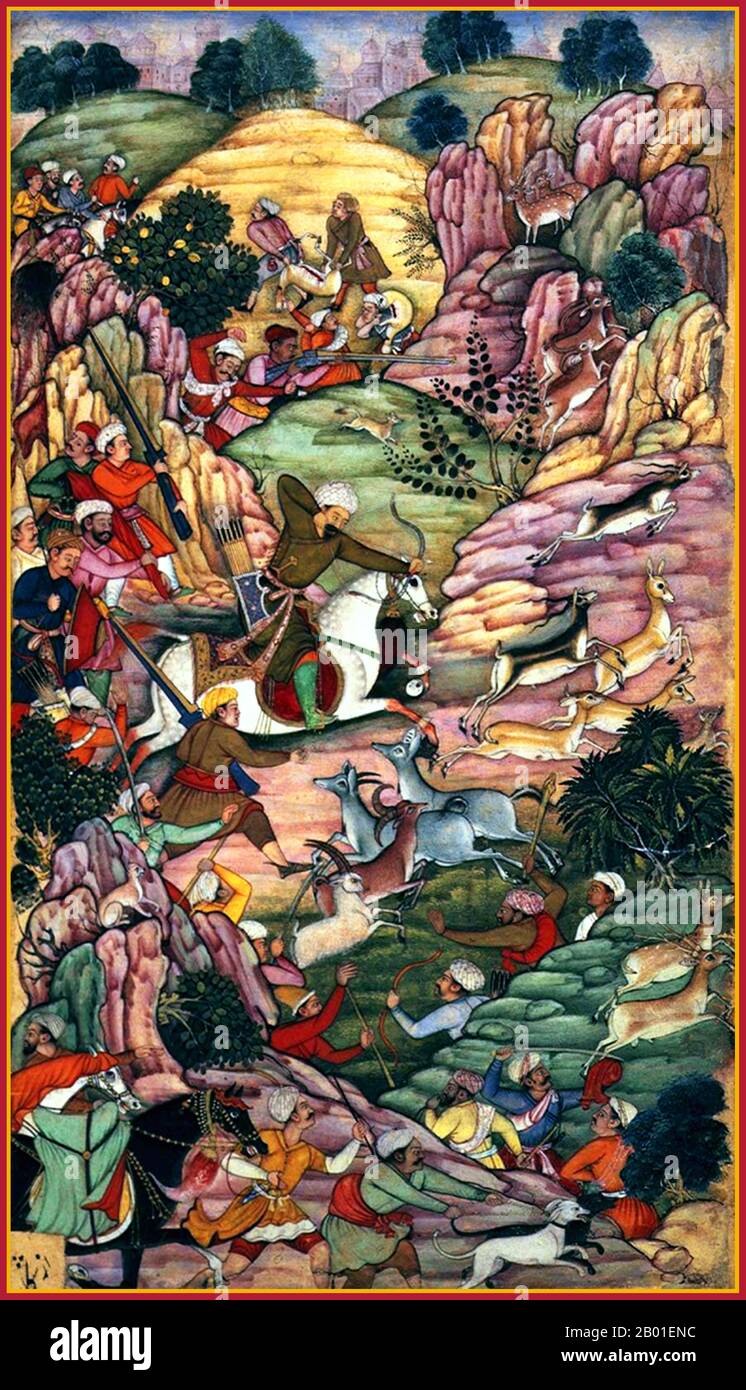 India: Zahir ud-din Muhammad Babur (1483-1531), the first Mughal Emperor, hunting deer near Kabul. Miniature painting from the Babur-namah, c. 1590. Zahir ud-din Muhammad Babur was a Muslim conqueror from Central Asia who, following a series of setbacks, finally succeeded in laying the basis for the Mughal dynasty of South Asia. He was a direct descendant of Timur through his father, and a descendant also of Genghis Khan through his mother. Babur identified his lineage as Timurid and Chaghatay-Turkic, while his origin, milieu, training, and culture were steeped in Persian culture. Stock Photohttps://www.alamy.com/image-license-details/?v=1https://www.alamy.com/india-zahir-ud-din-muhammad-babur-1483-1531-the-first-mughal-emperor-hunting-deer-near-kabul-miniature-painting-from-the-babur-namah-c-1590-zahir-ud-din-muhammad-babur-was-a-muslim-conqueror-from-central-asia-who-following-a-series-of-setbacks-finally-succeeded-in-laying-the-basis-for-the-mughal-dynasty-of-south-asia-he-was-a-direct-descendant-of-timur-through-his-father-and-a-descendant-also-of-genghis-khan-through-his-mother-babur-identified-his-lineage-as-timurid-and-chaghatay-turkic-while-his-origin-milieu-training-and-culture-were-steeped-in-persian-culture-image344240888.html
India: Zahir ud-din Muhammad Babur (1483-1531), the first Mughal Emperor, hunting deer near Kabul. Miniature painting from the Babur-namah, c. 1590. Zahir ud-din Muhammad Babur was a Muslim conqueror from Central Asia who, following a series of setbacks, finally succeeded in laying the basis for the Mughal dynasty of South Asia. He was a direct descendant of Timur through his father, and a descendant also of Genghis Khan through his mother. Babur identified his lineage as Timurid and Chaghatay-Turkic, while his origin, milieu, training, and culture were steeped in Persian culture. Stock Photohttps://www.alamy.com/image-license-details/?v=1https://www.alamy.com/india-zahir-ud-din-muhammad-babur-1483-1531-the-first-mughal-emperor-hunting-deer-near-kabul-miniature-painting-from-the-babur-namah-c-1590-zahir-ud-din-muhammad-babur-was-a-muslim-conqueror-from-central-asia-who-following-a-series-of-setbacks-finally-succeeded-in-laying-the-basis-for-the-mughal-dynasty-of-south-asia-he-was-a-direct-descendant-of-timur-through-his-father-and-a-descendant-also-of-genghis-khan-through-his-mother-babur-identified-his-lineage-as-timurid-and-chaghatay-turkic-while-his-origin-milieu-training-and-culture-were-steeped-in-persian-culture-image344240888.htmlRM2B01ENC–India: Zahir ud-din Muhammad Babur (1483-1531), the first Mughal Emperor, hunting deer near Kabul. Miniature painting from the Babur-namah, c. 1590. Zahir ud-din Muhammad Babur was a Muslim conqueror from Central Asia who, following a series of setbacks, finally succeeded in laying the basis for the Mughal dynasty of South Asia. He was a direct descendant of Timur through his father, and a descendant also of Genghis Khan through his mother. Babur identified his lineage as Timurid and Chaghatay-Turkic, while his origin, milieu, training, and culture were steeped in Persian culture.
 India: The battle of Sultan Ḥusayn Mīrzā against Sultan Masʿūd Mīrzā took place at Hiṣṣār in the winter of 901 AH/1495 CE. Miniature painting from the Baburnama, late 16th century. Bāburnāma (literally: 'Book of Babur' or 'Letters of Babur'; alternatively known as Tuzk-e Babri) is the name given to the memoirs of Ẓahīr ud-Dīn Muḥammad Bābur (1483-1530), founder of the Mughal Empire and a great-great-great-grandson of Timur. It is an autobiographical work, originally written in the Chagatai language, known to Babur as 'Turki' (meaning Turkic), the spoken language of the Andijan-Timurids. Stock Photohttps://www.alamy.com/image-license-details/?v=1https://www.alamy.com/india-the-battle-of-sultan-usayn-mrz-against-sultan-masd-mrz-took-place-at-hir-in-the-winter-of-901-ah1495-ce-miniature-painting-from-the-baburnama-late-16th-century-bburnma-literally-book-of-babur-or-letters-of-babur-alternatively-known-as-tuzk-e-babri-is-the-name-given-to-the-memoirs-of-ahr-ud-dn-muammad-bbur-1483-1530-founder-of-the-mughal-empire-and-a-great-great-great-grandson-of-timur-it-is-an-autobiographical-work-originally-written-in-the-chagatai-language-known-to-babur-as-turki-meaning-turkic-the-spoken-language-of-the-andijan-timurids-image344240912.html
India: The battle of Sultan Ḥusayn Mīrzā against Sultan Masʿūd Mīrzā took place at Hiṣṣār in the winter of 901 AH/1495 CE. Miniature painting from the Baburnama, late 16th century. Bāburnāma (literally: 'Book of Babur' or 'Letters of Babur'; alternatively known as Tuzk-e Babri) is the name given to the memoirs of Ẓahīr ud-Dīn Muḥammad Bābur (1483-1530), founder of the Mughal Empire and a great-great-great-grandson of Timur. It is an autobiographical work, originally written in the Chagatai language, known to Babur as 'Turki' (meaning Turkic), the spoken language of the Andijan-Timurids. Stock Photohttps://www.alamy.com/image-license-details/?v=1https://www.alamy.com/india-the-battle-of-sultan-usayn-mrz-against-sultan-masd-mrz-took-place-at-hir-in-the-winter-of-901-ah1495-ce-miniature-painting-from-the-baburnama-late-16th-century-bburnma-literally-book-of-babur-or-letters-of-babur-alternatively-known-as-tuzk-e-babri-is-the-name-given-to-the-memoirs-of-ahr-ud-dn-muammad-bbur-1483-1530-founder-of-the-mughal-empire-and-a-great-great-great-grandson-of-timur-it-is-an-autobiographical-work-originally-written-in-the-chagatai-language-known-to-babur-as-turki-meaning-turkic-the-spoken-language-of-the-andijan-timurids-image344240912.htmlRM2B01EP8–India: The battle of Sultan Ḥusayn Mīrzā against Sultan Masʿūd Mīrzā took place at Hiṣṣār in the winter of 901 AH/1495 CE. Miniature painting from the Baburnama, late 16th century. Bāburnāma (literally: 'Book of Babur' or 'Letters of Babur'; alternatively known as Tuzk-e Babri) is the name given to the memoirs of Ẓahīr ud-Dīn Muḥammad Bābur (1483-1530), founder of the Mughal Empire and a great-great-great-grandson of Timur. It is an autobiographical work, originally written in the Chagatai language, known to Babur as 'Turki' (meaning Turkic), the spoken language of the Andijan-Timurids.
 . English: Illustrations from the Manuscript of Baburnama (Memoirs of Babur) - Late 16th Century Bāburnāma is the memoirs of Ẓahīr ud-Dīn Muḥammad Bābur (1483-1530), founder of the Mughal Empire and a great-great-great-grandson of Timur. It is an autobiographical work, originally written in the Chagatai language, known to Babur as 'Turki' (meaning Turkic), the spoken language of the Andijan-Timurids. Because of Babur's cultural origin, his prose is highly Persianized in its sentence structure, morphology, and vocabulary,and also contains many phrases and smaller poems in Persian. During Empero Stock Photohttps://www.alamy.com/image-license-details/?v=1https://www.alamy.com/english-illustrations-from-the-manuscript-of-baburnama-memoirs-of-babur-late-16th-century-bburnma-is-the-memoirs-of-ahr-ud-dn-muammad-bbur-1483-1530-founder-of-the-mughal-empire-and-a-great-great-great-grandson-of-timur-it-is-an-autobiographical-work-originally-written-in-the-chagatai-language-known-to-babur-as-turki-meaning-turkic-the-spoken-language-of-the-andijan-timurids-because-of-baburs-cultural-origin-his-prose-is-highly-persianized-in-its-sentence-structure-morphology-and-vocabularyand-also-contains-many-phrases-and-smaller-poems-in-persian-during-empero-image187652081.html
. English: Illustrations from the Manuscript of Baburnama (Memoirs of Babur) - Late 16th Century Bāburnāma is the memoirs of Ẓahīr ud-Dīn Muḥammad Bābur (1483-1530), founder of the Mughal Empire and a great-great-great-grandson of Timur. It is an autobiographical work, originally written in the Chagatai language, known to Babur as 'Turki' (meaning Turkic), the spoken language of the Andijan-Timurids. Because of Babur's cultural origin, his prose is highly Persianized in its sentence structure, morphology, and vocabulary,and also contains many phrases and smaller poems in Persian. During Empero Stock Photohttps://www.alamy.com/image-license-details/?v=1https://www.alamy.com/english-illustrations-from-the-manuscript-of-baburnama-memoirs-of-babur-late-16th-century-bburnma-is-the-memoirs-of-ahr-ud-dn-muammad-bbur-1483-1530-founder-of-the-mughal-empire-and-a-great-great-great-grandson-of-timur-it-is-an-autobiographical-work-originally-written-in-the-chagatai-language-known-to-babur-as-turki-meaning-turkic-the-spoken-language-of-the-andijan-timurids-because-of-baburs-cultural-origin-his-prose-is-highly-persianized-in-its-sentence-structure-morphology-and-vocabularyand-also-contains-many-phrases-and-smaller-poems-in-persian-during-empero-image187652081.htmlRMMW8841–. English: Illustrations from the Manuscript of Baburnama (Memoirs of Babur) - Late 16th Century Bāburnāma is the memoirs of Ẓahīr ud-Dīn Muḥammad Bābur (1483-1530), founder of the Mughal Empire and a great-great-great-grandson of Timur. It is an autobiographical work, originally written in the Chagatai language, known to Babur as 'Turki' (meaning Turkic), the spoken language of the Andijan-Timurids. Because of Babur's cultural origin, his prose is highly Persianized in its sentence structure, morphology, and vocabulary,and also contains many phrases and smaller poems in Persian. During Empero
 India: Animals of Hindustan - starlings, called pandāvalī. Miniature painting from the Baburnama, late 16th century. Bāburnāma (literally: 'Book of Babur' or 'Letters of Babur'; alternatively known as Tuzk-e Babri) is the name given to the memoirs of Ẓahīr ud-Dīn Muḥammad Bābur (1483-1530), founder of the Mughal Empire and a great-great-great-grandson of Timur. It is an autobiographical work, originally written in the Chagatai language, known to Babur as 'Turki' (meaning Turkic), the spoken language of the Andijan-Timurids. Stock Photohttps://www.alamy.com/image-license-details/?v=1https://www.alamy.com/india-animals-of-hindustan-starlings-called-pandval-miniature-painting-from-the-baburnama-late-16th-century-bburnma-literally-book-of-babur-or-letters-of-babur-alternatively-known-as-tuzk-e-babri-is-the-name-given-to-the-memoirs-of-ahr-ud-dn-muammad-bbur-1483-1530-founder-of-the-mughal-empire-and-a-great-great-great-grandson-of-timur-it-is-an-autobiographical-work-originally-written-in-the-chagatai-language-known-to-babur-as-turki-meaning-turkic-the-spoken-language-of-the-andijan-timurids-image344240942.html
India: Animals of Hindustan - starlings, called pandāvalī. Miniature painting from the Baburnama, late 16th century. Bāburnāma (literally: 'Book of Babur' or 'Letters of Babur'; alternatively known as Tuzk-e Babri) is the name given to the memoirs of Ẓahīr ud-Dīn Muḥammad Bābur (1483-1530), founder of the Mughal Empire and a great-great-great-grandson of Timur. It is an autobiographical work, originally written in the Chagatai language, known to Babur as 'Turki' (meaning Turkic), the spoken language of the Andijan-Timurids. Stock Photohttps://www.alamy.com/image-license-details/?v=1https://www.alamy.com/india-animals-of-hindustan-starlings-called-pandval-miniature-painting-from-the-baburnama-late-16th-century-bburnma-literally-book-of-babur-or-letters-of-babur-alternatively-known-as-tuzk-e-babri-is-the-name-given-to-the-memoirs-of-ahr-ud-dn-muammad-bbur-1483-1530-founder-of-the-mughal-empire-and-a-great-great-great-grandson-of-timur-it-is-an-autobiographical-work-originally-written-in-the-chagatai-language-known-to-babur-as-turki-meaning-turkic-the-spoken-language-of-the-andijan-timurids-image344240942.htmlRM2B01ERA–India: Animals of Hindustan - starlings, called pandāvalī. Miniature painting from the Baburnama, late 16th century. Bāburnāma (literally: 'Book of Babur' or 'Letters of Babur'; alternatively known as Tuzk-e Babri) is the name given to the memoirs of Ẓahīr ud-Dīn Muḥammad Bābur (1483-1530), founder of the Mughal Empire and a great-great-great-grandson of Timur. It is an autobiographical work, originally written in the Chagatai language, known to Babur as 'Turki' (meaning Turkic), the spoken language of the Andijan-Timurids.
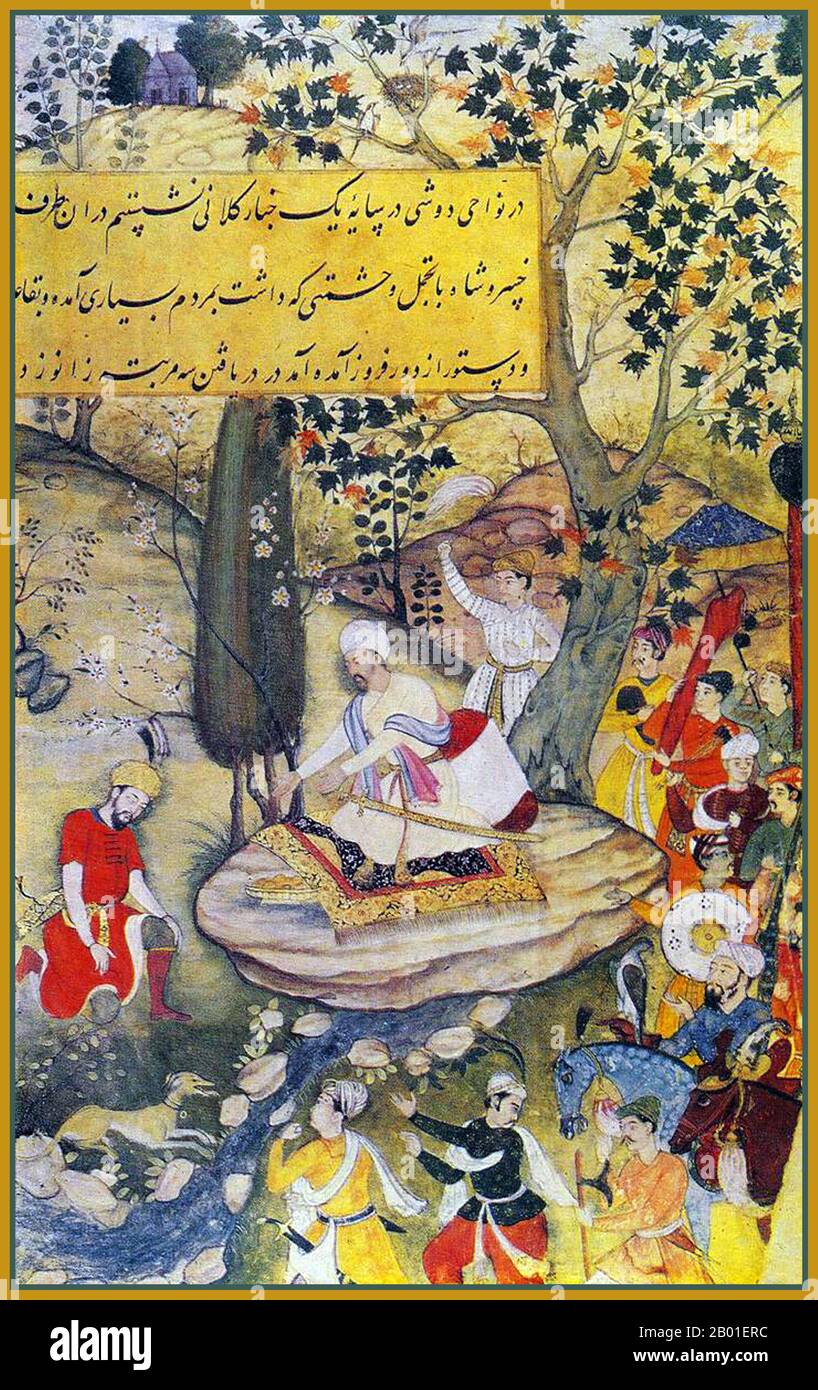 India: Khusrau Shah swearing fealty to Babur. Miniature painting from the Baburnama, c. 1590. Bāburnāma (literally: 'Book of Babur' or 'Letters of Babur'; alternatively known as Tuzk-e Babri) is the name given to the memoirs of Ẓahīr ud-Dīn Muḥammad Bābur (1483-1530), founder of the Mughal Empire and a great-great-great-grandson of Timur. It is an autobiographical work, originally written in the Chagatai language, known to Babur as 'Turki' (meaning Turkic), the spoken language of the Andijan-Timurids. Stock Photohttps://www.alamy.com/image-license-details/?v=1https://www.alamy.com/india-khusrau-shah-swearing-fealty-to-babur-miniature-painting-from-the-baburnama-c-1590-bburnma-literally-book-of-babur-or-letters-of-babur-alternatively-known-as-tuzk-e-babri-is-the-name-given-to-the-memoirs-of-ahr-ud-dn-muammad-bbur-1483-1530-founder-of-the-mughal-empire-and-a-great-great-great-grandson-of-timur-it-is-an-autobiographical-work-originally-written-in-the-chagatai-language-known-to-babur-as-turki-meaning-turkic-the-spoken-language-of-the-andijan-timurids-image344240944.html
India: Khusrau Shah swearing fealty to Babur. Miniature painting from the Baburnama, c. 1590. Bāburnāma (literally: 'Book of Babur' or 'Letters of Babur'; alternatively known as Tuzk-e Babri) is the name given to the memoirs of Ẓahīr ud-Dīn Muḥammad Bābur (1483-1530), founder of the Mughal Empire and a great-great-great-grandson of Timur. It is an autobiographical work, originally written in the Chagatai language, known to Babur as 'Turki' (meaning Turkic), the spoken language of the Andijan-Timurids. Stock Photohttps://www.alamy.com/image-license-details/?v=1https://www.alamy.com/india-khusrau-shah-swearing-fealty-to-babur-miniature-painting-from-the-baburnama-c-1590-bburnma-literally-book-of-babur-or-letters-of-babur-alternatively-known-as-tuzk-e-babri-is-the-name-given-to-the-memoirs-of-ahr-ud-dn-muammad-bbur-1483-1530-founder-of-the-mughal-empire-and-a-great-great-great-grandson-of-timur-it-is-an-autobiographical-work-originally-written-in-the-chagatai-language-known-to-babur-as-turki-meaning-turkic-the-spoken-language-of-the-andijan-timurids-image344240944.htmlRM2B01ERC–India: Khusrau Shah swearing fealty to Babur. Miniature painting from the Baburnama, c. 1590. Bāburnāma (literally: 'Book of Babur' or 'Letters of Babur'; alternatively known as Tuzk-e Babri) is the name given to the memoirs of Ẓahīr ud-Dīn Muḥammad Bābur (1483-1530), founder of the Mughal Empire and a great-great-great-grandson of Timur. It is an autobiographical work, originally written in the Chagatai language, known to Babur as 'Turki' (meaning Turkic), the spoken language of the Andijan-Timurids.
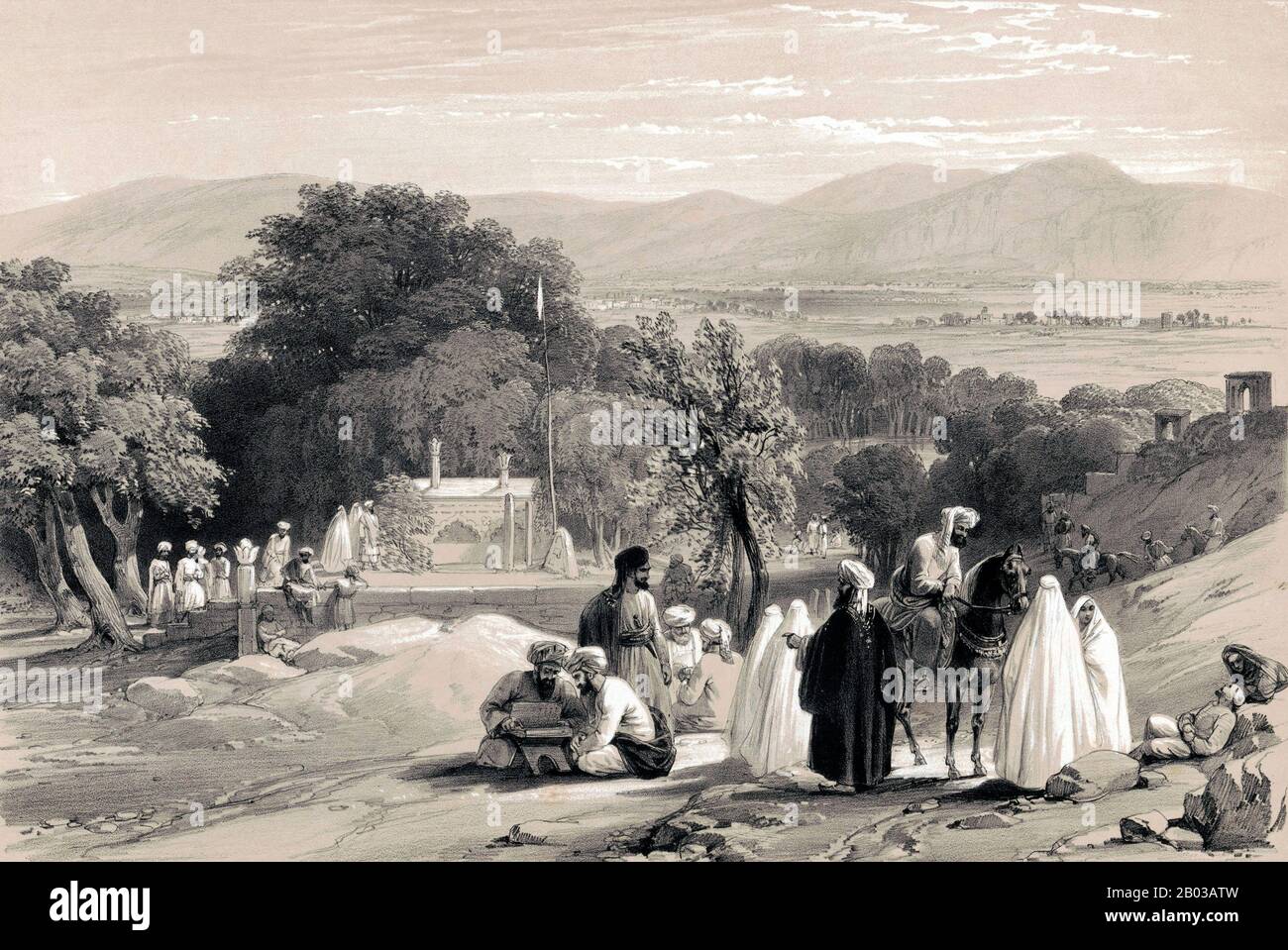 Zahir ud-din Muhammad Babur was a Muslim conqueror from Central Asia who, following a series of setbacks, finally succeeded in laying the basis for the Mughal dynasty of South Asia. He was a direct descendant of Timur through his father, and a descendant also of Genghis Khan through his mother. Stock Photohttps://www.alamy.com/image-license-details/?v=1https://www.alamy.com/zahir-ud-din-muhammad-babur-was-a-muslim-conqueror-from-central-asia-who-following-a-series-of-setbacks-finally-succeeded-in-laying-the-basis-for-the-mughal-dynasty-of-south-asia-he-was-a-direct-descendant-of-timur-through-his-father-and-a-descendant-also-of-genghis-khan-through-his-mother-image344281753.html
Zahir ud-din Muhammad Babur was a Muslim conqueror from Central Asia who, following a series of setbacks, finally succeeded in laying the basis for the Mughal dynasty of South Asia. He was a direct descendant of Timur through his father, and a descendant also of Genghis Khan through his mother. Stock Photohttps://www.alamy.com/image-license-details/?v=1https://www.alamy.com/zahir-ud-din-muhammad-babur-was-a-muslim-conqueror-from-central-asia-who-following-a-series-of-setbacks-finally-succeeded-in-laying-the-basis-for-the-mughal-dynasty-of-south-asia-he-was-a-direct-descendant-of-timur-through-his-father-and-a-descendant-also-of-genghis-khan-through-his-mother-image344281753.htmlRM2B03ATW–Zahir ud-din Muhammad Babur was a Muslim conqueror from Central Asia who, following a series of setbacks, finally succeeded in laying the basis for the Mughal dynasty of South Asia. He was a direct descendant of Timur through his father, and a descendant also of Genghis Khan through his mother.
 . English: Illustrations from the Manuscript of Baburnama (Memoirs of Babur) - Late 16th Century Bāburnāma is the memoirs of Ẓahīr ud-Dīn Muḥammad Bābur (1483-1530), founder of the Mughal Empire and a great-great-great-grandson of Timur. It is an autobiographical work, originally written in the Chagatai language, known to Babur as 'Turki' (meaning Turkic), the spoken language of the Andijan-Timurids. Because of Babur's cultural origin, his prose is highly Persianized in its sentence structure, morphology, and vocabulary,and also contains many phrases and smaller poems in Persian. During Empero Stock Photohttps://www.alamy.com/image-license-details/?v=1https://www.alamy.com/english-illustrations-from-the-manuscript-of-baburnama-memoirs-of-babur-late-16th-century-bburnma-is-the-memoirs-of-ahr-ud-dn-muammad-bbur-1483-1530-founder-of-the-mughal-empire-and-a-great-great-great-grandson-of-timur-it-is-an-autobiographical-work-originally-written-in-the-chagatai-language-known-to-babur-as-turki-meaning-turkic-the-spoken-language-of-the-andijan-timurids-because-of-baburs-cultural-origin-his-prose-is-highly-persianized-in-its-sentence-structure-morphology-and-vocabularyand-also-contains-many-phrases-and-smaller-poems-in-persian-during-empero-image188192563.html
. English: Illustrations from the Manuscript of Baburnama (Memoirs of Babur) - Late 16th Century Bāburnāma is the memoirs of Ẓahīr ud-Dīn Muḥammad Bābur (1483-1530), founder of the Mughal Empire and a great-great-great-grandson of Timur. It is an autobiographical work, originally written in the Chagatai language, known to Babur as 'Turki' (meaning Turkic), the spoken language of the Andijan-Timurids. Because of Babur's cultural origin, his prose is highly Persianized in its sentence structure, morphology, and vocabulary,and also contains many phrases and smaller poems in Persian. During Empero Stock Photohttps://www.alamy.com/image-license-details/?v=1https://www.alamy.com/english-illustrations-from-the-manuscript-of-baburnama-memoirs-of-babur-late-16th-century-bburnma-is-the-memoirs-of-ahr-ud-dn-muammad-bbur-1483-1530-founder-of-the-mughal-empire-and-a-great-great-great-grandson-of-timur-it-is-an-autobiographical-work-originally-written-in-the-chagatai-language-known-to-babur-as-turki-meaning-turkic-the-spoken-language-of-the-andijan-timurids-because-of-baburs-cultural-origin-his-prose-is-highly-persianized-in-its-sentence-structure-morphology-and-vocabularyand-also-contains-many-phrases-and-smaller-poems-in-persian-during-empero-image188192563.htmlRMMX4WEY–. English: Illustrations from the Manuscript of Baburnama (Memoirs of Babur) - Late 16th Century Bāburnāma is the memoirs of Ẓahīr ud-Dīn Muḥammad Bābur (1483-1530), founder of the Mughal Empire and a great-great-great-grandson of Timur. It is an autobiographical work, originally written in the Chagatai language, known to Babur as 'Turki' (meaning Turkic), the spoken language of the Andijan-Timurids. Because of Babur's cultural origin, his prose is highly Persianized in its sentence structure, morphology, and vocabulary,and also contains many phrases and smaller poems in Persian. During Empero
 Babur and His Warriors Visiting a Hindu Temple . English: In this folio from Walters manuscript W.596, Babur and his warriors are depicted visiting the Hindu temple Gurh Kattri (Kur Katri) in Bigram. English: Illustrations from the Manuscript of Baburnama (Memoirs of Babur) - Late 16th Century Bāburnāma is the memoirs of Ẓahīr ud-Dīn Muḥammad Bābur (1483-1530), founder of the Mughal Empire and a great-great-great-grandson of Timur. It is an autobiographical work, originally written in the Chagatai language, known to Babur as 'Turki' (meaning Turkic), the spoken language of the Andijan-Timurid Stock Photohttps://www.alamy.com/image-license-details/?v=1https://www.alamy.com/babur-and-his-warriors-visiting-a-hindu-temple-english-in-this-folio-from-walters-manuscript-w596-babur-and-his-warriors-are-depicted-visiting-the-hindu-temple-gurh-kattri-kur-katri-in-bigram-english-illustrations-from-the-manuscript-of-baburnama-memoirs-of-babur-late-16th-century-bburnma-is-the-memoirs-of-ahr-ud-dn-muammad-bbur-1483-1530-founder-of-the-mughal-empire-and-a-great-great-great-grandson-of-timur-it-is-an-autobiographical-work-originally-written-in-the-chagatai-language-known-to-babur-as-turki-meaning-turkic-the-spoken-language-of-the-andijan-timurid-image185616095.html
Babur and His Warriors Visiting a Hindu Temple . English: In this folio from Walters manuscript W.596, Babur and his warriors are depicted visiting the Hindu temple Gurh Kattri (Kur Katri) in Bigram. English: Illustrations from the Manuscript of Baburnama (Memoirs of Babur) - Late 16th Century Bāburnāma is the memoirs of Ẓahīr ud-Dīn Muḥammad Bābur (1483-1530), founder of the Mughal Empire and a great-great-great-grandson of Timur. It is an autobiographical work, originally written in the Chagatai language, known to Babur as 'Turki' (meaning Turkic), the spoken language of the Andijan-Timurid Stock Photohttps://www.alamy.com/image-license-details/?v=1https://www.alamy.com/babur-and-his-warriors-visiting-a-hindu-temple-english-in-this-folio-from-walters-manuscript-w596-babur-and-his-warriors-are-depicted-visiting-the-hindu-temple-gurh-kattri-kur-katri-in-bigram-english-illustrations-from-the-manuscript-of-baburnama-memoirs-of-babur-late-16th-century-bburnma-is-the-memoirs-of-ahr-ud-dn-muammad-bbur-1483-1530-founder-of-the-mughal-empire-and-a-great-great-great-grandson-of-timur-it-is-an-autobiographical-work-originally-written-in-the-chagatai-language-known-to-babur-as-turki-meaning-turkic-the-spoken-language-of-the-andijan-timurid-image185616095.htmlRMMNYF67–Babur and His Warriors Visiting a Hindu Temple . English: In this folio from Walters manuscript W.596, Babur and his warriors are depicted visiting the Hindu temple Gurh Kattri (Kur Katri) in Bigram. English: Illustrations from the Manuscript of Baburnama (Memoirs of Babur) - Late 16th Century Bāburnāma is the memoirs of Ẓahīr ud-Dīn Muḥammad Bābur (1483-1530), founder of the Mughal Empire and a great-great-great-grandson of Timur. It is an autobiographical work, originally written in the Chagatai language, known to Babur as 'Turki' (meaning Turkic), the spoken language of the Andijan-Timurid
 Babur Confronting his Enemies . English: This scene from Walters manuscript W.596 depicts the Mughal emperor Babur with his brave companions, confronting their enemies in the mountains of Kharabuk and Pashamun. The text refers to Babur and his few men deciding to charge the enemy, who stand immobile. . 16th century AD (Mughal; Timurid). Babur (1483–1530) Alternative names Zahir-ud-din Muhammad Babur, Baber, Babar, فارسی: بابر Description Uzbekistani emperor Mughal emperor Date of birth/death 14 February 1483 26 December 1530 Location of birth/death Andijan Agra Authority control Stock Photohttps://www.alamy.com/image-license-details/?v=1https://www.alamy.com/babur-confronting-his-enemies-english-this-scene-from-walters-manuscript-w596-depicts-the-mughal-emperor-babur-with-his-brave-companions-confronting-their-enemies-in-the-mountains-of-kharabuk-and-pashamun-the-text-refers-to-babur-and-his-few-men-deciding-to-charge-the-enemy-who-stand-immobile-16th-century-ad-mughal-timurid-babur-14831530-alternative-names-zahir-ud-din-muhammad-babur-baber-babar-description-uzbekistani-emperor-mughal-emperor-date-of-birthdeath-14-february-1483-26-december-1530-location-of-birthdeath-andijan-agra-authority-control-image185616099.html
Babur Confronting his Enemies . English: This scene from Walters manuscript W.596 depicts the Mughal emperor Babur with his brave companions, confronting their enemies in the mountains of Kharabuk and Pashamun. The text refers to Babur and his few men deciding to charge the enemy, who stand immobile. . 16th century AD (Mughal; Timurid). Babur (1483–1530) Alternative names Zahir-ud-din Muhammad Babur, Baber, Babar, فارسی: بابر Description Uzbekistani emperor Mughal emperor Date of birth/death 14 February 1483 26 December 1530 Location of birth/death Andijan Agra Authority control Stock Photohttps://www.alamy.com/image-license-details/?v=1https://www.alamy.com/babur-confronting-his-enemies-english-this-scene-from-walters-manuscript-w596-depicts-the-mughal-emperor-babur-with-his-brave-companions-confronting-their-enemies-in-the-mountains-of-kharabuk-and-pashamun-the-text-refers-to-babur-and-his-few-men-deciding-to-charge-the-enemy-who-stand-immobile-16th-century-ad-mughal-timurid-babur-14831530-alternative-names-zahir-ud-din-muhammad-babur-baber-babar-description-uzbekistani-emperor-mughal-emperor-date-of-birthdeath-14-february-1483-26-december-1530-location-of-birthdeath-andijan-agra-authority-control-image185616099.htmlRMMNYF6B–Babur Confronting his Enemies . English: This scene from Walters manuscript W.596 depicts the Mughal emperor Babur with his brave companions, confronting their enemies in the mountains of Kharabuk and Pashamun. The text refers to Babur and his few men deciding to charge the enemy, who stand immobile. . 16th century AD (Mughal; Timurid). Babur (1483–1530) Alternative names Zahir-ud-din Muhammad Babur, Baber, Babar, فارسی: بابر Description Uzbekistani emperor Mughal emperor Date of birth/death 14 February 1483 26 December 1530 Location of birth/death Andijan Agra Authority control
 Birds of Hindustan: Luchas, Called Buqalamun, and Partridges . English: This folio from Walters manuscript W.596 depicts birds of Hindustan: luchas, called buqalamun, and partridges. . 16th century AD (Mughal; Timurid). Babur (1483–1530) Alternative names Zahir-ud-din Muhammad Babur, Baber, Babar, فارسی: بابر Description Uzbekistani emperor Mughal emperor Date of birth/death 14 February 1483 26 December 1530 Location of birth/death Andijan Agra Authority control : Q797848 VIAF: 97090468 ISNI: 0000 0001 0845 1285 ULAN: 500212753 LCCN: n50053659 GND: 118841807 WorldCat 1280 Zahir Stock Photohttps://www.alamy.com/image-license-details/?v=1https://www.alamy.com/birds-of-hindustan-luchas-called-buqalamun-and-partridges-english-this-folio-from-walters-manuscript-w596-depicts-birds-of-hindustan-luchas-called-buqalamun-and-partridges-16th-century-ad-mughal-timurid-babur-14831530-alternative-names-zahir-ud-din-muhammad-babur-baber-babar-description-uzbekistani-emperor-mughal-emperor-date-of-birthdeath-14-february-1483-26-december-1530-location-of-birthdeath-andijan-agra-authority-control-q797848-viaf97090468-isni0000-0001-0845-1285-ulan500212753-lccnn50053659-gnd118841807-worldcat-1280-zahir-image185616103.html
Birds of Hindustan: Luchas, Called Buqalamun, and Partridges . English: This folio from Walters manuscript W.596 depicts birds of Hindustan: luchas, called buqalamun, and partridges. . 16th century AD (Mughal; Timurid). Babur (1483–1530) Alternative names Zahir-ud-din Muhammad Babur, Baber, Babar, فارسی: بابر Description Uzbekistani emperor Mughal emperor Date of birth/death 14 February 1483 26 December 1530 Location of birth/death Andijan Agra Authority control : Q797848 VIAF: 97090468 ISNI: 0000 0001 0845 1285 ULAN: 500212753 LCCN: n50053659 GND: 118841807 WorldCat 1280 Zahir Stock Photohttps://www.alamy.com/image-license-details/?v=1https://www.alamy.com/birds-of-hindustan-luchas-called-buqalamun-and-partridges-english-this-folio-from-walters-manuscript-w596-depicts-birds-of-hindustan-luchas-called-buqalamun-and-partridges-16th-century-ad-mughal-timurid-babur-14831530-alternative-names-zahir-ud-din-muhammad-babur-baber-babar-description-uzbekistani-emperor-mughal-emperor-date-of-birthdeath-14-february-1483-26-december-1530-location-of-birthdeath-andijan-agra-authority-control-q797848-viaf97090468-isni0000-0001-0845-1285-ulan500212753-lccnn50053659-gnd118841807-worldcat-1280-zahir-image185616103.htmlRMMNYF6F–Birds of Hindustan: Luchas, Called Buqalamun, and Partridges . English: This folio from Walters manuscript W.596 depicts birds of Hindustan: luchas, called buqalamun, and partridges. . 16th century AD (Mughal; Timurid). Babur (1483–1530) Alternative names Zahir-ud-din Muhammad Babur, Baber, Babar, فارسی: بابر Description Uzbekistani emperor Mughal emperor Date of birth/death 14 February 1483 26 December 1530 Location of birth/death Andijan Agra Authority control : Q797848 VIAF: 97090468 ISNI: 0000 0001 0845 1285 ULAN: 500212753 LCCN: n50053659 GND: 118841807 WorldCat 1280 Zahir
 Babur, on the Way to Hindustan, Camping at Jam . English: On this folio from Walters manuscript W.596, Babur, on the way to Hindustan, camps at Jam, explores Bigram, and inquires about the Hindu temple Gurh Kattriand with the help of his guide Malik Bu Sa'id Kamari. . 16th century AD (Mughal; Timurid). Babur (1483–1530) Alternative names Zahir-ud-din Muhammad Babur, Baber, Babar, فارسی: بابر Description Uzbekistani emperor Mughal emperor Date of birth/death 14 February 1483 26 December 1530 Location of birth/death Andijan Agra Authority control : Q797848 VIAF: 97090468 ISNI: 00 Stock Photohttps://www.alamy.com/image-license-details/?v=1https://www.alamy.com/babur-on-the-way-to-hindustan-camping-at-jam-english-on-this-folio-from-walters-manuscript-w596-babur-on-the-way-to-hindustan-camps-at-jam-explores-bigram-and-inquires-about-the-hindu-temple-gurh-kattriand-with-the-help-of-his-guide-malik-bu-said-kamari-16th-century-ad-mughal-timurid-babur-14831530-alternative-names-zahir-ud-din-muhammad-babur-baber-babar-description-uzbekistani-emperor-mughal-emperor-date-of-birthdeath-14-february-1483-26-december-1530-location-of-birthdeath-andijan-agra-authority-control-q797848-viaf97090468-isni00-image185616100.html
Babur, on the Way to Hindustan, Camping at Jam . English: On this folio from Walters manuscript W.596, Babur, on the way to Hindustan, camps at Jam, explores Bigram, and inquires about the Hindu temple Gurh Kattriand with the help of his guide Malik Bu Sa'id Kamari. . 16th century AD (Mughal; Timurid). Babur (1483–1530) Alternative names Zahir-ud-din Muhammad Babur, Baber, Babar, فارسی: بابر Description Uzbekistani emperor Mughal emperor Date of birth/death 14 February 1483 26 December 1530 Location of birth/death Andijan Agra Authority control : Q797848 VIAF: 97090468 ISNI: 00 Stock Photohttps://www.alamy.com/image-license-details/?v=1https://www.alamy.com/babur-on-the-way-to-hindustan-camping-at-jam-english-on-this-folio-from-walters-manuscript-w596-babur-on-the-way-to-hindustan-camps-at-jam-explores-bigram-and-inquires-about-the-hindu-temple-gurh-kattriand-with-the-help-of-his-guide-malik-bu-said-kamari-16th-century-ad-mughal-timurid-babur-14831530-alternative-names-zahir-ud-din-muhammad-babur-baber-babar-description-uzbekistani-emperor-mughal-emperor-date-of-birthdeath-14-february-1483-26-december-1530-location-of-birthdeath-andijan-agra-authority-control-q797848-viaf97090468-isni00-image185616100.htmlRMMNYF6C–Babur, on the Way to Hindustan, Camping at Jam . English: On this folio from Walters manuscript W.596, Babur, on the way to Hindustan, camps at Jam, explores Bigram, and inquires about the Hindu temple Gurh Kattriand with the help of his guide Malik Bu Sa'id Kamari. . 16th century AD (Mughal; Timurid). Babur (1483–1530) Alternative names Zahir-ud-din Muhammad Babur, Baber, Babar, فارسی: بابر Description Uzbekistani emperor Mughal emperor Date of birth/death 14 February 1483 26 December 1530 Location of birth/death Andijan Agra Authority control : Q797848 VIAF: 97090468 ISNI: 00
 The Battle of Panipat . English: This scene from Walters manuscript W.596 depicts the battle of Panipat at which Sultan Ibrahim, the last of the Lodi Sultans of Delhi, dies. . 16th century AD (Mughal; Timurid). Babur (1483–1530) Alternative names Zahir-ud-din Muhammad Babur, Baber, Babar, فارسی: بابر Description Uzbekistani emperor Mughal emperor Date of birth/death 14 February 1483 26 December 1530 Location of birth/death Andijan Agra Authority control : Q797848 VIAF: 97090468 ISNI: 0000 0001 0845 1285 ULAN: 500212753 LCCN: n50053659 GND: 118841807 WorldCat 1280 Zahir al-Din M Stock Photohttps://www.alamy.com/image-license-details/?v=1https://www.alamy.com/the-battle-of-panipat-english-this-scene-from-walters-manuscript-w596-depicts-the-battle-of-panipat-at-which-sultan-ibrahim-the-last-of-the-lodi-sultans-of-delhi-dies-16th-century-ad-mughal-timurid-babur-14831530-alternative-names-zahir-ud-din-muhammad-babur-baber-babar-description-uzbekistani-emperor-mughal-emperor-date-of-birthdeath-14-february-1483-26-december-1530-location-of-birthdeath-andijan-agra-authority-control-q797848-viaf97090468-isni0000-0001-0845-1285-ulan500212753-lccnn50053659-gnd118841807-worldcat-1280-zahir-al-din-m-image185616126.html
The Battle of Panipat . English: This scene from Walters manuscript W.596 depicts the battle of Panipat at which Sultan Ibrahim, the last of the Lodi Sultans of Delhi, dies. . 16th century AD (Mughal; Timurid). Babur (1483–1530) Alternative names Zahir-ud-din Muhammad Babur, Baber, Babar, فارسی: بابر Description Uzbekistani emperor Mughal emperor Date of birth/death 14 February 1483 26 December 1530 Location of birth/death Andijan Agra Authority control : Q797848 VIAF: 97090468 ISNI: 0000 0001 0845 1285 ULAN: 500212753 LCCN: n50053659 GND: 118841807 WorldCat 1280 Zahir al-Din M Stock Photohttps://www.alamy.com/image-license-details/?v=1https://www.alamy.com/the-battle-of-panipat-english-this-scene-from-walters-manuscript-w596-depicts-the-battle-of-panipat-at-which-sultan-ibrahim-the-last-of-the-lodi-sultans-of-delhi-dies-16th-century-ad-mughal-timurid-babur-14831530-alternative-names-zahir-ud-din-muhammad-babur-baber-babar-description-uzbekistani-emperor-mughal-emperor-date-of-birthdeath-14-february-1483-26-december-1530-location-of-birthdeath-andijan-agra-authority-control-q797848-viaf97090468-isni0000-0001-0845-1285-ulan500212753-lccnn50053659-gnd118841807-worldcat-1280-zahir-al-din-m-image185616126.htmlRMMNYF7A–The Battle of Panipat . English: This scene from Walters manuscript W.596 depicts the battle of Panipat at which Sultan Ibrahim, the last of the Lodi Sultans of Delhi, dies. . 16th century AD (Mughal; Timurid). Babur (1483–1530) Alternative names Zahir-ud-din Muhammad Babur, Baber, Babar, فارسی: بابر Description Uzbekistani emperor Mughal emperor Date of birth/death 14 February 1483 26 December 1530 Location of birth/death Andijan Agra Authority control : Q797848 VIAF: 97090468 ISNI: 0000 0001 0845 1285 ULAN: 500212753 LCCN: n50053659 GND: 118841807 WorldCat 1280 Zahir al-Din M
 Final Phase of the Battle of Kandahar on the Side of the Murghan Mountain . English: This folio from Walters manuscript W.596 depicts the final phase of the battle of Kandahar on the side of the Murghan mountain. . 16th century AD (Mughal; Timurid). Babur (1483–1530) Alternative names Zahir-ud-din Muhammad Babur, Baber, Babar, فارسی: بابر Description Uzbekistani emperor Mughal emperor Date of birth/death 14 February 1483 26 December 1530 Location of birth/death Andijan Agra Authority control : Q797848 VIAF: 97090468 ISNI: 0000 0001 0845 1285 ULAN: 500212753 LCCN: n50053659 GND: Stock Photohttps://www.alamy.com/image-license-details/?v=1https://www.alamy.com/final-phase-of-the-battle-of-kandahar-on-the-side-of-the-murghan-mountain-english-this-folio-from-walters-manuscript-w596-depicts-the-final-phase-of-the-battle-of-kandahar-on-the-side-of-the-murghan-mountain-16th-century-ad-mughal-timurid-babur-14831530-alternative-names-zahir-ud-din-muhammad-babur-baber-babar-description-uzbekistani-emperor-mughal-emperor-date-of-birthdeath-14-february-1483-26-december-1530-location-of-birthdeath-andijan-agra-authority-control-q797848-viaf97090468-isni0000-0001-0845-1285-ulan500212753-lccnn50053659-gnd-image185616109.html
Final Phase of the Battle of Kandahar on the Side of the Murghan Mountain . English: This folio from Walters manuscript W.596 depicts the final phase of the battle of Kandahar on the side of the Murghan mountain. . 16th century AD (Mughal; Timurid). Babur (1483–1530) Alternative names Zahir-ud-din Muhammad Babur, Baber, Babar, فارسی: بابر Description Uzbekistani emperor Mughal emperor Date of birth/death 14 February 1483 26 December 1530 Location of birth/death Andijan Agra Authority control : Q797848 VIAF: 97090468 ISNI: 0000 0001 0845 1285 ULAN: 500212753 LCCN: n50053659 GND: Stock Photohttps://www.alamy.com/image-license-details/?v=1https://www.alamy.com/final-phase-of-the-battle-of-kandahar-on-the-side-of-the-murghan-mountain-english-this-folio-from-walters-manuscript-w596-depicts-the-final-phase-of-the-battle-of-kandahar-on-the-side-of-the-murghan-mountain-16th-century-ad-mughal-timurid-babur-14831530-alternative-names-zahir-ud-din-muhammad-babur-baber-babar-description-uzbekistani-emperor-mughal-emperor-date-of-birthdeath-14-february-1483-26-december-1530-location-of-birthdeath-andijan-agra-authority-control-q797848-viaf97090468-isni0000-0001-0845-1285-ulan500212753-lccnn50053659-gnd-image185616109.htmlRMMNYF6N–Final Phase of the Battle of Kandahar on the Side of the Murghan Mountain . English: This folio from Walters manuscript W.596 depicts the final phase of the battle of Kandahar on the side of the Murghan mountain. . 16th century AD (Mughal; Timurid). Babur (1483–1530) Alternative names Zahir-ud-din Muhammad Babur, Baber, Babar, فارسی: بابر Description Uzbekistani emperor Mughal emperor Date of birth/death 14 February 1483 26 December 1530 Location of birth/death Andijan Agra Authority control : Q797848 VIAF: 97090468 ISNI: 0000 0001 0845 1285 ULAN: 500212753 LCCN: n50053659 GND:
 Birds of Hindustan and Alligators . English: This folio from Walters manuscript W.596 depicts birds of Hindustan, such as crows, magpies, and cuckoos shown living beside the water, where are found alligators. . 16th century AD (Mughal; Timurid). Babur (1483–1530) Alternative names Zahir-ud-din Muhammad Babur, Baber, Babar, فارسی: بابر Description Uzbekistani emperor Mughal emperor Date of birth/death 14 February 1483 26 December 1530 Location of birth/death Andijan Agra Authority control : Q797848 VIAF: 97090468 ISNI: 0000 0001 0845 1285 ULAN: 500212753 LCCN: n50053659 GND: 118 Stock Photohttps://www.alamy.com/image-license-details/?v=1https://www.alamy.com/birds-of-hindustan-and-alligators-english-this-folio-from-walters-manuscript-w596-depicts-birds-of-hindustan-such-as-crows-magpies-and-cuckoos-shown-living-beside-the-water-where-are-found-alligators-16th-century-ad-mughal-timurid-babur-14831530-alternative-names-zahir-ud-din-muhammad-babur-baber-babar-description-uzbekistani-emperor-mughal-emperor-date-of-birthdeath-14-february-1483-26-december-1530-location-of-birthdeath-andijan-agra-authority-control-q797848-viaf97090468-isni0000-0001-0845-1285-ulan500212753-lccnn50053659-gnd118-image185616105.html
Birds of Hindustan and Alligators . English: This folio from Walters manuscript W.596 depicts birds of Hindustan, such as crows, magpies, and cuckoos shown living beside the water, where are found alligators. . 16th century AD (Mughal; Timurid). Babur (1483–1530) Alternative names Zahir-ud-din Muhammad Babur, Baber, Babar, فارسی: بابر Description Uzbekistani emperor Mughal emperor Date of birth/death 14 February 1483 26 December 1530 Location of birth/death Andijan Agra Authority control : Q797848 VIAF: 97090468 ISNI: 0000 0001 0845 1285 ULAN: 500212753 LCCN: n50053659 GND: 118 Stock Photohttps://www.alamy.com/image-license-details/?v=1https://www.alamy.com/birds-of-hindustan-and-alligators-english-this-folio-from-walters-manuscript-w596-depicts-birds-of-hindustan-such-as-crows-magpies-and-cuckoos-shown-living-beside-the-water-where-are-found-alligators-16th-century-ad-mughal-timurid-babur-14831530-alternative-names-zahir-ud-din-muhammad-babur-baber-babar-description-uzbekistani-emperor-mughal-emperor-date-of-birthdeath-14-february-1483-26-december-1530-location-of-birthdeath-andijan-agra-authority-control-q797848-viaf97090468-isni0000-0001-0845-1285-ulan500212753-lccnn50053659-gnd118-image185616105.htmlRMMNYF6H–Birds of Hindustan and Alligators . English: This folio from Walters manuscript W.596 depicts birds of Hindustan, such as crows, magpies, and cuckoos shown living beside the water, where are found alligators. . 16th century AD (Mughal; Timurid). Babur (1483–1530) Alternative names Zahir-ud-din Muhammad Babur, Baber, Babar, فارسی: بابر Description Uzbekistani emperor Mughal emperor Date of birth/death 14 February 1483 26 December 1530 Location of birth/death Andijan Agra Authority control : Q797848 VIAF: 97090468 ISNI: 0000 0001 0845 1285 ULAN: 500212753 LCCN: n50053659 GND: 118
 Presentation of Awards at Sultan Ibrahim?s Court . English: This scene from Walters manuscript W.596 depicts an awards ceremony at Sultan Ibrahim's court before an expedition to Sambhal. . 16th century AD (Mughal; Timurid). Babur (1483–1530) Alternative names Zahir-ud-din Muhammad Babur, Baber, Babar, فارسی: بابر Description Uzbekistani emperor Mughal emperor Date of birth/death 14 February 1483 26 December 1530 Location of birth/death Andijan Agra Authority control : Q797848 VIAF: 97090468 ISNI: 0000 0001 0845 1285 ULAN: 500212753 LCCN: n50053659 GND: 118841807 WorldCat 1280 Z Stock Photohttps://www.alamy.com/image-license-details/?v=1https://www.alamy.com/presentation-of-awards-at-sultan-ibrahims-court-english-this-scene-from-walters-manuscript-w596-depicts-an-awards-ceremony-at-sultan-ibrahims-court-before-an-expedition-to-sambhal-16th-century-ad-mughal-timurid-babur-14831530-alternative-names-zahir-ud-din-muhammad-babur-baber-babar-description-uzbekistani-emperor-mughal-emperor-date-of-birthdeath-14-february-1483-26-december-1530-location-of-birthdeath-andijan-agra-authority-control-q797848-viaf97090468-isni0000-0001-0845-1285-ulan500212753-lccnn50053659-gnd118841807-worldcat-1280-z-image185616116.html
Presentation of Awards at Sultan Ibrahim?s Court . English: This scene from Walters manuscript W.596 depicts an awards ceremony at Sultan Ibrahim's court before an expedition to Sambhal. . 16th century AD (Mughal; Timurid). Babur (1483–1530) Alternative names Zahir-ud-din Muhammad Babur, Baber, Babar, فارسی: بابر Description Uzbekistani emperor Mughal emperor Date of birth/death 14 February 1483 26 December 1530 Location of birth/death Andijan Agra Authority control : Q797848 VIAF: 97090468 ISNI: 0000 0001 0845 1285 ULAN: 500212753 LCCN: n50053659 GND: 118841807 WorldCat 1280 Z Stock Photohttps://www.alamy.com/image-license-details/?v=1https://www.alamy.com/presentation-of-awards-at-sultan-ibrahims-court-english-this-scene-from-walters-manuscript-w596-depicts-an-awards-ceremony-at-sultan-ibrahims-court-before-an-expedition-to-sambhal-16th-century-ad-mughal-timurid-babur-14831530-alternative-names-zahir-ud-din-muhammad-babur-baber-babar-description-uzbekistani-emperor-mughal-emperor-date-of-birthdeath-14-february-1483-26-december-1530-location-of-birthdeath-andijan-agra-authority-control-q797848-viaf97090468-isni0000-0001-0845-1285-ulan500212753-lccnn50053659-gnd118841807-worldcat-1280-z-image185616116.htmlRMMNYF70–Presentation of Awards at Sultan Ibrahim?s Court . English: This scene from Walters manuscript W.596 depicts an awards ceremony at Sultan Ibrahim's court before an expedition to Sambhal. . 16th century AD (Mughal; Timurid). Babur (1483–1530) Alternative names Zahir-ud-din Muhammad Babur, Baber, Babar, فارسی: بابر Description Uzbekistani emperor Mughal emperor Date of birth/death 14 February 1483 26 December 1530 Location of birth/death Andijan Agra Authority control : Q797848 VIAF: 97090468 ISNI: 0000 0001 0845 1285 ULAN: 500212753 LCCN: n50053659 GND: 118841807 WorldCat 1280 Z